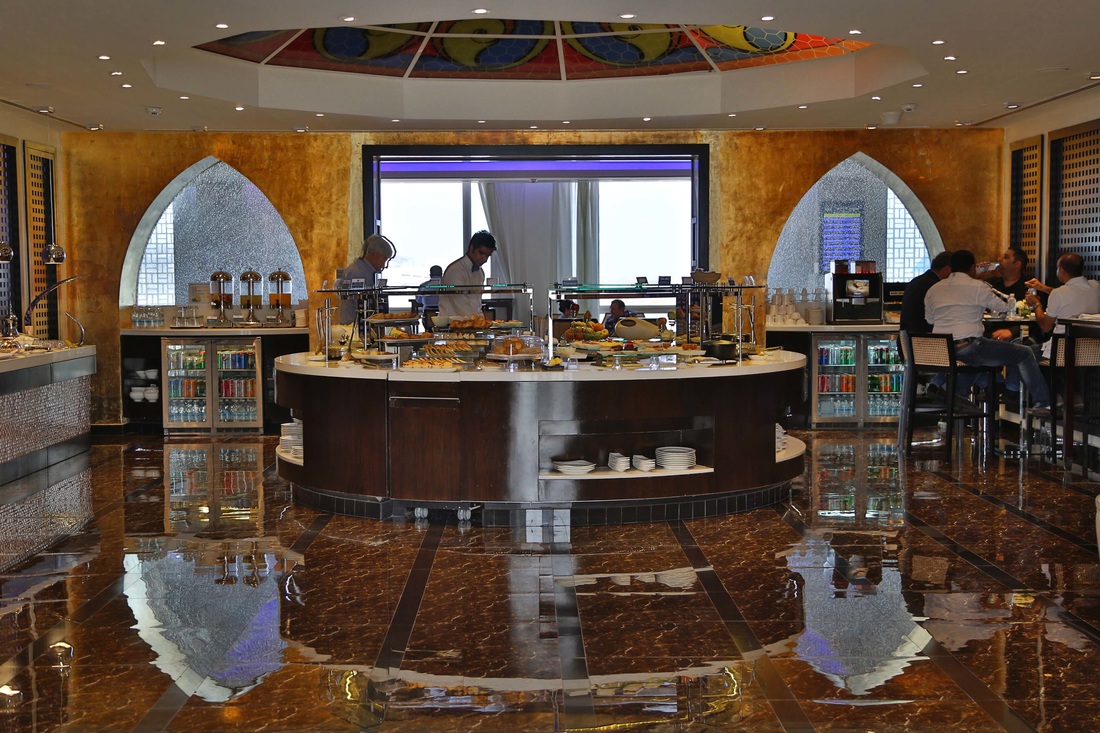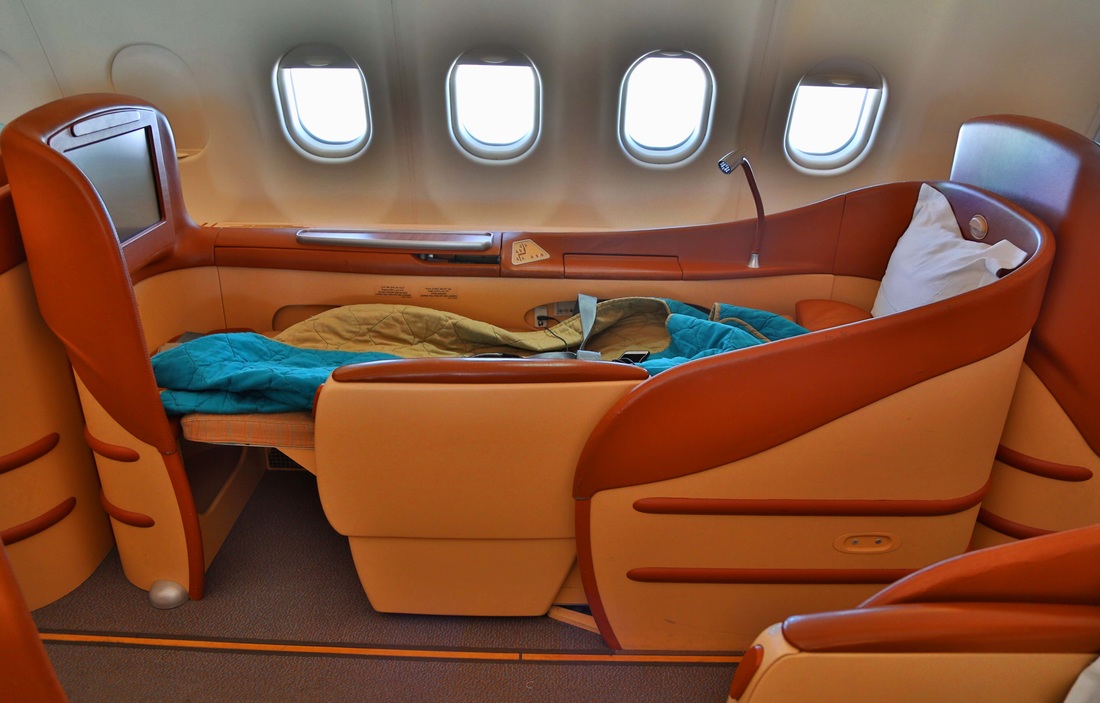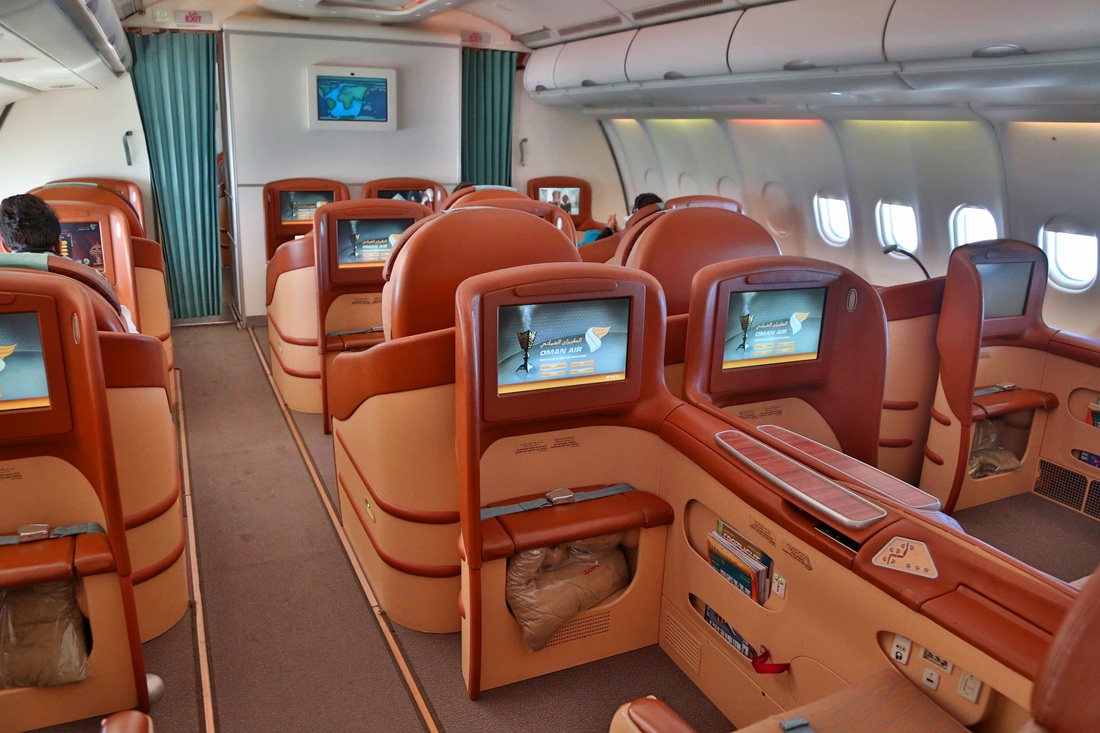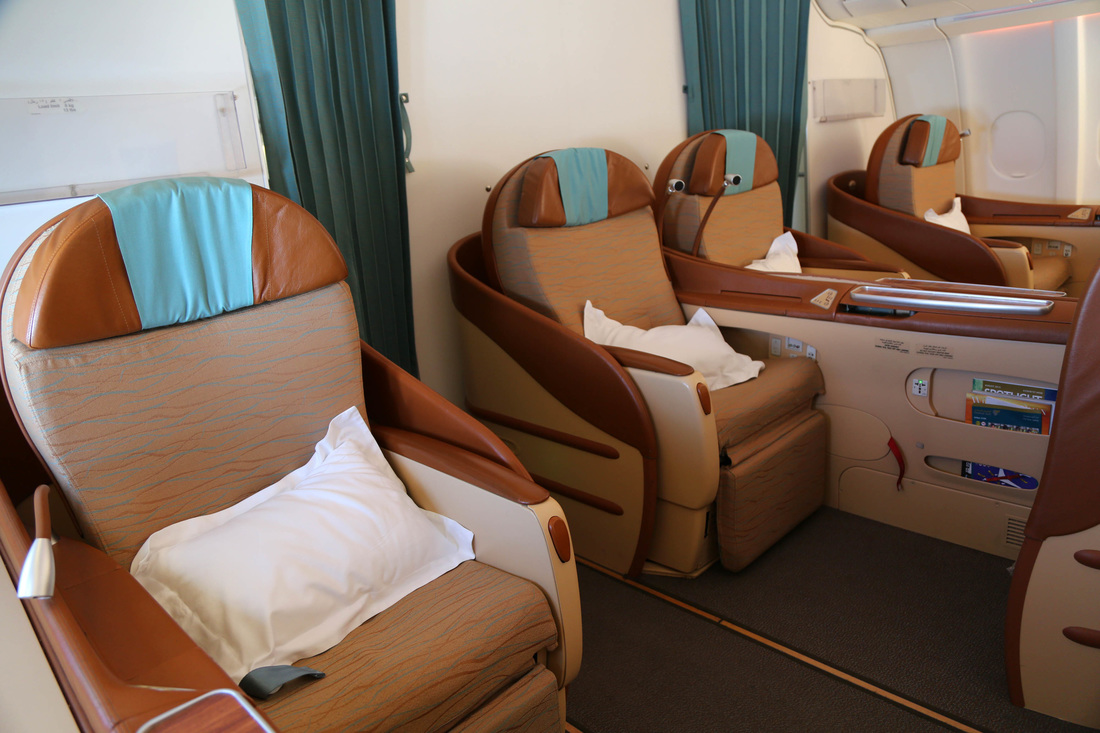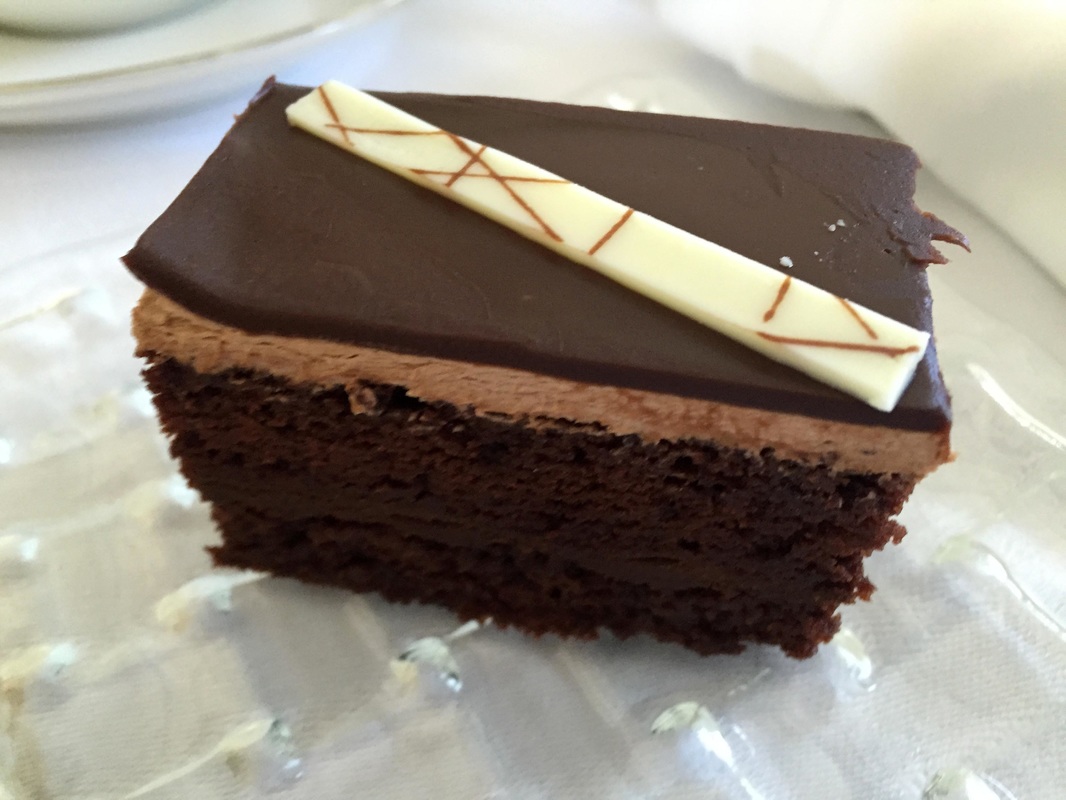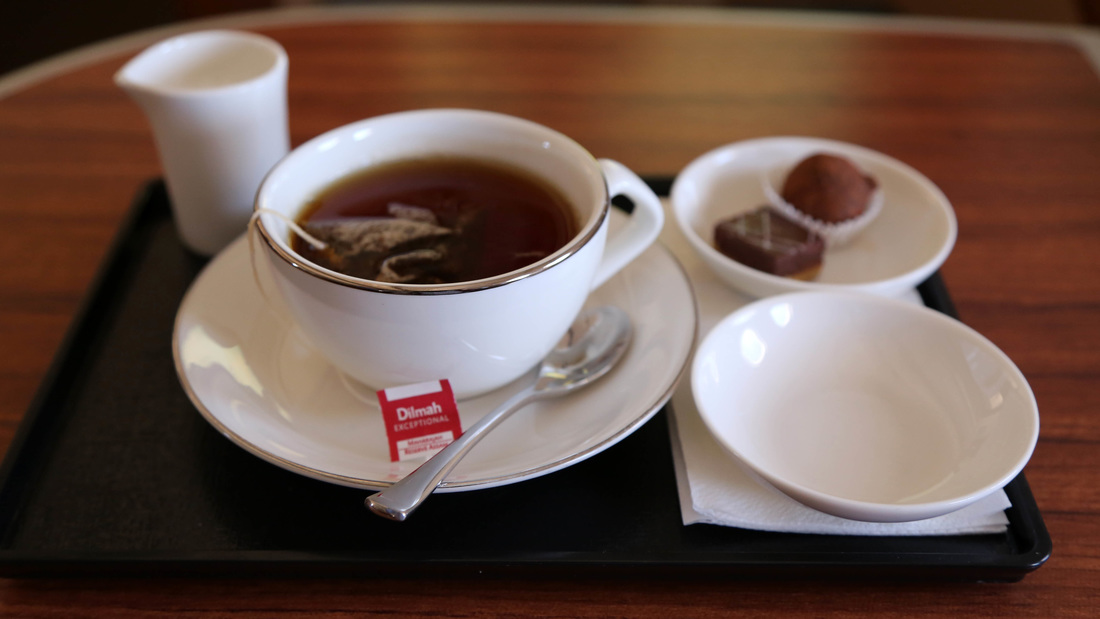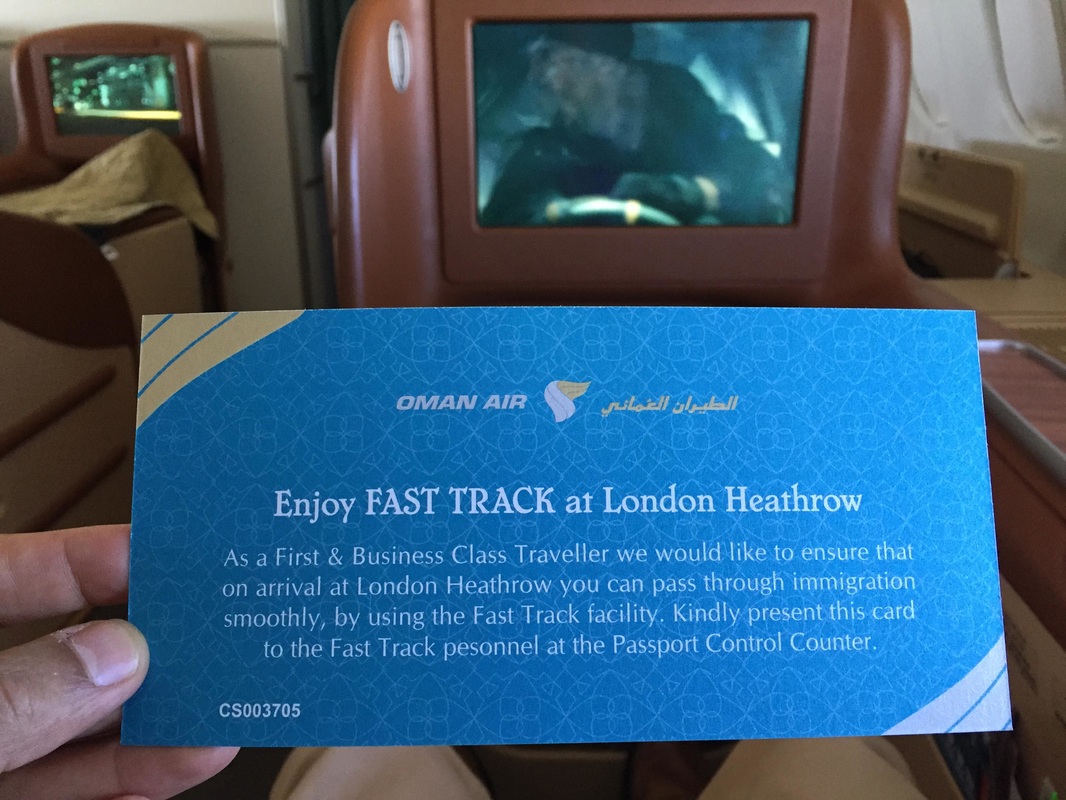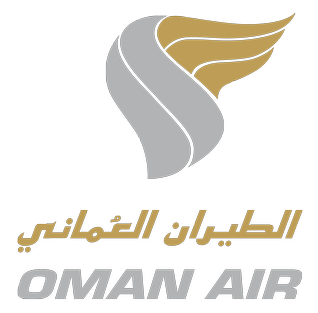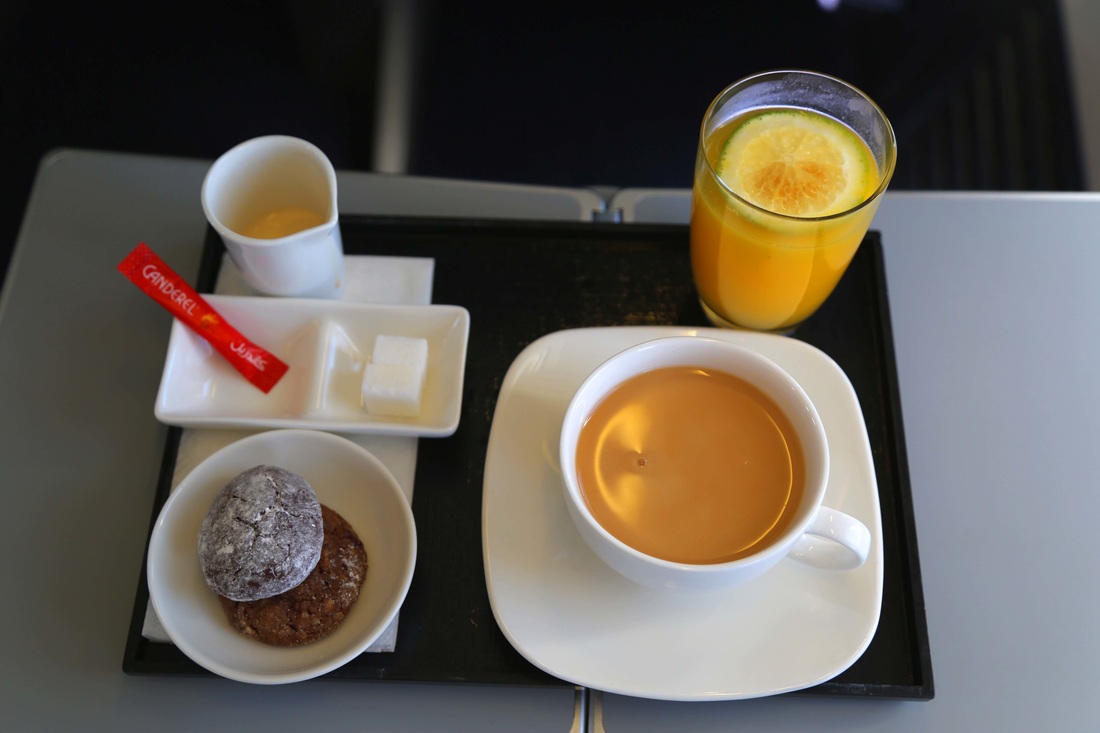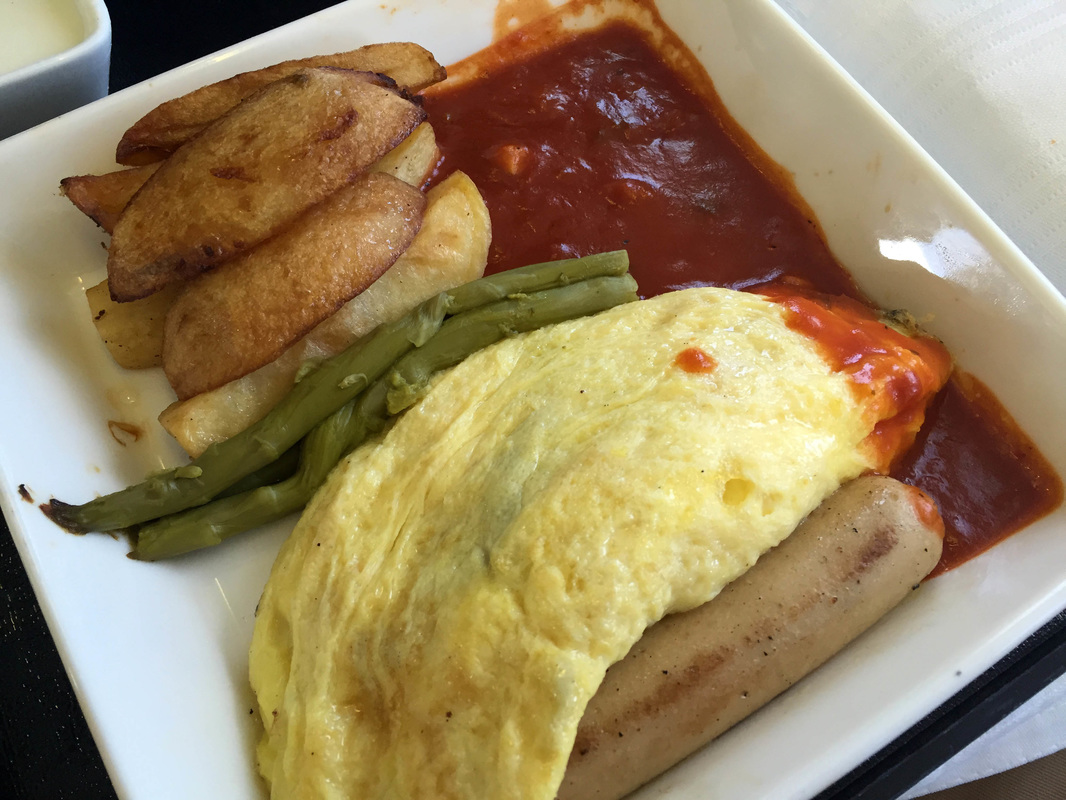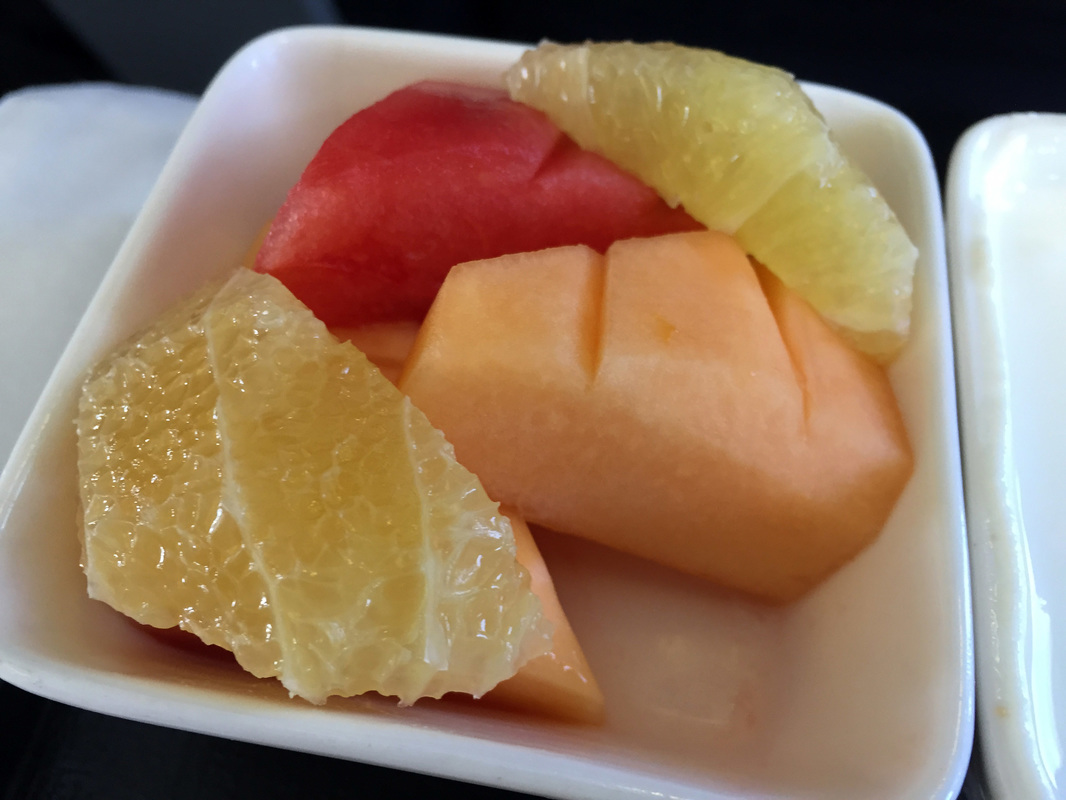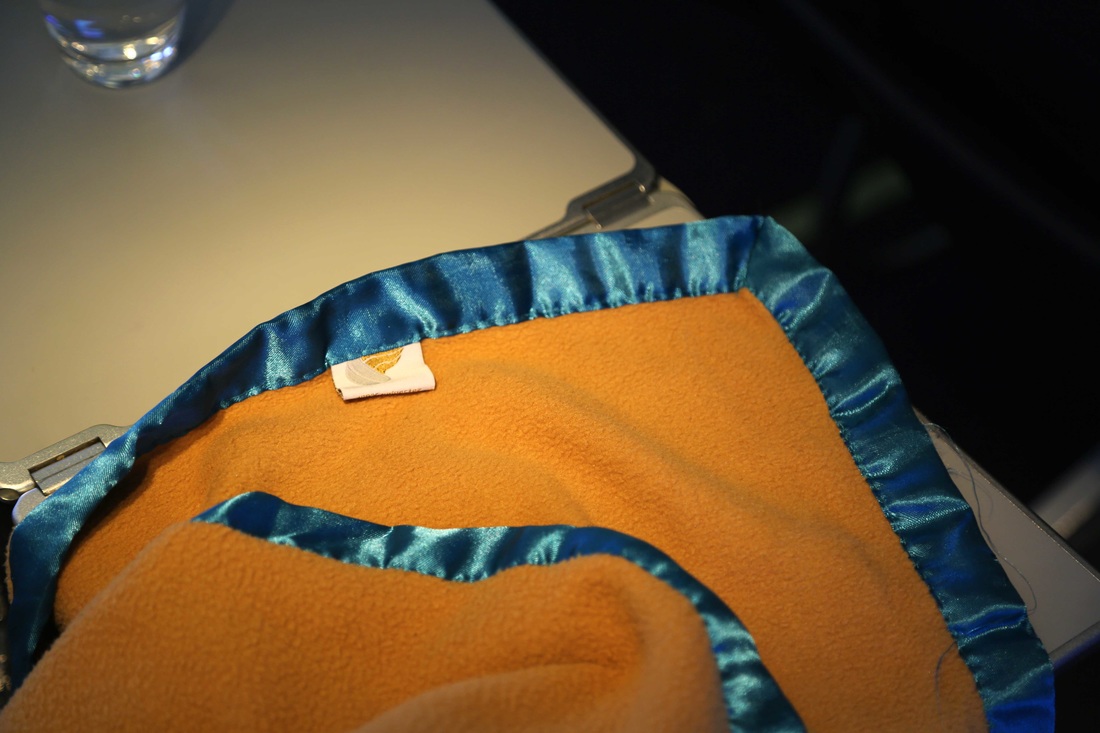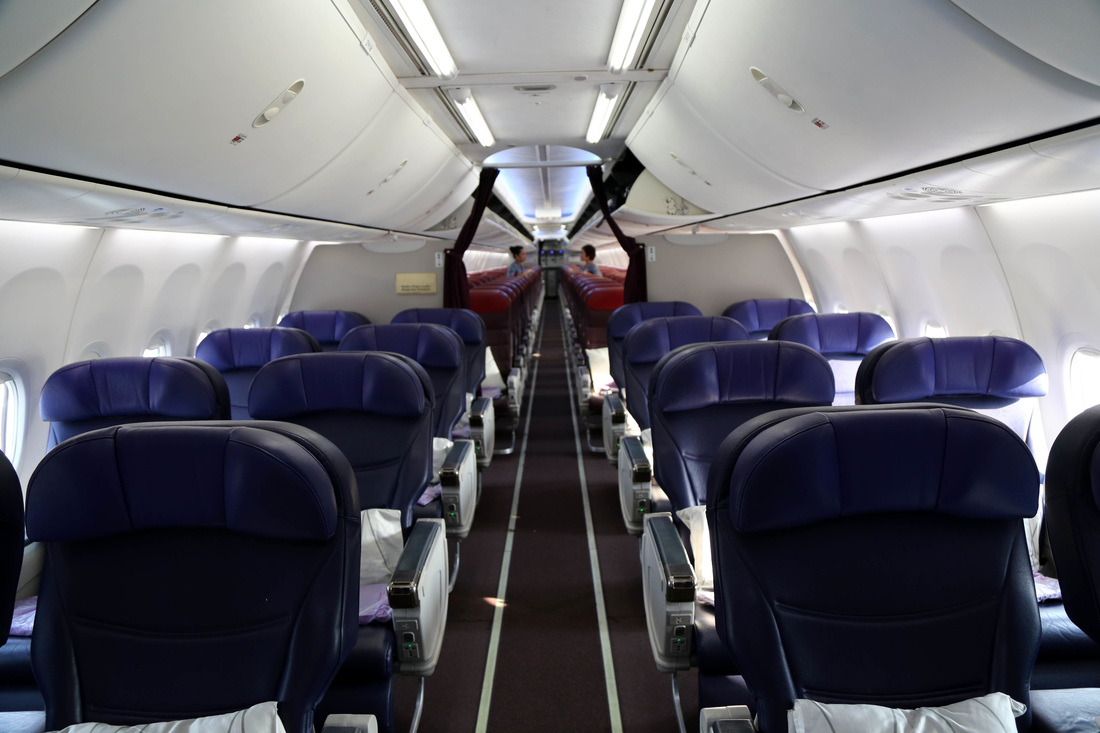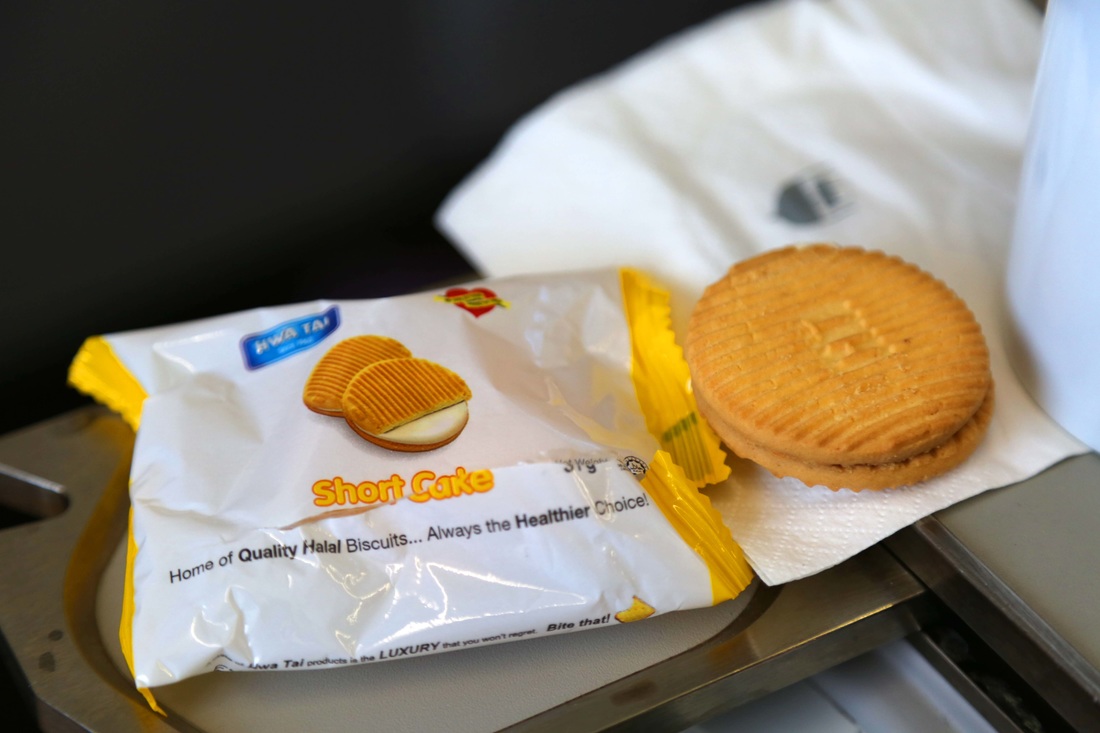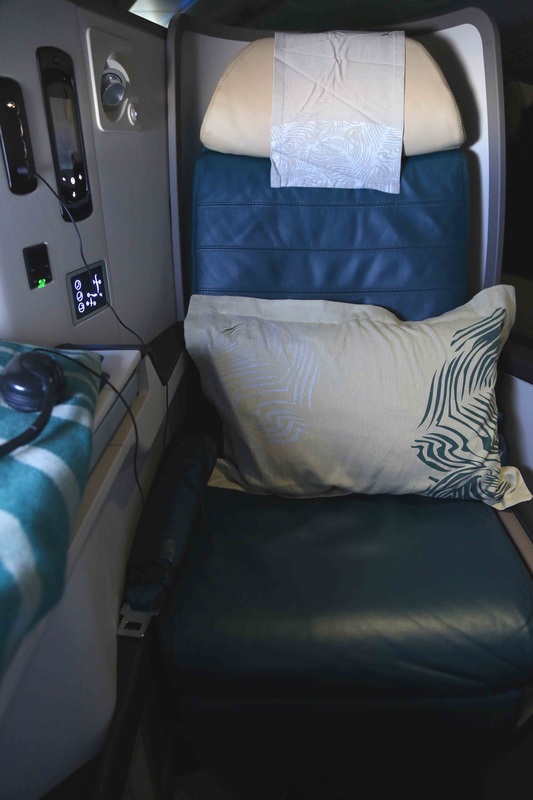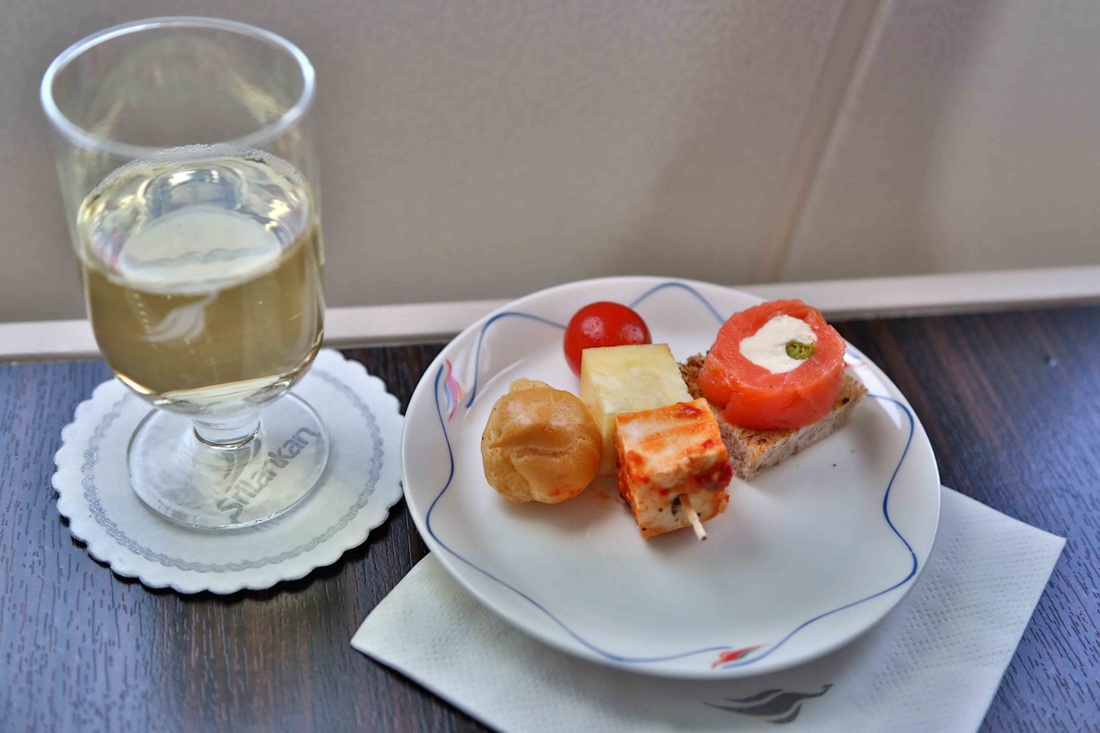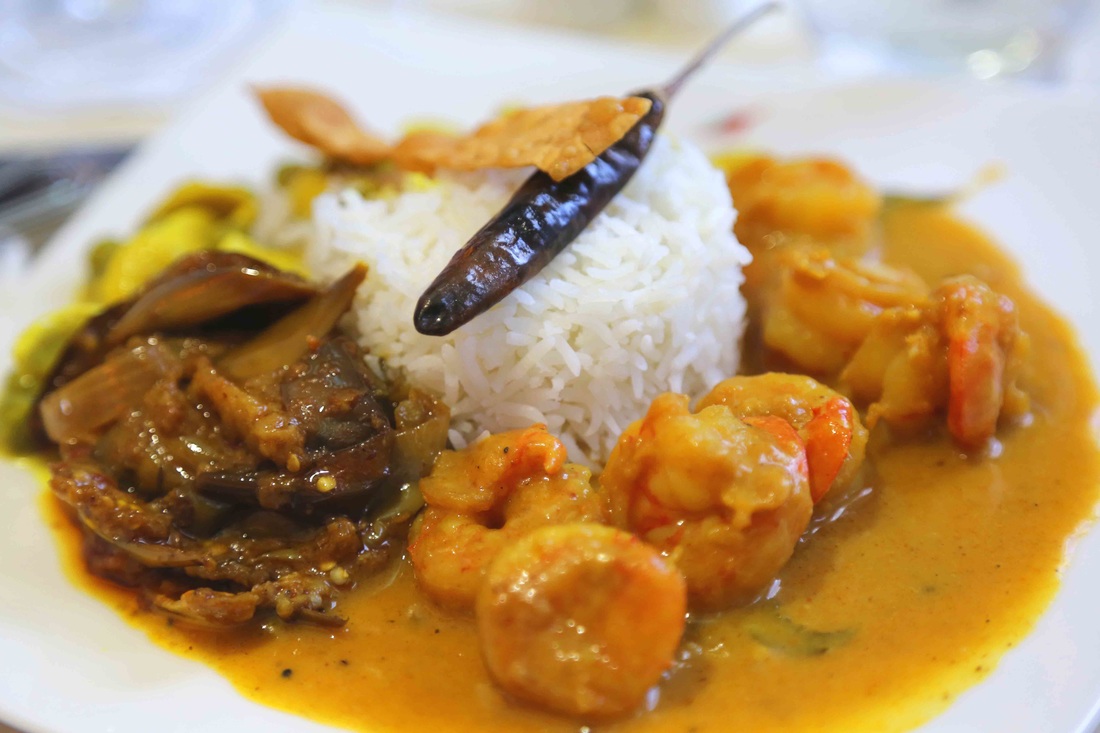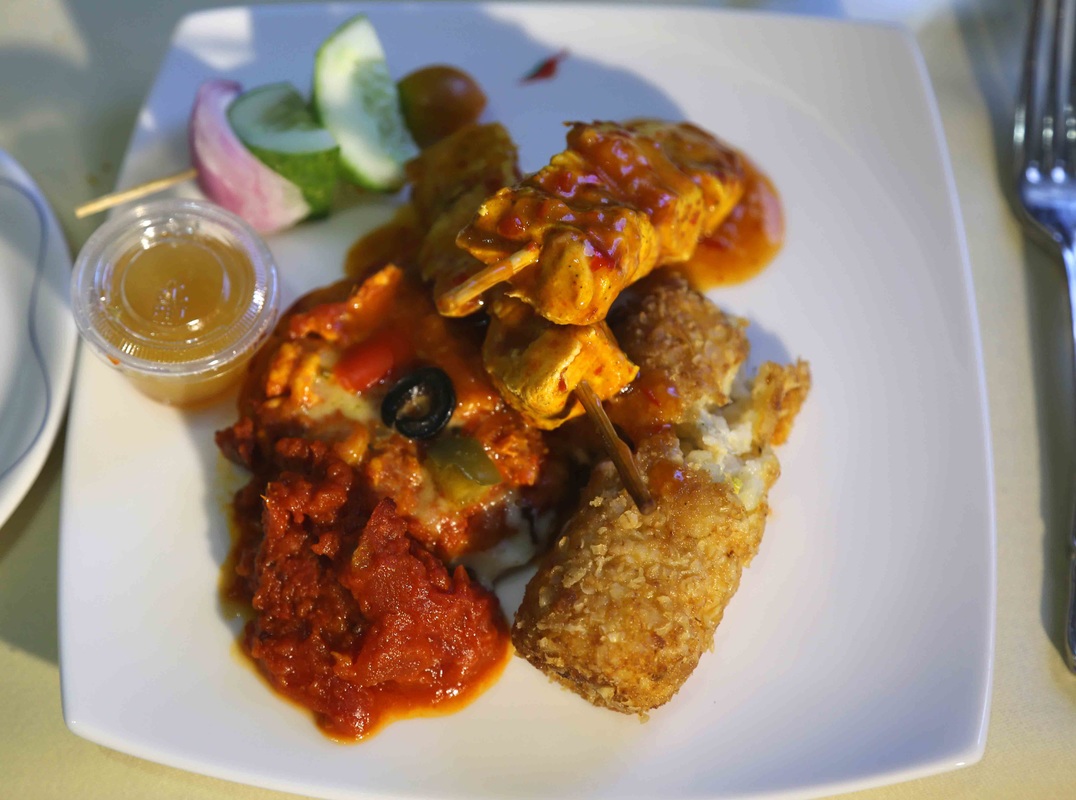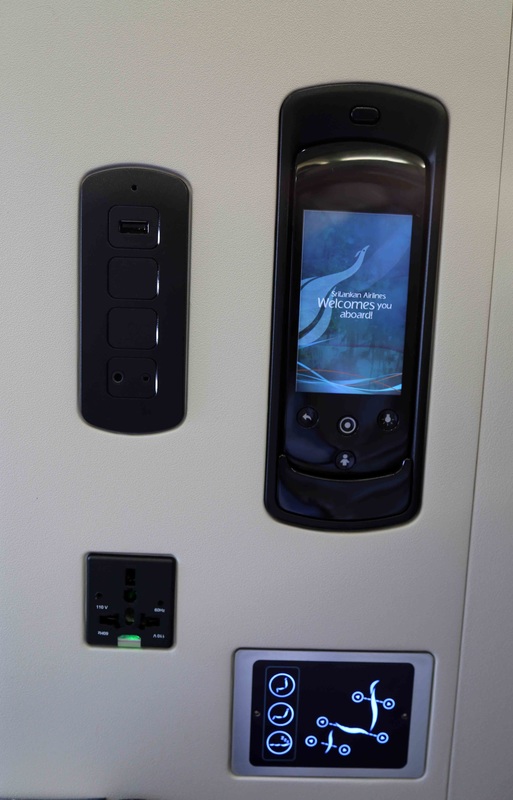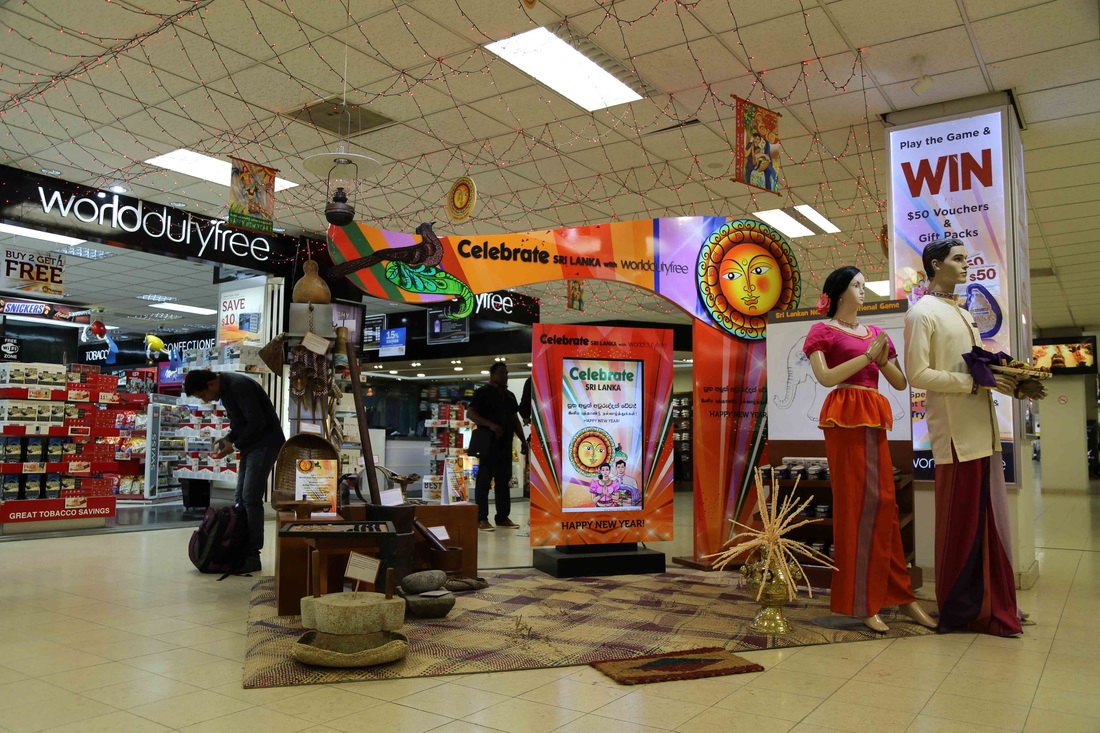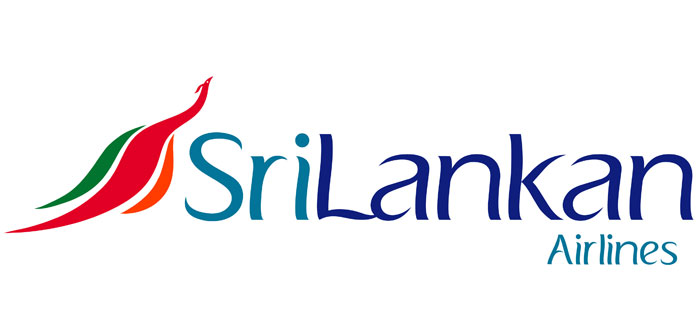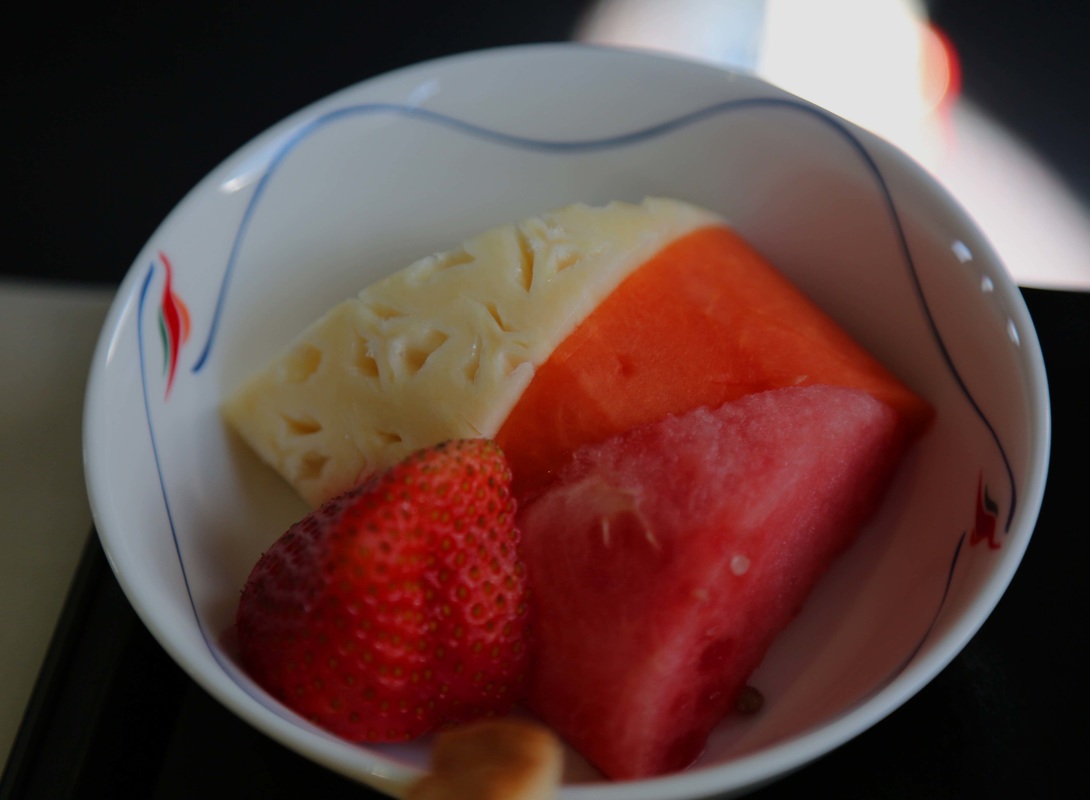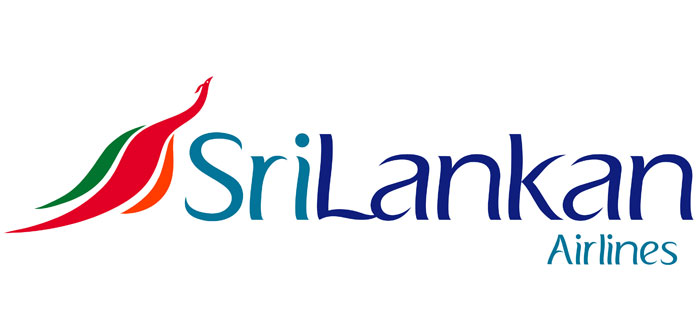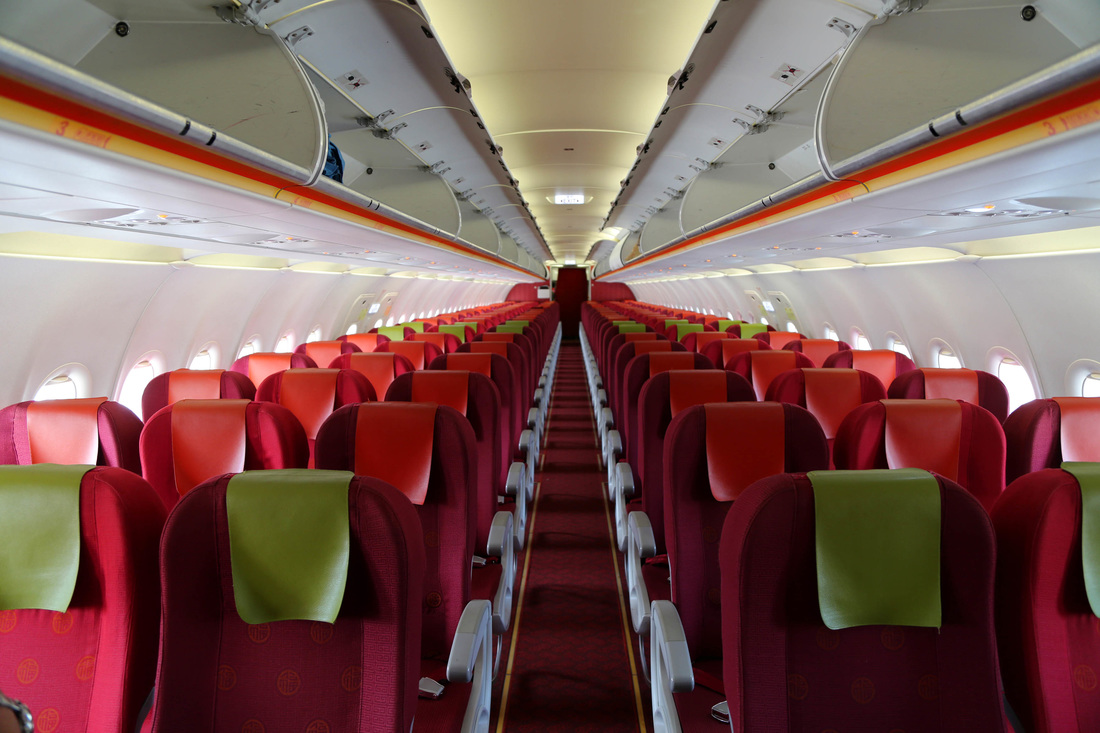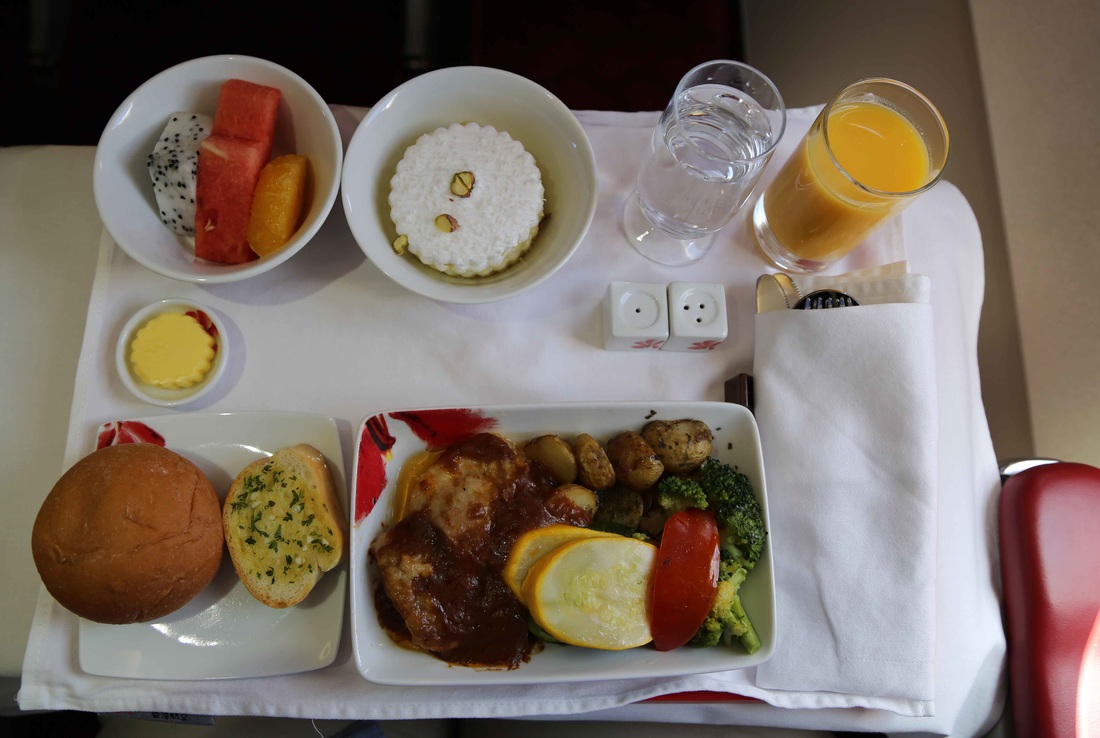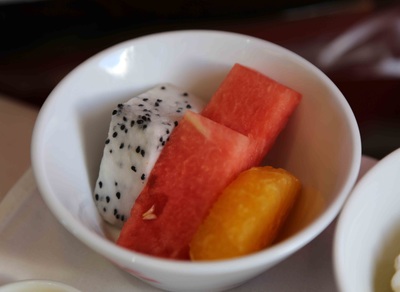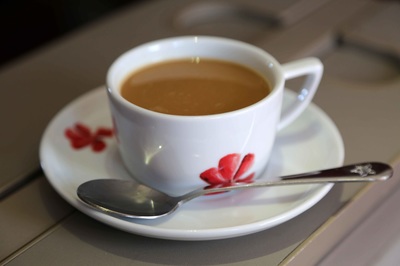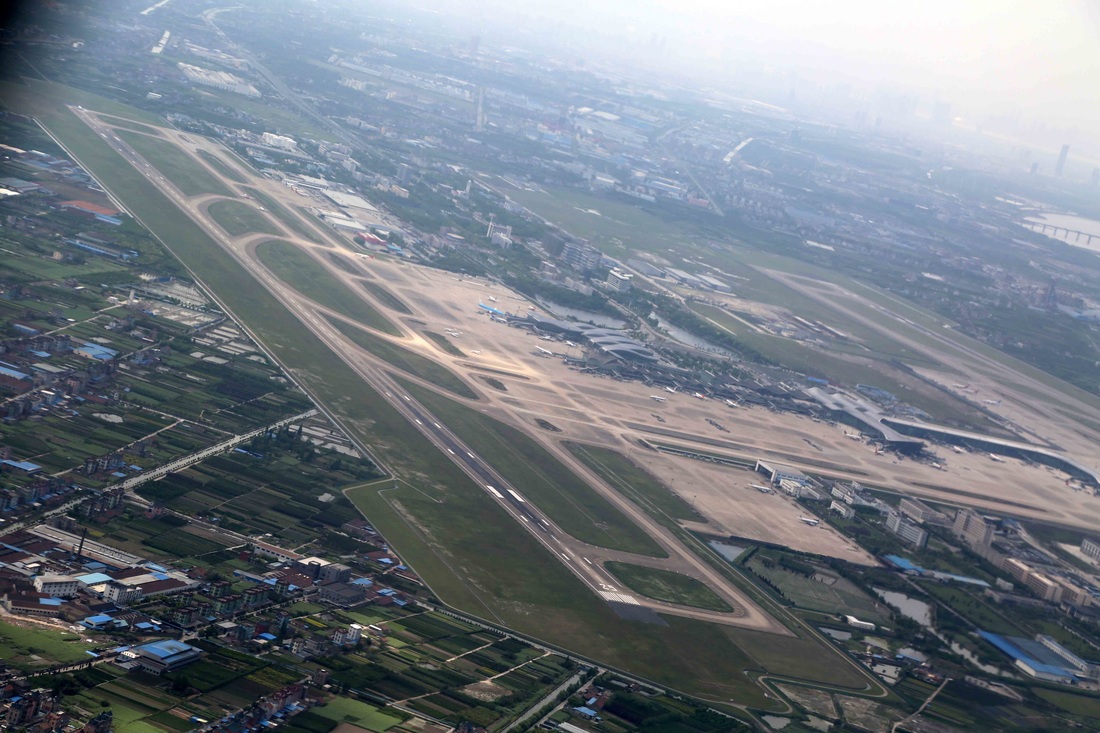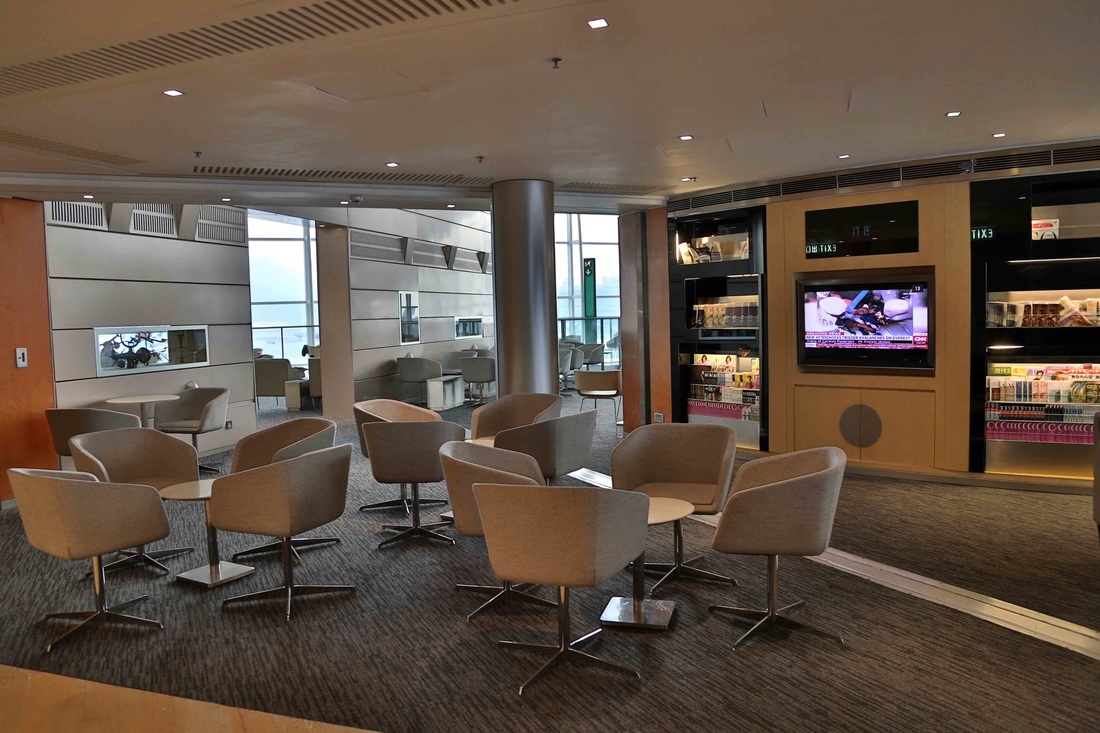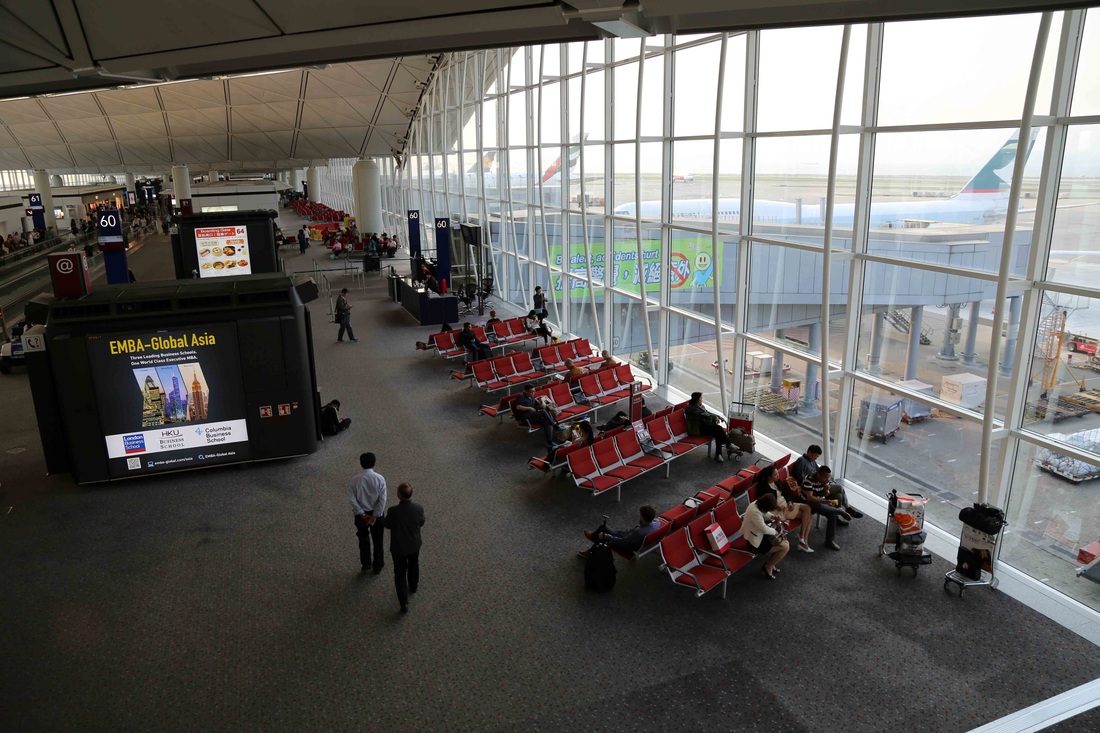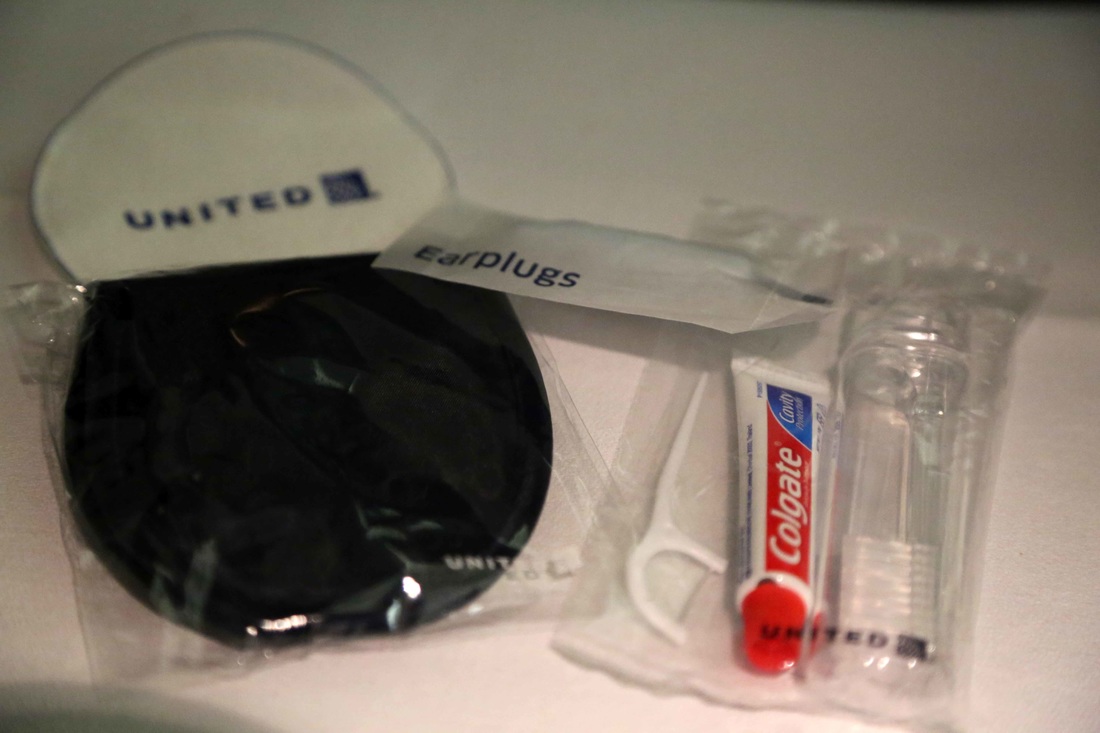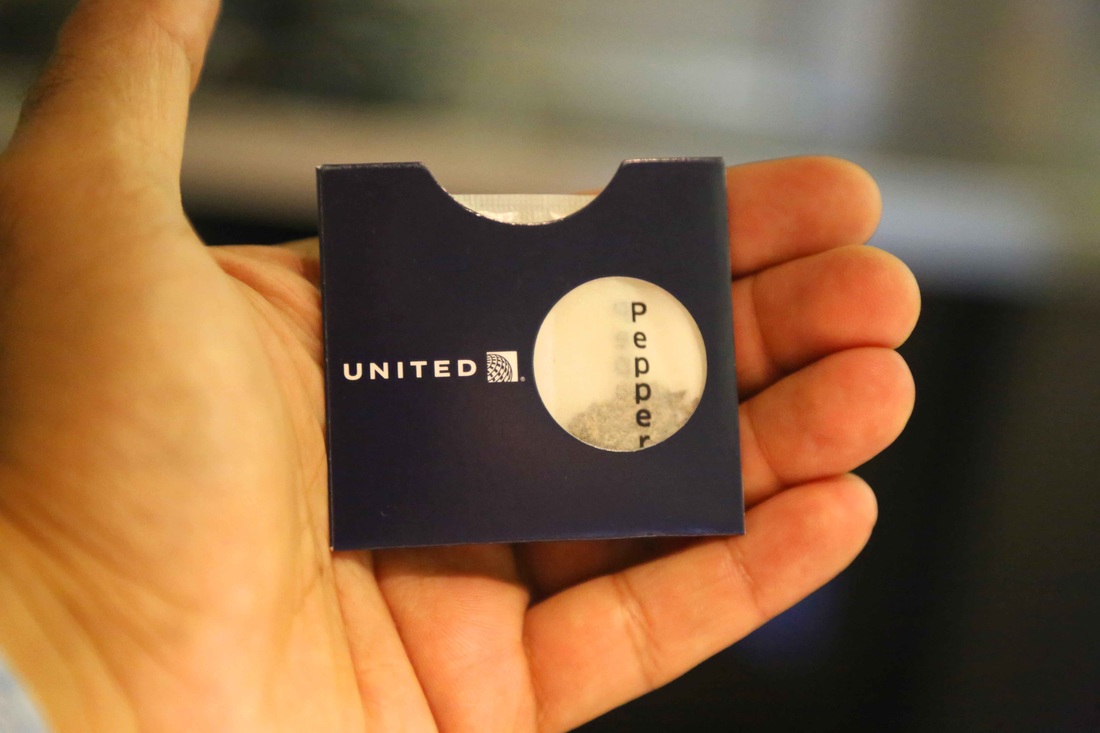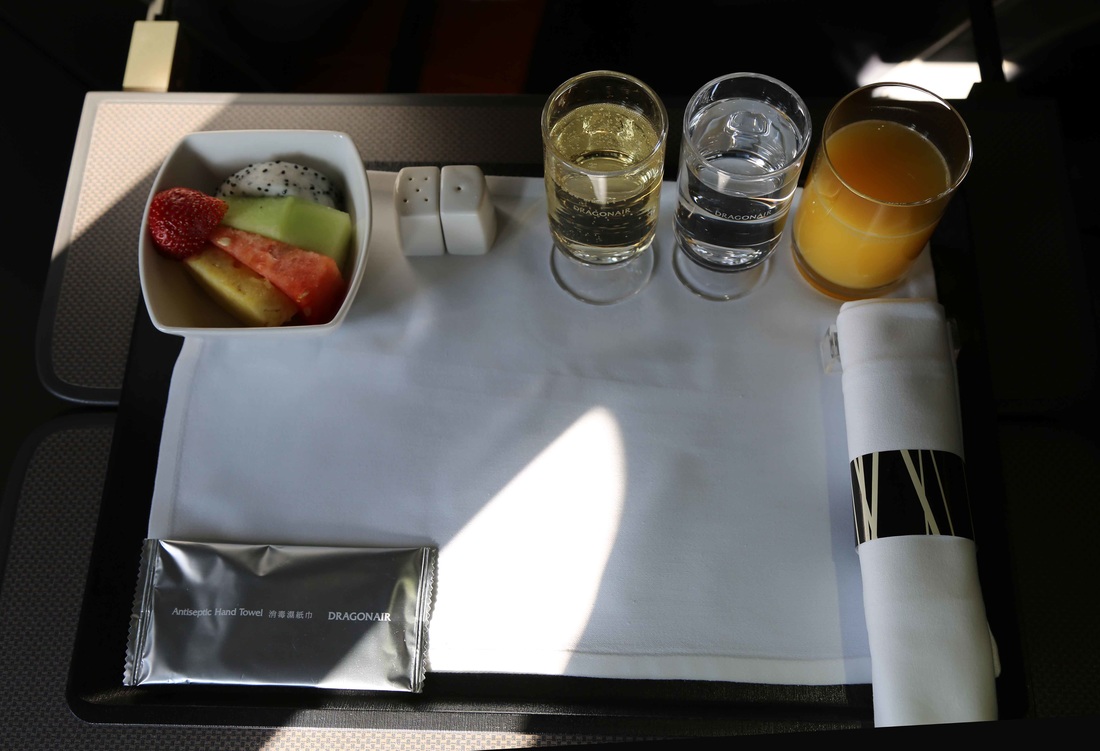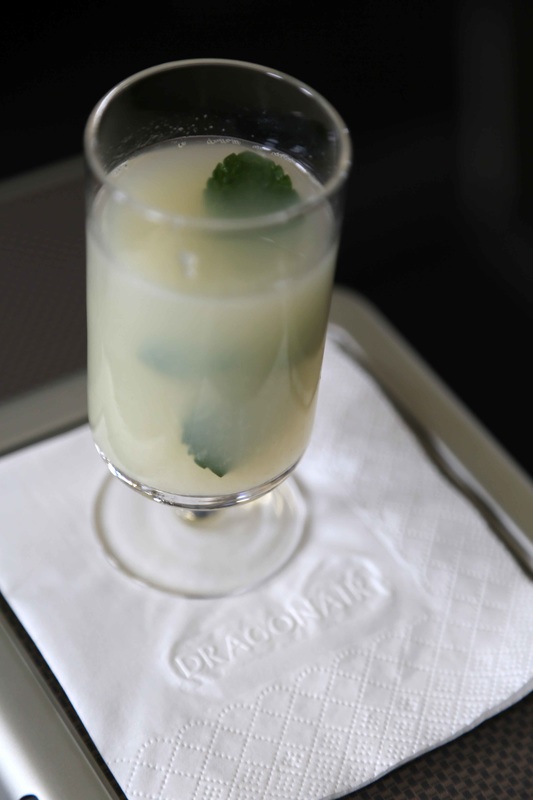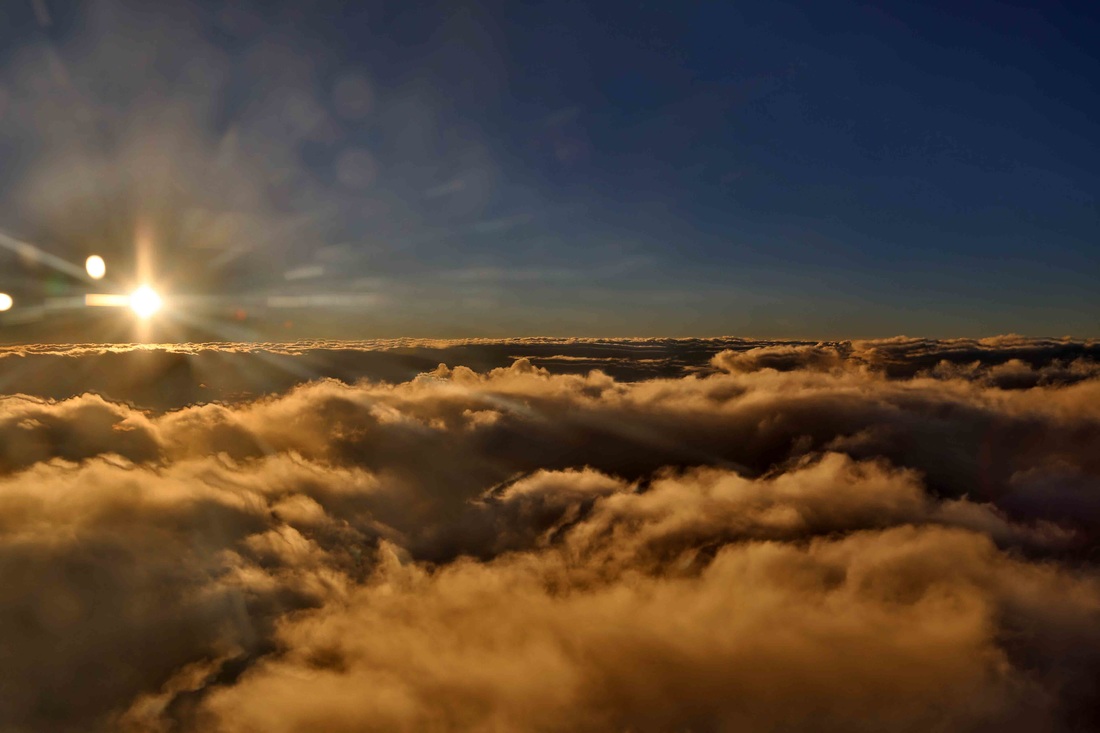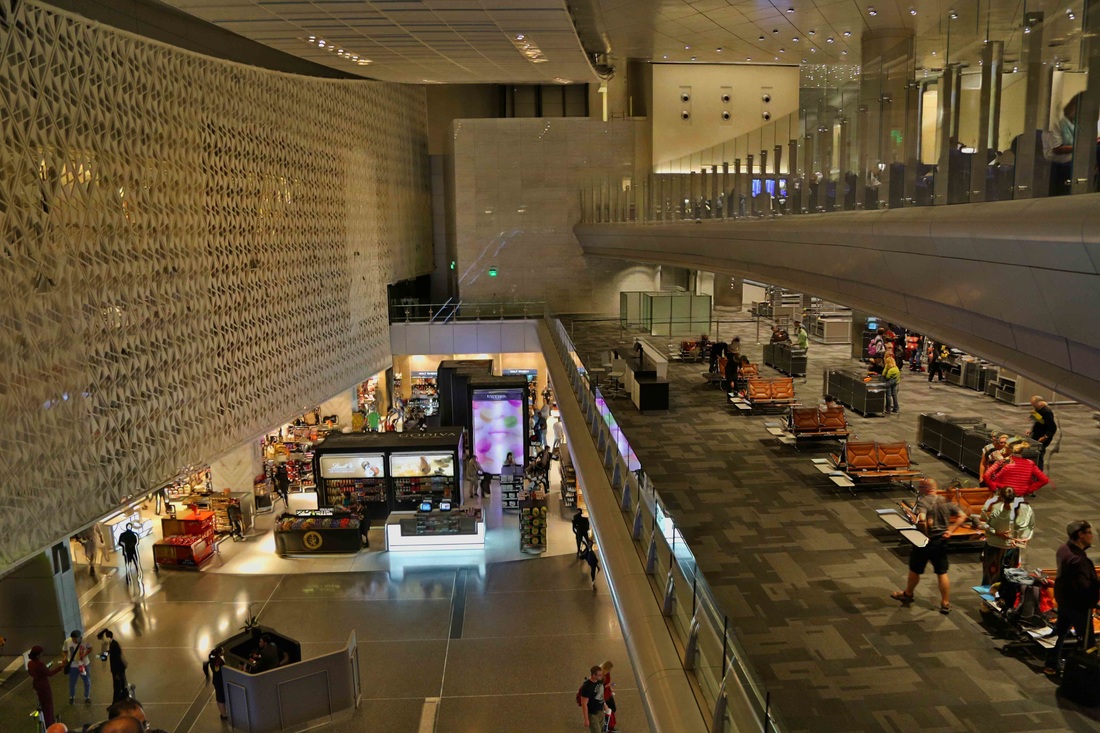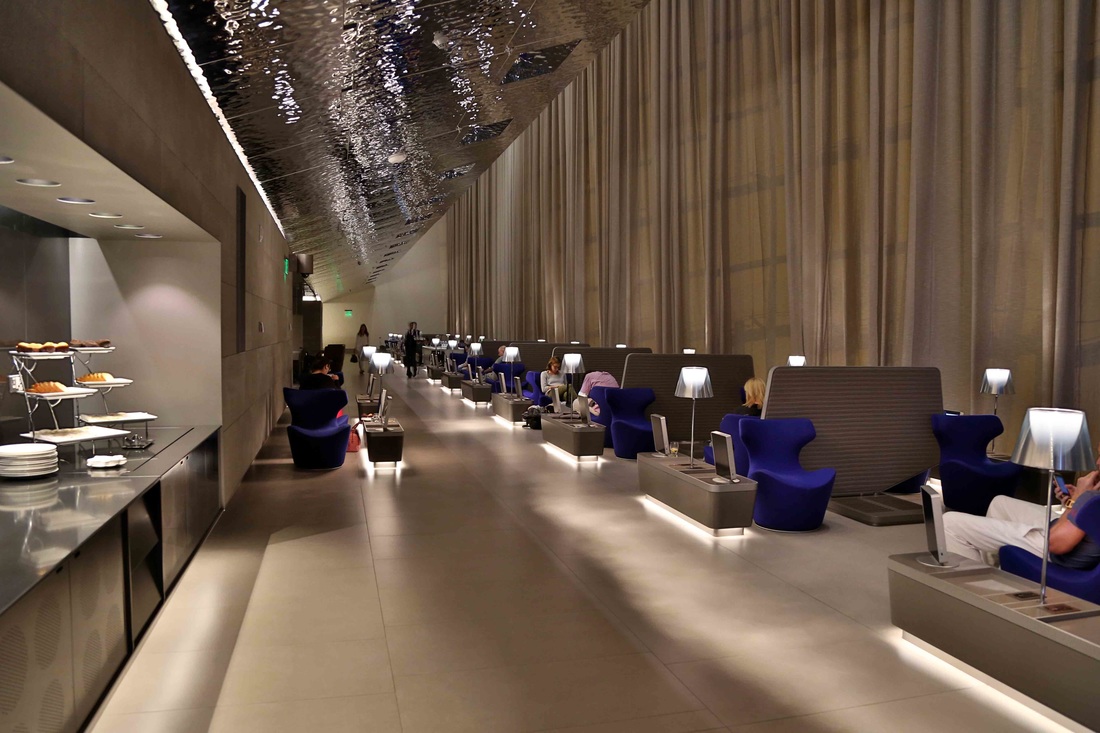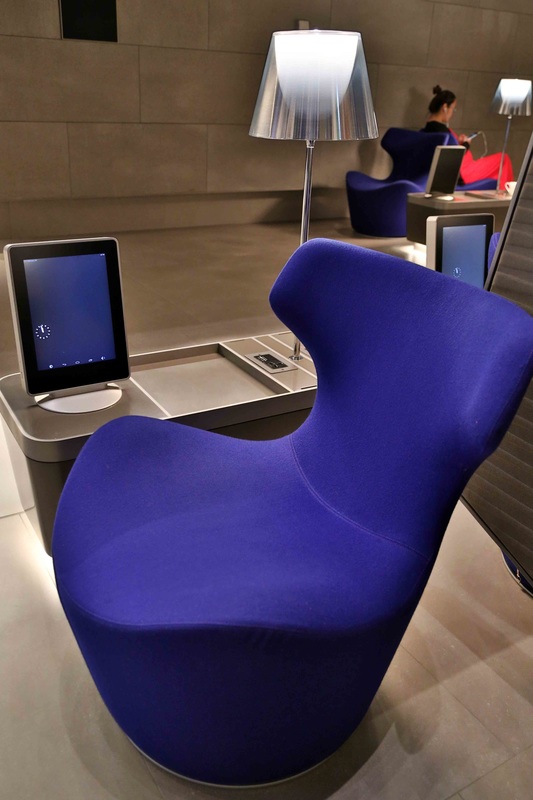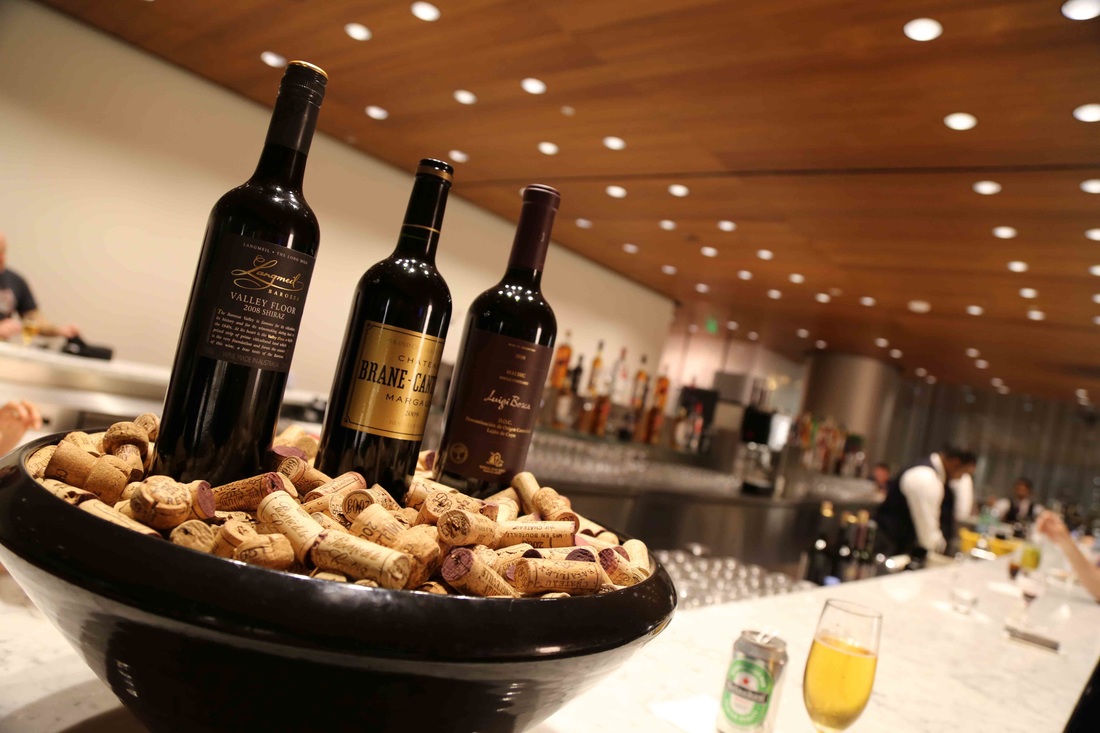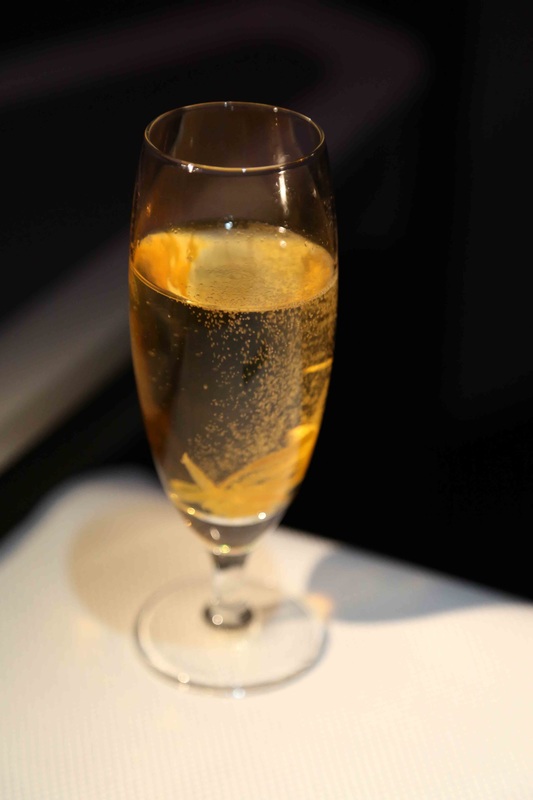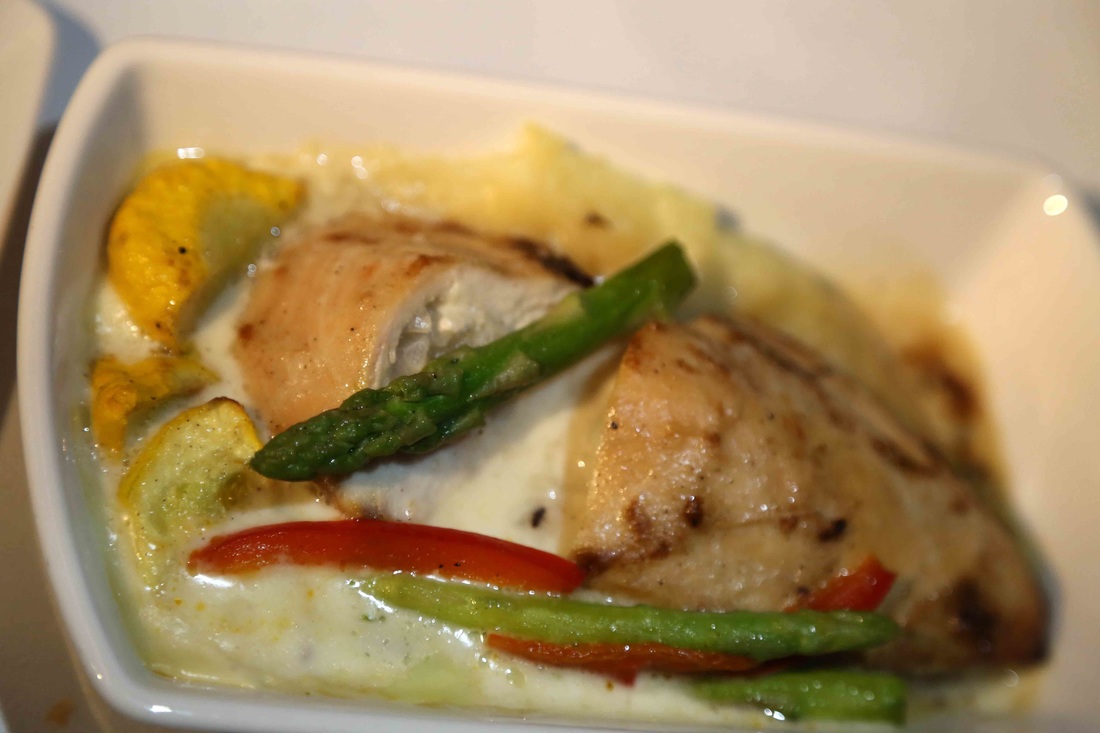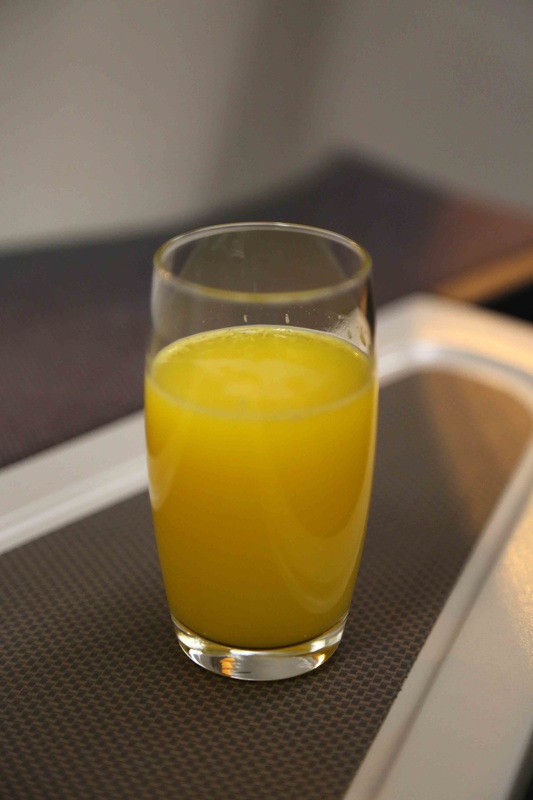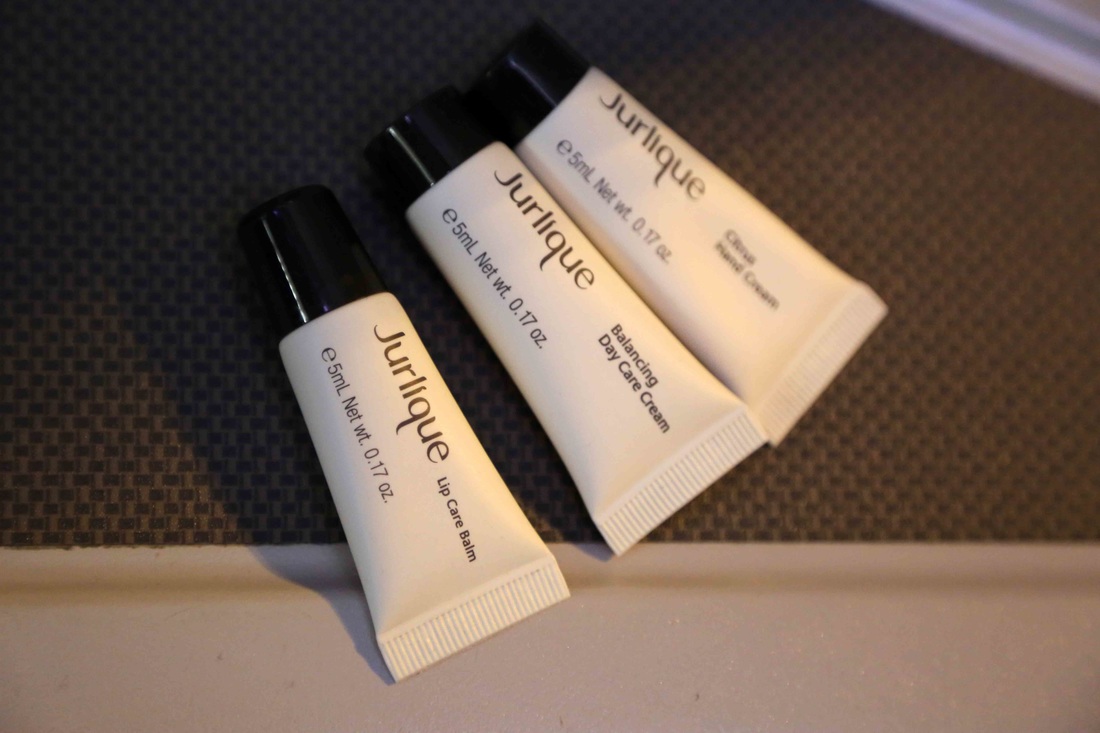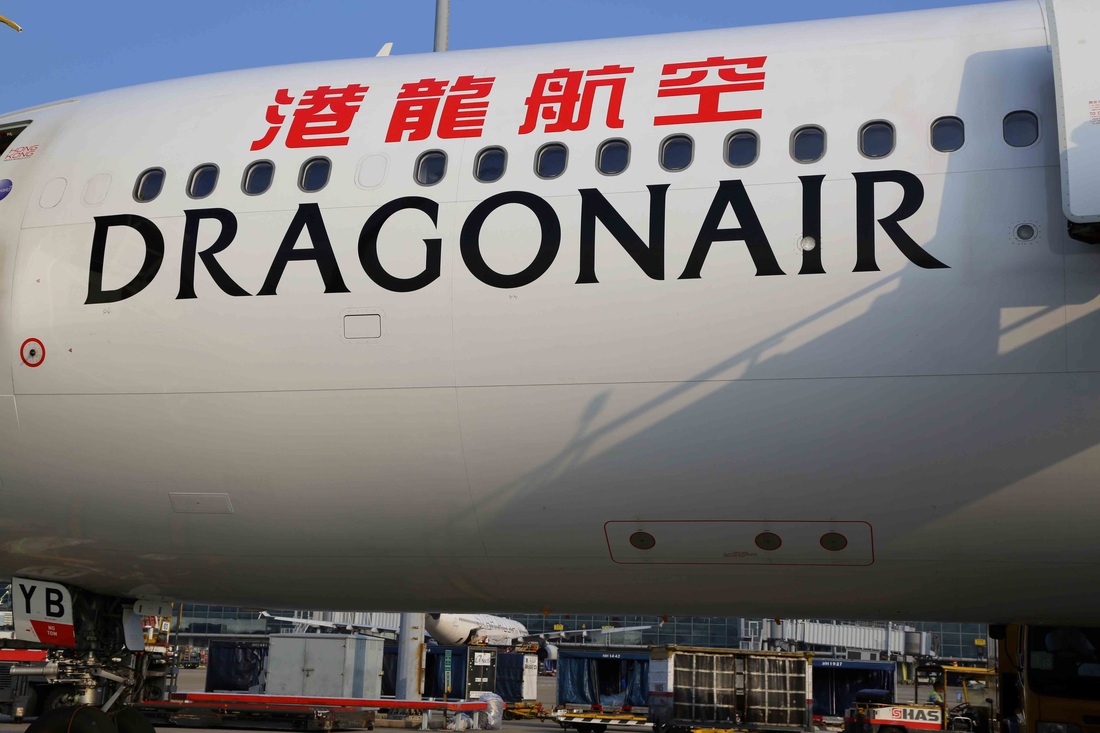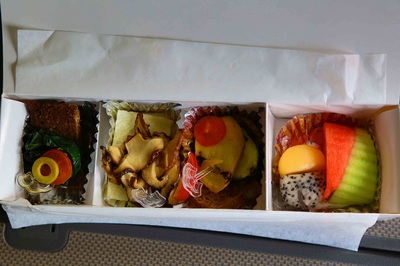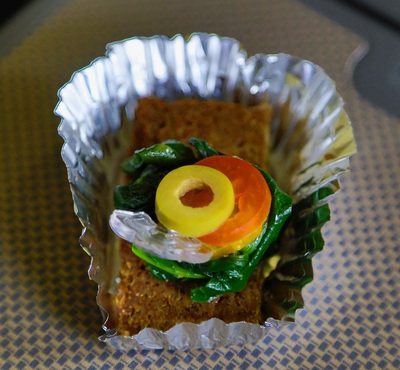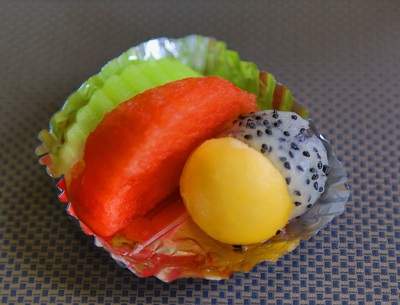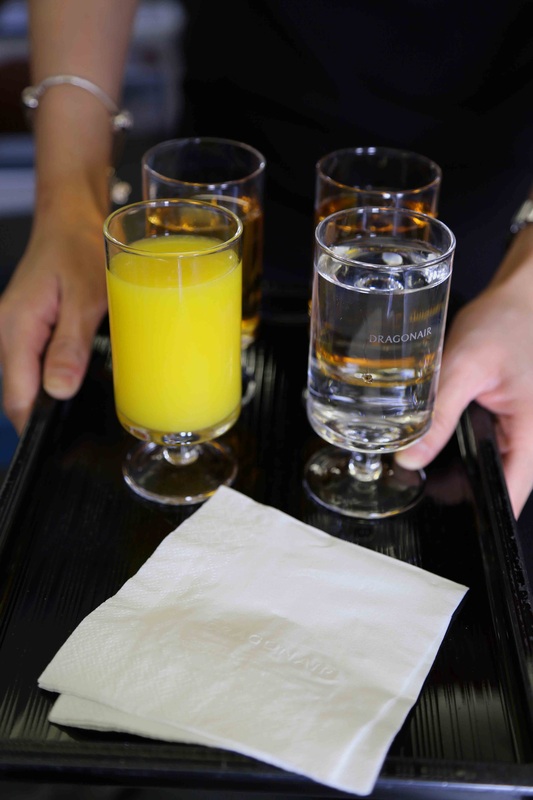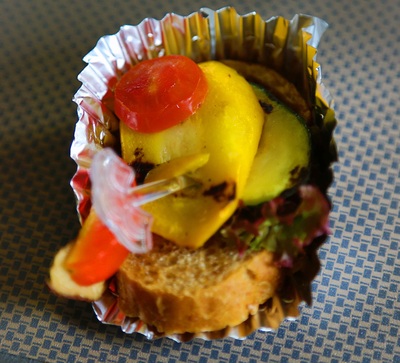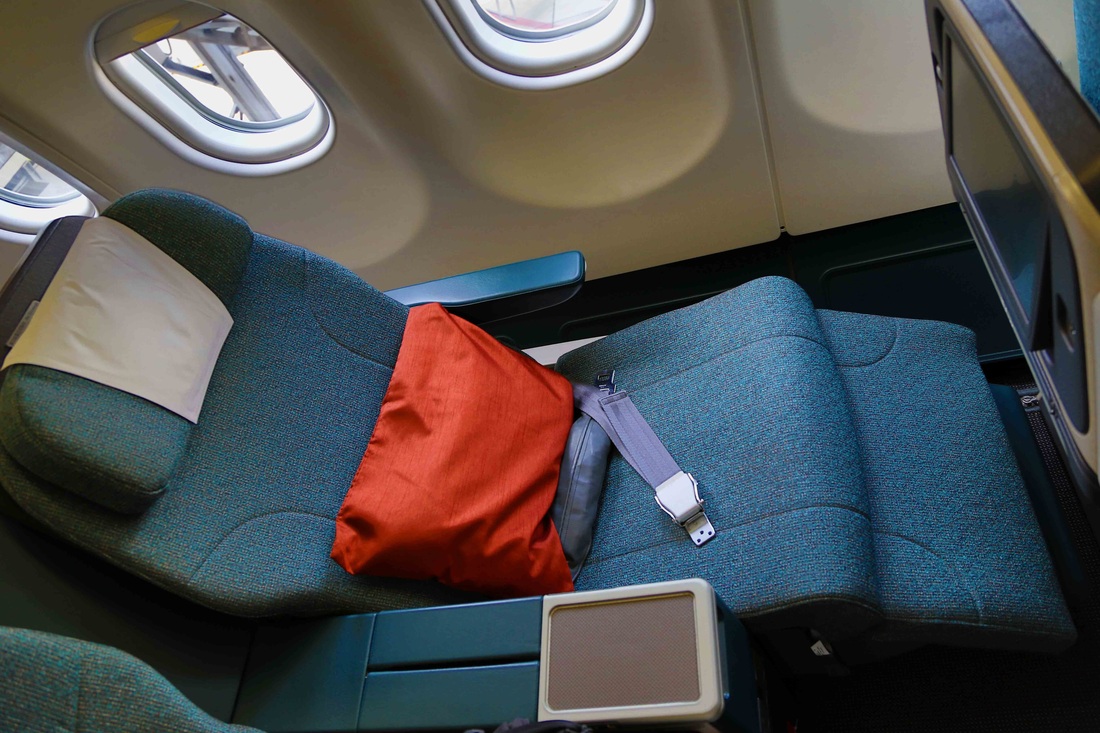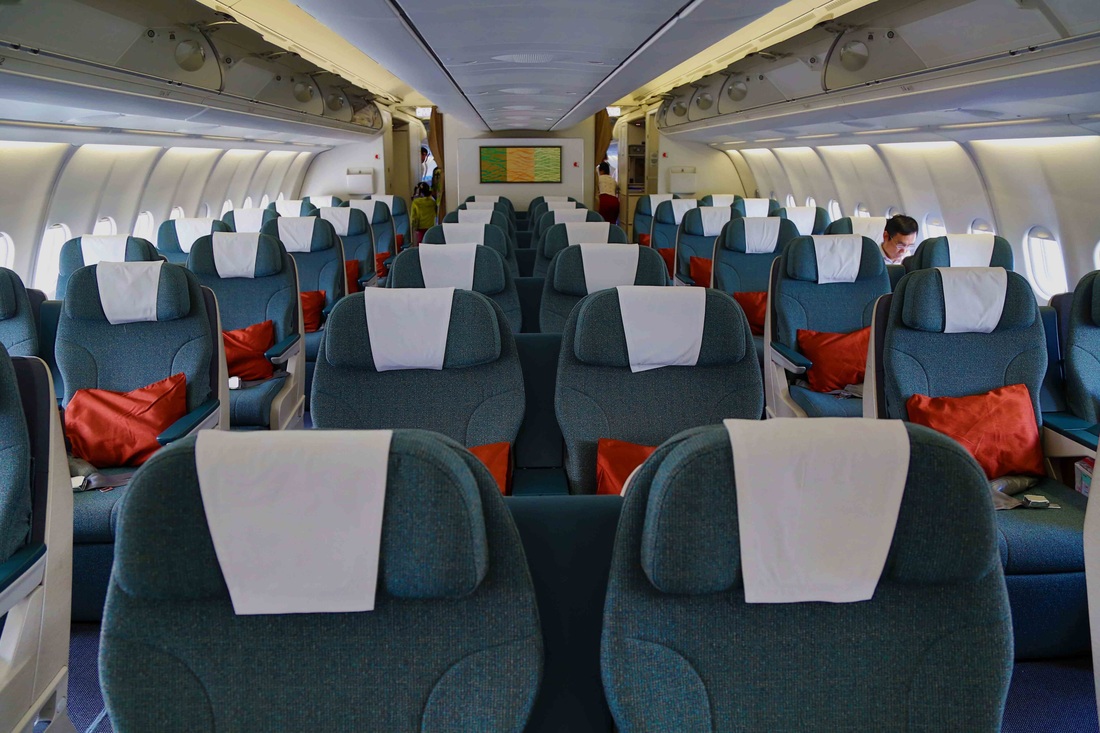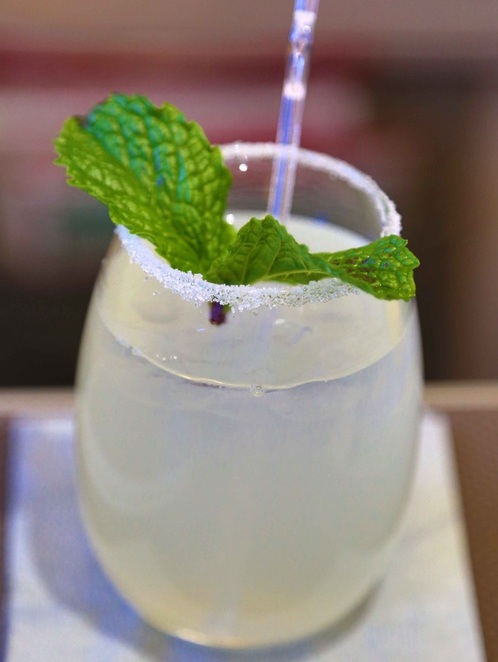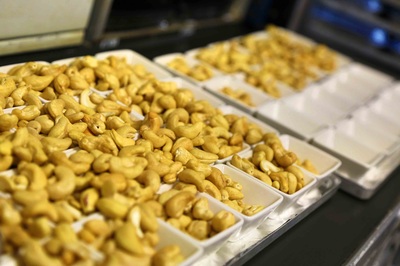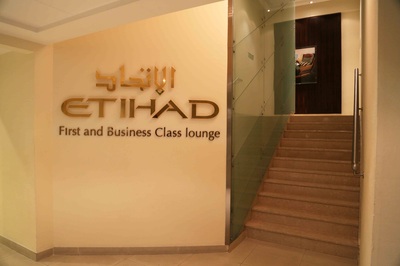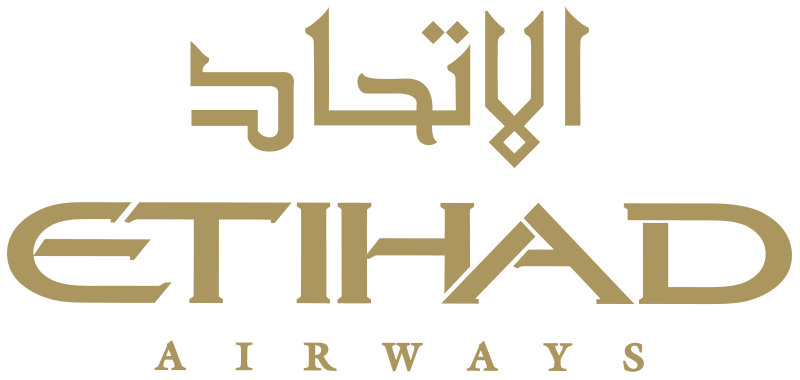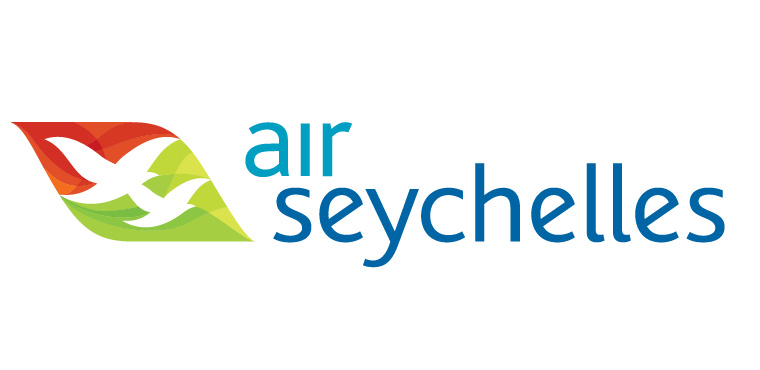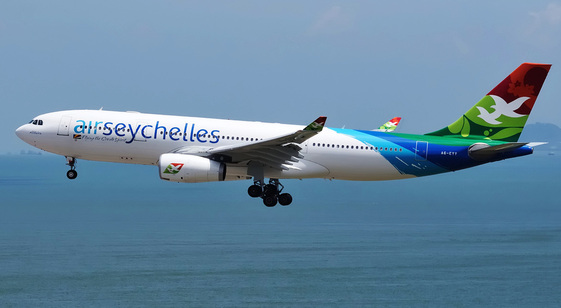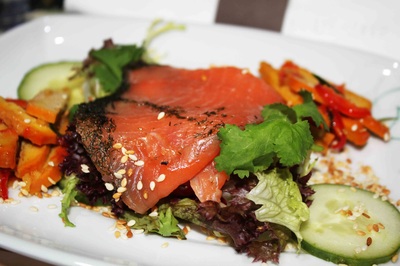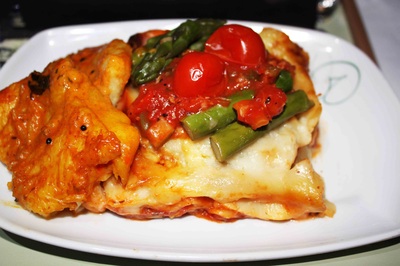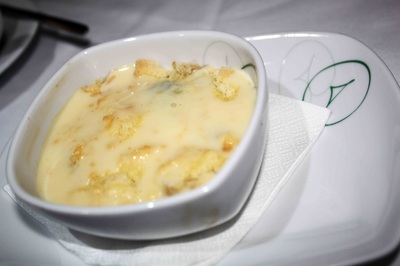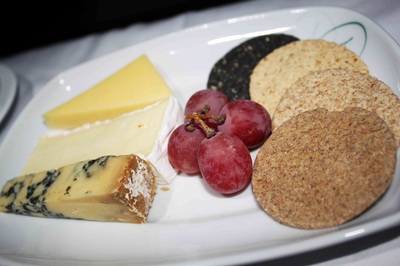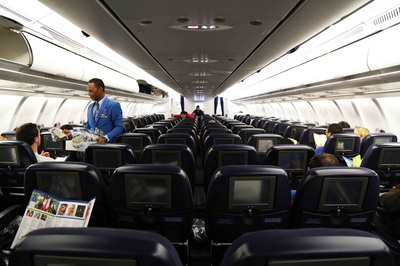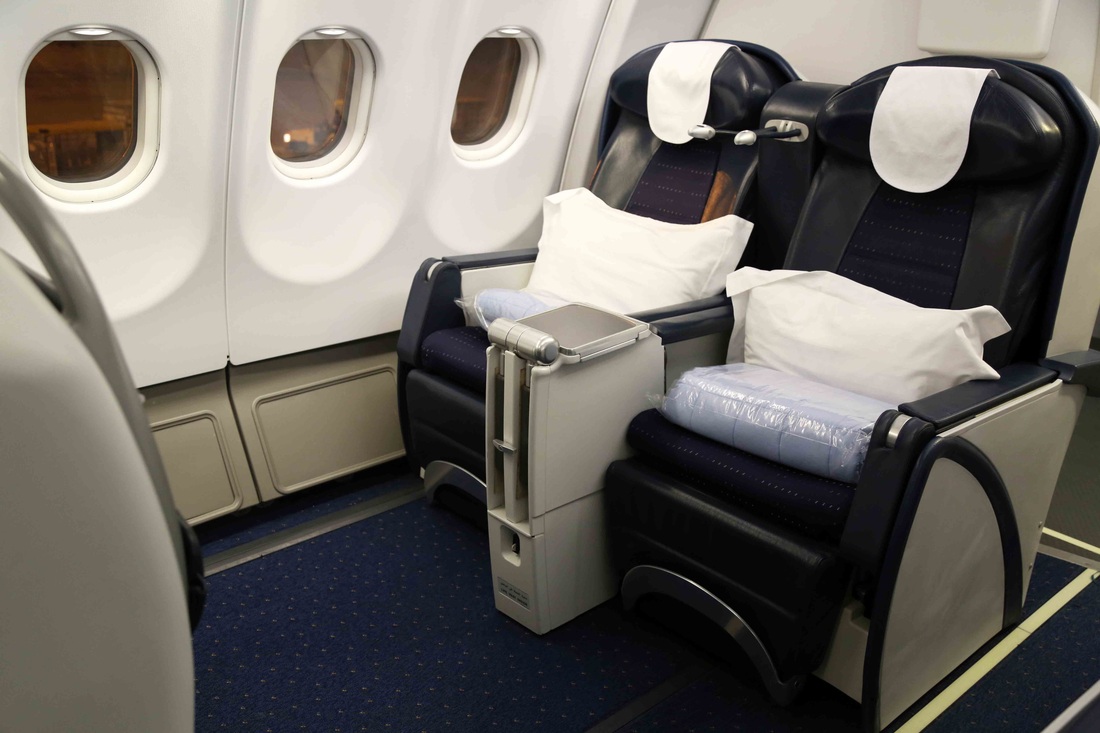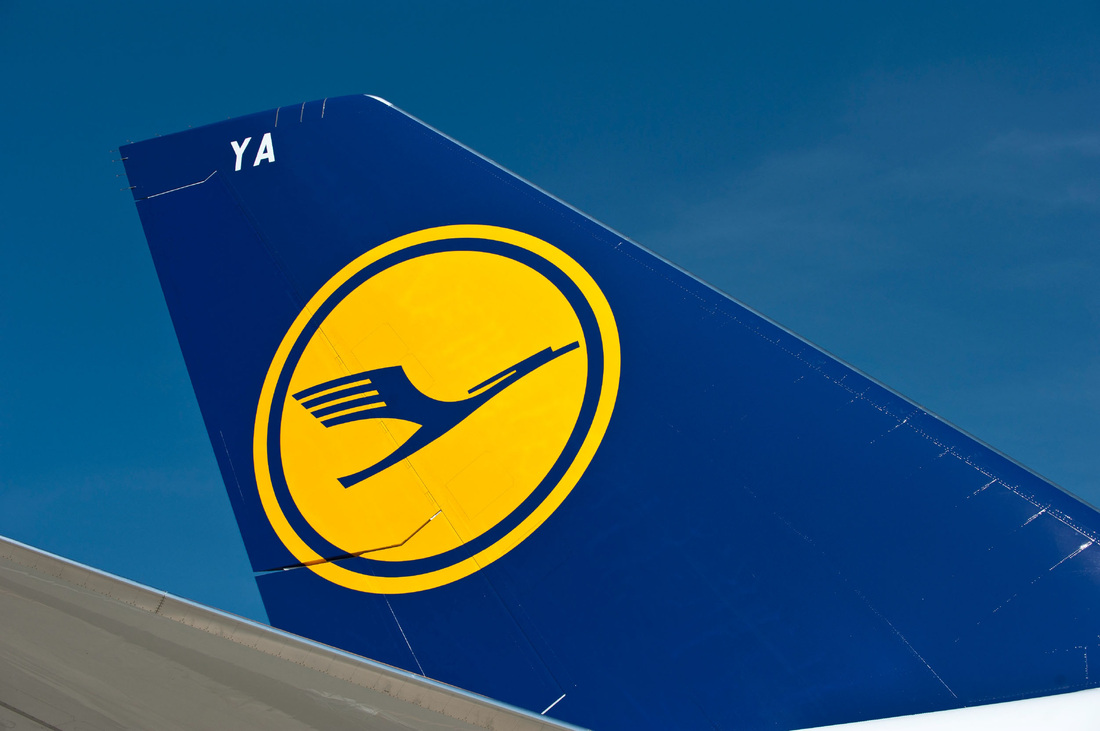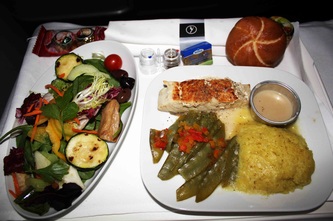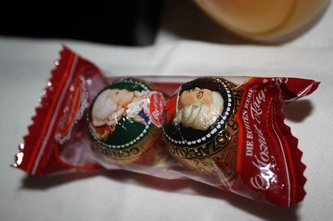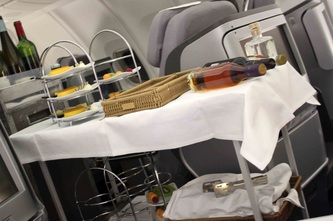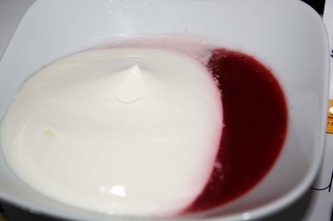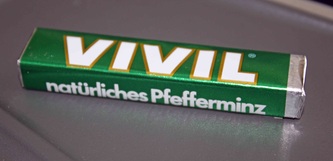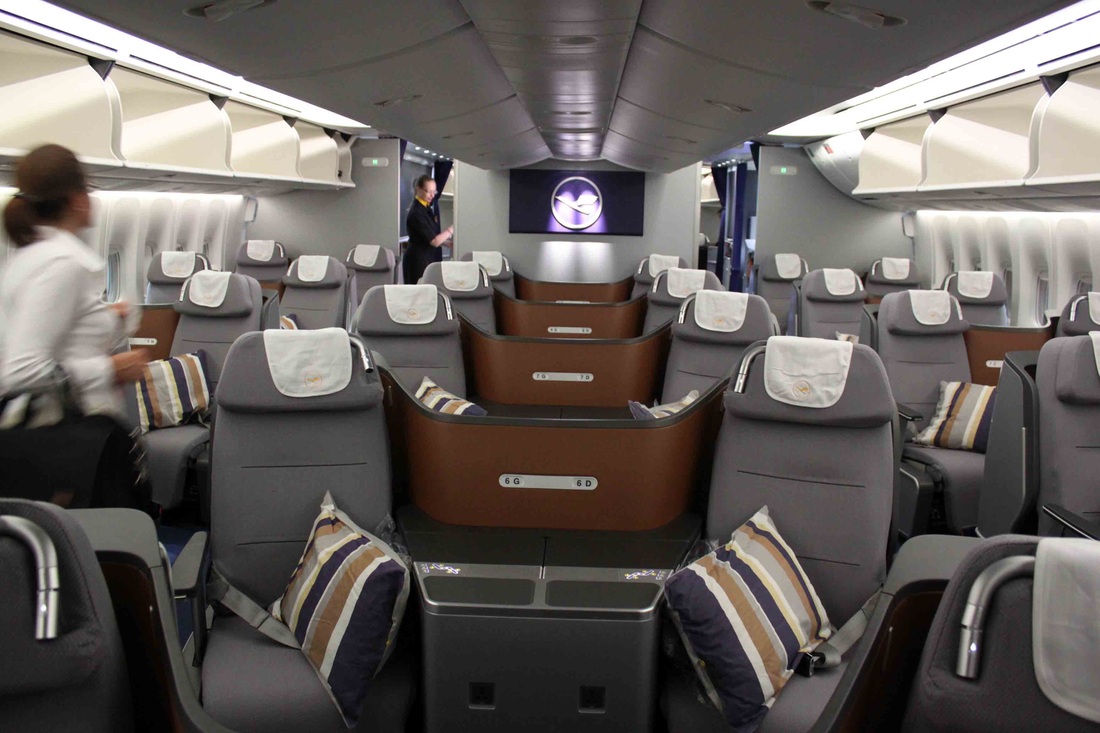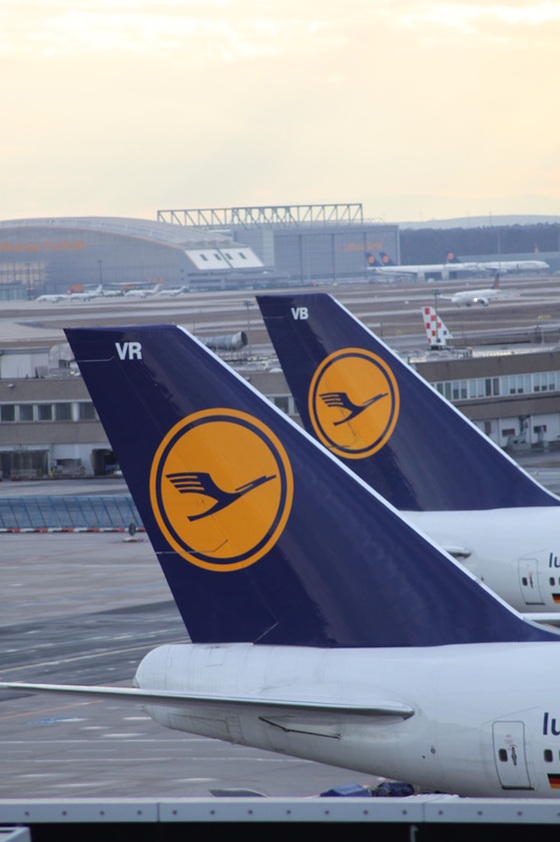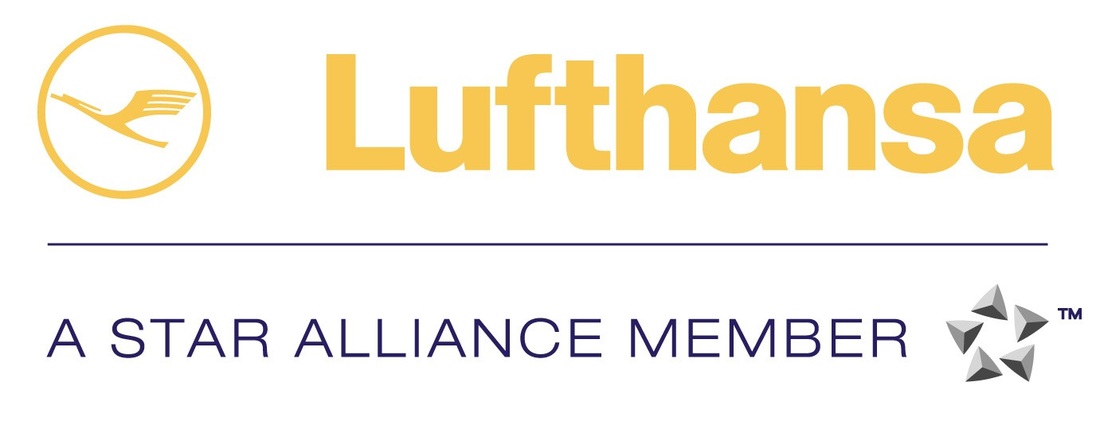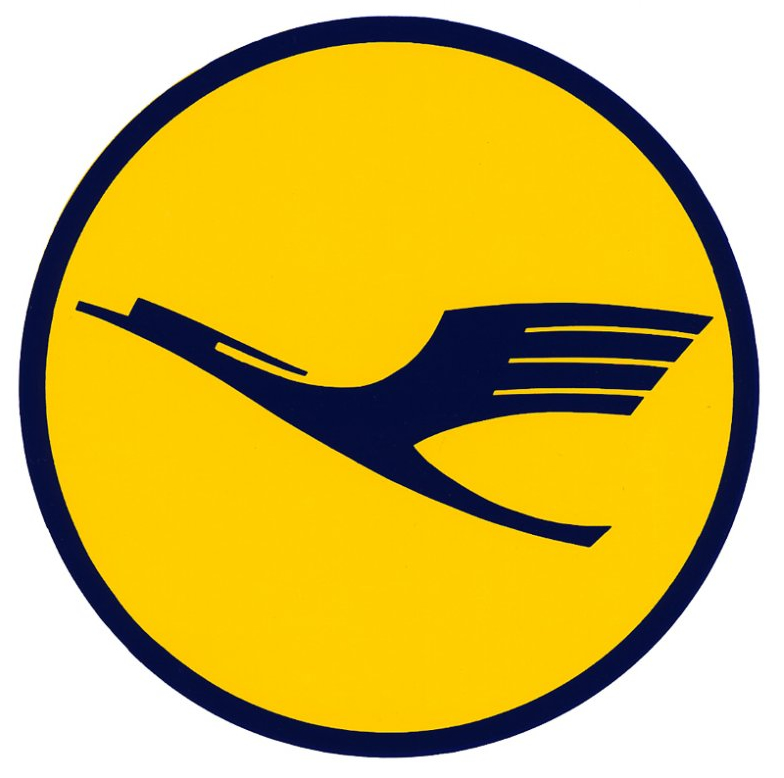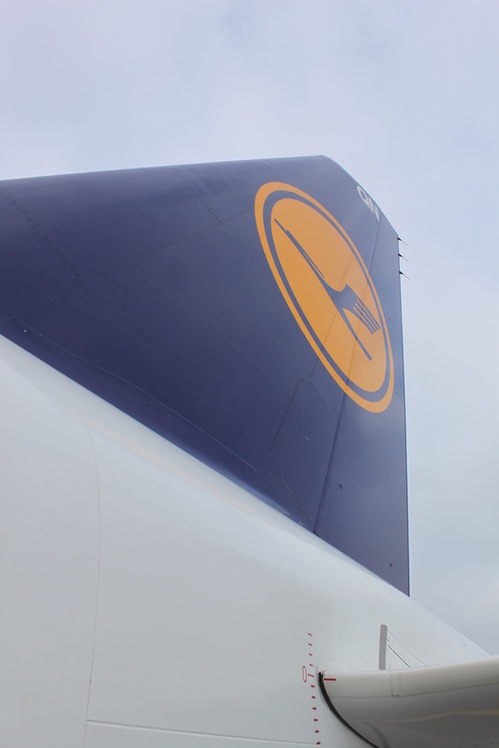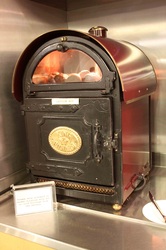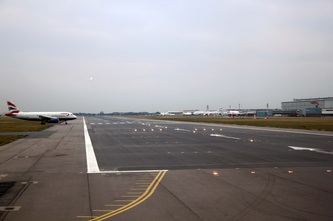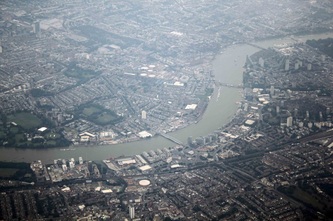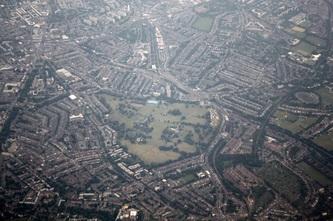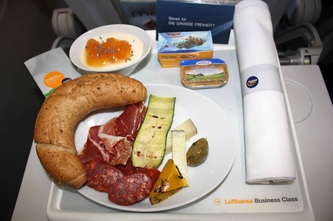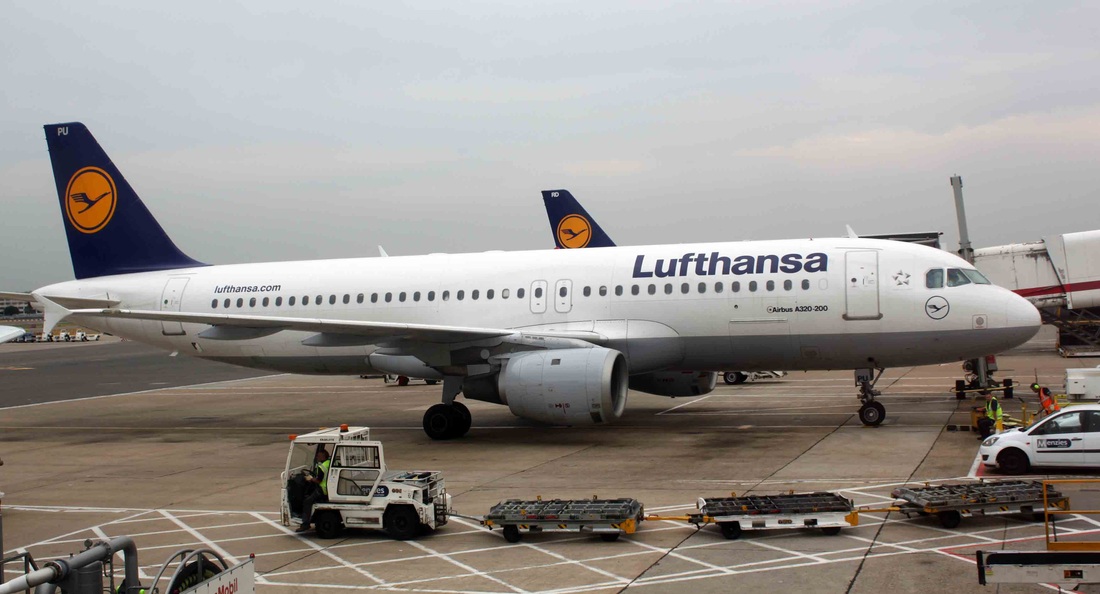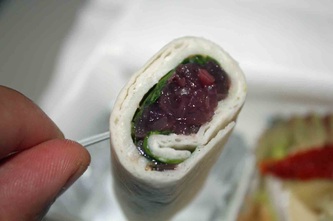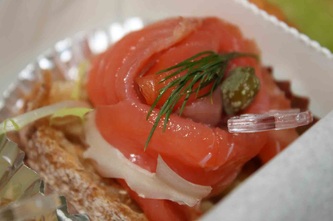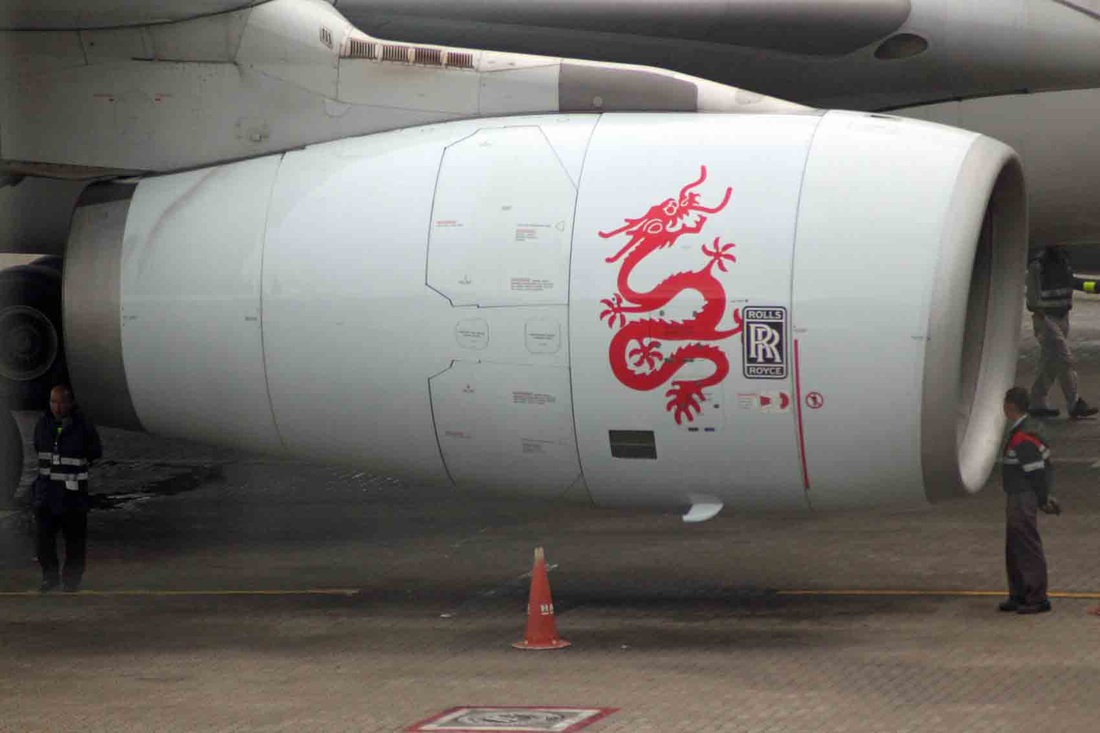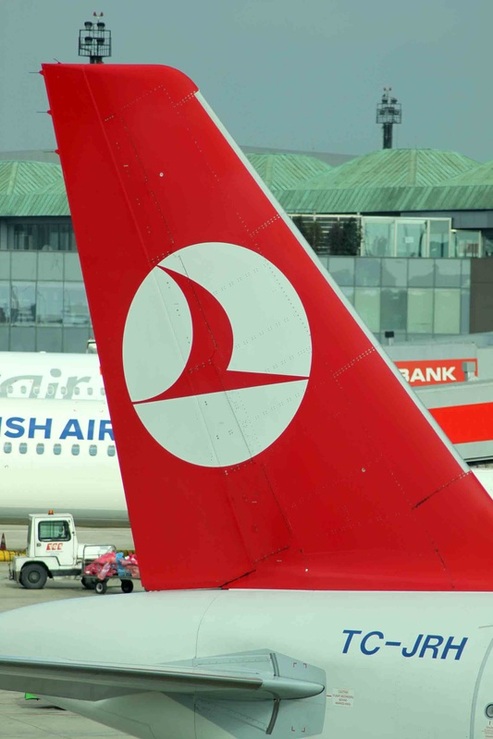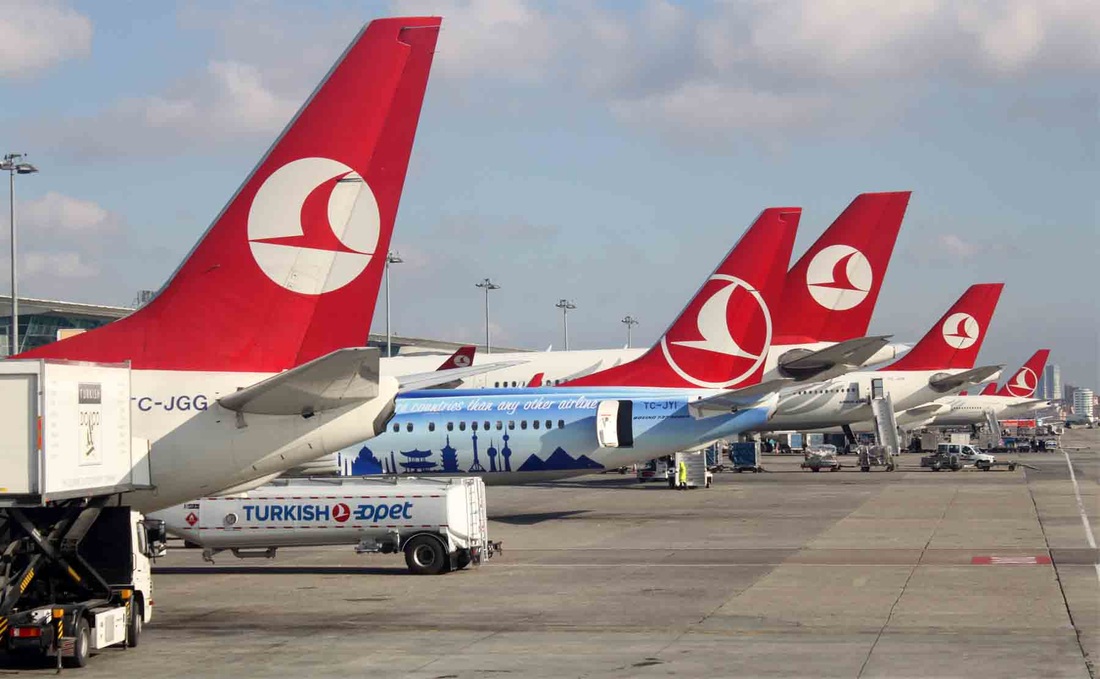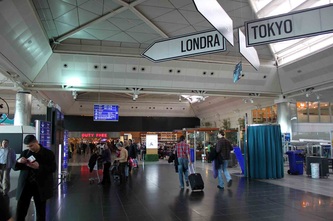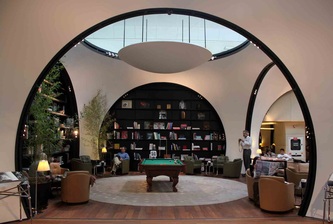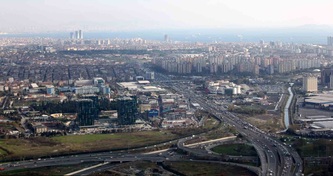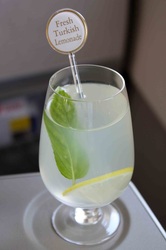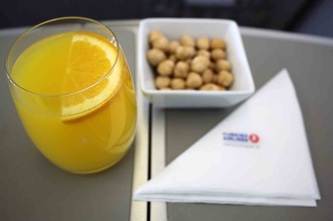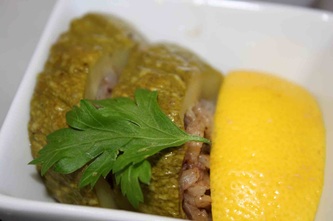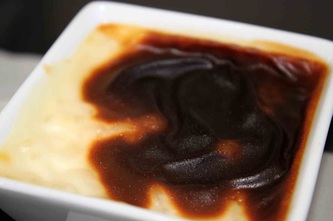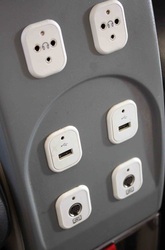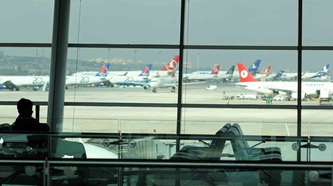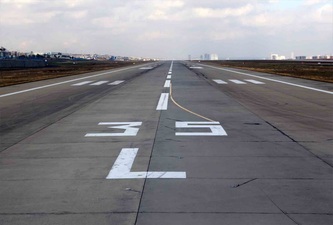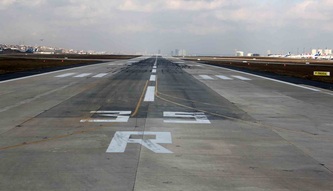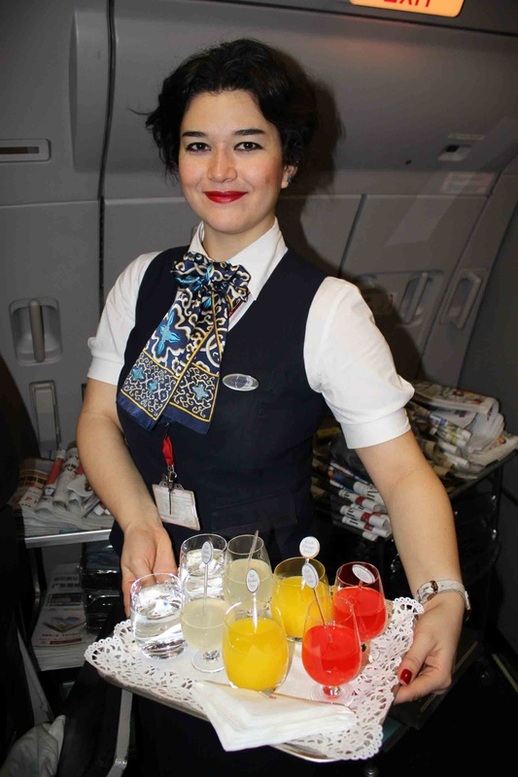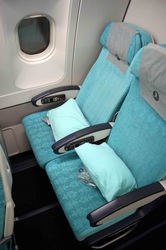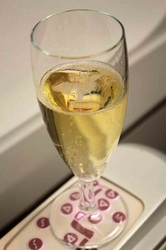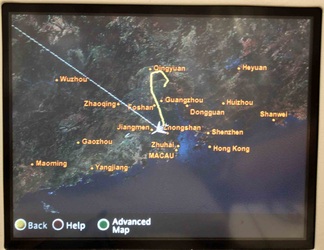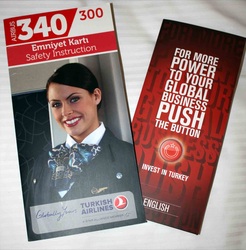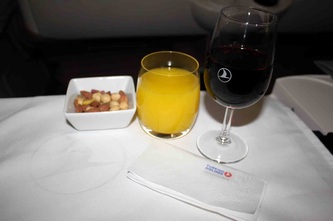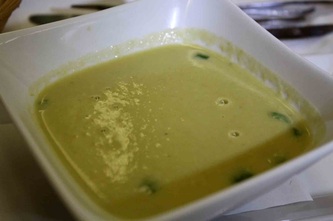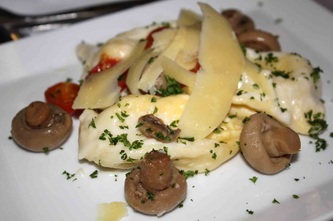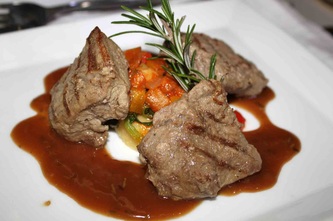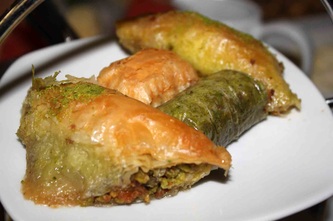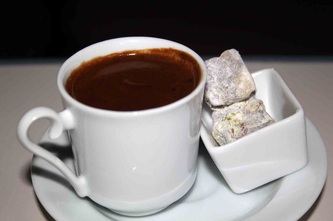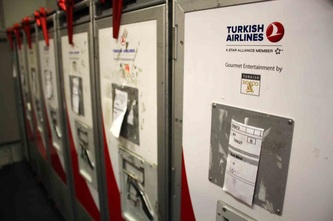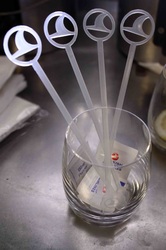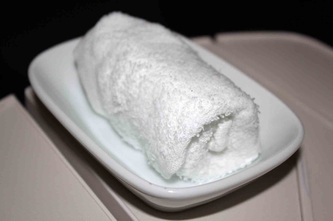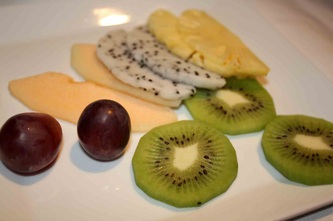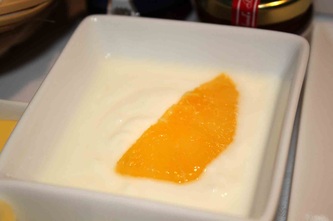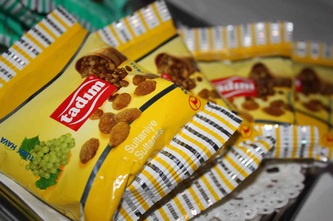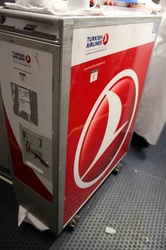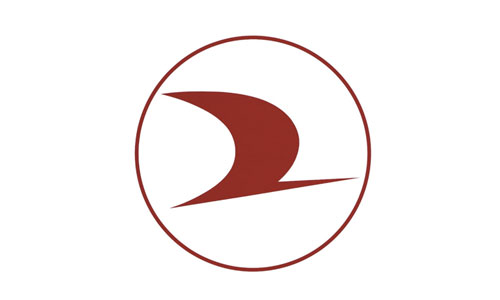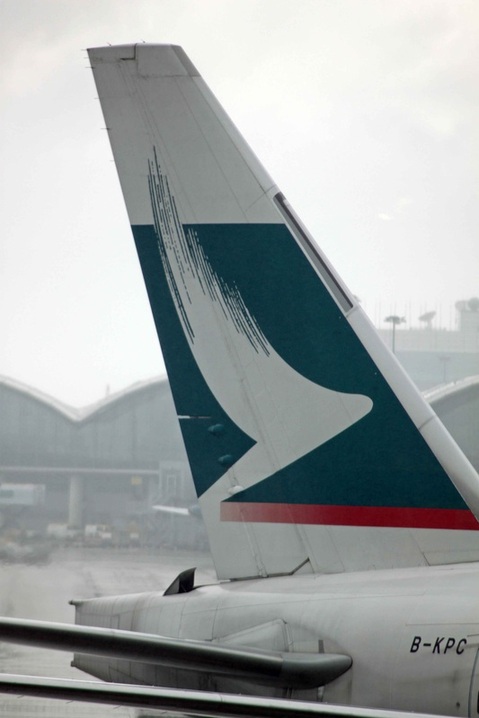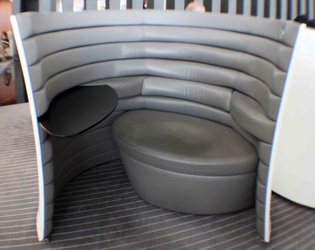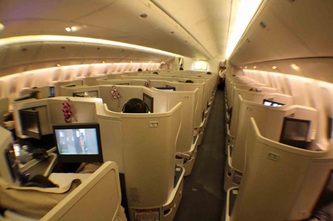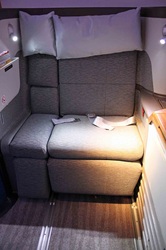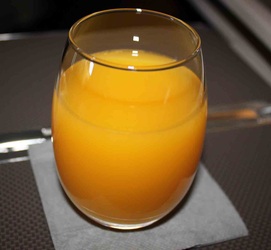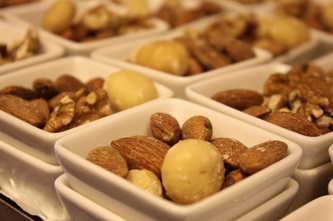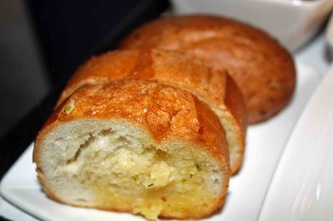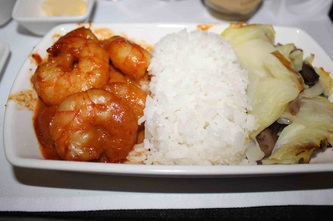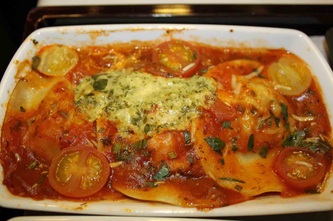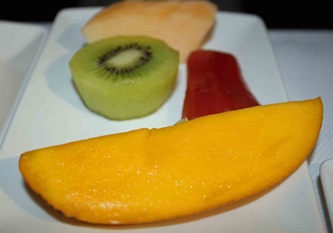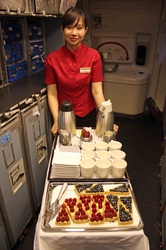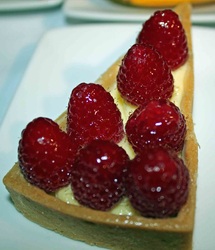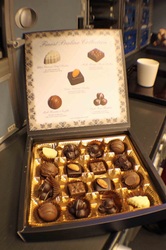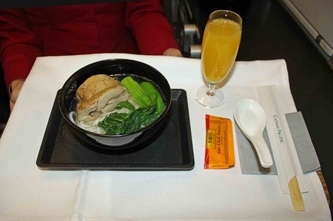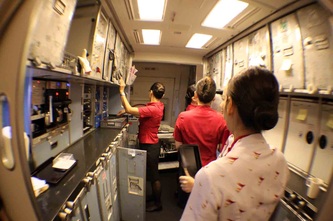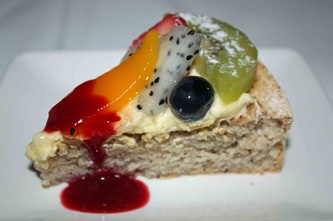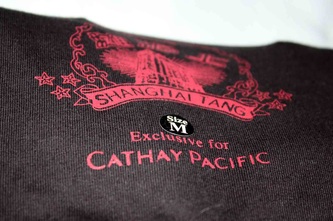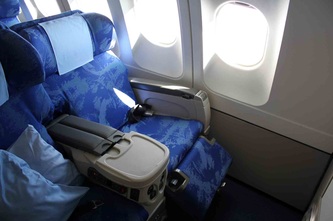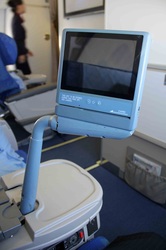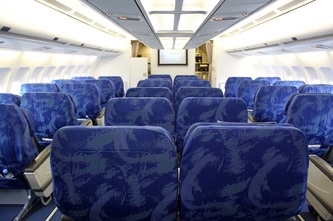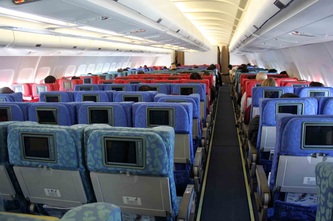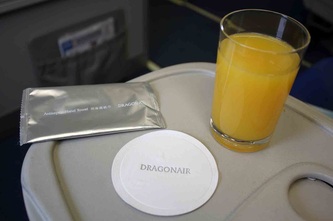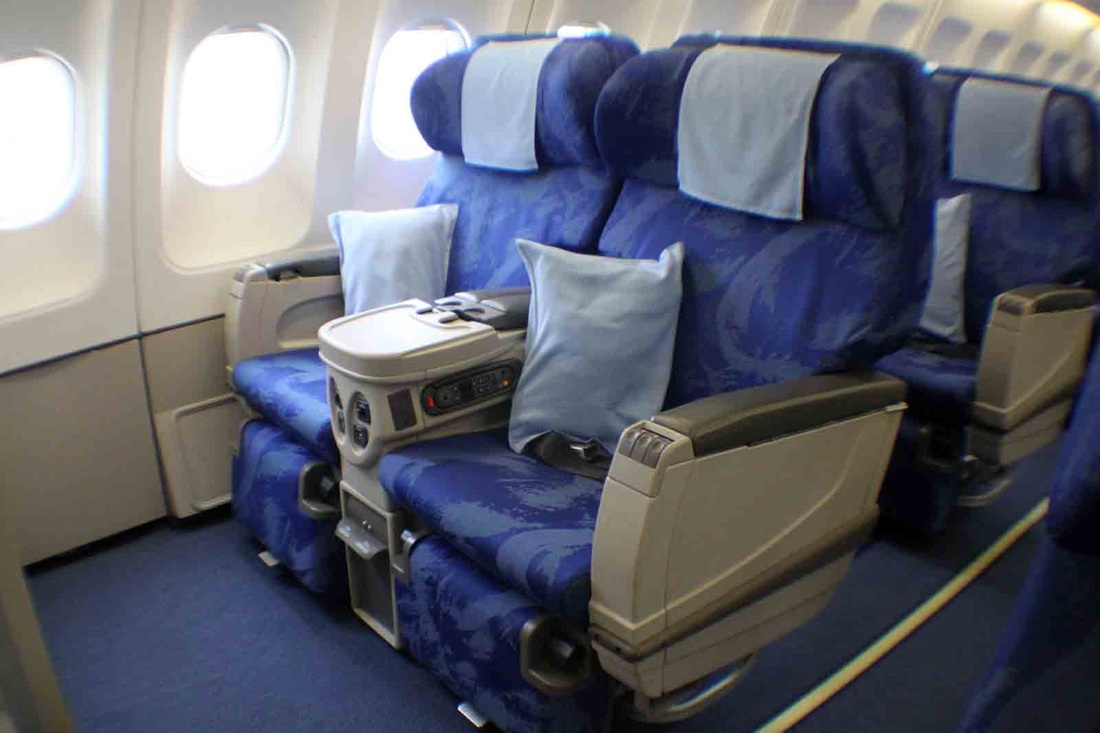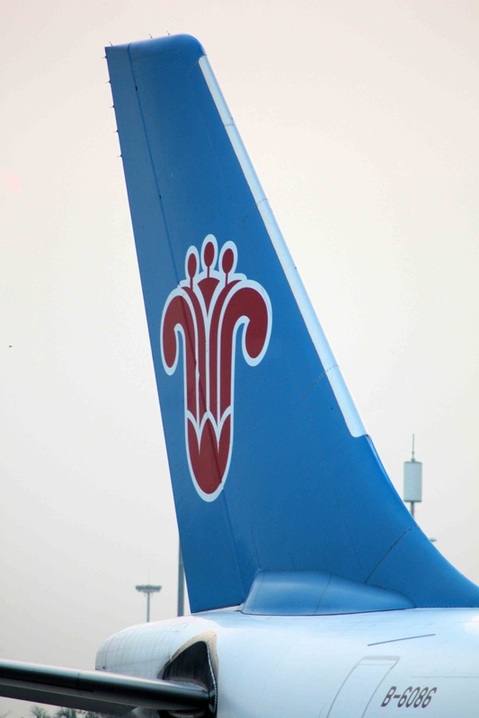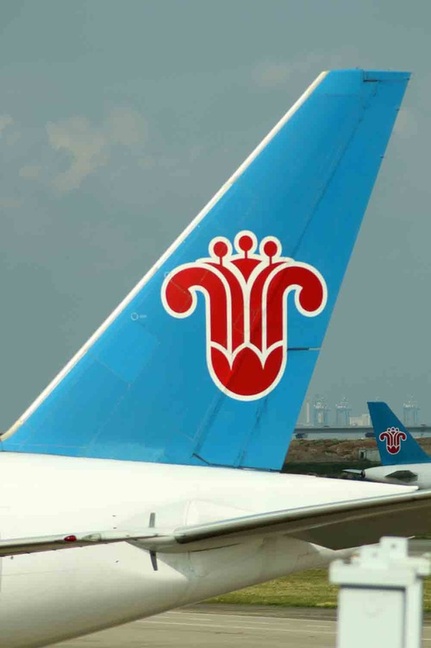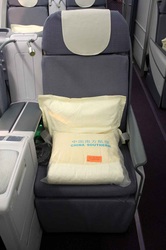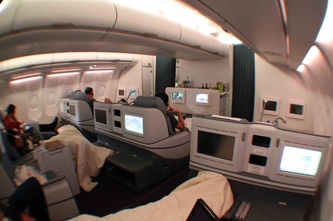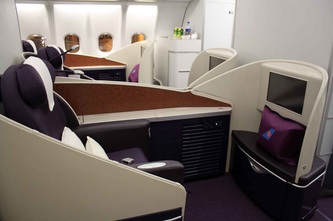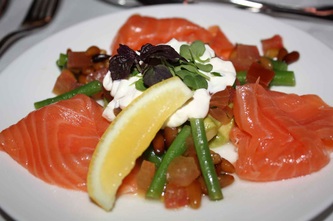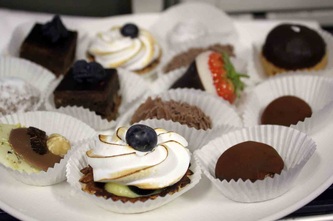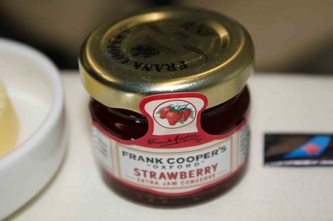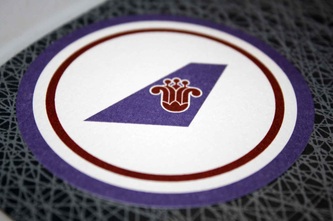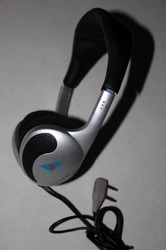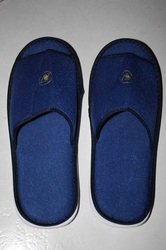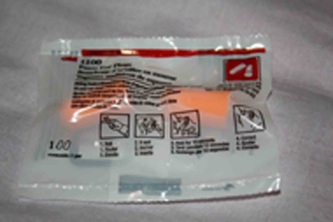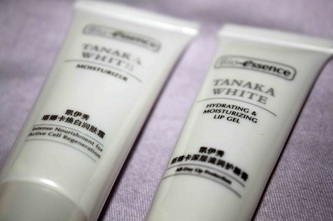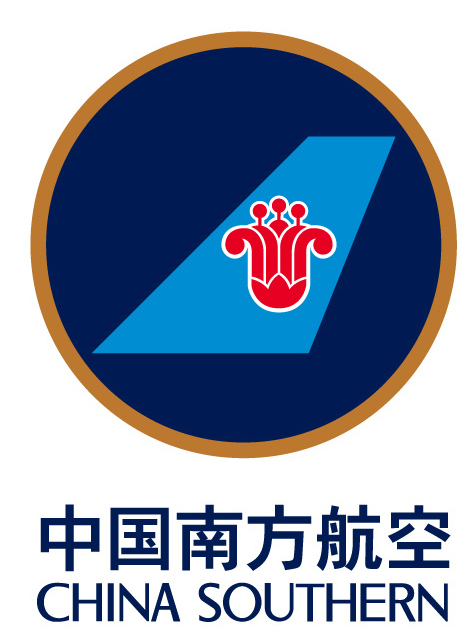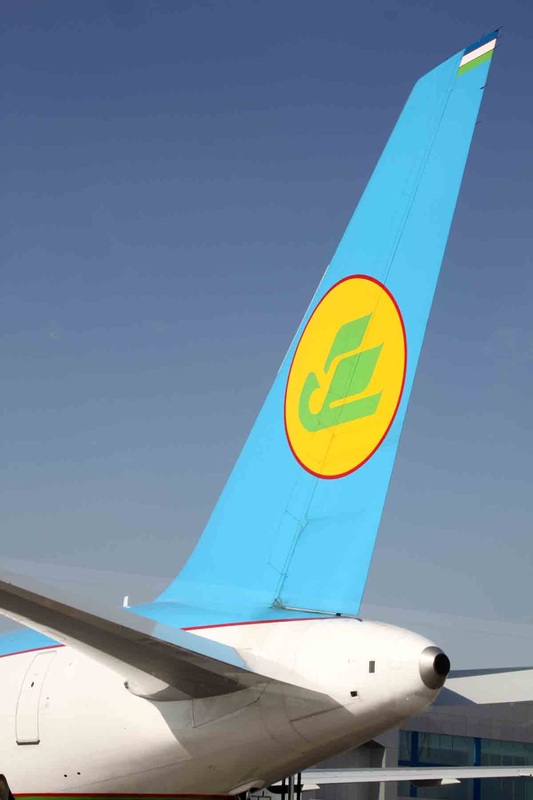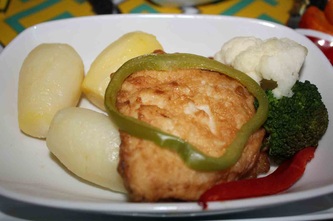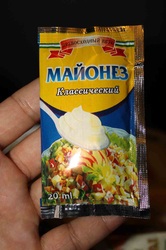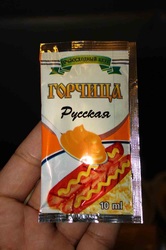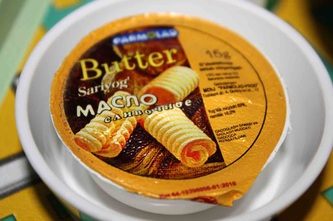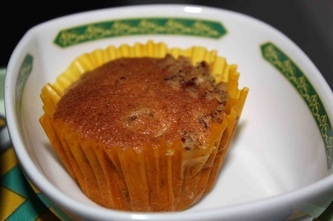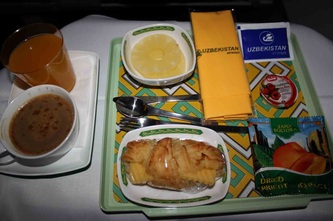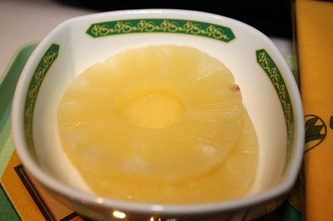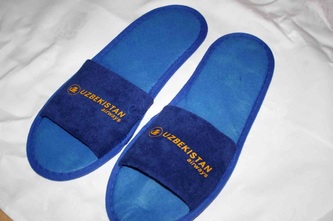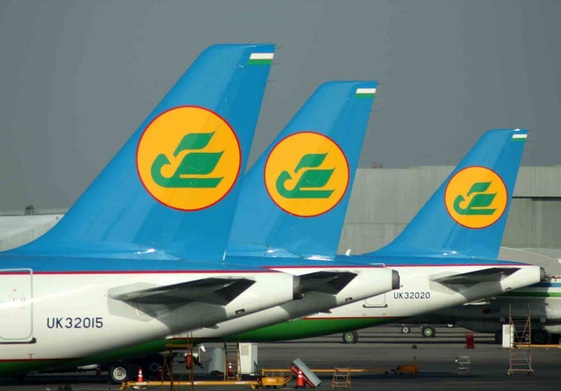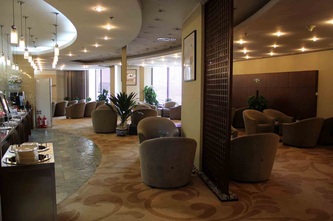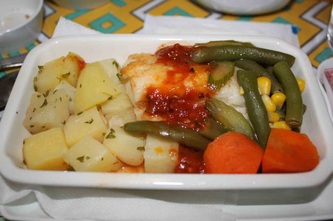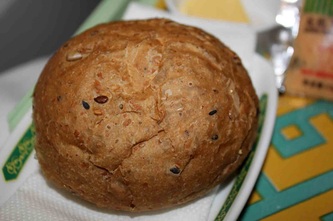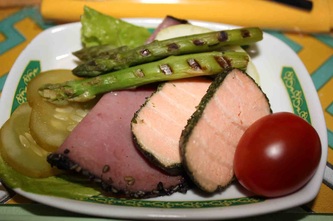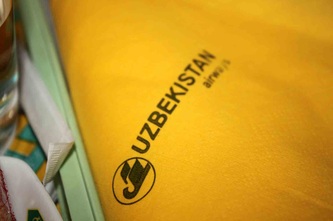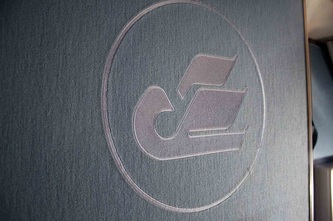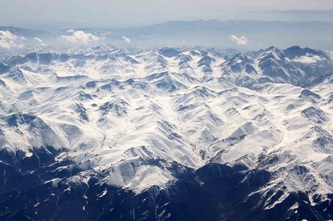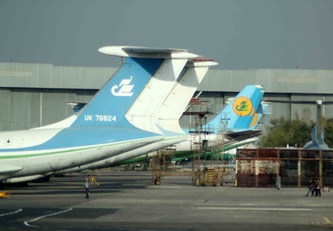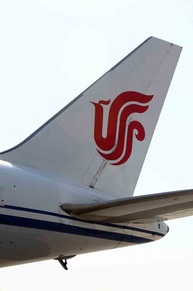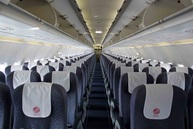OMAN AIR (Muscat Int. Airport to London Heathrow Int. Airport), BUSINESS CLASS, AIRBUS A330-343X8/20/2015
Oman Air is the flagship carrier of the Sultanate of Oman and an Official 4 Star Airline (Skytrax 2011). Founded in 1993, the airline has since witnessed massive growth and has played a major role in making Muscat an important traffic hub in the Middle East, supporting the commercial, industrial and tourism sectors. Currently Oman Air’s fleet consists of two Boeing 787 Dreamliners, six Airbus 330-300s, four Airbus 330-200s, five Boeing 737-900s, 18 Boeing 737-800, one Boeing 737-700, four Embraer 175s and an ATR 42. Four more Dreamliners will join the fleet in the following years. By 2018, Oman Air’s total fleet size is expected to be around 57 aircraft, rising to 70 aircraft by 2020. Oman Air scooped four awards at the Oman Airports Management Company Second Annual Awards ceremony, on February 2015. The national carrier of the Sultanate of Oman was recognized as one of the top five airlines by number of passengers carried at Muscat International Airport. It also received an award as one of the top three airlines at Salalah International Airport, as well as receiving accolades in the Non-Aeronautical and Stakeholder of the Year 2014 categories. Oman Air won two awards at the World Travel Awards Middle East 2015, where the national carrier of the Sultanate of Oman came top in the ‘Middle East's Leading Airline - Business Class’ and ‘Middle East's Leading Airline - Economy Class’ categories. Oman Air was also named as the winner of the ’Best Airline Staff Service in the Middle East’ award at the Skytrax World Airline Awards 2015. I tried and tested the Business Class seat on this short-haul flight from Muscat International Airport to London Heathrow Airport on the Airbus A330-343X aircraft. Route: MUSCAT (MCT) to LONDON HEATHROW (LHR) Departure date and time of flight: August 2015, 14:00 Flight number: WY101 (Oman 101 heavy) ATC Callsign: Oman Flight duration: 6 Hours 55 minutes Class: BUSINESS CLASS Aircraft type: AIRBUS A330-343X (six aircraft of this type in service) Aircraft registration: A4O-DB Aircraft Serial Number: 10044 First flight: 10th September 2009 Aircraft delivery date: 2nd October 2009 Aircraft engine types: Two x RR Trent 772B-60 Frequent flyer programme: Sinbad is the official frequent flyer program. Click here to see more. Seat configuration for this aircraft: First Class: Six suites (1-1-1-1 configuration) Business Class: 20 flatbed seats with 180 recline in a 1-1-1-1 configuration Economy Class: 202 seats in a 2-4-2 configuration Punctuality of the flight/route taken: The fully booked flight left Muscat on time and landed on time at London Heathrow, with around 10 minutes ahead of schedule of the arrival time. Any baggage issues: My bags had been checked in at Kathmandu Airport, so there were no issues at Muscat. Lounge experience at Muscat Airport: Business and First Class passengers flying with Oman Air can use the lounge at Muscat Airport, located after security. The first thought is that the lounge is almost empty with hardly a whisker in sight! It is definitely much more relaxed and quieter than what you may see in Doha, Dubai or Abu Dhabi, and much more of a relaxing experience. The airport is generally quieter as well, which is a good thing- less crowds! In-flight magazine: Wings of Oman is the in-flight magazine. Click here to read online PDF copies. Comments regarding the pre-flight service: Passengers’ in Business Class are offered hot lemon scented towels prior to departure. This is followed by a drinks service, which consists of some of the world’s finest wines, and champagne. In Business Class, the cabin crew offer various kinds of drinks prior to departure:
I opted for the orange juice on this occasion. Comments regarding the pre-meal service: Around about 45 minutes after departure, drinks were served from the trolley. Comments regarding the first meal: Starters with salad of mixed leaves and crisp vegetables For the main course, I opted for the flavours from the Sultanate: Pan-seared kingfish kebab with herb butter sauce, roasted wedges and char-grilled lemon. Very delicious. Accompanying the main dish was a bowl of fresh seasonal fruit, and a selection of warm bread from the basket. For dessert, there was homemade apple and blueberry pie, cinnamon sauce, chilled sauce. Comments regarding the second meal: The afternoon tea plate consisted of:
The afternoon tea was served with a selection of teas, provided by Twinnings and Dilmah. Comments on the in-flight entertainment system: Oman Air offers a variety of in-flight entertainment options, including video, audio and TV. Please click here to see more. On my flight, the IFE system did not work at all, which obviously was disappointing. However, it didn’t really matter much as it was a short flight. It would have been nice if the interactive map was working so that I could see where I was flying over but this was not working. No big deal. Otherwise, the flight experience was good. Oman Air’s Airbus A330-300 features 20 Business Class seats designed by BE Aerospace. Fitted in a 1-1-1-1 configuration, each comfortable and spacious 22-inch wide seat converts to a 77-82 inch long, fully flat bed. With electrically-operated backrest, seat bottom, seat depth and leg rest controls, and a folding armrest, each customer remains in control of their own environment for the duration of their flight. Furthermore, one-piece meal table and cocktail table offer a range of dining options, whilst an integrated reading light and mood light controls enable customers to work, read or relax, according to their wishes. A literature pocket, headset compartment, life vest compartment and ample storage space keep each passenger’s space neat. Access to the aircraft’s leading edge Thales AVANT in-seat audio video on demand (AVOD) inflight entertainment system is through a huge 17-inch monitor and easy-to-use touch screen handset. The system offers a wide range of movies, music, games and information. Charging devices and extended use of laptops is supported by each seat’s universal power outlet and two USB ports. And, having pioneered complete inflight mobile phone (GSM) and Wi-Fi connectivity in 2010, Oman Air has now raised the bar further by introducing the latest Airbus ALNA system for on-board WiFi and mobile phone usage. To complement this outstanding comfort and amenity, Oman Air has fitted the same Thales AVANT in-seat audio video on demand (AVOD) system in this short and medium haul aircraft as it has in its new long haul A330s. Both the Oman Air’s new Airbus A330-300s and new Boeing B737s feature seats newly-designed by Zodiac Aerospace. Each offers exceptional comfort and features a one-piece composite seat back structure, a high seat back pivot and articulating bottom pan and a four-way adjustable headrest. Seat pitches reflect the length of flights each aircraft are deployed upon, with the A330’s 202 seats offering 32 inches and the 737-900ER’s 171 seats offering 30 inches. A folding aisle-side armrest offers increased ease of access, and a sturdy, bi-fold, sliding food table makes a pleasure of in-seat dining or working. Meanwhile, the 10.6-inch seatback LCD screen offers access to the same IFE options as those enjoyed in Business Class. A USB is mounted on the LCD screen that can be used to charge any mobile smart phone and each pair of seats shares a PC power port. Comments of professionalism of the cabin crew: The cabin crew appear to have been trained very well, and seem to know how to handle all kinds of situations. The trainers must have had everything thrown at them, ranging from rowdy passengers to those having a nervous breakdown. These people are amazing. They really do pamper you. Most of the cabin crew are not natives of Oman itself, but are from South Asia or Asian countries in general (Philippines, Thailand, India, China etc.). Comments on the interior of the aircraft (including seat comfort): Oman Air’s Airbus A330-300 features 20 Business Class seats designed by BE Aerospace. Fitted in a 1-1-1-1 configuration, each comfortable and spacious 22-inch wide seat converts to a 77-82 inch long, fully flat bed. The Business Class seat looks and feels like a double bed! It is bigger than even some of the First Class seats I have seen on other airlines. There is certainly plenty of space available. I had my camera bag (which is annoyingly big), plus my laptop (I seldom have to sleep on a daytime flight so I end up working!), AND my carrier bag. All of these were neatly stored before departure. Oh, there is also space for you to put your shoes during the long flight so you can sit like as if you are sitting on your sofa at home. There were plenty of in-flight magazines and newspapers (both Arabic and Western) for passengers. A luxury amenity kit was provided on this flight by luxury brand Amouage. Oman Air logo and livery: In 2008, Oman Air completely overhauled its livery, switching its base colour from red to turquoise blue and ditching the traditional khanjar dagger symbol in favour of a logo representing incense smoke. Oman Air chief executive Ziad Al-Haremi at the time unveiled the new livery at a ceremony in Muscat. The new identity follows the Omani Government’s decision to withdraw from Gulf Air and concentrate on developing Oman Air as the sultanate’s sole flag-carrier. The livery features a gold-and-silver swirl which is reminiscent of a swirl of smoke from the aromatic resin frankincense for which Oman is particularly renowned. The turquoise colour represents the expanse of both the sky and the sea while the gold and silver colours stand for Oman’s wealth and silver artefacts – including the curved khanjar dagger, the national symbol which Oman Air’s livery previously featured. LUNCH SERVICEAFTERNOON TEAOman Air is the flagship carrier of the Sultanate of Oman and an Official 4 Star Airline (Skytrax 2011). Founded in 1993, the airline has since witnessed massive growth and has played a major role in making Muscat an important traffic hub in the Middle East, supporting the commercial, industrial and tourism sectors. Currently Oman Air’s fleet consists of two Boeing 787 Dreamliners, six Airbus 330-300s, four Airbus 330-200s, five Boeing 737-900s, 18 Boeing 737-800, one Boeing 737-700, four Embraer 175s and an ATR 42. Four more Dreamliners will join the fleet in the following years. By 2018, Oman Air’s total fleet size is expected to be around 57 aircraft, rising to 70 aircraft by 2020. Oman Air scooped four awards at the Oman Airports Management Company Second Annual Awards ceremony, on February 2015. The national carrier of the Sultanate of Oman was recognized as one of the top five airlines by number of passengers carried at Muscat International Airport. It also received an award as one of the top three airlines at Salalah International Airport, as well as receiving accolades in the Non-Aeronautical and Stakeholder of the Year 2014 categories. Oman Air won two awards at the World Travel Awards Middle East 2015, where the national carrier of the Sultanate of Oman came top in the ‘Middle East's Leading Airline - Business Class’ and ‘Middle East's Leading Airline - Economy Class’ categories. Oman Air was also named as the winner of the ’Best Airline Staff Service in the Middle East’ award at the Skytrax World Airline Awards 2015. I tried and tested the regional Business Class seat on this short-haul flight from Kathmandu International Airport to Muscat International Airport on the Boeing 737-800NG aircraft. Route: KATHMANDU (KTM) to MUSCAT (MCT) Departure date and time of flight: August 2015, 09:30 Flight number: WY332 (Oman 332) ATC Callsign: Oman Flight duration: 3 Hours 50 minutes Class: BUSINESS CLASS Aircraft type: BOEING 737-81MNG (17 aircraft of this type in service) Aircraft registration: A4O-BV Aircraft Serial Number: 40068/LN:5160 First flight: 30th October 2014 Aircraft delivery date: 21st November 2014 Aircraft engine types: Two x CFMI CFM56-7B26E Frequent flyer programme: Sinbad is the official frequent flyer program. Click here to see more. Seat configuration for this aircraft: Business Class: 12 angle flat seats in a 2-2 configuration Economy Class: 150 seats in a 3-3 configuration Punctuality of the flight/route taken: This early morning flight departed from Kathmandu on time and landed on time on a ridiculously hot morning in Muscat. After departing Kathmandu, the flight made its way towards India, while providing stunning views of the Himalayas, and then went right over New Delhi- the closest I have got to being on Indian soil in 16 years…albeit from 40,000 feet. Then we went over Pakistan, leaving Karachi before making a straight in approach into Muscat. Any baggage issues: Unlike in most other countries where friends and/or relatives can go inside the terminal up to the security check point, at Kathmandu Airport, only passengers are allowed to go inside the terminal building. It is somewhat a pleasant experience because the terminal is not so crowded, and therefore the check-in process is quite an effortless and smooth affair. After checking in on the ground floor. The process from check-in to the lounge through the security takes around about 15 minutes. Lounge experience at Kathmandu Airport: Business and First Class passengers flying with Oman Air can use the lounge at Kathmandu Airport, located after security. On this instance, I was the only passenger in the lounge. There are plenty of options for food and beverages, and majority of the entertainment (TV and reading material) is either in Nepalese, English or Hindi (and most of it is either from India or Nepal). The lounge is a communal lounge that is shared by many airlines. In-flight magazine: Wings of Oman is the in-flight magazine. Click here to read online PDF copies. Comments regarding the pre-flight service: Passengers’ in Business Class are offered hot lemon scented towels prior to departure. This is followed by a drinks service, which consists of some of the world’s finest wines, and champagne. In Business Class, the cabin crew offer various kinds of drinks prior to departure:
I opted for the orange juice on this occasion. The welcome drink was served with fresh dates from Oman, and warm and sticky nuts. Comments regarding the pre-meal service: Around about 35 minutes after departure, drinks were served from the trolley, including freshly brewed coffee and also tea as well. Comments regarding the breakfast meal: I opted for a Western breakfast meal, which was ‘tomato and sautéed onion omelette red pepper sauce roasted wedges chicken sausage glazed asparagus’. After the breakfast, standard tea and coffee with biscuits was served in bone china cutlery. Comments on the in-flight entertainment system: Oman Air offers a variety of in-flight entertainment options, including video, audio and TV. Please click here to see more. On my flight, the IFE system did not work at all, which obviously was disappointing. However, it didn’t really matter much as it was a short flight. It would have been nice if the interactive map was working so that I could see where I was flying over but this was not working. No big deal. Otherwise, the flight experience was good. The Oman Air Boeing B737-800NG cabin offers 12 Recaro-designed Business Class seats in a 2-2 configuration. Each seat features electric backrest/seat bottom, leg rest and seat depth controls, a 10.6-inch in-arm video screen, PC power outlet, USB port, reading light and literature pocket. To complement this outstanding comfort and amenity, Oman Air has fitted the same Thales AVANT in-seat audio video on demand (AVOD) system in this short and medium haul aircraft as it has in its new long haul A330s. Both the Oman Air’s new Airbus A330-300s and new Boeing B737s feature seats newly-designed by Zodiac Aerospace. Each offers exceptional comfort and features a one-piece composite seat back structure, a high seat back pivot and articulating bottom pan and a four-way adjustable headrest. Seat pitches reflect the length of flights each aircraft are deployed upon, with the A330’s 265 seats offering 32 inches and the 737-900ER’s 171 seats offering 30 inches. A folding aisle-side armrest offers increased ease of access, and a sturdy, bi-fold, sliding food table makes a pleasure of in-seat dining or working. Meanwhile, the 10.6-inch seatback LCD screen offers access to the same IFE options as those enjoyed in Business Class. A USB is mounted on the LCD screen that can be used to charge any mobile smart phone and each pair of seats shares a PC power port. Comments of professionalism of the cabin crew: The cabin crew appear to have been trained very well, and seem to know how to handle all kinds of situations. The trainers must have had everything thrown at them, ranging from rowdy passengers to those having a nervous breakdown. These people are amazing. They really do pamper you. Now, I am not saying this because I was travelling in Business Class, but the crew were very friendly and hospitable to ALL the passengers, and showed a genuine smile whenever. Like I said before that I have not been on any of the South Asian carriers, and I have read horror stories of passengers experiencing delayed flights, bad customer service, blocked toilets etc. But, contrary to belief, I experienced none of that. The plane was very clean, the food was out of this world delicious, and the customer service was authentic, genuine and just awesome. Comments on the interior of the aircraft (including seat comfort): The Business Class regional cabin is fitted with the spanking new fully angle flat seat, which has a pitch of 40 inches and a width of 21. There is certainly plenty of space available. I had my camera bag (which is annoyingly big), plus my laptop (I seldom have to sleep on a daytime flight so I end up working!), AND my carrier bag. All of these were neatly stored before departure. Oh, there is also space for you to put your shoes during the long flight so you can sit like as if you are sitting on your sofa at home. There were plenty of in-flight magazines and newspapers (both Arabic and Western) for passengers. There was no amenity kit provided for this short-haul regional flight. Oman Air logo and livery: In 2008, Oman Air completely overhauled its livery, switching its base colour from red to turquoise blue and ditching the traditional khanjar dagger symbol in favour of a logo representing incense smoke. Oman Air chief executive Ziad Al-Haremi at the time unveiled the new livery at a ceremony in Muscat. The new identity follows the Omani Government’s decision to withdraw from Gulf Air and concentrate on developing Oman Air as the sultanate’s sole flag-carrier. The livery features a gold-and-silver swirl which is reminiscent of a swirl of smoke from the aromatic resin frankincense for which Oman is particularly renowned. The turquoise colour represents the expanse of both the sky and the sea while the gold and silver colours stand for Oman’s wealth and silver artefacts – including the curved khanjar dagger, the national symbol which Oman Air’s livery previously featured. Malaysia Airlines is the national flag carrier of Malaysia and is the largest airline in Malaysia based on fleet size, international destinations and international flights. The airline serves 60 destinations, both international and domestic. It is among the top 20 airlines in the world in terms of passengers carried and is also the top-ranked international cargo airline. At the time of writing, Malaysia Airlines operates a fleet of 86 aircraft, including 6 Airbus A380 and 56 state-of-the-art Boeing 737NG aircraft. This was the first time I flew with Malaysia Airlines. I was on the flight from Kuala Lumpur International Airport to Kathmandu International Airport on Malaysia Airlines’ Boeing 737-800NG to check out their Business Class seats! Route: KUALA LUMPUR INTL. AIRPORT (KUL) to KATHMANDU (KTM) Departure date and time of flight: 09:55am, August 2015 Flight number: MH170 (ICAO call sign: “Malaysian”) Flight duration: 4h 50m Class: BUSINESS CLASS Aircraft type: BOEING 737-800NG (56 in service) Unit cost of each Boeing 737-800NG: US$72.5 million (2015) Aircraft registration: 9M-MSB (First flight 7th March 2013) Engine Type: Two x CFMI CFM56-7B26 Aircraft Serial Number: 40144 LN: 4385 Frequent flyer programme: Malaysia Airlines' frequent flyer programme is called Enrich by Malaysia Airlines (Enrich). Enrich comprises a variety of airlines, banks, credit-card issuers, hotels and retailers around the world. Seat configuration for this aircraft: Business Class: 16 angle-flat seats in a 2-2 configuration Economy Class: 150 seats in a 3-3 configuration Punctuality of the flight: Departed bang on time, and landed exactly on time in a hot and dry Kathmandu. Any baggage issues: No issues regarding the baggage. For Economy Class, Malaysia Airlines have a checked baggage allowance of 23 kg total for all routes excluding transatlantic routes, and upto 40kg for Business Class. All routes have a carry-on allowance of one piece not exceeding 7 kg (50x37x25 cm). Click here to see more details Comments on the check-in staff and flight route: The check-in staff were very professional and came across as well-trained. At Kuala Lumpur airport, Malaysia Airlines have a separate check-in for Business Class passengers. The flight departed on time and landed on time as well. 90% of the flight was over cloudy skies, and so on approach to Kathmandu, there was a slight glimpse of the Himalayas as we came in from Indian airspace. Lounge Experience at Kuala Lumpur The Golden Lounge is the airport lounge for Malaysia Airlines First Class, Golden Club Class passengers and Enrich Platinum and Enrich Gold, eligible Oneworld and code-share partner members. The Golden Lounges have open bars and food catering. There are 11 Golden Lounges throughout the world, and qualified passengers have full reciprocal privileges at lounges operated by selected partners. The lounge offers various services such as business centres, food catering, slumber rooms and child-care centres. Lounges are maintained at the following airports: Kuala Lumpur, Kota Kinabalu, Kuching, London, Melbourne and Penang. In April 2008, the airline launched its new Regional Golden Lounge at the KL International Airport (KLIA) for regional-bound front-end passengers. With this new lounge, Malaysia Airlines at Kuala Lumpur International Airport now has three lounges: the Satellite International Terminal Lounge, Domestic Lounge and Regional Lounge. From 1 September 2015, Malaysia Airlines closed down lounges in Perth Airport and Singapore Changi Airport in order to cut and slash cost for their renationalisation. The lounge was quite empty, with only a handful of passengers for the morning flights that were going out of KL. Comments regarding the pre-flight service: Upon embarking the aircraft, passengers in Business Class and Economy Class were offered welcome drinks consisting of fresh orange juice, fresh apple juice, mineral water (champagne, wines in Business Class only). The cabin crew are truly one of the best trained I have met on any other airline. Customer comes first and Malaysia Airlines truly define the meaning of a five-star service. Comments regarding the pre-meal service: Passengers in Business Class were offered a packet of fresh pretzels packed in Malaysia Airlines branded packets, and a choice of drinks from the trolley service. The cabin crew were polite and friendly. Even though this flight was full, the cabin crew paid full attention each and every customer instead of just passing the meal to passengers like they do on some other airlines. A warm and wet towel was handed out to Business Class passengers. I just resorted to drinking plenty of bottled water. Though they may sound very tempting, however, alcohol and coffee are not good to drink during a flight as it just dehydrates you. Water is the best. Comments regarding the first meal: The main meal tray arrived at around 30 minutes after take-off from Kuala Lumpur. There were two options for the main meal:
I opted for the Western breakfast. Cheese Omelette, which consisted of roasted new potato, chicken sausage, cherry tomato and mushroom. Accompanying the main dish was a bowl of fresh seasonal fruit. For dessert, I had strawberry and lime charlotte. Malaysia Airlines serves their meals using stainless steel cutlery. Comments regarding the after meal drinks and in-flight snacks: Plenty of fresh water, coffee and tea are offered in lovely Malaysia Airlines branded bone china cups were offered. Comments regarding the second meal: None. There was no second meal. Comments on the in-flight entertainment system: Almost all 737-800s have personal AVOd screens featuring a wide variety of music and audio options. All other 737-800s have standard audio options. Almost all 737-800s have personal AVOD screens for all seats. Business Class has 10.6" screens while Economy Class has 9" screens. All other 737-800s have overhead screens. There is an 110v AC power outlet at every Business Class seat. Comments of professionalism of the cabin crew: The cabin crew were very hospitable, and proud to work for Malaysia Airlines. There was a genuine smile on every crew members face and you could tell that they really enjoyed their job. There was a real sense of teamwork in the cabin. As a customer (or passenger) it is easy to tell if the cabin crew are not getting along with each other (it does happen like any other job!), and on this flight I could see that everyone was in a joyous mood. If there was something I wanted or a question I had, then no one objected to it. Instead, they tried their best to help me as much as they could. The senior purser was just gem of a person. The whole flight experience was like magic, and everything seemed to go smoothly. So, yes the world can be ideal sometimes. I wrote about this flight here. Comments on the interior of the aircraft (including seat comfort): Business Class (previously known as Golden Club Class) is available on all of Malaysia Airlines' fleet. In 2011, Malaysia Airlines introduced the new business class seats on their brand new Airbus A330-300. While newer regional business class seats were also introduced on the Boeing 737-800 to be used on short-medium haul routes such as Kota Kinabalu, Taipei and Manila. Seats made by Recaro within the business class cabin of new A330-300 are configured in pairs (2-2-2) layout, fitted with in-seat power and USB port, as well as new Select 3000i on a 15.4 inches touch screen panel, while the Boeing 737-800 are fitted in pairs (2-2) inclusive of the new Select 3000i and have recline ability. The first Airbus A330-300 carrying the new Regional Business Class was assigned to Kuala Lumpur - Brisbane sector on 20 April 2011. Starting April 2015, Malaysia Airlines introduced new Business Class seats, provided by Thompson Aero Seating, equipped with fully lie-flat seats for their A330 fleet. This will be in a staggered layout with alternate rows in the 1-2-2 and 1-2-1 configuration. Meal tray table conveniently stowed in the armrest. Cocktail tables are available at the center armrest. Individual overhead reading lights. Seat cover: Woolen. Headrest cover: Linen. Seats are arranged in pairs (2-2). Malaysia Airlines logo and livery: The original corporate logo was designed by Dato' Johan Ariff, and was introduced on 15 October 1987, retaining the essence of the moon kite, with a sheared swept-back look. Along with the new corporate logo, a new type style - MALAYSIA, was created. It is italicised to slant parallel with the logo to accentuate speed as well as direction. Within this corporate typestyle, the letters MAS bear red clippings to denote the initials of the statutory name of the airline, Malaysian Airline System (MAS), and were added after the original design was rejected by former Prime Minister Mahathir Mohammad. The introduction of blue to the original red logo has national significance. The red and blue divides equally in the middle to denote equilibrium. On 8 March 2012, Malaysia Airlines unveiled a new logo featuring an all-blue moon kite and livery for its Airbus A380 fleet. Months later, the corporate logo of red and blue was refreshed. The new moon kite logo faces from left to right, as it did in the original 1971 logo, and its tails have been extended. The wordmark has also been modernised with a new typeface and the word "airlines" is now presented in lowercase. On 1st September 2015, Malaysia Airlines rebranded as Malaysia Airlines Berhad but for the time being remained to use the same logo and branding Overall rating 1-10 (worst-best): 10 SriLankan Airlines (marketed as SriLankan) is the national flag carrier of Sri Lanka. It is headquartered in Katunayake, Sri Lanka, with its hub at Bandaranaike International Airport. SriLankan operates directs flights to Asian, European and Middle East destinations along with its code share routes which include to destinations in USA, Oceania as well. It became a member of the Oneworld alliance in 2014. SriLankan was established in 1978 as Air Lanka, following the termination of operations of the original Sri Lankan flag carrier Air Ceylon. Following its partial acquisition in 1998 by Emirates it was re-branded to "SriLankan" and introduced the current livery. After ending the Emirates partnership, it continues using its re-branded name and logo. As of March 2015, SriLankan Airlines serves 96 destinations in 49 countries, including codeshares and remains the largest foreign carrier into the Maldives, with over 30 weekly flights between Male and Colombo. SriLankan Airlines currently operates 258 weekly flights to 33 destinations in 20 countries, covering the main cities of the Europe, Middle East, India, South East Asia and the Far East. I tried and tested the new Business Class seat on this long-haul flight from Colombo Bandaranaike International Airport to London Heathrow Airport: Route: COLOMBO (CMB) – LONDON HEATHROW (LHR) Departure date and time of flight: May 2015, 12:50pm Flight number: UL503 (Srilankan 503) ATC Callsign: Srilankan Flight duration: 11 Hours 50 minutes Class: BUSINESS CLASS Aircraft type: AIRBUS A330-343E (5 aircraft of this type in service) Aircraft registration: 4R-ALN Aircraft Serial Number: 1604 First flight: 28th January 2015 Aircraft delivery date: 26th March 2015 Aircraft name: City Of Kolomtota Aircraft engine types: Two x Rolls Royce Trent 772B-60 Frequent flyer program: SriLankan FlySmiles Program Seat configuration for this aircraft: Business Class: 28 flatbed seats with 180 recline in a 2-2-2 configuration Economy Class: 269 seats in a 2-4-2 configuration Punctuality of the flight/route taken: I had come in from Singapore on SriLankan, and so this was a connecting flight onwards to London Heathrow. Every crew member says they dread this flight because it is so long (nearly 12 hours), and also placed at an awkward time – the whole of the 12 hours are spent in daylight because you take off at lunchtime Colombo time and land in the summer evening in London (daylight during the late Spring). The flight departed on time and arrived on time at Heathrow (thankfully there was no delay in holding over London). The flight flew over India, the Middle East, Turkey and then onwards Europe. I'm so glad I got the chance to fly over the Tabriz area, the legendary 'Secret Garden of Eden'...spectacular...mountains sticking out at 3,000 meters above sea level. In his published work, Legend: The Genesis of Civilisation, David Rohl posts a location for the legendary Garden of Eden in Iranian Azerbaijan, in the vicinity of Tabriz upon which the Genesis tradition was based. According to Rohl, the Garden of Eden was then located in a long valley to the north of Sahand volcano, near Tabriz. Any baggage issues: I had my luggage checked in at Singapore Changi, so there was no need to worry about the baggage here. You can check here for more information in regards to the baggage requirements. Lounge experience at Colombo International Airport: SriLankan Airlines operate the Serendib Lounge for their Business and First Class passengers. The lounge can also be used by those travelling on flights with OneWorld Alliance partner airlines. The WiFi enabled lounge is well-managed, clean and there are plenty of options for food and beverages. In-flight magazine: Serendib is the in-flight magazine for Sri Lankan Airlines Comments regarding the pre-flight service: Passengers’ in Business Class are offered hot lemon scented towels prior to departure. This is followed by a drinks service, which consists of some of the world’s finest wines, and champagne. In Business Class, the cabin crew offer various kinds of drinks prior to departure:
I opted for a glass of champagne and a plate of cold canape. The cold canape consisted of cheese and salmon cutlets. Comments Regarding The First Meal (Lunch): For the first meal, a choice of four entrées were provided– all selected from a superb range of Asian and Western dishes. Meals are served on a low trolley that gives the passenger an inviting eye-level choice of what's on offer and the airline is also introducing new food service items with a more Asian feel in their Business Class. All food in the Business Class cabins in SriLankan is served on elegant bone china tableware specially designed and exclusively produced by Noritake. Starters: Freshly prepared soup cream of mushroom with garlic French croutons The soup was served with a selection of warm bread from the basket. After the soup, we were served with an appetizer of: Seafood terrine and poached lagoon prawns served on a bed of fennel, gourd and citrus salad accompanied by a coriander and chilli cocktail sauce Very well-cooked. The prawns were skinless, and went very well with the lemon and sauce garnishing. Main Course: Lagoon prawn curry with steamed rice, brinjal moju, bitter gourd salad, cashew & pea curry, Malay pickle, papadams and fried chilli This was served with endless amounts of warm bread from the basket. Cheese & Dessert: A selection of Blue d’Auvergne, red Leicester, Taleggio with cabernet paste A selection of fresh seasonal fruit A plate full of a trio of miniature sweet delights Comments Regarding The Second Meal (Dinner): Around about two hours before landing, we were served with dinner. I opted for: Sri Lankan marinated chicken skewer with devil sauce, mini tomato and seafood pizza topped with feta cheese accompanied with oats & herbs crumbed sausages & cheesy cantered risotto croquette with spicy tomato chutney & cucumber, onion & tomato salad This was served with plenty of drinks, and warm bread from the basket, as well as, a plate of fresh seasonal fruit as dessert. Comments on the in-flight entertainment system: This aircraft features AVOD (Audio and Video OnDemand) with every seat having access to a personal video screen, offering various audio programming options. There is a wide selection of movies, TV and music to choose from. Comments of professionalism of the cabin crew: The cabin crew appear to have been trained very well, and seem to know how to handle all kinds of situations. The trainers must have had everything thrown at them, ranging from rowdy passengers to those having a nervous breakdown. These people are amazing. They really do pamper you. Now, I am not saying this because I was travelling in Business Class, but the crew were very friendly and hospitable to ALL the passengers, and showed a genuine smile whenever. Like I said before that I have not been on any of the South Asian carriers, and I have read horror stories of passengers experiencing delayed flights, bad customer service, blocked toilets etc. But, contrary to belief, I experienced none of that. The plane was very clean, the food was out of this world delicious, and the customer service was authentic, genuine and just awesome. From my experience, flying with SriLankan was no different to that of flying with Cathay Pacific, Emirates, and Qatar Airways. And the most important part of all? The cabin crew welcome the passengers by saying Namaste (palms clasped and head bowed), and also say a thank you in a similar fashion before landing. It is something that Western airlines can learn from. Trust me, believe me, I have come across some cabin crew on some of the best airlines in the world (Oman Air, Etihad, British Airways, KLM, Cathay Pacific to name a few), that have had an attitude problem of some sort or another with passengers (we all have our good and bad days), but the hospitality shown by the SriLankan crew was second to none. Just wonderful. Comments on the interior of the aircraft (including seat comfort): The new Business Class regional cabin is fitted with the spanking new flatbed seat, which has a pitch of 77-79 inches and a width of 21 inches. It is a fully flatbed and provides a decent amount of sleep for the back. Very comfortable for a long flight. Unlike some other Business Class seats where the seat dips at the feet, this seat doesn’t – it is full flat and feels like a copy bed with your own privacy space to hide away under the warm quilt! There is certainly plenty of space available. I had my camera bag (which is annoyingly big), plus my laptop (I seldom have to sleep on a daytime flight so I end up working!), AND my carrier bag. All of these were neatly stored before departure. Oh, there is also space for you to put your shoes during the long flight so you can sit like as if you are sitting on your sofa at home. There were plenty of in-flight magazines and newspapers (both Sri Lankan and Western) for passengers. SriLankan also provide a luxury amenity kit bag on long-haul flights. Toothpaste by Colgate and a real proper toothbrush is provided. Luxury hand creams and moistening creams are provided by Crabtree & Evelyn. SriLankan logo and livery: The initial livery consisted of red stripes on a white fuselage, the tail being a solid red and sporting the corporate logo, a stylised peacock. This was the sole livery of the airline for nearly two decades, from 1979 to 1998. After SriLankan Airlines began a decade-long partnership with Emirates, the livery was changed into a much simpler one, with an all-white fuselage, covered by blue 'SriLankan' titles, and the tail adorned with the corporate logo. Some aircraft have tourism advertisements on the rear part. In May 2014 an Airbus A330 in special Oneworld livery was delivered to commemorate the airline's establishment as an Oneworld member. Newly delivered aircraft are adorned with a blue under-belly bearing the tourism advertisement- "Visit Sri Lanka" in white. LUNCHDINNERAMENITY KITTHE EXPERIENCESriLankan Airlines (Singapore Changi Airport to Colombo International), BUSINESS CLASS, AIRBUS A3215/9/2015
SriLankan Airlines (marketed as SriLankan) is the national flag carrier of Sri Lanka. It is headquartered in Katunayake, Sri Lanka, with its hub at Bandaranaike International Airport. SriLankan operates directs flights to Asian, European and Middle East destinations along with its code share routes which include to destinations in USA, Oceania as well. It became a member of the Oneworld alliance in 2014. SriLankan was established in 1978 as Air Lanka, following the termination of operations of the original Sri Lankan flag carrier Air Ceylon. Following its partial acquisition in 1998 by Emirates it was re-branded to "SriLankan" and introduced the current livery. After ending the Emirates partnership, it continues using its re-branded name and logo. As of March 2015, SriLankan Airlines serves 96 destinations in 49 countries, including codeshares and remains the largest foreign carrier into the Maldives, with over 30 weekly flights between Male and Colombo. SriLankan Airlines currently operates 258 weekly flights to 33 destinations in 20 countries, covering the main cities of the Europe, Middle East, India, South East Asia and the Far East. I tried and tested the regional Business Class seat on this short-haul flight from Singapore Changi International Airport to Colombo Bandaranaike International Airport on the Airbus A321-200 aircraft: Route: SINGAPORE (SIN) to COLOMBO (CMB) Departure date and time of flight: May 2015, 09:45 Flight number: UL307 (Srilankan 307) ATC Callsign: Srilankan Flight duration: 3 Hours 50 minutes Class: BUSINESS CLASS Aircraft type: AIRBUS A321-231 (two aircraft of this type in service) Aircraft registration: 4R-ABR Aircraft Serial Number: 3636 First flight: 5th September 2008 Aircraft delivery date: 29th September 2014 (from Qatar Airways) Aircraft engine types: Two x IAE V2533-A5 Frequent flyer programme: SriLankan FlySmiles Program Seat configuration for this aircraft: Business Class: 16 angle flat seats in a 2-2 configuration Economy Class: 153 seats in a 3-3 configuration Punctuality of the flight/route taken: This early morning flight departed from Singapore on time and landed on time on a hot morning in Colombo. After departing Singapore, the flight made its way over the south of Malaysia, and onto Thailand’s south-west coast before making a clear run towards Sri Lanka over the Andaman Sea. Spectacular lush green forests and tea plantations of this tiny, yet remarkably beautiful, culturally rich and vibrant country, can be seen very clearly from the air. It is a truly mesmerizing scene, and one that no one should miss if they ever fly over Sri Lanka. Any baggage issues: Checking in luggage at Singapore Changi is an easy and smooth affair. You can check here for more information in regards to the baggage requirements. Lounge experience at Singapore Airport: Business and First Class passengers flying with SriLankan Airlines use the Dnata Lounge at Singapore Changi Airport. The lounge is located at Level 3 after the departures security. There is plenty of food and beverages available. The area is reasonably clean and quite compact - though it does not feel as fresh and spacious as the one provided by some of the other airlines (Singapore Airlines, British Airways, Cathay Pacific etc.). My advice is that if you don’t like sitting around doing nothing, then hand your belongings in to the staff at the lounge and go and explore the shopping areas at the terminal. Singapore Airport is a heaven when it comes to Duty Free shopping, as there are shops selling just about everything under the sun. Plus, you’ll never feel as if you are actually at an airport, because there are palm trees and other lish green placed around the airport. Therefore, it gives that feeling of being in a large shopping mall rather than at the airport- the only exception being you don’t people carrying luggage at a shopping mall. In-flight magazine: Serendib is the in-flight magazine for Sri Lankan Airlines Comments regarding the pre-flight service: Passengers’ in Business Class are offered hot lemon scented towels prior to departure. This is followed by a drinks service, which consists of some of the world’s finest wines, and champagne. In Business Class, the cabin crew offer various kinds of drinks prior to departure:
I opted for the orange juice on this occasion. SriLankan have recently revamped their inflight product offering. The cabins give a very fresh and airy feeling once you are on-board, and everything, including the seats and the toilets are very clean as well. Comments regarding the pre-meal service: Around about 35 minutes after departure, drinks were served from the trolley. There was also the celebrated SriLankan complimentary bar service for Business Class passengers, including various alcoholic beverages, and soft drinks. Ground coffee, and decaffeinated coffee or tea (English earl grey, Ceylon, and Chinese green tea) were also available. Tea was provided by well-known SriLankan company, Dilmah (naturally). The tea? This was the BEST tea I’ve had on a plane for a long time. I have never been on any of the other South Asian carriers (Air India, PIA, JetAirways or Biman), and maybe the Indian airlines provide a better tasting tea…but the cuppa I got on SriLankan was the best most authentic tea experience (really, it was!). If I was to fly somewhere and wanted my cup of tea then I would choose SriLankan any day. Comments regarding the breakfast meal: Instead of eating a Western breakfast, I opted for a traditional and authentic dining experience for breakfast – a vegetarian dish Vegetarian choice of aloo mutter masala and steward eggplant with tomato served with plain paratha. Very scrumptious, well-cooked, and prepared with love and affection to provide a truly authentic experience in the air. I can say that I tasted the BEST South Asian in-flight meal ever. The chefs really know how to create a top quality dining experience in the air. Accompanying the main dish was a bowl of thick and delicious natural yogurt, a bowl of fresh seasonal fruit, and a selection of warm bread from the basket. Comments on the in-flight entertainment system: This aircraft features AVOD (Audio and Video OnDemand) with every seat having access to a personal video screen, offering various audio programming options. There is a wide selection of movies, TV and music to choose from. Comments of professionalism of the cabin crew: The cabin crew appear to have been trained very well, and seem to know how to handle all kinds of situations. The trainers must have had everything thrown at them, ranging from rowdy passengers to those having a nervous breakdown. These people are amazing. They really do pamper you. Now, I am not saying this because I was travelling in Business Class, but the crew were very friendly and hospitable to ALL the passengers, and showed a genuine smile whenever. Like I said before that I have not been on any of the South Asian carriers, and I have read horror stories of passengers experiencing delayed flights, bad customer service, blocked toilets etc. But, contrary to belief, I experienced none of that. The plane was very clean, the food was out of this world delicious, and the customer service was authentic, genuine and just awesome. From my experience, flying with SriLankan was no different to that of flying with Cathay Pacific, Emirates, and Qatar Airways. And the most important part of all? The cabin crew welcome the passengers by saying Ayubowan (palms clasped and head bowed....Ayubowan means 'May You Live Long'), and also say a thank you in a similar fashion before landing. It is something that Western airlines can learn from. Trust me, believe me, I have come across some cabin crew on some of the best airlines in the world (Oman Air, Etihad, British Airways, KLM, Cathay Pacific to name a few), that have had an attitude problem of some sort or another with passengers (we all have our good and bad days), but the hospitality shown by the SriLankan crew was second to none. Just wonderful. Comments on the interior of the aircraft (including seat comfort): The new Business Class regional cabin is fitted with the spanking new fully angle flat seat, which has a pitch of 45 inches and a width of 20. There is certainly plenty of space available. I had my camera bag (which is annoyingly big), plus my laptop (I seldom have to sleep on a daytime flight so I end up working!), AND my carrier bag. All of these were neatly stored before departure. Oh, there is also space for you to put your shoes during the long flight so you can sit like as if you are sitting on your sofa at home. There were plenty of in-flight magazines and newspapers (both Sri Lankan and Western) for passengers. There was no amenity kit provided for this short-haul regional flight. SriLankan logo and livery: The initial livery consisted of red stripes on a white fuselage, the tail being a solid red and sporting the corporate logo, a stylised peacock. This was the sole livery of the airline for nearly two decades, from 1979 to 1998. After SriLankan Airlines began a decade-long partnership with Emirates, the livery was changed into a much simpler one, with an all-white fuselage, covered by blue 'SriLankan' titles, and the tail adorned with the corporate logo. Some aircraft have tourism advertisements on the rear part. In May 2014 an Airbus A330 in special Oneworld livery was delivered to commemorate the airline's establishment as a Oneworld member. Newly delivered aircraft are adorned with a blue under-belly bearing the tourism advertisement- "Visit Sri Lanka" in white. Route: Hangzhou Xiaoshan Airport to Hong Kong Airport (Chep Lap Kok) Departure date and time of flight: 08:10am in May 2015 Flight number: HX129 Flight duration: Two hours 15 minutes Cabin: BUSINESS CLASS Aircraft type: Airbus A320-214 Aircraft registration: B-LPL Aircraft serial number: 6003 Engines: Two x CFMI CFM56-5B4/P First flight: 28/02/2014 Airline callsign: Bauhinia Loyalty program: Fortune Wings Club Punctuality of the flight: The flight departed on time from Hangzhou. For me, it was a bit of a sad feeling because this was my last flight out of Hangzhou, and I was not sure when I will return. The Business Class lounge at Hangzhou is shared by many international airlines, including KLM, Qatar Airways, Eva Air, Thai Airways and many others that fly direct to this beautiful city. Hangzhou has been a city that is close to my heart and I will no doubt miss it a lot. But, for me the time had come to personally move on and go back to the UK for personal reasons. The nice thing about the flight was that as we departed, I was presented with some of the best views of the city that has effectively ben my hoe for the past year. I could clearly see West Lake and Binjiang District, as we made our way towards south of China and towards Hong Kong. Any baggage issues: No issues. In Business Class each passenger can carry up to three pieces weighing a total of 30KG. Comments on check-in and any issues: The check-in staff at Hong Kong Airport were polite, and very professional. There was no problem what so ever. Comments regarding the pre-meal service: Business Class passengers were offered a choice of champagne, orange juice, tomato juice, and apple juice out of a hand tray service provided by the crew members. A choice of either sparkling or still mineral water is also offered. All Business Class passengers are handed out hot hand towels just prior to the meal service. The towels have a lemon scent. Comments regarding the first meal: Passengers in Business Class are offered a detailed dinner menu (the same menu is provided for flights leaving around lunch time as well). Main course: There were two choices for the main dish. These included:
I opted for the grilled chicken – poultry always tastes better as airplane food because it does not lose its taste even at high altitude in a pressurised cabin. The chicken breast had a generous covering layer of the tomato concasse, which made the meat melt in the mouth with each bite. This dish was not just about the chicken but also about those lovely boiled baby carrots and vegetables (which were fresh, unlike in some other airlines were you get some food that has been in the freezer for the past three days or something!). A neat sprinkling of salt and pepper goes fine with the meal (both are provided in small 3D square ceramic cubes that have the Hong Kong Airlines logo on them (the lotus flower). The main meal was provided with a selection of bread rolls and pastries from the bread basket. Dessert: Pistachios and coconut cream cake. Comments regarding the drinks service: A second round of drinks was offered after the meal. This included coffee and tea (green tea and black tea). Comments regarding the in-flight snacks (if any): Plenty of offerings of tea and coffee throughout the short flight. Comments regarding the second meal (if any): None Comments on the in-flight system (if any): On the Airbus A320-214, Hong Kong Airlines provides a mobile 10.6 inch PTV screen in Business Class and a 10.6 screen in Economy Class as well. Economy Class seats have the screens embedded at the back of the seats while passengers in the Business Class cabins have their screens neatly tucked away in the armrest and can be pulled out wherever you want. A330-300 and A330-200V feature 15.5” TV monitors, and the A330-200 features 10.5” TV monitors for your viewing pleasure. Noise cancellation headphones are provided to every passenger in Business Class, and normal headphone are provided in Economy Class. In Business Class there is also the provision of purple slippers and a cotton blanket. Comments of professionalism of the cabin crew: The staff were very proud of their brand image and represented their airline at the highest level possible. When under a situation of high pressure, the staff seemed to act with professionalism and integrity. Comments on the interior of the aircraft (including seat comfort): Hong Kong Airlines has an emerging brand that is beginning to be globally recognised. For A320-214, Business Class cabin accommodates eight passengers in a 2-2 seat design, while Economy Class cabin caters for 259 passengers in a 3-3 setting. The seats in Economy Class on the Airbus A320-214 have a pitch of 32 inches recline, and are 17.5 inches wide. Business Class seats on the Airbus A320-214 have a pitch of 60 inches recline, and are 20 inches wide. All the Business Class seats come standard with a plug for laptop or mobile phone (though you can only recharge the mobile phone but you cannot use it!), and an inbuilt massage system (the seat vibrates), Hong Kong Airlines are very proud of their brand image and have encrusted the lotus lower logo onto every product that they have on the aircraft. Lovely purple and red colours adorn the seats and the interior of the cabins. Overall rating 1-10 (worst-best): 10 UNITED AIRLINES (Hong Kong Intl. to Singapore Changi Intl.), BUSINESS/FIRST CLASS, BOEING 777-200ER5/6/2015
United Airlines (UA) is an international award-winning scheduled airline registered and based in Chicago, U.S. United Airlines serves 375 with a well-developed Asian network. The airline serves a number of gateway cities in North America and Europe, with easy connections with its Star Alliance and codeshare partners, Singapore Airlines between Singapore and the U.S. via either Hong Kong or Tokyo. The airline employees over 84,000 people. United operates out of nine airline hubs located in Houston, Chicago, Newark/New York, Denver, San Francisco, Washington, D.C., Los Angeles, Guam, and Tokyo. Route: HONG KONG (HKG) to SINGAPORE CHANGI AIRPORT (SIN) Departure date and time of flight: May 2015, 21:55 Flight number: UA895 (United 895 heavy) ATC Callsign: United Flight duration: 3 Hours Class: BusinessFirst Class Aircraft type: BOEING 777-224ER (55 aircraft of this type in service) Aircraft registration: N78001 Aircraft Serial Number: 1222 First flight: 8th November 1998 Aircraft name: Gordon M. Bethune Aircraft delivery date (from Continental to United): 27th November 2010 Aircraft engine types: Two x GE GE90-92B Frequent flyer program: MilagePlus is the frequent flyer program from United Airlines. You can click here to find more details. Seat configuration for this aircraft: Global First Class: 8 open suites with 180 degrees recline (1-1-1-1 configuration) BusinessFirst Class: 40 flatbed seats with 180 degrees recline (2-4-2 configuration) Economy Plus Class: 110 standard seats with 5.0 recline in a 3-3-3 configuration, Economy Class: 108 standard seats with 4.0 recline in a 3-3-3 configuration Economy Plus is offered on this aircraft type. Economy Plus is not a separate class of service but is standard economy with up to 5 inches of extra legroom. These seats are located nearer to the front of the aircraft and passengers in this section are served first. Charges for these seats will depend on routing and may be purchased at the time of booking or check-in. Punctuality of the flight/route taken: The flight departed on time, and landed on time in Singapore, providing nice views across over Vietnam and Malaysia as we made our way to the tiny city-state. Any baggage issues: Since this was a connecting flight (I had flown in from Hangzhou to Hong Kong, and was on my way to Singapore, so I did not need to check-in at Hong Kong). You can read more about the baggage rules regarding United here. Lounge experience at Hong Kong: United has a dedicated Club Lounge at Hong Kong airport, located on the 2nd floor after security check. The lounge provides panoramic views across to the departures hall and to the tarmac. The lounge is not as flamboyant as other lounges provided by airlines outside of their home bases0, say for example, the ones provided by the likes of Emirates, Etihad or Qatar Airways; however, it does provide all the creature comforts including showers, and food & drinks. In-flight magazine: Hemisphere is the in-flight magazine of United Airlines. Comments regarding the pre-flight service: Passengers’ in BusinessFirst Class are offered hot lemon scented towels prior to departure. This is followed by a drinks service, which consists of some of the world’s finest wines, and champagne. In BusinessFirst Class, the cabin crew offer five kinds of drinks prior to departure:
Comments regarding the pre-meal service: Around about 35 minutes after departure, drinks were served from the trolley along with the helping of the huge Macadamia nuts, and salted almonds on bone china plates. I opted for another glass of that fine Champagne (Billecart-Salmon Brut), and also the piper-heidsieck Brut. Comments regarding the first meal: For the first meal, a choice of four entrées were provided– all selected from a superb range of Asian, Middle Eastern and Western dishes. Meals are served on a low trolley that gives the passenger an inviting eye-level choice of what's on offer and the airline is also introducing new food service items with a more Asian feel in their BusinessFirst Class. All food in the BusinessFirst Class cabins in United Airlines is served on elegant bone china tableware specially designed and exclusively produced by Narumi of Japan. Starters: Mixed salad with French vinaigrette Main Course: The only option available for this short-haul 3-hour flight was chicken with rice and vegetables. It was a delicious meal, served complete with bread rolls from the basket, and a small pot of mango sorbet. Cheese & Dessert: A selection of Blue d’Auvergne, red Leicester, Taleggio with cabernet paste A selection of fresh seasonal fruit New York Cheesecake Comments regarding the after meal drinks and in-flight snacks: A second round of drinks was offered after the meal. This included coffee and tea (green tea and earl grey tea). I ordered a cup of coffee. Should any passenger want wine or champagne (even if it is the morning!), then these drinks are served in exclusively designed glassware. Comments regarding the second meal: None Comments on the in-flight entertainment system: An AC power port is located at each seat in Global First and BusinessFirst, there are two outlets for each set of triple seats and one outlet for each set of double seats in Economy. You can click here to read more. Comments of professionalism of the cabin crew: Majority of the crew on this flight were locally based in Hong Kong or Singapore. However, there were a few exceptions. One of the male flight attendants in the BusinessFirst Class cabin seemed to be very tired. He looked to be around in this 50s, and was clearly tired and perhaps overworked? What was not pleasing was seeing him go to sleep on a passenger seat next to the galley (no, it was not a crew rest seat). It came clear to me that the rest of the crew were trying their best to make sure that he did not present a bad image to the airline. Other than that the crew were very professional. It clearly came across to me that the cabin crew of Asian origin were beautiful very friendly and customer oriented and young. Comments on the interior of the aircraft (including seat comfort): BusinessFirst is offered on all wide-body aircraft (with the exception of domestically configured 777-200s), as well as all internationally configured Boeing 757-200s. BusinessFirst passengers check in at separate counters and can use priority security screening where available. In-flight service includes pre-departure beverages, table linens and multi course meals designed by United's Congress of Chefs on international flights. Passengers are also given priority with boarding and baggage handling and access to the United Club and other airline lounges. The longest domestic routes (such as the 9-10 hour long flights from the East Coast to Hawaii) utilize BusinessFirst equipped aircraft, however these flights are sold as United First but do not allow for complimentary premier upgrades. All BusinessFirst seats recline 180 degrees into a full, flat bed. On all 747 aircraft and legacy United aircraft (registration ending in -UA), the seats alternate facing forward and backwards. On legacy Continental aircraft, and on all 787 aircraft, all seats face forward. Other domestic routes, especially hub-to-hub service and certain non "United p.s." transcontinental flights regularly see internationally configured aircraft with BusinessFirst (and sometimes GlobalFirst) for operational reasons (such as transferring international aircraft from one hub to another). While the physical seats and entertainment are the same as on international flights, the service, catering and other amenities are the same as in domestic first class. Unlike routes marketed as "BusinessFirst" and United p.s., these flights are eligible for complimentary premier upgrades. United Airlines logo and livery: The pre-merger United logo, commonly nicknamed the "tulip", was first developed in the early 1970s after the airline commissioned designer Saul Bass to develop a new brand image. The logo skilfully represented the airline's monogram as well as a modernized version of the airline's shield logo, which had been adopted in the 1930s, but fell out of use by the late 1960s. The ribbon-like rendering has also been said to symbolize the motion of flight. The Saul Bass livery was updated in 1988 to feature larger lettering on the fuselage, with the rainbow stripes on the side moved down to accommodate the new space. The next livery update came in the early 1990s: the CKS Group-designed "Battleship", a grey fuselage with dark blue underbelly and engines, with blue stripes on the vertical stabilizer, a smaller "tulip" on the vertical stabilizer A smaller, more refined version of the rainbow stripes from the previous livery were incorporated as well. This livery debuted on January 11, 1993. In 2004, the Pentagram-developed "Rising Blue" livery featured a white and lighter blue fuselage, along with a cropped version of the tulip on the tail. In 2011, the newly merged United adopted Continental Airlines' 1991 logo, including the Continental globe, which had replaced the Tulip in the 1970s. The current United livery consists of a white upper fuselage, with a gold globe on a blue tailfin, and a gray underbelly. All mainline aircraft are now painted in this livery, save for the airframes listed in special liveries below, which include two retro liveries. Boeing 787 Dreamliners use a modified version of the livery, with a wavy gold stripe painted along both sides of the fuselage. This airline has a long way to go when it comes to providing excellent customer service. They really need to learn from the likes of Emirates, Etihad and Qatar Airways if they want to be the best (unless, of course, you have the likes of Donald J. Trump managing the airline, then they're not going to get anywhere). THE LOUNGE EXPERIENCETHE SEATDINNERGENERAL toughest security for any airline I have been on so far...bags and shoes of ALL passengers were checked one last time at the boarding gate..and their cockpit area is caged-off (as shown), AND they've had the rule of having 2 people in the cockpit at all times since 9/11 (well before the rule became universal after the GermanWings crash)...I'll fly with UA anyday...safest as far as I'm concerned...I think El Al Israel Airlines may also rank as the best for security - their planes have anti-missile warning systems on-board! I asked the cabin crew if the fence is electrocuted (in case the bad guys break it apart)...she said (I quote): "I don't know"...wonder if that means yes but doesn't want to tell anyone! All flights to the USA have had secondary screening since 911 to my knowledge. Dragonair is an award-winning regional airline of Hong Kong, and is a proud wholly owned subsidiary of the Cathay Pacific Airways Group. Formed in May 1985, and having started services initially with just one Boeing 737-200 aircraft, Dragonair has in time become one of the world’s best regional airlines.
As a wholly owned subsidiary of Cathay Pacific Airways, the airline operates one of the youngest and most modern fleet with 36 aircraft on scheduled services to 41 destinations in Mainland China and elsewhere in Asia using three aircraft types: Airbus A330-330, Airbus A320-200, and the Airbus A321-200. The Airbus A330-300 aircraft come in three types of configuration: type 1 aircraft are designed to carry up to 284 passengers in three classes. They are used on the Beijing and Shanghai routes; type 2 aircraft are designed to carry up to 315 passengers in two classes. They are used on the Kaohsiung and Taipei routes; and type 3 aircraft are designed to carry up to 300 passengers in two classes. They are used on the Dhaka, Bengaluru (Bangalore), Taipei, Kaohsiung and Qingdao routes. In 2011, Dragonair was voted the ‘World’s Best Regional Airline’ by Skytrax for the second consecutive year. The airline is renowned as a China expert, serving 20 cities in mainland China. Cathay Pacific is a founding member of the Oneworld alliance, with its subsidiary, Dragonair, as an affiliate member. I had the pleasure of flying from Hong Kong to Hangzhou on Dragonair’s A321-200. I came in from Doha on Cathay Pacific flight CX640. Departure date and time of flight: February 2015, 08:00am Flight number: KA626 ATC Callsign: Dragon ICAO: HDA Flight duration: 2 hours and 20 minutes Cabin: BUSINESS CLASS Aircraft type: Airbus A321-200 (8 aircraft of this type in service.) Aircraft registration: B-HTI Aircraft Serial Number: 2021 First flight: 30th September 2003 Aircraft delivery date: 22nd October 2003 Aircraft engine types: Two x IAE V2533-A5 Frequent flyer programme: Marco Polo Club Seat configuration for this aircraft: 24 Business Class in a 2-2 configuration 148 Economy Class in a 3-3 configuration Punctuality of the flight/route taken: Departed on time, and landed on time as well. The short 2-hour flight provides a very non-scenic route from Hong Kong to Hangzhou because of the dusty and cloudy skies over China. The flight leaves Hong Kong, and goes over Guangdong, then over Xiamen and then straight down towards Hangzhou. Any baggage issues: As a Business Class passenger, the check-in baggage allowance is 30kg for one bag. On Cathay Pacific flights to, from, or via the US, Canada, and some countries in South America, 2 pieces of baggage may be checked-in with dimensions measuring up to 158cm (62 inches) in total and 32kg in weight for each bag. For all classes, each passenger (except an infant) can bring a free baggage allowance of one cabin bag not exceeding 56x36x23cm (22x14x9 in) in size. These dimensions include wheels, handles and side pockets. Comments on the check-in and any issues: No check-in issues as this was a connecting flight from Hong Kong (I had my luggage checked in at Dubai…so the luggage travelled from Dubai to Doha and then to Hong Kong and finally to Hangzhou!). In-flight magazine: Silkroad (published by ACP Magazines Asia Limited) Lounge experience at Hong Kong Airport: Once the plane landed at Hong Kong from my Cathay Pacific flight from Doha (CX640), I was whisked away by the waiting VIP security to the transfer security checkpoint, and then was ushered to the Cathay Pacific Airways Lounge near gate 65 known as The Pier. Cathay Pacific Airways and Dragonair have five lounges at Hong Kong Chep Lap Kok Airport for their First and Business Class passengers. They are: The Wing & The Pier The Pier, and The Wing are premium lounges in addition to The Cabin and The Arrival at the Hong Kong International Airport. Located at Level 5 near gates 62-66, The Pier covers over 3900m2, and provides another alternative for the First and Business Class passengers to relax and enjoy. Both lounges have separate facilities available for Business and First Class passengers, and both offer a personalised space in tranquil surroundings. These lounges are for the classy and the chic to while away their time away from the hustle & bustle of the airport. One of the unique features at The Pier is the addition of six Day-Break Rooms. Each offers an undisturbed environment to enjoy a little extra privacy. The Cabin (for departures) & The Arrival (for arrivals) In addition to The Wing and The Pier, The Cabin is the airlines newest departure lounge at Hong Kong International Airport, conveniently located near Gate 23 on the central concourse. Contemporary, refreshing, and dynamic, The Cabin is ultra-modern in design and introduces some brand new seating and dining concepts. Similar facilities as the other lounges are present at The Cabin. These include the IT Zone, The Deli (offering various Western and Asian hot and cold dishes), The Health bar (lovely freshly made smoothies, or Chinese herbal teas anyone?), and the The Arrival lounge is the airlines new premium arrivals lounge at the Hong Kong International Airport. Once passengers on Business and First Class arrive into Hong Kong, before they commence their activities in town, the lounge enables them to get refreshed and revitalised at the arrivals lounge. The Arrival lounge is located past the arrivals hall, at the centre passage connecting Terminal 1 and Terminal 2, right below the Airport Express station. All of the lounges can be accessed by First and Business Class passengers, Gold tier members or above of The Marco Polo Club and Emerald members of oneworld™ on Cathay Pacific or Dragonair arriving same day in Hong Kong OR transiting same day with more than 4 hours of transit time are welcomed to visit the arrivals lounge. G16 Lounge Managed by Dragonair staff and for those passengers that are connecting to Dragonair flights to/from Hong Kong airport, the G16 Lounge is located right opposite gate 16. The G16 lounge provides world-class facilities such as wireless and high-speed internet, plenty of high quality 5-star meals and drinks, and washrooms to freshen yourself before or after the flight. On my flight back from Doha (separate report) to Hong Kong, I was advised to use the G16 lounge because my connecting flight was with Dragonair to Hangzhou. Passengers flying with Cathay Pacific Airways can of course, also access the G16 lounge. From The Pier Lounge to gate 24, where the aircraft was parked took around 15 minutes. Hong Kong Airport was quite busy at this time in the afternoon. On the long-haul sector, such as this one, an average Business Class seat can cost anything in the range between US$4,500-US$6,600 depending on the destination, so considering the current economic climate, if the Business Class cabin is full then you can take a guess of how much money companies and people still have! Comments regarding the pre-meal service: Business Class passengers were offered a choice of champagne, orange juice, tomato juice, and apple juice out of a hand tray service provided by the crewmembers. A choice of either sparkling or still mineral water is also offered. There is a 500mL bottle of Evian water behind each Business Class seat. The signature drink to try is the ‘Dragon Sunrise’- a refreshing fusion of gin with fresh guava, and fresh lemon juice. All Business Class passengers are handed out hot hand towels just prior to the meal service. Comments regarding the meal: For such a short flight, there is only one meal service. I had ordered a special vegetarian meal prior to the flight. Dragonair offer scrumptious on-board menu choices that are changed every two weeks. Business Class passengers are presented with a neat meal tray. I got chicken biriyani with basmati rice and okra, which was very delicious. It was served with a couple of Indian parathas. Food is usually served on stylish china tableware specially adapted from the Lifestyle collection of Wedgwood from the UK. To enjoy the food at its freshest, it’s best to consume it before landing. To round of the meal service, we were served with Haagen Dazs ice-cream and a plate of fresh fruit. Comments regarding the drinks service: A second round of drinks was offered after the meal. This included coffee and tea (green tea and black tea). I ordered a cup of coffee; however by the time it was delivered the plane was in its decent into Hangzhou. The lovely crewmembers poured the coffee into a wide-sided plastic cup so it would not be so hot, but just lukewarm enough to drink. Should any passenger want wine or champagne (even if it is the morning!), then these drinks are served in exclusively designed glassware. The champagne is provided by the award-winning Piper-Heidsieck Brut. The wine list for this flight included: White Wines: Macon Villages Blanc, Vaucher Pere & Fils, Burgundy 2010, France Wente Morning Fog Chardonnay, Livermore Valley & San Francisco, California 201, U.S.A. Red Wines: Cotes de Duras, Baron de Venzac 2012, France Luis Felipe Edwards, Family Selection, Gran Reserva, Shiraz 2012, Chile. Some of the specialties on Dragonair include: Fook Ming Tong Chinese tea, Fujian oolong tea, Hong Kong style milk tea, Fuding jasmine silver fur tea, and freshly brewed coffee. Comments on the in-flight system (if any): Overhead TVs are located throughout the aircraft in both cabins. The music played upon boarding and disembarking the aircraft is changed every month. On this flight we had ‘Hero’ by Andy Findon (on-boarding), and ‘Tsubame Ni Naritai’ by Chen Min. All aircraft have the Airbus KID 110V AC SkyPower in-seat power outlet for laptop computer and portable electronic devices in every seat. This requires no adapter cable. Dragonair was the first airline to offer this technology within the operational network for mainland China. Comments of professionalism of the cabin crew: The staff are very proud of their brand image and represented their airline at the highest level possible. When under a situation of high pressure, the staff seemed to act with professionalism and integrity. The cabin crew uniform design consists of a black blouse with thin red stripes, and a neck silk scarf in navy blue and red colours. Dragonair's current uniforms are designed by renowned Hong Kong designer, Eddie Lau. Comments on the interior of the aircraft (including seat comfort): For A321-200 on which I was flying, the Business Class cabin accommodates 24 passengers in a 2-2 seat design while Economy Class cabin caters for 148 passengers in a 3-3 setting. The seats in Economy Class on the Airbus A321-200 have a pitch of 32” recline, and are 17.5” wide. The seats in Business and Economy Class are manufactured by various suppliers: BE aerospace, Zodiac France, Geven aircraft seating, Recaro Aircraft Seating, while those in first Class are manufactured by Zodiac. Business Class seats on the Airbus A321-200 have a pitch of 42” recline, and are 20.5” wide. Each seat has an extendable leg rest, and a footrest, as well as a six-way adjustable headrest. The Business Class seat is ergonomically designed to be comfortable whether the passenger is working or relaxing. The Business Class cabin is upholstered in a refreshing and contemporary aqua blue; while the Economy Class is upholstered in shades of aqua blue, imperial red, and sky blue. Dragonair logo and brand livery Dragonair’s livery consists of having an all white fuselage, and underbelly. The tailfin consists of an imperial red dragon against a white background, and the same design is applied to the engines. At the front of the fuselage, just before the first cabin door, and below the cabin windows the words ‘DRAGONAIR’ are printed in English, in black ink and in capital letters; while the Chinese equivalent is printed in imperial red ink, and above the cabin windows (above the English words). The tips of the wings are coloured in imperial red ink. Below the tailfin, just in front of the back cabin door, is the flag of the Swire Group. The current Dragonair logo, modified from the previous version, was introduced in 1993 coinciding with the delivery of Dragonair's new fleet of Airbus A320s back then, with a new livery. The livery design gives a streamlined and contemporary look that reflects the dynamism and energy of the airline. Aircraft are given a pristine, overall white look, with the Dragonair name in clean black lettering. Red is used in the Chinese version of the name and in the dragon motif, in a strong and sophisticated shade. While Dragonair has been a wholly owned by the Cathay Pacific Group since September 2006, the airline continues to operate as a separate airline under its own Air Operator’s Certificate. The Dragonair brand remains unchanged and the airline’s own 2,400 staff consisting of cockpit and cabin crew fly its own aircraft in the existing livery. In 2010, Dragonair celebrated its 25th anniversary, and to mark the auspicious occasion, an Airbus A330-300 was painted in a special livery with the red dragon painted across the whole fuselage against a backdrop of Hong Kong’s skyline in green. Just under the cockpit windows it writes ‘Hong Kong’ in capital letters, and there is a painting of the famous Hong Kong Star Ferry. Overall rating 1-10 (worst-best): 10 Cathay Pacific Airways is an international award-winning scheduled airline registered and based in Hong Kong, offering passenger services to over 168 destinations in 42 countries and territories on five continents, with a well-developed Asian network. The airline serves a number of gateway cities in North America and Europe, with easy connections with its Oneworld and codeshare partners, American Airlines and British Airways via Los Angeles and London, respectively. The airline also has access to over 17 destinations in China through its subsidiary, Dragonair. Cathay Pacific is an official SkyTrax 5-star airline. The company was founded in Hong Kong in 1946 by two visionaries, Roy Farrell and Sydney de Kantzow, who both paid HK$1 apiece to register the airline. They named the airline, Cathay Pacific Airways. Cathay is the ancient name for China, while Pacific was named because far-sighted Farrell believed that one day the airline might fly across the Pacific Ocean. The airline initially started services with two US Army surplus Douglas DC-3 Dakota aircraft: Betsy and Niki. The former aircraft, Betsy is repainted in her original 1940s livery, and is suspended from the ceiling at the Hong Kong Science Museum. Cathay Pacific Airways remains deeply committed to its home base, and has in recent years made substantial investments to develop Hong Kong as one of the world’s leading international aviation hubs. In addition to its fleet of 136 aircraft, (includes 26 cargo freight aircraft), these investments include catering and ground-handling companies and the corporate headquarters at Hong Kong International Airport. Cathay Pacific continues to invest heavily in its home city and has another 94 new aircraft due for delivery up to 2019 (including the 48 A350-XWB (Extra Wide Body)). The airline is also building its own cargo terminal in Hong Kong that will begin operations in early 2013. Cathay Pacific is also investing heavily in its freighter aircraft, with six Boeing 747-400ERFs, and 10 new generation Boeing 747-8Fs being scheduled for delivery by the beginning of 2013. Cathay Pacific owns 19.53% of Air China Limited, the national flag carrier and a leading provider of passenger, cargo and other airline-related services in Mainland China. Cathay Pacific is also the major shareholder in Air Hong Kong, an all-cargo carrier offering scheduled services in the Asian region. In November 2012, Cathay Pacific Airways was named Best Airline in the World and Best Airline First Class in the 2012 Business Traveller China Awards. The annual awards, now in their eighth year, reflect the highest praise bestowed by China’s frequent travellers on various service providers with connections to the Mainland. The awards were presented in Shanghai in November 2012 as Business Traveller China celebrated its 10th anniversary. The results of the 2012 awards were based on the magazine’s reader poll which ran from July to September in 2012. Cathay Pacific and its subsidiaries employ some 32,900 people worldwide (more than 22,500 of them in Hong Kong). Cathay Pacific is listed on The Stock Exchange of Hong Kong Limited, as are its substantial shareholders Swire Pacific Limited and Air China. The airline is a proud founding member of the Oneworld alliance, with its subsidiary, Dragonair, is an affiliate member. The airline celebrated its 60th anniversary in 2006; and as of October 2009, its major shareholders are Swire Pacific and Air China. It is reciprocally one of the major shareholders of Air China. Cathay Pacific currently holds the title of the world's third largest airline, measured in terms of market capitalisation, according to the International Air Transport Association. Cathay Pacific Airways has one daily flight between Doha and Hong Kong, using the Airbus A330-300, operating with a 3-class configuration. I tried and tested the new Business Class seat on this long haul flight from Doha’s Hamad International to Hong Kong Chep Lap Kok international. Greetings from seat 11A (from right-hand side corner): Route: DOHA HAMAD INTERNATIONAL AIRPORT (DOH) to HONG KONG (HKG) Departure date and time of flight: February 2015, 01:55am Flight number: CX640 (Cathay 640 heavy) ATC Callsign: Cathay Flight duration: 7 Hours 30 minutes Cabin: BUSINESS CLASS Aircraft type: AIRBUS A330-343-X (38 aircraft of this type in service) Aircraft registration: B-LAL Aircraft Serial Number: 1222 First flight: 19th April 2011 Aircraft delivery date: 14th May 2011 Aircraft engine types: Two x Rolls Royce Trent 772B-60 Frequent flyer programme: Marco Polo Club Marco Polo himself took many months and years to explore the world, but if you fly Cathay Pacific Airways then you can do that in a few hours, and join his exclusive club for frequent flyers at Cathay Pacific! It would be enough to make the great man jealous of those gold and diamond cardholders, were he alive today that is. Seat configuration for this aircraft: Business Class: 39 flatbed seats with 180 degree recline (1-1-1-1 configuration) Premier Economy Class: 21 seats in a 2-3-2 configuration, Economy Class: 191 seats in a 2-4-2 configuration Punctuality of the flight/route taken: The flight departed on time from Doha into the dark Arabian night, and headed onto Asia, flying over India and entering south China in the early morning. The flight landed on time in Hong Kong, early on in the morning (just in time the Business Class Arrivals lounge to open!...my connecting flight from Hong Kong to Hangzhou on Dragonair). Any baggage issues: I had already checked-in my baggage at Dubai’s new DWC airport for this flight (I flew First Class with Qatar Airways from Dubai to Doha, and this was a connection onwards flight to Hong Kong), so I was carefree at Doha! As a Business Class passenger, the check-in baggage allowance is 30kg for one bag. On flights to, from, or via the US, Canada, and some countries in South America, 2 pieces of baggage may be checked-in with dimensions measuring up to 158cm (62 inches) in total and 32kg in weight for each bag. For all classes, each passenger (except an infant) can bring a free baggage allowance of one cabin bag not exceeding 56x36x23cm (22x14x9 inch) in size. These dimensions include wheels, handles, and side pockets. Lounge experience at Doha: This place is like a small luxury hotel in itself. You can easily stay here for more than a day! So, seriously, if you have a very long stopover in Doha while flying with Qatar Airways (and I mean more than a day…not just a few hours), don’t bother going outside to the city proper, because you can just stay at the lounge and pamper yourself with good food, Jacuzzis, showers, free internet, free pajamas, free beds, free massage, and endless amounts of bubbly! This place is awesome. Much better than any other Business Class lounge I have been to in the world…even better than what Emirates, Etihad, Oman Air, BA or anyone else offers, and the staff are very friendly as well. In-flight magazine: Discovery (published by ACP Magazines Asia Ltd) Comments regarding the pre-flight service: Passengers’ in Business Class are offered hot lemon scented towels prior to departure. This is followed by a drinks service, which consists of some of the world’s finest wines, and champagne. In Business Class, the cabin crew offer five kinds of drinks prior to departure:
Both Cathay Delight, and Oriental Breeze are signature drinks provided by Cathay Pacific Airways, and both drinks are equally impressive in taste, look, and feel. The rose water really gives the Oriental Breeze a very exotic touch. It’s the kind of drink that has the power to make a sad man smile. I mean, hey come on, cheer up- you’re flying! Comments regarding the pre-meal service: Around about 35 minutes after departure, drinks were served from the trolley along with the helping of the huge Macadamia nuts, and salted almonds on bone china plates. I opted for another glass of that fine Champagne (Billecart-Salmon Brut), and also the piper-heidsieck Brut. There was also the celebrated Cathay Pacific complimentary bar service for Business Class passengers, including various alcoholic beverages, and soft drinks. Ground coffee, and decaffeinated coffee or tea (English earl grey, Ceylon, and Chinese green tea) were also available. On top of this, there were a selection of herbal teas including green tea with jasmine, peppermint, and camomile with honey. With or without the meal, the wine list included for this flight would make anyone’s mouth water: White Wines: Buissonnier Bourgogne Cote Chalonnaise 2012 Coopers Creek Marlborough Sauvignon Blanc 2011, New Zealand Red Wines: Chateau Taffard de Blaignan Medoc 2009, French (Bordeaux) Gemtree Bloodstone McLaren Vale Shiraz 2010, Australia Port: Dow’s Late Bottled Vintage Port, 2007 Ample choice of whiskies (Chivas Regal 12 Year old, Johnnie Walker Gold Label, Canadian Club, and Jack Daniel’s), Cognac (Hine, ‘rare and delicate’ fine champagne), and various beers, aperitifs & cocktails, and liqueurs. I opted for the signature Cathay Pacific cocktail to go with dinner: Pacific Sunrise- champagne with drambuie with zest of lemon orange. Comments regarding the first meal (dinner): For the first meal, a choice of four entrées were provided– all selected from a superb range of Asian, Middle Eastern and Western dishes. Meals are served on a low trolley that gives the passenger an inviting eye-level choice of what's on offer and the airline is also introducing new food service items with a more Asian feel in their Business Class. All food in the Business Class cabins in Cathay Pacific is served on elegant bone china tableware specially designed and exclusively produced by Narumi of Japan. Starters: Freshly prepared Arabic savoury dips accompanied with mini pitta bread Mixed salad with French vinaigrette The roasted potatoes may have been slightly hard, but the salmon’s exceptionally awesome taste certainly did the trick in disguising that fact. What I really liked about the salmon were the sprinkled spices and pepper, which were spread right the way across the skin of the meat. A wonderful touch to the touch. The fresh taste of the salmon reminded me of a similar dish I had at The Ritz-Carlton, Shanghai earlier this year. Main Course: There were four options for the main course, including: Braised Halal beef in onion and dark soya sauce, steamed jasmine rice, and choy sum* Chicken breast onion mousse in tarragon sauce potato mash asparagus baby squash red pepper Chu chee curry prawns with steamed rice, and mixed vegetables. Wild mushroom and Ricotta cheese agnolotti with tomato concasse and cherry tomato. The main course came with a large bone china bowl containing a generous amount of fresh seasonal salad served with vinaigrette (provided by Birch & Waite). There was a generous serving of soft and hard bread rolls from the breadbasket. Oh, and then there are those cute salt and pepper pots- they look like tiny mice (not sure if that would be appealing when you pour your salt and pepper on your delicious meal). *This dish is a signature Chinese dish provided by Cathay Pacific to showcase the best of Hong Kong’s culinary magic. Authentic Chinese dishes on Cathay Pacific, such as this one, are specially created by the culinary experts at Cathay Pacific city, and selected by the passengers. I opted for the chicken breast. Delicious chunky chicken pieces that go fine with steamed white rice, and some boiled white cabbage. The good thing about those chicken cuts was that they did not have the skin or bone on them, so therefore all the hard work hard already been done. All you had to do was eat them, and enjoy them bite by bite. Passengers in Business are treated like royalty, and it’s almost as if you are dining at a 5-star restaurant, albeit in the sky. Cathay Pacific Airways is one of the first airlines to have rice cookers, toasters and skillets on board, enabling their flight attendants to prepare freshly cooked rice, toast, and eggs to your liking. On this flight we did not have First Class, but passengers on flights that have First Class can also go à la carte, choose their own meals, and dine anytime they wish. It’s amazing how much we take flying for granted these days. Call me nuts but I love planes, and as an engineer by background, I could not help to notice a few things on the aircraft. One of the things that I always wonder is the serene feeling of flying at night, and the questions such as: ‘Are we really flying at 670mph?!’, and ‘Is it really -59 Celsius degrees just outside that window?!’ Talking about meals on the go, I finished my meal in about 20 minutes, during that time we had travelled around about 223 miles. Now, which restaurant in the world offers you that experience?! Cheese & Dessert: A selection of Blue d’Auvergne, red Leicester, Taleggio with cabernet paste A selection of fresh seasonal fruit Praline luxury chocolates. The plate of fresh seasonal fruit was equally well dressed. Generous portions of kiwi fruit, mango, melon, and watermelon were provided. The skin had been taken off, so all the hard work had been done for you (passengers are spoilt on Cathay Pacific). Most other airlines are going with Godiva or some other luxury chocolates. It’s nice to see that Cathay Pacific Airways does offer something different for their Business Class passengers, and Praline Belgium chocolates are just delicious. Comments regarding the after meal drinks and in-flight snacks: A second round of drinks was offered after the meal. This included coffee and tea (green tea and earl grey tea). I ordered a cup of coffee. Should any passenger want wine or champagne (even if it is the morning!), then these drinks are served in exclusively designed glassware. In-flight snacks: Pan-fried beef skewer on cheese and spring onion potato cake with tomato relish Soya duck and preserved sweet vegetable in rice stick soup Ice Cream (Haagen Dazs) Macadamia nut cookies, peanuts, Kit-Kat bars, salted almonds, red apples, and crunchy cereal bars were available all throughout the flight. Comments regarding the second meal (breakfast): The breakfast service started around an hour and a half prior to landing at Hong Kong. Starters: A selection of smoothies, including strawberry smoothie (which I had) Fresh seasonal fruit Generous and colourful portions of pineapple, strawberry, melon, watermelon, and kiwi- all well placed on a banana leaf, which gives it that exotic look. Of course, the banana leaf is placed on a bone china plate. Bircher Muesli Main Course: There were three options for the main course, including: Arabic style breakfast Cantonese Dim Sum Spinach omelette with beef sausage sautéed mushroom grilled tomato I opted for very colourful ‘spinach omelette and beef sausage sautéed mushroom’ dish, which could easily make it for the ‘meal of your life’ title. There is no rush with a dish like this, and its best that you take your time to enjoy every bite. Comments on the in-flight entertainment system: The new Business Class seat has a 15.4” personal television screen (PTV) that can be pulled out of the front bay with a click of a button. If you are seated in the middle aisle seat then during take-off, landing, and taxi, you end up looking at your neighbours PTV. Each PTV comes with Audio and Video on Demand (AVOD), offering a choice of over 100 movies, over 500 TV shows, 888 music CDs, 24 radio channels, and over 70 games – and with 10 languages represented, you’re sure to find something you enjoy. Huge headphones with noise cancellation technology are presented to every passenger in Business, and Premium Economy Class cabins. When it comes to entertainment, you’ll be spoilt for choice. Audio on Demand service is offered to all passengers on long-haul aircraft. Audio books are also available. Each seat in Business Class has an 110V AC power port. Premium Economy and Economy Class passengers may have to share a power port with adjacent seats. Connections enabling passengers to listen to, or watch on their individual screens, content on their personal iPods or USB devices are available on this aircraft (the Airbus A330-343X). The music played upon boarding and upon dis-embarking the aircraft changes every month on Cathay Pacific flights. Some of the tunes played include ‘Faith’ by Medwyn Goodall, and ‘Feel’, by Robbie Williams. Comments of professionalism of the cabin crew: The cabin crew appear to have been trained very well, and seem to know how to handle all kinds of situations. The trainers must have had everything thrown at them, ranging from rowdy passengers to those having a nervous breakdown. These people are amazing. They really do pamper you. To the outsider it may seem that being cabin crew is an easy job, however in fact it’s a very challenging job, and there is more to the job then just handing out the meals. With many months of hard work and training under their belt, cabin crew members are chosen very carefully by the airline. God forbid, if anything happens on a flight (could be anything ranging from ill passengers, fights, drunken passengers, hijackings, and even pregnancies!), then it is the cabin crew who have to handle with such situations in a calm and cool manner. It certainly takes a certain personality to do such a job, and with a constant smile on their face too (a genuine one). Like they say in the corporate world, you may have the best brand in the world, but that brand is worth nothing if it not for the people that make great things happen for that brand. Cathay Pacific's current uniforms are designed by renowned Hong Kong designer, Eddie Lau. Ladies wear a red skirt with a white blouse that has the ‘brushwing’ logo in gold and red colours. The ladies also have a bright red blouse jacket which they can wear- matching with the red skirt. The gentlemen wear black starched trousers with a white shirt. Along with that the men wear a red tie with black stripes (junior cabin crew), or a gold tie with black stripes (senior cabin crew). Cathay Pacific Airways stand by their words, and truly give a 5-star service. If you are a frustrated passenger (for whatever reason), then let me reassure you that the cabin crew are always trying to go through great trouble to make your flight as comfortable as possible. I am saying this from personal experience. As a frustrated passenger (we have all been in that situation at some point or another in our lives), it can be easy for some of us to lose their cool when things are not going as we expect them to be. It’s because of the professionalism and integrity of the cabin crew that the airline is classed as a truly 5-star airline that endeavours to provide a truly 5-star service to its customers. Comments on the interior of the aircraft (including seat comfort): The new Business Class cabin is fitted with the spanking new fully flat bed, which is just over 2 metres (82 inches) long. All the Business Class seats on Cathay Pacific aircraft were designed by James Park Associates, and Recaro Aircraft Seating. All First Class seats were designed by Zodiac UK, and Economy and premier Economy Class seats were designed James Park Associates and Zodiac USA. A bed extension increases its width by 16.5 cm (6.5 inches) to provide additional hip support, while the side storage compartment offers extra knee space for sleeping on one’s side. In addition, if you need more space during your sleep, then the armrest may be moved up for more privacy, or down for more space. The Business Class seat can recline 180 degrees into a comfortable full-length, fully flat bed that ensures one experience a comfortable sleep. It’s this kind of legacy that would have made both Roy Farrell and Sydney de Kantzow proud of the hard work put in by the senior management at Cathay Pacific city. Indeed, it was their profound vision to make every passenger love their flight experience with Cathay Pacific Airways and with a bed such this, the airline lives up to their expectations and dreams. There is certainly plenty of space available. I had my camera bag (which is annoyingly big), plus my laptop (I seldom have to sleep on a daytime flight so I end up working!), AND my carrier bag. All of these were neatly stored before departure. Oh, there is also space for you to put your shoes during the long flight so you can sit like as if you are sitting on your sofa at home. The Business Class cabins on all aircraft have artwork displayed in front of the cabin by Maria Lobo. The side cabinet houses not only the headset and a vanity mirror (nice addition…you can imagine the celebs putting on their best look prior to landing), but has room for small items such as glasses and other minor but important things – and the cabinet door doubles as a privacy divider. Then there is are minor but important touches such as the personal reading light (with adjustable brightness) and a personal stowage compartment with space for a water bottle and magazines. The Business Class amenity kits include a dental set and earplugs; a comb and shoehorn for men; and a hairbrush and cotton pads for the women. The disposable toothbrush and shoehorn for male passengers are made mainly from cornstarch and cellulose, which are biodegradable, recyclable and use fewer production resources. In January 2015, Cathay Pacific Airways unveiled its new range of amenity kits for First and Business Class passengers on long-haul flights which feature natural skincare products from renowned Australian brands Aesop and Jurlique, respectively. Signature products such as hand cream and lip cream are presented in a specially designed case from Aesop for First Class passengers, while the Business Class kit has been created by Seventy Eight Percent, a Hong Kong-based design company that creates high-quality bags for globetrotting professionals. Specially designed for female passengers in First Class, stackable camel-coloured Aesop cases are offered on flights to and from Hong Kong, allowing passengers to attach the two kits together after their journey. Male First Class passengers are given a grey Aesop case. For Business Class passengers on long-haul flights, an amenity kit designed by Seventy Eight Percent is provided. Seventy Eight Percent has been nominated as one of Asia’s noteworthy emerging brands in recognition of its innovative designs, sophistication and impeccable quality. Natural skincare products from Jurlique are included in the kits, which come in 12 colours and will be presented onboard on a rotational basis. Cathay Pacific General Manager Product Toby Smith said: “We are very pleased to be continuing our collaboration with Aesop and Jurlique, and are also looking forward to working with a local brand in Seventy Eight Percent. When selecting our brand partners, we look for alignment with our own design principles which guide the way we shape our products to deliver a memorable travel experience for our passengers.” Full details of the contents of each First and Business Class amenity kit are as follows: First Class Male Amenity Kit
First Class Female Amenity Kit
Business Class Amenity Kit
Cathay Pacific logo and livery: Back in the 1980s and early 1990s, Cathay Pacific Airways used to support a green and white striped livery. This old livery was replaced with the current "brushwing" livery In 1994 the airline announced that it would establish its new corporate identity, with a 23 million Hong Kong dollar (RM 7.3 million) program to update its image. - Cathay Pacific relaunched its corporate image in the early 1990s. Cathay Pacific commented that after building a reputation over 50 years for technical excellence and high-quality service, Cathay Pacific had no intention of changing its core values. Therefore, the new corporate identity was merely intended to communicate these values more effectively to all current and future customers. Cathay Pacific worked with Landor Associates, the world’s largest corporate identity management firm, to help create the new identity. The brushwing livery expresses the carrier’s unique character as an Asian with an international outlook. The sophistication of the logo conveys Cathay Pacific’s technical expertise and uncompromising attention to safety and reliability. The brushwing also embodies a sense of energetic flight, and being a “handmade” symbol it acknowledges the company's devotion to high standards of caring, personal service. In October 2014, the airline unveiled a new identity, symbolising the airline’s efforts to create a better, more beautiful and more enjoyable journey for passengers, they refreshed many aspects of the brand identity. Centred on the timeless brushwing icon, they sought to simplify, clarify and beautify. The brushwing no longer sits constrained inside a box, and has been gently harmonised and set free. The airline also defined tighter rules around sub-brands which will now be clearly aligned within a simplified, tiered hierarchy. They are also using a tighter palette of colours and typography. Click here to learn more. Overall rating 1-10 (worst-best): 10 Lounge Experience at Doha Hamad AirportIN-FLIGHT DINNERIN-FLIGHT BREAKFASTAMENITY KITIFE and IN-FLIGHT SHOTSDragonair is an award-winning regional airline of Hong Kong, and is a proud wholly owned subsidiary of the Cathay Pacific Airways Group. Formed in May 1985, and having started services initially with just one Boeing 737-200 aircraft, Dragonair has in time become one of the world’s best regional airlines.
As a wholly owned subsidiary of Cathay Pacific Airways, the airline operates one of the youngest and most modern fleet with 36 aircraft on scheduled services to 41 destinations in Mainland China and elsewhere in Asia using three aircraft types: Airbus A330-330, Airbus A320-200, and the Airbus A321-200. The Airbus A330-300 aircraft come in three types of configuration: type 1 aircraft are designed to carry up to 284 passengers in three Classes. They are used on the Beijing and Shanghai routes; type 2 aircraft are designed to carry up to 315 passengers in two Classes. They are used on the Kaohsiung and Taipei routes; and type 3 aircraft are designed to carry up to 300 passengers in two Classes. They are used on the Dhaka, Bengaluru (Bangalore), Taipei, Kaohsiung and Qingdao routes. Cathay Pacific is a founding member of the Oneworld alliance, with its subsidiary, Dragonair, as an affiliate member. In 2011, Dragonair was voted the ‘World’s Best Regional Airline’ by Skytrax for the second consecutive year. The airline is renowned as a China expert, serving 20 cities in mainland China. Though the Hong Kong to Guangzhou route is only 30 minutes (can sometimes take around an hour depending on the air traffic), this route provides many connecting flights from Hong Kong to around the world with Cathay Pacific Airways or Dragonair. Guangzhou is home to millions of wealthy overseas Chinese diasporas (i.e. Canadian-Chinese, British-Chinese, Australian-Chinese, American-Chinese etc.), and so the Dragonair flight between Hong Kong and Guangzhou provides excellent and smooth connections, without the hassle of these passengers having to take hours to travel by train or bus First (and saves the headache of crossing the Hong Kong - Shenzhen border). Usually when I have flown between Singapore and Hong Kong, I have flown directly to Hong Kong (except one time in 2004 when I did take a connecting flight from Hong Kong to Guangzhou with China Southern Airlines on their old Boeing 757-200). I was flying from Singapore to Guangzhou with Cathay Pacific Airways (via Hong Kong), and so I decided to take advantage of this useful connecting flight from Hong Kong and Guangzhou. It turned out to be much better than I expected. If anyone is flying from Singapore (or other destinations around the world with Dragonair or Cathay Pacific Airways) to Guangzhou then I would highly recommend this connection because the quality of comfort, service, and the professionalism of the staff is one of the best in the world. Check it out: Departure date and time of flight: October 2014, 08:00am Flight number: KA782 ATC Callsign: Dragon Flight duration: 40 minutes Class: BUSINESS CLASS Aircraft type: Airbus A330-342 (18 aircraft of this type in service- although only 5 of those aircraft have a configuration same as this aircraft.) Aircraft registration: B-HLC Aircraft Serial Number: 99 First flight: 9th May 1995 (nearly 20 years old!) Aircraft delivery date: 4 April, 2011 (aircraft was previously with Cathay Pacific Airways since 1995) Aircraft engine types: Two Rolls Royce Trent 772-60 Frequent flyer programme: Marco Polo Club Seat configuration for this aircraft: 44 Business Class in a 2-2-2 configuration 267 Economy Class in a 2-4-2 configuration Punctuality of the flight/route taken: Departed on time, and landed on time as well. The short flight of around 73 miles provides a very non-scenic route from Hong Kong to Guangzhou because of the dusty and cloudy skies over Guangdong province. The flight leaves Hong Kong, and goes over Shenzhen, Dongguan, and then straight down towards Guangzhou approach (landing from either the city side, or the Baiyun mountainside). For this short flight, we climbed to 24,000 feet within 10 minutes, and then started the decent soon afterwards. I managed to capture some stunning photos of Shenzhen and Guangzhou on this route. Lounge experience at Hong Kong Airport: Cathay Pacific Airways and Dragonair have 5 lounges at Hong Kong Chep Lap Kok Airport for their First and Business Class passengers. They are: The Wing The Pier The Cabin The Arrival G16 Lounge As I arrived at gate 10 from Singapore, the nearest lounge that I could refresh myself at was the G16 Lounge. Like all of the other lounges, the lounge is on the 2nd floor, well placed like a gallery from where you can get panoramic views across to the airfield, and the gates. The G16 lounge houses nice showers, comfy sofas, and delicious food all throughout the day and night. There is no harm tucking into one of the best-made Cumberland sausages and Heinz baked beans after a 12-hour flight. Cathay Pacific Airways and Dragonair have made their lounges very welcoming and comfortable, and they do feed you well (so therefore, there is no need to run to the nearest MacDonald’s after you land at Hong Kong!). G16 lounge is mostly catered towards passengers flying with Dragonair, and that’s one of the reasons why the furniture also comes in lovely shades of imperial red or creamy yellow leather. Any baggage issues: No issues. Comments on check-in: I landed into Hong Kong from Singapore on Cathay Pacific Airways at around 5am. We docked at gate 10, and my onward connecting flight to Guangzhou was at 8am from gate 61 (which is around twenty minutes from gate 10- quite a walk!). There was no need to check-in, but all connecting passengers are smoothly ushered through a separate security channels. The Automated People Mover (APM) takes passengers between gates 20 and 40 quickly and smoothly. The whole journey from the G16 Lounge to gate 61 took around 15 minutes at the most. In-flight magazine: Silkroad (published by ACP Magazines Asia Limited) Comments regarding the pre-meal service: Business Class passengers were offered a choice of champagne, orange juice, strawberry smoothie, and banana smoothie out of a hand tray service provided by the crewmembers. A choice of either sparkling or still mineral water is also offered. There is a 500ml bottle of Evian water behind each Business Class seat. The signature drink to try is the ‘Dragon Sunrise’- a refreshing fusion of gin with fresh guava, and fresh lemon juice. All Business Class passengers are handed out hot hand towels just prior to the meal service. The towels have a lemon scent. Comments regarding the first meal: For such a short flight, there is no formal meal service. It only takes around 10 minutes after take-off before the Captain announces that we are going to commence the decent into Guangzhou! Dragonair offer scrumptious on-board menu choices that are changed every two weeks. Business Class passengers are presented a box containing four types of assorted cold canapés and fresh fruit. On this flight, my box contained: · Pumpernickel with spinach and tomato · Exotic mushrooms and salad · Roasted vegetables on wholemeal bread · Fresh fruit (cute slices of strawberry, mango, watermelon, and melon) Though not required for such a short flight, food is usually served on stylish china tableware specially adapted from the Lifestyle collection of Wedgwood from the UK. To enjoy the food at its freshest, it’s best to consume it before landing. Comments regarding the drinks service: A second round of drinks was offered after the meal. This included 12 kinds of coffee and tea that should be enough to make anyone spoilt for choice. Should any passenger want wine or champagne (even if it is the morning!), then these drinks are served in exclusively designed glassware. The champagne is provided by the award-winning Piper-Heidsieck Brut. The wine list for this flight included: White Wines: Macon Villages Blanc, Vaucher Pere & Fils, Burgundy 2010, France Wente Morning Fog Chardonnay, Livermore Valley & San Francisco, California 201, U.S.A. Red Wines: Cotes de Duras, Baron de Venzac 2012, France Luis Felipe Edwards, Family Selection, Gran Reserva, Shiraz 2012, Chile. Some of the specialities on Dragonair include: Fook Ming Tong Chinese tea, Fujian oolong tea, Hong Kong style milk tea, Fuding jasmine silver fur tea, and freshly brewed coffee. Comments on the in-flight system (if any): Each seat features a 10.4" personal video screen (same size in both Economy and Business Class cabins). Each flight has a choice of 10 PTV video channels and 16 audio channels from Dragon On Air in-flight entertainment programming. However, on such a short flight, there was hardly any need to watch any programs, except for the moving map which is also displayed on the huge screen at the front of the cabin. The playback music that welcomes passengers while on boarding and while disembarking the aircraft changes every month. For this particular flight we had ‘Dance on the Moon’ by Patrick Kelly (on boarding), and ‘Dream of the Pink Zebra’ by Suzanne Ciani; Young Russia Orchestra. It's a much better selection than what you get on the majority of the airlines in mainland China (which usually involves having to listen to Kenny G's 'Going Home). Nothing against Kenny G, and nothing against his music, but do you really want to listen to just ONE tune every-time a plane lands and take-offs, and on every flight?! All aircraft have the Airbus KID 110V AC SkyPower in-seat power outlet for laptop computer and portable electronic devices in every seat. This requires no adapter cable. Dragonair was the First airline to offer this technology within the operational network for mainland China. Comments of professionalism of the cabin crew: The staff are very proud of their brand image and represented their airline at the highest level possible. When under a situation of high pressure, the staff seemed to act with professionalism and integrity. The cabin crew uniform design consists of a black blouse with thin red stripes, and a neck silk scarf in navy blue and red colours. Dragonair's current uniforms are designed by renowned Hong Kong designer, Eddie Lau. Comments on the interior of the aircraft (including seat comfort): For A330-300 on which I was flying, the Business Class cabin accommodates 44 passengers in a 2-2-2 seat design while Economy Class cabin caters for 267 passengers in a 2-4-2 setting. The seats in Economy Class on the Airbus A330-300 have a pitch of 32” recline, and are 17.5” wide. The seats in Business and Economy Class are manufactured by various suppliers: BE aerospace, Zodiac France, Geven aircraft seating, Recaro Aircraft Seating, while those in First Class are manufactured by Zodiac. Business Class seats on the Airbus A330-300 have a pitch of 63” recline (flatbed), and are 26.5” wide. The minimum in-flight sleeping angle is of 6.8° (when airborne). Each seat has an extendable leg rest, and a footrest, as well as a six-way adjustable headrest. The Business Class seat is ergonomically designed to be comfortable whether the passenger is working or relaxing. The Business Class cabin is upholstered in a refreshing and contemporary aqua blue; while the Economy Class is upholstered in shades of aqua blue, imperial red, and sky blue. Dragonair logo and brand livery Dragonair’s livery consists of having an all white fuselage, and underbelly. The tailfin consists of a imperial red dragon against a white background, and the same design is applied to the engines. At the front of the fuselage, just before the First cabin door, and below the cabin windows the words ‘DRAGONAIR’ are printed in English, in black ink and in capital letters; while the Chinese equivalent is printed in imperial red ink, and above the cabin windows (above the English words). The tips of the wings are coloured in imperial red ink. Below the tailfin, just in front of the back cabin door, is the flag of the Swire Group. The current Dragonair logo, modified from the previous version, was introduced in 1993 coinciding with the delivery of Dragonair's new fleet of Airbus A320s back then, with a new livery. The livery design gives a streamlined and contemporary look that reflects the dynamism and energy of the airline. Aircraft are given a pristine, overall white look, with the Dragonair name in clean black lettering. Red is used in the Chinese version of the name and in the dragon motif, in a strong and sophisticated shade. The cabin crew uniform design consists of a black blouse with thin red stripes, and a neck silk scarf in navy blue and red colours. While Dragonair has been a wholly owned by the Cathay Pacific Group since September 2006, the airline continues to operate as a separate airline under its own Air Operator’s Certificate. The Dragonair brand remains unchanged and the airline’s own 2,400 staff consisting of cockpit and cabin crew flies its own aircraft in the existing livery. In 2010, Dragonair celebrated its 25th anniversary, and to mark the auspicious occasion, an Airbus A330-300 was painted in a special livery with the red dragon painted across the whole fuselage against a backdrop of Hong Kong’s skyline in green. Just under the cockpit windows it writes ‘Hong Kong’ in capital letters, and there is a painting of the famous Hong Kong Star Ferry. Cathay Pacific Airways is an international award-winning scheduled airline registered and based in Hong Kong, offering passenger Cathay Pacific serves 168 destinations in 42 countries and territories on five continents, with a well-developed Asian network. The airline serves a number of gateway cities in North America and Europe, with easy connections with its Oneworld and codeshare partners, American Airlines and British Airways via Los Angeles and London, respectively. The airline also has access to over 17 destinations in China through its subsidiary, Dragonair. Cathay Pacific is an official SkyTrax 5-star airline.
The company was founded in Hong Kong in 1946 by two visionaries, Roy Farrell and Sydney de Kantzow, who both paid HK$1 apiece to register the airline. They named the airline, Cathay Pacific Airways. Cathay is the ancient name for China, while Pacific was named because far-sighted Farrell believed that one day the airline might fly across the Pacific Ocean. The airline initially started services with two US Army surplus Douglas DC-3 Dakota aircraft: Betsy and Niki. The former aircraft, Betsy is repainted in her original 1940s livery, and is suspended from the ceiling at the Hong Kong Science Museum. Cathay Pacific Airways remains deeply committed to its home base, and has in recent years made substantial investments to develop Hong Kong as one of the world’s leading international aviation hubs. In addition to its fleet of 136 aircraft, (includes 26 cargo freight aircraft), these investments include catering and ground-handling companies and the corporate headquarters at Hong Kong International Airport. Cathay Pacific continues to invest heavily in its home city and has another 94 new aircraft due for delivery up to 2019 (including the 48 A350-XWB (Extra Wide Body)). The airline is also building its own cargo terminal in Hong Kong that will begin operations in early 2013. Cathay Pacific is also investing heavily in its freighter aircraft, with six Boeing 747-400ERFs, and 10 new generation Boeing 747-8Fs being scheduled for delivery by the beginning of 2013. Cathay Pacific owns 19.53% of Air China Limited, the national flag carrier and a leading provider of passenger, cargo and other airline-related services in Mainland China. Cathay Pacific is also the major shareholder in Air Hong Kong, an all-cargo carrier offering scheduled services in the Asian region. In November 2012, Cathay Pacific Airways was named Best Airline in the World and Best Airline First Class in the 2012 Business Traveller China Awards. The annual awards, now in their eighth year, reflect the highest praise bestowed by China’s frequent travellers on various service providers with connections to the Mainland. The awards were presented in Shanghai in November 2012 as Business Traveller China celebrated its 10th anniversary. The results of the 2012 awards were based on the magazine’s reader poll which ran from July to September in 2012. Cathay Pacific and its subsidiaries employ some 32,900 people worldwide (more than 22,500 of them in Hong Kong). Cathay Pacific is listed on The Stock Exchange of Hong Kong Limited, as are its substantial shareholders Swire Pacific Limited and Air China. The airline is a proud founding member of the Oneworld alliance, with its subsidiary, Dragonair, is an affiliate member. The airline celebrated its 60th anniversary in 2006; and as of October 2009, its major shareholders are Swire Pacific and Air China. It is reciprocally one of the major shareholders of Air China. Cathay Pacific currently holds the title of the world's third largest airline, measured in terms of market capitalisation, according to the International Air Transport Association. The new regional Business Class has a two cabin configuration (Business and Economy, and very much similar to the product offered by Dragonair as well). I tried and tested the new regional Business Class seat on this short-haul flight from Singapore Changi International Airport to Hong Kong Chep Lap Kok international. The aircraft was brand new. Greetings from seat 11K (from left-hand side corner): Route: SINGAPORE (SIN) to HONG KONG (HKG) Departure date and time of flight: October 2014, 01:15am Flight number: CX714 (Cathay 714 heavy) ATC Callsign: Cathay Flight duration: 3 Hours 55 minutes Class: BUSINESS CLASS Aircraft type: AIRBUS A330-343-X (37 aircraft of this type in service) Aircraft registration: B-LBF Aircraft Serial Number: 1545 First flight: 25th June, 2014 Aircraft delivery date: 25th July 2014 Aircraft engine types: Two x Rolls Royce Trent 772B-60 Frequent flyer programme: Marco Polo Club Marco Polo himself took many months and years to explore the world, but if you fly Cathay Pacific Airways then you can do that in a few hours, and join his exclusive club for frequent flyers at Cathay Pacific! It would be enough to make the great man jealous of those gold and diamond cardholders, were he alive today that is. Seat configuration for this aircraft: Business Class: 42 angle flat seats (2-2-2 configuration) Economy Class: 265 seats in a 2-4-2 configuration Punctuality of the flight/route taken: This very late night time flight departed from Singapore on time and landed on time early in the morning in Hong Kong. With such a short flight timing and being an all-night flight, it is practically impossible to get a good night’s sleep, because by the time the dinner service is complete, your body only has around an hour to rest before it is time to wake up again! Any baggage issues: Checking in luggage at Singapore Changi is an easy and smooth affair. From checking-in and to the gate takes around 10-minutes. There is a further security check at the departure gate itself. For all classes, each passenger (except an infant) can bring a free baggage allowance of one cabin bag not exceeding 56x36x23cm (22x14x9 inch) in size. These dimensions include wheels, handles, and side pockets. Lounge experience at Singapore Airport: Cathay Pacific has a lounge located on the second floor after security where you can relax and while away the time before your flight. As this was an evening flight, the lounge was almost empty. Although there was an ample amount of food available, however, for people like me who eat to live and not vice-versa, it was all just a show to see the lovely caviar and champagne. In-flight magazine: Discovery (published by ACP Magazines Asia Ltd) Comments regarding the pre-flight service: Passengers’ in Business Class are offered hot lemon scented towels prior to departure. This is followed by a drinks service, which consists of some of the world’s finest wines, and champagne. In Business Class, the cabin crew offer five kinds of drinks prior to departure:
Both Cloud Nine and Oriental Breeze are signature drinks provided by Cathay Pacific Airways, and both drinks are equally impressive in taste, look, and feel. The rose water really gives the Oriental Breeze a very exotic touch. It’s the kind of drink that has the power to make a sad man smile. I mean, hey come on, cheer up- you’re flying! Comments regarding the pre-meal service: Around about 35 minutes after departure, drinks were served from the trolley along with the helping of the huge Macadamia nuts, and salted almonds on bone china plates. I opted for another glass of that fine Champagne (Billecart-Salmon Brut), and also the piper-heidsieck Brut. There was also the celebrated Cathay Pacific complimentary bar service for Business Class passengers, including various alcoholic beverages, and soft drinks. Ground coffee, and decaffeinated coffee or tea (English earl grey, Ceylon, and Chinese green tea) were also available. On top of this, there were a selection of herbal teas including green tea with jasmine, peppermint, and camomile with honey. With or without the meal, the wine list included for this flight would make anyone’s mouth water: White Wines: Buissonnier Bourgogne Cote Chalonnaise 2012 Coopers Creek Marlborough Sauvignon Blanc 2011, New Zealand Red Wines: Chateau Taffard de Blaignan Medoc 2009, French (Bordeaux) Gemtree Bloodstone McLaren Vale Shiraz 2010, Australia Port: Dow’s Late Bottled Vintage Port, 2007 Ample choice of whiskies (Chivas Regal 12 Year old, Johnnie Walker Gold Label, Canadian Club, and Jack Daniel’s), Cognac (Hine, ‘rare and delicate’ fine champagne), and various beers, aperitifs & cocktails, and liqueurs. Comments regarding the dinner service: For the first meal and only meal, a choice of two entrées were provided– all selected from a superb range of Asian and Western dishes. Meals are served on a low trolley that gives the passenger an inviting eye-level choice of what's on offer and the airline is also introducing new food service items with a more Asian feel in their Business Class. All food in the Business Class cabins in Cathay Pacific is served on elegant bone china tableware specially designed and exclusively produced by Narumi of Japan. Starters: Freshly prepared Asian Soup Mixed salad with French vinaigrette The roasted potatoes may have been slightly hard, but the salmon’s exceptionally awesome taste certainly did the trick in disguising that fact. What I really liked about the salmon were the sprinkled spices and pepper, which were spread right the way across the skin of the meat. Main Course: There were two options for the main course, including: Pan-seared cod fish with steamed rice and mixed vegetables Cantonese Dim Sum set I opted for the delicious and tender cod fish, which neatly melted with every spoonful. Cheese & Dessert: A selection of Blue d’Auvergne, red Leicester, Taleggio with cabernet paste A selection of fresh seasonal fruit Chocolate cake gateaux Comments on the in-flight entertainment system: The new Business Class seat has a 15.4” personal television screen (PTV) that can be pulled out of the front bay with a click of a button. If you are seated in the middle aisle seat then during take-off, landing, and taxi, you end up looking at your neighbours PTV. Each PTV comes with Audio and Video on Demand (AVOD), offering a choice of over 100 movies, over 500 TV shows, 888 music CDs, 24 radio channels, and over 70 games – and with 10 languages represented, you’re sure to find something you enjoy. Huge headphones with noise cancellation technology are presented to every passenger in Business, and Premium Economy Class cabins. When it comes to entertainment, you’ll be spoilt for choice. Audio on Demand service is offered to all passengers on long-haul aircraft. Audio books are also available. Each seat in Business Class has an 110V AC power port. Premium Economy and Economy Class passengers may have to share a power port with adjacent seats. Connections enabling passengers to listen to, or watch on their individual screens, content on their personal iPods or USB devices are available on this aircraft (the Airbus A330-343X). The music played upon boarding and upon dis-embarking the aircraft changes every month on Cathay Pacific flights. Some of the tunes played include ‘Faith’ by Medwyn Goodall, and ‘Feel’, by Robbie Williams. Comments of professionalism of the cabin crew: The cabin crew appear to have been trained very well, and seem to know how to handle all kinds of situations. The trainers must have had everything thrown at them, ranging from rowdy passengers to those having a nervous breakdown. These people are amazing. They really do pamper you. To the outsider it may seem that being cabin crew is an easy job, however in fact it’s a very challenging job, and there is more to the job then just handing out the meals. With many months of hard work and training under their belt, cabin crewmembers are chosen very carefully by the airline. God forbid, if anything happens on a flight (could be anything ranging from ill passengers, fights, drunken passengers, hijackings, and even pregnancies!), then it is the cabin crew who have to handle with such situations in a calm and cool manner. It certainly takes a certain personality to do such a job, and with a constant smile on their face too (a genuine one). Like they say in the corporate world, you may have the best brand in the world, but that brand is worth nothing if it not for the people that make great things happen for that brand. Cathay Pacific's current uniforms are designed by renowned Hong Kong designer, Eddie Lau. Ladies wear a red skirt with a white blouse that has the ‘brushwing’ logo in gold and red colours. The ladies also have a bright red blouse jacket which they can wear- matching with the red skirt. The gentlemen wear black starched trousers with a white shirt. Along with that the men wear a red tie with black stripes (junior cabin crew), or a gold tie with black stripes (senior cabin crew). Cathay Pacific Airways stand by their words, and truly give a 5-star service. If you are a frustrated passenger (for whatever reason), then let me reassure you that the cabin crew are always trying to go through great trouble to make your flight as comfortable as possible. I am saying this from personal experience. As a frustrated passenger (we have all been in that situation at some point or another in our lives), it can be easy for some of us to lose their cool when things are not going as we expect them to be. It’s because of the professionalism and integrity of the cabin crew that the airline is classed as a truly 5-star airline that endeavours to provide a truly 5-star service to its customers. Comments on the interior of the aircraft (including seat comfort): The new Business Class regional cabin is fitted with the spanking new fully angle flat seat, which has a pitch of 45 inches and a width of 20. All the Business Class seats on Cathay Pacific aircraft were designed by James Park Associates, and Recaro Aircraft Seating. All First Class seats were designed by Zodiac UK, and Economy and premier Economy Class seats were designed James Park Associates and Zodiac USA. There is certainly plenty of space available. I had my camera bag (which is annoyingly big), plus my laptop (I seldom have to sleep on a daytime flight so I end up working!), AND my carrier bag. All of these were neatly stored before departure. Oh, there is also space for you to put your shoes during the long flight so you can sit like as if you are sitting on your sofa at home. The Business Class cabins on all aircraft have artwork displayed in front of the cabin by Maria Lobo. The side cabinet houses not only the headset and a vanity mirror (nice addition…you can imagine the celebs putting on their best look prior to landing), but has room for small items such as glasses and other minor but important things – and the cabinet door doubles as a privacy divider. Then there is are minor but important touches such as the personal reading light (with adjustable brightness) and a personal stowage compartment with space for a water bottle and magazines. There was no amenity kit provided for this short-haul regional flight. Cathay Pacific logo and livery: Back in the 1980s and early 1990s, Cathay Pacific Airways used to support a green and white striped livery. This old livery was replaced with the current "brushwing" livery In 1994 the airline announced that it would establish its new corporate identity, with a 23 million Hong Kong dollar (RM 7.3 million) program to update its image. - Cathay Pacific relaunched its corporate image in the early 1990s. Cathay Pacific commented that after building a reputation over 50 years for technical excellence and high-quality service, Cathay Pacific had no intention of changing its core values. Therefore, the new corporate identity was merely intended to communicate these values more effectively to all current and future customers. Cathay Pacific worked with Landor Associates, the world’s largest corporate identity management firm, to help create the new identity. The brushwing livery expresses the carrier’s unique character as an Asian with an international outlook. The sophistication of the logo conveys Cathay Pacific’s technical expertise and uncompromising attention to safety and reliability. The brushwing also embodies a sense of energetic flight, and being a “handmade” symbol it acknowledges the company's devotion to high standards of caring, personal service. In October 2014, the airline unveiled a new identity, symbolising the airline’s efforts to create a better, more beautiful and more enjoyable journey for passengers, they refreshed many aspects of the brand identity. Centred on the timeless brushwing icon, they sought to simplify, clarify and beautify. The brushwing no longer sits constrained inside a box, and has been gently harmonised and set free. The airline also defined tighter rules around sub-brands which will now be clearly aligned within a simplified, tiered hierarchy. They are also using a tighter palette of colours and typography. Click here to learn more. Dragonair is an award-winning regional airline of Hong Kong, and is a proud wholly owned subsidiary of the Cathay Pacific Airways Group. Formed in May 1985, and having started services initially with just one Boeing 737-200 aircraft, Dragonair has in time become one of the world’s best regional airlines.
As a wholly owned subsidiary of Cathay Pacific Airways, the airline operates one of the youngest and most modern fleet with 36 aircraft on scheduled services to 41 destinations in Mainland China and elsewhere in Asia using three aircraft types: Airbus A330-330, Airbus A320-200, and the Airbus A321-200. The Airbus A330-300 aircraft come in three types of configuration: type 1 aircraft are designed to carry up to 284 passengers in three Classes. They are used on the Beijing and Shanghai routes; type 2 aircraft are designed to carry up to 315 passengers in two Classes. They are used on the Kaohsiung and Taipei routes; and type 3 aircraft are designed to carry up to 300 passengers in two Classes. They are used on the Dhaka, Bengaluru (Bangalore), Taipei, Kaohsiung and Qingdao routes. In 2011, Dragonair was voted the ‘World’s Best Regional Airline’ by Skytrax for the second consecutive year. The airline is renowned as a China expert, serving 20 cities in mainland China. Cathay Pacific is a founding member of the Oneworld alliance, with its subsidiary, Dragonair, as an affiliate member. Though the Guangzhou to Hong Kong route is only 30 minutes (can sometimes take around an hour depending on the air traffic), this route provides many connecting flights from Hong Kong to around the world with Cathay Pacific Airways or Dragonair. Guangzhou is home to millions of wealthy overseas Chinese diasporas (i.e. Canadian-Chinese, British-Chinese, Australian-Chinese, American-Chinese etc.), and so the Dragonair flight between Guangzhou and Hong Kong provides excellent and smooth connections, without the hassle of these passengers having to take hours to travel by train or bus first (and saves the headache of crossing the Shenzhen-Hong Kong border). I was flying from Guangzhou to Singapore with Cathay Pacific Airways, and so I decided to take advantage of this useful connecting flight from Guangzhou to Hong Kong. It turned out to be much better than I expected. If anyone is flying from Guangzhou to Singapore (or other destinations around the world with Dragonair or Cathay Pacific Airways), then I would highly recommend this connection because the quality of comfort, service, and the professionalism of the staff is one of the best in the world. Check it out: Departure date and time of flight: October 2014, 09:50am Flight Number: KA783 ATC Callsign: Dragon ICAO: HDA Flight Duration: 40 minutes Class: BUSINESS CLASS Aircraft Type: Airbus A330-342 (17 aircraft of this type in service- although only 5 of those aircraft have a configuration same as this aircraft.) Aircraft registration: B-HLB Aircraft Serial Number: 83 First Flight: 9th February 1995 Aircraft delivery date: 1st March 2011 (aircraft was previously with Cathay Pacific Airways since 1995) Aircraft engine types: Two Rolls Royce Trent 772-60 Frequent flyer programme: Marco Polo Club Seat configuration for this aircraft: 44 Business Class in a 2-2-2 configuration 267 Economy Class in a 2-4-2 configuration Punctuality of the flight/route taken: Departed on time, and landed on time as well. The short flight provides a very non-scenic route from Guangzhou to Hong Kong because of the dusty and cloudy skies over Guangdong province. The flight leaves Guangzhou, and goes over Panyu, Dongguan, Zhuhai, and then straight down towards Hong Kong approach (or sometimes goes over Macau first then back into Hong Kong). For this short flight (around 73 miles distance), we climbed to 25,000 feet within 15 minutes, and then started the decent soon afterwards. Lounge experience at Guangzhou Baiyun Airport: First and Business Class passengers flying with Dragonair and Cathay Pacific Airways from Guangzhou Baiyun Airport can enjoy the Sky Pearl Club Lounge provided by China Southern Airlines. It’s a quiet place where you can check your e-mail (complimentary fast internet access), have a foot massage with the automated massage chair, or eat some of the available snacks. In regards to the food, while the Chinese options are one of the best you can get (delicious Cantonese congee, and morning Dim Sum!), the Western options on the other hand are not quite what you would expect. Any baggage issues: As a Business Class passenger, the check-in baggage allowance is 30kg for one bag. On Cathay Pacific flights to, from, or via the US, Canada, and some countries in South America, 2 pieces of baggage may be checked-in with dimensions measuring up to 158cm (62 inches) in total and 32kg in weight for each bag. For all classes, each passenger (except an infant) can bring a free baggage allowance of one cabin bag not exceeding 56x36x23cm (22x14x9 in) in size. These dimensions include wheels, handles and side pockets. Comments on check-in: I arrived at Guangzhou Baiyun Airport at 7.00am (well in advance for the 9:50am flight). The staff at Guangzhou airport were polite and friendly. I was informed that I would be the only passenger in Business Class on the short flight from Guangzhou to Hong Kong, which was great. I had all of the 44 seats to myself! Some people may ask why someone should take a 30-minute flight when you can easily take a coach or high-speed train to the heart of Hong Kong? Well, the answer is that if you are going to go to central Hong Kong for business or pleasure, then it is not worth taking the flight from Guangzhou because if you add up all the times from the different formalities (i.e. getting to/from the airport at both ends, check-in, waiting, and the 30-minute flight itself), then taking the flight from Guangzhou to Hong Kong (and vice-versa) takes slightly longer than taking a train or a coach. (the flight also costs a lot too compared with taking a train or coach to Hong Kong). However, the flight from Guangzhou to Hong Kong is very useful for those wishing to connect to onwards flights to the rest of the world with Cathay Pacific Airways or Dragonair. It saves a lot of hassle by taking the flight from Guangzhou, and you can connect direct from Hong Kong without the worry of having to take care of your luggage (especially if it is heavy!). In-flight magazine: Silkroad (published by ACP Magazines Asia Limited) Comments regarding the pre-meal service: Business Class passengers were offered a choice of champagne, orange juice, tomato juice, and apple juice out of a hand tray service provided by the crewmembers. A choice of either sparkling or still mineral water is also offered. There is a 500ml bottle of Evian water behind each Business Class seat. The signature drink to try is the ‘Dragon Sunrise’- a refreshing fusion of gin with fresh guava, and fresh lemon juice. All Business Class passengers are handed out hot hand towels just prior to the meal service. Comments regarding the meal: For such a short flight, there is no formal meal service. It only takes around 10 minutes after take-off before the Captain announces that we are going to commence the decent into Hong Kong! Dragonair offer scrumptious onboard menu choices that are changed every two weeks. Business Class passengers are presented a box containing four types of assorted cold canapés and fresh fruit. On this flight, my box contained: · Exotic mushrooms and salad · Roasted vegetables on wholemeal bread · Pumpernickel with spinach and tomato · Fresh fruit (cute slices of dragon fruit, kiwi, watermelon, and pineapple) Though not required for such a short flight, food is usually served on stylish china tableware specially adapted from the lifestyle collection of Wedgwood from the UK. To enjoy the food at its freshest, it’s best to consume it before landing. Comments regarding the drinks service: A second round of drinks was offered after the meal. This included coffee and tea (green tea and black tea). I ordered a cup of coffee; however by the time it was delivered the plane was in its decent into Hong Kong. The lovely crew members poured the coffee into a wide-sided plastic cup so it would not be so hot, but just lukewarm enough to drink. Should any passenger want wine or champagne (even if it is the morning!), then these drinks are served in exclusively designed glassware. The champagne is provided by the award-winning Piper-Heidsieck Brut. The wine list for this flight included: White Wines: Macon Villages Blanc, Vaucher Pere & Fils, Burgundy 2010, France Wente Morning Fog Chardonnay, Livermore Valley & San Francisco, California 201, U.S.A. Red Wines: Cotes de Duras, Baron de Venzac 2012, France Luis Felipe Edwards, Family Selection, Gran Reserva, Shiraz 2012, Chile. Some of the specialities on Dragonair include: Fook Ming Tong Chinese tea, Fujian oolong tea, Hong Kong style milk tea, Fuding jasmine silver fur tea, and freshly brewed coffee. Comments on the in-flight system (if any): Each seat features a 10.4" personal video screen (same size in both Economy and Business Class cabins). Each flight has a choice of 10 PTV video channels and 16 audio channels from Dragon On Air in-flight entertainment programming. Though on such a short flight, there was hardly any need to watch any programs, except for the moving map which is also displayed on the huge screen at the front of the cabin. The music played upon boarding and disembarking the aircraft is changed every month. On this flight we had ‘Hero’ by Andy Findon (on-boarding), and ‘Tsubame Ni Naritai’ by Chen Min. All aircraft have the Airbus KID 110V AC SkyPower in-seat power outlet for laptop computer and portable electronic devices in every seat. This requires no adapter cable. Dragonair was the first airline to offer this technology within the operational network for mainland China. Comments of professionalism of the cabin crew: The staff are very proud of their brand image and represented their airline at the highest level possible. When under a situation of high pressure, the staff seemed to act with professionalism and integrity. The cabin crew uniform design consists of a black blouse with thin red stripes, and a neck silk scarf in navy blue and red colours. Dragonair's current uniforms are designed by renowned Hong Kong designer, Eddie Lau. Comments on the interior of the aircraft (including seat comfort): For A330-300 on which I was flying, the Business Class cabin accommodates 44 passengers in a 2-2-2 seat design while Economy Class cabin caters for 267 passengers in a 2-4-2 setting. The seats in Economy Class on the Airbus A330-300 have a pitch of 32” recline, and are 17.5” wide. The seats in Business and Economy Class are manufactured by various suppliers: BE aerospace, Zodiac France, Geven aircraft seating, Recaro Aircraft Seating, while those in first Class are manufactured by Zodiac. Business Class seats on the Airbus A330-300 have a pitch of 63” recline (flatbed), and are 26.5” wide. The minimum in-flight sleeping angle is of 6.8° (when airborne). Each seat has an extendable leg rest, and a footrest, as well as a six-way adjustable headrest. The Business Class seat is ergonomically designed to be comfortable whether the passenger is working or relaxing. The Business Class cabin is upholstered in a refreshing and contemporary aqua blue; while the Economy Class is upholstered in shades of aqua blue, imperial red, and sky blue. Dragonair logo and brand livery Dragonair’s livery consists of having an all white fuselage, and underbelly. The tailfin consists of a imperial red dragon against a white background, and the same design is applied to the engines. At the front of the fuselage, just before the first cabin door, and below the cabin windows the words ‘DRAGONAIR’ are printed in English, in black ink and in capital letters; while the Chinese equivalent is printed in imperial red ink, and above the cabin windows (above the English words). The tips of the wings are coloured in imperial red ink. Below the tailfin, just in front of the back cabin door, is the flag of the Swire Group. The current Dragonair logo, modified from the previous version, was introduced in 1993 coinciding with the delivery of Dragonair's new fleet of Airbus A320s back then, with a new livery. The livery design gives a streamlined and contemporary look that reflects the dynamism and energy of the airline. Aircraft are given a pristine, overall white look, with the Dragonair name in clean black lettering. Red is used in the Chinese version of the name and in the dragon motif, in a strong and sophisticated shade. While Dragonair has been a wholly owned by the Cathay Pacific Group since September 2006, the airline continues to operate as a separate airline under its own Air Operator’s Certificate. The Dragonair brand remains unchanged and the airline’s own 2,400 staff consisting of cockpit and cabin crew fly its own aircraft in the existing livery. In 2010, Dragonair celebrated its 25th anniversary, and to mark the auspicious occasion, an Airbus A330-300 was painted in a special livery with the red dragon painted across the whole fuselage against a backdrop of Hong Kong’s skyline in green. Just under the cockpit windows it writes ‘Hong Kong’ in capital letters, and there is a painting of the famous Hong Kong Star Ferry. Overall rating 1-10 (worst-best): 10 Cathay Pacific Airways is an international award-winning scheduled airline registered and based in Hong Kong, offering passenger Cathay Pacific serves 168 destinations in 42 countries and territories on five continents, with a well-developed Asian network. The airline serves a number of gateway cities in North America and Europe, with easy connections with its Oneworld and codeshare partners, American Airlines and British Airways via Los Angeles and London, respectively. The airline also has access to over 17 destinations in China through its subsidiary, Dragonair. Cathay Pacific is an official SkyTrax 5-star airline. The company was founded in Hong Kong in 1946 by two visionaries, Roy Farrell and Sydney de Kantzow, who both paid HK$1 apiece to register the airline. They named the airline, Cathay Pacific Airways. Cathay is the ancient name for China, while Pacific was named because far-sighted Farrell believed that one day the airline might fly across the Pacific Ocean. The airline initially started services with two US Army surplus Douglas DC-3 Dakota aircraft: Betsy and Niki. The former aircraft, Betsy is repainted in her original 1940s livery, and is suspended from the ceiling at the Hong Kong Science Museum. Cathay Pacific Airways remains deeply committed to its home base, and has in recent years made substantial investments to develop Hong Kong as one of the world’s leading international aviation hubs. In addition to its fleet of 136 aircraft, (includes 26 cargo freight aircraft), these investments include catering and ground-handling companies and the corporate headquarters at Hong Kong International Airport. Cathay Pacific continues to invest heavily in its home city and has another 94 new aircraft due for delivery up to 2019 (including the 48 A350-XWB (Extra Wide Body)). The airline is also building its own cargo terminal in Hong Kong that will begin operations in early 2013. Cathay Pacific is also investing heavily in its freighter aircraft, with six Boeing 747-400ERFs, and 10 new generation Boeing 747-8Fs being scheduled for delivery by the beginning of 2013. Cathay Pacific owns 19.53% of Air China Limited, the national flag carrier and a leading provider of passenger, cargo and other airline-related services in Mainland China. Cathay Pacific is also the major shareholder in Air Hong Kong, an all-cargo carrier offering scheduled services in the Asian region. In November 2012, Cathay Pacific Airways was named Best Airline in the World and Best Airline First Class in the 2012 Business Traveller China Awards. The annual awards, now in their eighth year, reflect the highest praise bestowed by China’s frequent travellers on various service providers with connections to the Mainland. The awards were presented in Shanghai in November 2012 as Business Traveller China celebrated its 10th anniversary. The results of the 2012 awards were based on the magazine’s reader poll which ran from July to September in 2012. Cathay Pacific and its subsidiaries employ some 32,900 people worldwide (more than 22,500 of them in Hong Kong). Cathay Pacific is listed on The Stock Exchange of Hong Kong Limited, as are its substantial shareholders Swire Pacific Limited and Air China. The airline is a proud founding member of the Oneworld alliance, with its subsidiary, Dragonair, is an affiliate member. The airline celebrated its 60th anniversary in 2006; and as of October 2009, its major shareholders are Swire Pacific and Air China. It is reciprocally one of the major shareholders of Air China. Cathay Pacific currently holds the title of the world's third largest airline, measured in terms of market capitalisation, according to the International Air Transport Association. The new regional Business Class has a two cabin configuration (Business and Economy, and very much similar to the product offered by Dragonair as well). I tried and tested the new regional Business Class seat on this short-haul flight from Hong Kong Chep Lap Kok international to Singapore Changi International Airport. The aircraft was brand new. Greetings from seat 11A (from right-hand side corner): Route: HONG KONG (HKG) to SINGAPORE (SIN) Departure date and time of flight: October 2014, 14:25 Flight number: CX735 (Cathay 735 heavy) ATC Callsign: Cathay Flight duration: 3 Hours 55 minutes Class: BUSINESS CLASS Aircraft type: AIRBUS A330-343-X (37 aircraft of this type in service) Aircraft registration: B-LBG Aircraft Serial Number: 1557 First flight: 28th August, 2014 Aircraft delivery date: 23rd September 2014 Aircraft engine types: Two x Rolls Royce Trent 772B-60 Frequent flyer programme: Marco Polo Club Marco Polo himself took many months and years to explore the world, but if you fly Cathay Pacific Airways then you can do that in a few hours, and join his exclusive club for frequent flyers at Cathay Pacific! It would be enough to make the great man jealous of those gold and diamond cardholders, were he alive today that is. Seat configuration for this aircraft: Business Class: 42 angle flat seats (2-2-2 configuration) Economy Class: 265 seats in a 2-4-2 configuration Punctuality of the flight/route taken: The flight departed on time from Hong Kong, went over the Chinese owned Paracel Islands near Vietnam (beautiful view!), and landed on a muggy and humid Singapore evening. Any baggage issues: I had already checked-in my baggage at Guangzhou’s Baiyun Airport, so this was a connecting flight. For all classes, each passenger (except an infant) can bring a free baggage allowance of one cabin bag not exceeding 56x36x23cm (22x14x9 inch) in size. These dimensions include wheels, handles, and side pockets. Lounge experience at Hong Kong Airport: Cathay Pacific Airways and Dragonair have five lounges at Hong Kong Chep Lap Kok Airport for their first and business Class passengers. They are: The Wing & The Pier The Pier, and The Wing are premium lounges in addition to The Cabin and The Arrival at the Hong Kong International Airport. Located at Level 5 near gates 62-66, The Pier covers over 3900m2, and provides another alternative for the First and Business Class passengers to relax and enjoy. Both lounges have separate facilities available for Business and First Class passengers, and both offer a personalised space in tranquil surroundings. These lounges are for the classy and the chic to while away their time away from the hustle & bustle of the airport. One of the unique features at The Pier is the addition of six Day-Break Rooms. Each offers an undisturbed environment to enjoy a little extra privacy. The Cabin (for departures) & The Arrival (for arrivals) In addition to The Wing and The Pier, The Cabin is the airlines newest departure lounge at Hong Kong International Airport, conveniently located near Gate 23 on the central concourse. Contemporary, refreshing, and dynamic, The Cabin is ultra-modern in design and introduces some brand new seating and dining concepts. Similar facilities as the other lounges are present at The Cabin. These include the IT Zone, The Deli (offering various Western and Asian hot and cold dishes), The Health bar (lovely freshly made smoothies, or Chinese herbal teas anyone?), and the The Arrival lounge is the airlines new premium arrivals lounge at the Hong Kong International Airport. Once passengers on Business and First Class arrive into Hong Kong, before they commence their activities in town, the lounge enables them to get refreshed and revitalised at the arrivals lounge. The Arrival lounge is located past the arrivals hall, at the centre passage connecting Terminal 1 and Terminal 2, right below the Airport Express station. All of the lounges can be accessed by First and Business Class passengers, Gold tier members or above of The Marco Polo Club and Emerald members of oneworld™ on Cathay Pacific or Dragonair arriving same day in Hong Kong OR transiting same day with more than 4 hours of transit time are welcomed to visit the arrivals lounge. G16 Lounge Managed by Dragonair staff and for those passengers that are connecting to Dragonair flights to/from Hong Kong airport, the G16 Lounge is located right opposite gate 16. The G16 lounge provides world-class facilities such as wireless and high-speed internet, plenty of high quality 5-star meals and drinks, and washrooms to freshen yourself before or after the flight. On my flight back from Doha (separate report) to Hong Kong, I was advised to use the G16 lounge because my connecting flight was with Dragonair to Hangzhou. Passengers flying with Cathay Pacific Airways can of course, also access the G16 lounge. From The Pier Lounge to gate 24, where the aircraft was parked took around 15 minutes. Hong Kong Airport was quite busy at this time in the afternoon. On the long-haul sector, such as this one, an average Business Class seat can cost anything in the range between US$4,500-US$6,600 depending on the destination, so considering the current economic climate, if the Business Class cabin is full then you can take a guess of how much money companies and people still have! In-flight magazine: Discovery (published by ACP Magazines Asia Ltd) Comments regarding the pre-flight service: Passengers’ in Business Class are offered hot lemon scented towels prior to departure. This is followed by a drinks service, which consists of some of the world’s finest wines, and champagne. In Business Class, the cabin crew offer five kinds of drinks prior to departure:
Both Cloud Nine and Oriental Breeze are signature drinks provided by Cathay Pacific Airways, and both drinks are equally impressive in taste, look, and feel. Comments regarding the pre-meal service: Around about 35 minutes after departure, drinks were served from the trolley along with the helping of the huge Macadamia nuts, and salted almonds on bone china plates. I opted for another glass of that fine Champagne (Billecart-Salmon Brut), and also the piper-heidsieck Brut. There was also the celebrated Cathay Pacific complimentary bar service for Business Class passengers, including various alcoholic beverages, and soft drinks. Ground coffee, and decaffeinated coffee or tea (English earl grey, Ceylon, and Chinese green tea) were also available. On top of this, there were a selection of herbal teas including green tea with jasmine, peppermint, and camomile with honey. With or without the meal, the wine list included for this flight would make anyone’s mouth water: White Wines: Buissonnier Bourgogne Cote Chalonnaise 2012 Coopers Creek Marlborough Sauvignon Blanc 2011, New Zealand Red Wines: Chateau Taffard de Blaignan Medoc 2009, French (Bordeaux) Gemtree Bloodstone McLaren Vale Shiraz 2010, Australia Port: Dow’s Late Bottled Vintage Port, 2007 Ample choice of whiskies (Chivas Regal 12 Year old, Johnnie Walker Gold Label, Canadian Club, and Jack Daniel’s), Cognac (Hine, ‘rare and delicate’ fine champagne), and various beers, aperitifs & cocktails, and liqueurs. I opted for the signature Cathay Pacific cocktail to go with dinner: Pacific Sunrise- champagne with Drambuie with zest of lemon orange. Comments regarding the meal: For the first meal, a choice of four entrées were provided– all selected from a superb range of Asian and Western dishes. Meals are served on a low trolley that gives the passenger an inviting eye-level choice of what's on offer and the airline is also introducing new food service items with a more Asian feel in their Business Class. All food in the Business Class cabins in Cathay Pacific is served on elegant bone china tableware specially designed and exclusively produced by Narumi of Japan. Starters: Freshly prepared Asian Soup Mixed salad with French vinaigrette The roasted potatoes may have been slightly hard, but the salmon’s exceptionally awesome taste certainly did the trick in disguising that fact. What I really liked about the salmon were the sprinkled spices and pepper, which were spread right the way across the skin of the meat. A wonderful touch to the touch. The fresh taste of the salmon reminded me of a similar dish I had at The Ritz-Carlton, Shanghai earlier this year. Main Course: There were two options for the main course, including: Afternoon tea set Cantonese Dim Sum set I opted for the Afternoon Tea set, which consisted of a cute little sandwich, scone, a fruit quiche and a ham roll. Accompanying the main dish was a plate of fresh seasonal salad. Cheese & Dessert: A selection of Blue d’Auvergne, red Leicester, Taleggio with cabernet paste A selection of fresh seasonal fruit A tub of Haagen Dazs ice-cream The plate of fresh seasonal fruit was equally well dressed. Generous portions of kiwi fruit, mango, melon, and watermelon were provided. The skin had been taken off, so all the hard work had been done for you (passengers are spoilt on Cathay Pacific). Comments on the in-flight entertainment system: The new Business Class seat has a 15.4” personal television screen (PTV) that can be pulled out of the front bay with a click of a button. If you are seated in the middle aisle seat then during take-off, landing, and taxi, you end up looking at your neighbours PTV. Each PTV comes with Audio and Video on Demand (AVOD), offering a choice of over 100 movies, over 500 TV shows, 888 music CDs, 24 radio channels, and over 70 games – and with 10 languages represented, you’re sure to find something you enjoy. Huge headphones with noise cancellation technology are presented to every passenger in Business, and Premium Economy Class cabins. When it comes to entertainment, you’ll be spoilt for choice. Audio on Demand service is offered to all passengers on long-haul aircraft. Audio books are also available. Each seat in Business Class has an 110V AC power port. Premium Economy and Economy Class passengers may have to share a power port with adjacent seats. Connections enabling passengers to listen to, or watch on their individual screens, content on their personal iPods or USB devices are available on this aircraft (the Airbus A330-343X). The music played upon boarding and upon dis-embarking the aircraft changes every month on Cathay Pacific flights. Some of the tunes played include ‘Faith’ by Medwyn Goodall, and ‘Feel’, by Robbie Williams. Comments of professionalism of the cabin crew: The cabin crew appear to have been trained very well, and seem to know how to handle all kinds of situations. The trainers must have had everything thrown at them, ranging from rowdy passengers to those having a nervous breakdown. These people are amazing. They really do pamper you. To the outsider it may seem that being cabin crew is an easy job, however in fact it’s a very challenging job, and there is more to the job then just handing out the meals. With many months of hard work and training under their belt, cabin crewmembers are chosen very carefully by the airline. God forbid, if anything happens on a flight (could be anything ranging from ill passengers, fights, drunken passengers, hijackings, and even pregnancies!), then it is the cabin crew who have to handle with such situations in a calm and cool manner. It certainly takes a certain personality to do such a job, and with a constant smile on their face too (a genuine one). Like they say in the corporate world, you may have the best brand in the world, but that brand is worth nothing if it not for the people that make great things happen for that brand. Cathay Pacific's current uniforms are designed by renowned Hong Kong designer, Eddie Lau. Ladies wear a red skirt with a white blouse that has the ‘brushwing’ logo in gold and red colours. The ladies also have a bright red blouse jacket which they can wear- matching with the red skirt. The gentlemen wear black starched trousers with a white shirt. Along with that the men wear a red tie with black stripes (junior cabin crew), or a gold tie with black stripes (senior cabin crew). Cathay Pacific Airways stand by their words, and truly give a 5-star service. If you are a frustrated passenger (for whatever reason), then let me reassure you that the cabin crew are always trying to go through great trouble to make your flight as comfortable as possible. I am saying this from personal experience. As a frustrated passenger (we have all been in that situation at some point or another in our lives), it can be easy for some of us to lose their cool when things are not going as we expect them to be. It’s because of the professionalism and integrity of the cabin crew that the airline is classed as a truly 5-star airline that endeavours to provide a truly 5-star service to its customers. Comments on the interior of the aircraft (including seat comfort): The new Business Class regional cabin is fitted with the spanking new fully angle flat seat, which has a pitch of 45 inches and a width of 20. All the Business Class seats on Cathay Pacific aircraft were designed by James Park Associates, and Recaro Aircraft Seating. All First Class seats were designed by Zodiac UK, and Economy and premier Economy Class seats were designed James Park Associates and Zodiac USA. There is certainly plenty of space available. I had my camera bag (which is annoyingly big), plus my laptop (I seldom have to sleep on a daytime flight so I end up working!), AND my carrier bag. All of these were neatly stored before departure. Oh, there is also space for you to put your shoes during the long flight so you can sit like as if you are sitting on your sofa at home. The Business Class cabins on all aircraft have artwork displayed in front of the cabin by Maria Lobo. The side cabinet houses not only the headset and a vanity mirror (nice addition…you can imagine the celebs putting on their best look prior to landing), but has room for small items such as glasses and other minor but important things – and the cabinet door doubles as a privacy divider. Then there is are minor but important touches such as the personal reading light (with adjustable brightness) and a personal stowage compartment with space for a water bottle and magazines. There was no amenity kit provided for this short-haul regional flight. Cathay Pacific logo and livery: Back in the 1980s and early 1990s, Cathay Pacific Airways used to support a green and white striped livery. This old livery was replaced with the current "brushwing" livery In 1994 the airline announced that it would establish its new corporate identity, with a 23 million Hong Kong dollar (RM 7.3 million) program to update its image. - Cathay Pacific relaunched its corporate image in the early 1990s. Cathay Pacific commented that after building a reputation over 50 years for technical excellence and high-quality service, Cathay Pacific had no intention of changing its core values. Therefore, the new corporate identity was merely intended to communicate these values more effectively to all current and future customers. Cathay Pacific worked with Landor Associates, the world’s largest corporate identity management firm, to help create the new identity. The brushwing livery expresses the carrier’s unique character as an Asian with an international outlook. The sophistication of the logo conveys Cathay Pacific’s technical expertise and uncompromising attention to safety and reliability. The brushwing also embodies a sense of energetic flight, and being a “handmade” symbol it acknowledges the company's devotion to high standards of caring, personal service. In October 2014, the airline unveiled a new identity, symbolising the airline’s efforts to create a better, more beautiful and more enjoyable journey for passengers, they refreshed many aspects of the brand identity. Centred on the timeless brushwing icon, they sought to simplify, clarify and beautify. The brushwing no longer sits constrained inside a box, and has been gently harmonised and set free. The airline also defined tighter rules around sub-brands which will now be clearly aligned within a simplified, tiered hierarchy. They are also using a tighter palette of colours and typography. Click here to learn more. ETIHAD AIRWAYS (Abu Dhabi to London Heathrow International), AIRBUS A340-600, PEARL BUSINESS CLASS12/17/2013 Etihad Airways ((الإتّحاد) is the award-winning national flag carrier of the United Arab Emirates (U.A.E.) in the Middle East. Founded as early as July 2003 the airline commenced commercial operations in November 2003, and has gone through a rapid expansion in a short time span to serve 96 destinations using 91 state-of-the-art modern, and young aircraft. Together with code-shares with other world airlines, Etihad Airways passengers can fly to over 349 destinations. The airline, which employees a total of around 9,000 people world-wide from over 120 nationalities, is based in the ultra-modern Abu Dhabi International Airport and serves its destinations across Europe, Middle East, Africa, Australasia, the Indian subcontinent, and East Asia. Since it’s founding, Etihad Airways has received a range of awards that reflect its position as the top premium airline brand in the world, including ‘World’s Leading Airline’ at the World Travel Awards in 2009, 2010 and 2011. The core ethos of Etihad Airways is to seek to reflect the best of Arabian hospitality – cultured, considerate, warm and generous – as well as support the development of Abu Dhabi as a business and leisure destination and global hub. Etihad Airways operates one of the youngest and most environmentally efficient aircraft fleets in the world. Since starting its operations, the airlines's fleet has grown to 79 aircraft, including six cargo-only freighters. At the time of writing Etihad Airways has a firm order for 216 aircraft to be delivered within the next 5-7 years (with options for another 89). These include 10 Airbus A380-800 (Super Jumbos), 71 Boeing 787 (Dreamliner), and 62 orders for the Airbus A350-1000 aircraft (Extra Wide Bodied). In 2012, the airline reported a full year EBIT of US$170 million, on the back of annual revenue growth of 36.0 per cent to US$4.8 billion, with net profits of US$14 million. In 2012, Etihad Airways carried 10.2 million passengers, a 23 per cent increase from 2011, and is on target to once again beat that record in 2013. The airline plans to carry more than 25 million passengers to more than 150 destinations aboard a fleet of over 200 planes by 2020 Etihad Airways has over 40 code share agreements in place with airlines across the world. These code share partnerships, along with equity acquisitions and organic growth, form the three pillars of Etihad Airways expansion plans. The senior management team has identified equity investment as a means to strengthen its relationships and allows it to work with partners to identify revenue generation and cost management opportunities. At the time of writing, Etihad Airways holds equity investments in Air Berlin (29.21%), JAT Airways (Serbia Airways- 49%), Jet Airways (24%), Air Seychelles (40%), Virgin Australia (10%), and Aer Lingus (2.987%). International sports sponsorship also plays a central role in Etihad’s global marketing strategy, as it seeks to develop its profile in markets across the world. The airline has signed several major sponsorships in mainstream sporting events, as well as a number of tactical deals with country or region-specific sports. Some of Etihad Airways’ major partnerships include: The Formula One Etihad Airways Abu Dhabi Grand Prix; Manchester City Football Club; Etihad Stadium in Melbourne; and the Harlequins Rugby Football Club. In the U.K., Etihad Airways flies non-stop between Abu Dhabi and London Heathrow (27 flights a week), and Manchester (14 flights a week), connecting passengers to over 340 destinations worldwide through its hub at Abu Dhabi. I was on the flight from Abu Dhabi to London Heathrow Airport on Etihad Airways’ Airbus A340-642 to check out their Business Class seat, cabin, and service. So enjoy the 5-star experience of this beautiful aircraft, and airline: Route: ABU DHABI (AUH) to LONDON HEATHROW AIRPORT (LHR) Departure date and time of flight: December 2013, 02:35am local time Flight number: EY11 Flight duration: 8 Hours Class: PEARL BUSINESS CLASS Aircraft type: AIRBUS A340-642 (7 aircraft in service) Aircraft registration: A6-EHK Engine Type: 4 x Rolls Royce Trent 556-61 Aircraft Serial Number: 1030 First flight: 23rd July 2009 Delivery flight: 17th August 2009 Seat configuration for this aircraft: Diamond First Class: 12 suites in a 1-1-1-1 configuration Pearl Business class: 32 seats in a 1-2-1 configuration, Coral Economy class: 248 seats in a 2-4-2 configuration Comments on the check-in process, and any issues: This was a connecting flight that I had taken, coming in from Hong Kong and going on to London Heathrow, so therefore was no need to check-in. However, passengers on connecting flights are required to go through security again and passport control before they go through Duty-Free again to their connecting flight. There are two things to bear in mind when transiting at Abu Dhabi: 1. While the flight experience may be great on-board the aircraft, it may not be that great while transiting through the security checks at Abu Dhabi. If you happen to arrive at a peak time (i.e. anytime between 11pm and 5am Abu Dhabi time), then the waiting queues can be very long. This can be very tiring and frustrating, especially if you are flying Economy Class. Thankfully, on this occasion, I was I flying Business Class, and even for us the waiting queues for security and customs were LONG (though not longer than the Economy Class queue). 2. When you are tired, varying a large amount of hand luggage and in a different time zone, then the walking distance between the different gates can seem to go on for miles, even though the airport staff will tell you that it’s only ‘five minutes’ away. Any baggage issues: This was a connecting flight between Hong Kong and London Heathrow, so therefore was no need to check-in, and had no worries about my heavy baggage ( so carefree!). Etihad Airways is one of the very few airlines that has a generous luggage allowance for all passengers in all cabins. Economy class passengers can carry one complimentary bag in the hold with a total not exceeding 30kg. Even if you choose to exceed your luggage allowance (at additional cost) each item must not exceed 32kg. Items must not exceed the dimensions 45cm x 72cm x 90cm. Lounge experience at Abu Dhabi After making my way from security clearance, I headed to one of Business Class Lounges at Terminal 3 presented. As one enters the Lounge it feels and looks like an Arabian palace- or at least it’s supposed to give that ambiance to the passengers, complete with mosaic windows and arch ways. After presenting my boarding passes I was led to the Business Class Lounge, which is located right next to the equally spacious First Class Lounge Class Lounge. I was very surprised at how crowded both the Business and First Class Lounges were. Was there really a global economic crisis? So much that so many people/companies had so much money to spend on Business or First Class travel?! The place was jam packed with not a single seat available. Having arrived from a slightly cooler Hong Kong, and heading onto a much colder Heather I was wearing a sheep skin jacket as well as my pashmina pullover…this really did not help when sitting in an over-crowded Business Class Lounge in a warm Abu Dhabi at one in the morning. I wasn’t particularly hungry, especially after having been fed like if there is no tomorrow on my previous flight in from Hong Kong. Therefore I just opted to drink some fresh Al Ain mineral water. The reception staff told me that the Lounges are busy like this almost every night from around 11pm to 4am when Abu Dhabi is at it’s peak because most transit passengers arrive and depart at that time. It’s cheaper for the airlines to operate at night…same goes for Emirates, Oman Air, Gulf Air, and Qatar Airways…all their hubs are busy at night-time with connecting flights. The Lounge is well equipped with large TVs, internet ports and Wi-Fi connection, and plenty of hot and cold food from all around the world. There are dedicated showers, private bed for those that want to sleep during a long layover (have to booked in advance I think), a children’s play area, and the Six Senses Spa where passengers can enjoy a complimentary spa treatment (facial, massage etc…and has to be booked in advance). It probably would have been a good idea if Etihad Airways had allocated more space to the Six Senses Spa, given how challenging it is to secure even a 15-minute massage appointment, unless you book in advance or arrive well in advance to your connecting flight. Another minor but important issue to point out was that the toilets were clean and well maintained (believe me, in some airports around the world they are well dirty…!) The Lounge was too crowded for my liking, so I didn’t linger around much. I actually found it much better to relax and sit at one of the many empty chairs dedicated to Business Class passengers at the gate. Punctuality of the flight: The flight departed on time at 02:40am from Abu Dhabi’s Runway 31L heading straight towards the Persian Gulf. The flight path took us over Kuwait, Iraq, Turkey, Bulgaria, and onto Mainland Europe. Cruising level was around 36,000 feet, and rising to around 38,000 over Turkish airspace. The whole of the flight was spent in the dark skies over the Middle East and Europe. We landed on a rather wet and windy morning 10 minutes ahead of schedule at 06:25am at London Heathrow’s Runway 27L- providing stunning aerial views of the city prior to landing. Etihad Airways operates from Terminal 4 at London Heathrow. Business and First Class passengers flying with Etihad Airways can enjoy the service of a complimentary chauffeur driven limousine. All Pearl Business Class guests can enjoy this service for two transfers per journey unless their journey begins or ends in the UAE or includes a stopover in Abu Dhabi, in which case Etihad Chauffeur will be provided for all travel within the UAE in addition to two transfers in other countries. Business Class passengers arriving on Etihad flights at Heathrow can be driven for free upto 100 miles (150 miles for First Class passengers). It’s very convenient if you are flying for business meetings the next day. I came out to the arrivals hall at about 7:00am (35 minutes after landing), met my Etihad Airways chauffeur driver, and managed to arrive home in about 40 minutes after that. The great thing was that after a quick shower and being refreshed, I headed to my office in the City of London, arriving at 9am sharp! Comments regarding the pre-flight service: Passengers’ in Business Class are offered hot lemon scented towels prior to departure. This is followed by a drinks service, which consists of some of the world’s finest wines, and champagne. In Business Class, the cabin crew offered the following drinks prior to departure: · Fresh orange juice · Al Ain mineral water or San Pellegrino sparkling water · 100% lemon and mint infused juice. · Champagne Lanson Black Brut NV I opted for the exotic lemon and mint drink. It was so good that I decided to have a few more during this night-time flight. Comments regarding the pre-meal service: Around about 35 minutes after departure, drinks were served from the trolley along with the helping of warmed and salted mixed nuts and almonds on bone china plates. I opted for a glass of that fine Champagne (50% Pinot Noir, 35% Chardonnay, and 15% Pinot Meunier). There was also the celebrated Eithad Airways complimentary bar service for Business Class passengers offering various alcoholic and non-alcoholic beverages, and soft drinks. Ground coffee, and decaffeinated coffee or tea (English earl grey, Ceylon, and Chinese green tea) were also available. On top of this, there were a selection of herbal teas including green tea with jasmine, peppermint, and camomile with honey. With or without the meal, the wine list included for this flight would make anyone’s mouth water. While the majority of airlines only offer a maximum of two choices each for white and red wine, Etihad offers three choices each for red and white wine: White Wines: Chateau De Chassagne-Montrachet AOP Saint Aubin 1er Cru: “Le Charmois” 2008: Burgandy: France Terrazas De Los Andes Reserva Torrontes 2011 Salta: Argentina Stoneleigh: Sauvignon Blanc: 2012 Marlborough: New Zealand Red Wines: Segla 2008 Margaux: Bordeaux: France Murphy-Goode Pinot Noir 2010: California JIM BARRY “The Lodge Hill”: Shiraz 2010 Clare Valley: South Australia Dessert Wine: Royal Tokaji, Late Harvest 2011: Hungary Ample choice of aperitifs and spirits: Chivas Regal 12 Year old, Johnnie Walker Gold Label, Canadian Club, and Jack Daniel’s; Cognac Hine, ‘rare and delicate’ fine champagne; and various beers, and liqueurs. Comments regarding the first meal (“Kitchen Anytime”): Since this was a late night/early morning flight so no heavy meal was offered. Instead Business Class passengers were offered a selection of delights that were available throughout the flight- Etihad Airways calls this service Anytime Kitchen. This means you can dine as you like, when you like. Passengers can choose from an extensive á la carte range or their Anytime Kitchen menu. The following options were available:
Every Etihad Airways flight has a dedicated Food and Beverage manager in the Business Class cabin (and one for First Class). This person is the airline’s on-board fine dining expert who will help you find the right dish to suit your mood and the perfect accompaniment for your meal. They are recruited from some of the most reputed fine dining restaurants around the world. I wasn’t really feeling too hungry, so I opted to just brush my teeth, change into the pyjamas and go to sleep. I managed to get a very good sleep for around six hours on the fully flat 6 foot 1 inch bed, which is well placed inside a privacy shell. The seat is not as wide as I had thought, however the good thing is that it is single seat that allows you the freedom to move to the aisle as and when you like. I seldom drink alcohol on flights, but I do drink a LOT of water (best way to fight jet-lag and keep hydrated!), which means I also pay a visit to the lavatory quite a lot. Therefore for that reason alone the Business Class seat such as this one is perfect! There is enough space to move your arms and legs, and there is an in-built massage which is set off at the press of a button. Etihad Airways provide a luxurious in-flight amenity kit which contains the essentials of a toothpaste and brush, lip balm, eyeshades, socks, earplugs, face moisturiser by Korres, refreshing mints, and a set of cotton buds. Etihad Airways do not provide night pyjamas or slippers for their Business Class passengers- that luxury is enjoyed by the First Class passengers. A large comfortable blanket and soft pillows are provided on request. Comments regarding the second meal (á la carte menu): The breakfast service started around an hour and a half before landing at Heathrow, and I was woken up by the sound of cutlery tinkling around me. Cabin crew handed out warm lemon scented towels prior to serving the breakfast.
Starters: The following were offered as options for starters:
After that awesome sleep and the long period without eating much, I still wasn’t that hungry. So therefore I just opted for the natural yoghurt with granola and a glass of delicious smoothie. The granola was coated with warm honey, and this went splendidly well with the yoghurt. Every spoonful was a sheer journey to wake up the senses. To accompany my main course, I also took a chocolate croissant. Main Course: There were four options for the main course, including:
Instead of going for the traditional farmhouse breakfast, I decided to try something different that I not eaten before. So therefore, I opted for very colourful ‘oven baked eggs with Hollandaise sauce with rosti chunky tomato sauce and turkey rashers’ dish. There are certain elements of the deliciously contrasts between the creamy rosto and the chunky tomato sauce. Another helping if warm bread rolls and toasted bread was provided. I also ordered a cup of breakfast tea (by Dilmah) and a baklava dessert to go with it. Nothing quite like having an authentic Arabic dessert on Etihad Airways. Comments regarding the after meal drinks and in-flight snacks: A second round of alcoholic and non-alcoholic drinks (including any coffee, tea and beverages) were offered. I opted to drink plenty of still mineral water. Tempting drinks such as Dewar’s Whiskey, Bacardi Rum, Beefeater Gin, and Absolute Vodka, Stella Artois, Foster’s and Heineken were offered. Non-concentrated 100% juice drinks of orange, apple, mango and tomato were offered too. Plenty of fresh water (provided by Al Ain) was distributed throughout the flight. Passengers could go to the galley and get a free flow of pot noodles, drinks (alcohol and non-alcohol) if they wanted. Coffee and tea are offered in lovely Etihad Airways branded brown paper cups (that can be recycled), and milk is offered by local Abu Dhabi vendor. Evervess (soda, tonic water, and ginger ale), and Al Ain exclusively offered bottled water. Comments on the in-flight entertainment system: Huge noise cancellation headphones were offered in the Business Class cabin. The 16-inch PTV screen is placed behind every Business Class seat (a whopping 23-inch screen in Diamond first class). The screens are NOT touch screen. Etihad Airways has three different IFE systems: Widescreen AVOD, PTV AVOD and Main screen. Passengers can choose from over 675 hours of on-demand entertainment on our E-BOX In-flight system. Every seat in the Pearl Business Class seat is equipped with power sockets to charge laptops or phones, and sockets for USBs, Ethernet and audio jacks, allowing passengers to plug and play their own devices or music through the E-BOX system. On this night time flight, I was too tired to watch any TV, so I slept on the flat bed for around 6 hours- except for checking the flight status on the live map before landing. Comments of professionalism of the cabin crew: The cabin crew were very hospitable, and proud to work for Etihad Airways, and seemed to be very proud to wear their uniform too. There was a genuine smile on every crewmembers face and you could tell that they really enjoyed their job. There was a real sense of teamwork in the cabin. That sense of being proud of their airline, and of their job was portrayed the minute the crewmembers walked through the departure gate. Etihad Airways has cabin crew from over 120 nationalities who offer a consistent 5-star service to its passengers. Some airline companies have all kinds of motivated mottos that they will look after their customers, but sometimes they fail in this miserably. Etihad Airways provides a very personalised service, and makes sure that everyone enjoys a smooth, and comfortable flight. Comments on the interior of the aircraft (including seat comfort): The Airbus A340-642 of Etihad Airways has 248 Coral Economy Class seats in a 2-4-2 configuration, 32 Business Class seats in a 1-2-1 configuration, and 12 First Class suites in a 1-1-1-1 configuration. Economy Class seats have a pitch of upto 33 inches, and a seat width of 17.5 inches; Business Class seats have a pitch of 73 inches, and a width of 20 inches; and First Class seats have a pitch of 80 inches and a width of 30 inches. I was in window seat 7K, which I had pre-selected when I checked-in at Hong Kong. I felt like the perfect seat for me because it was ahead of the wing, so afforded a wonderful view from the window as I take photographs. It also felt private and tucked away because of the neat design of the outer shell within which the set is placed. It is a fixed shell design with the seat upholstered in sea green fabric, leather armrests in the same colour, and a pale metallic-coloured surround. When you want to make a fully flat bed, the seats joins with the foot rest that I built into the back of the seat shell in front. You may also wish to place your shoes here - I usually take them off after take-off. A small drinks tray is built into the right armrest. The seats, and the flight experience is made comfortable by the mood lighting, the extra amenities (soft black and white striped cushions, and complimentary blankets), eyeshades, socks, and a toothbrush to keep you clean and fresh. There is also a coat hook and in-seat power (you will need an adapter if your product has a UK plug). The ambiance of the aircraft, and the cleanliness of the cabin makes it a more bearable flight experience compared to flying with other airline companies. If you want the best of luxury travel, and if you want to arrive refreshed at your destination then the Business Class seat at Etihad Airways is the best option to take. The first class amenity kit for male passengers will be an expanded version of the current understated yet stylish black pouch from Ermenegildo Zegna, an Italian fashion brand known for its enduring passion for fabric, innovation, and quality. The pouches will continue to feature specially selected skincare products from another Italian luxury brand, Acca Kappa, including sandalwood products designed to keep passengers’ skin refreshed and revitalised. The Business Class amenity kits include a dental set and earplugs; a comb for men; and a hairbrush and cotton pads for the women. The disposable toothbrush for male passengers are made mainly from cornstarch and cellulose, which are biodegradable, recyclable and use fewer production resources. The Pearl Business Class kits include all-natural products by the Athens-based Korres brand. Etihad Airways logo and livery: When Etihad Airways commenced operations in November 2003, the airline had the falcon on the tailfin which represented the old Coat of Arms of the United Arab Emirates, which was officially adopted in 1973 until April 2008. The new Coat of Arms was applied to the fleet of all Etihad airways aircraft from April 2008 onwards. The first aircraft to have the new Coat of Arms was an Airbus A320, registered A6-EIF. The new coat of arms has the same falcon but the centre of the circle has the flag of United Arab Emirates. The circle is surrounded with 7 stars that represent the 7 emirates states that make up the United Arab Emirates. The word ‘Etihad’ has been added in large scripture in both English and Arabic (changed from ‘from Abu Dhabi to The World’) in the middle and front of the fuselage of the aircraft, while the rare of the fuselage still has their website address listed. Gold and red cheatlines run along the length of the aircraft’s nose right the way below the windows, and to the back of the fuselage. Etihad Airways has been a proud sponsor for a number of sporting clubs, and so have changed their livery quite a number of times. In times when airlines are saving costs by making aircraft as light as possible, it comes across that Etihad Airways certainly have lots of income to splash out on their aircraft. Painting an aircraft adds extra weight to a plane, and adds to the Maximum Take-Off Weight (MTOW). Some airline companies decide to paint rather than polish their aircraft in order to save costs. The decision to paint or polish the metal surfaces of airplanes is based on marketing, economic, and environmental considerations. Although the net operating cost of polished airplanes is slightly more than that of painted airplanes, no compelling reason generally exists to choose one type of livery over the other. For more about the differences between painting and polishing an aircraft, check THIS article by Boeing. In July 2011, when the airline took sponsorship of Manchester City Football Club, they unveiled a specially liveried Airbus A330-200 aircraft. The new “Blue Moon Rising” livery also marked the commencement of double daily flights between Manchester and Abu Dhabi, effective from August 1, 2011. A team of 40 painters worked around the clock for 18 days in Abu Dhabi to paint the A330-200 in the colours of Manchester City. 450 litres of paint were required to complete the job. The aircraft, which has operated on the Abu Dhabi-Manchester route, also serves Milan, Frankfurt, Brussels, Johannesburg, Cape Town, Kuala Lumpur, Jakarta, Singapore, Istanbul and destinations throughout the Middle East and India. James Hogan, Etihad Airways Chief Executive Officer, said at the time: “We are very proud of our sponsorship of Manchester City Football Club, and of our commitment to the wider community. Manchester has been a key destination for Etihad for five years, and the increase in frequency to double daily indicates our dedication to the region. Business Class Amenity KitAIR SEYCHELLES (Hong Kong Chep Lap Kok to Abu Dhabi International), AIRBUS A330-242, BUSINESS CLASS12/17/2013
Air Seychelles is the national flag carrier of the Republic of Seychelles, literally a thousand miles from everywhere. Founded in 1978, the airline operates 160 domestic flights a week throughout the archipelago, as well as domestic charter, serving destinations using 9 state-of-the-art modern, and young aircraft. The airline maintains a strategic partnership with Etihad Airways, the national airline of the United Arab Emirates and 40 per cent stakeholder. The airline began long-haul service in 1983 and now offers international flights to Abu Dhabi, Hong Kong, Johannesburg and Mauritius, operated by an A330-200 aircraft. Hong Kong is the only destination in the Asia Pacific region that Air Seychelles flies to (code shared with Etihad Airways). I was on the flight from Hong Kong to Abu Dhabi on their Airbus A330-200 to check out their Business Class seat, cabin and service. So enjoy the 5-star experience of this beautiful aircraft and airline: Route: HONG KONG (HKG) to ABU DHABI (AUH) Departure date and time of flight: December 2013, 19:10pm local time (Hong Kong) Flight number: HM87 (code-shared with Etihad Airways as EY4121) Flight duration: 8 Hours and 35 minutes IACO Code: HM Class: BUSINESS CLASS Aircraft type: AIRBUS A330-243 (2 aircraft in service) Aircraft Name: Aldabra Aircraft registration: A6-EYY First flight: 20th April 2006 Delivery date to Air Seychelles: 3rd July 2012 Engine Type: 2 x Rolls Royce Trent 772B-60 Aircraft Serial Number: 751 Seat configuration for this aircraft: Business Class: 18 seats in a 2-2-2 configuration, Economy Class: 236 seats in a 2-4-2 configuration Comments on the check-in process: Air Seychelles has dedicated check-in desks at Hong Kong airport. There are two desks for Business Class passengers and 5 desks for Economy Class passengers. I always find that the check-in process at Hong Kong to be very smooth and efficient. The processing time from check-in, through security and to the gate can take about 20 minutes if you are not going to spend whiling away shopping or enjoying the Club Lounge. Hong Kong Airport provides a fantastic Duty Free experience with an abundance of shops selling everything under the sun and a myriad of restaurants and cafes. Any baggage issues: There were no baggage issues. Air Seychelles is one of the very few airlines that have a generous luggage allowance for all passengers in all cabins. Business Class passengers can carry one complimentary bag in the hold with a total not exceeding 40kg (Economy Class passengers can carry hold luggage of up to 30kg). Even if you choose to exceed your luggage allowance (at additional cost) each item must not exceed 32kg. Items must not exceed the dimensions 45cm x 72cm x 90cm. Business Class Lounge: Air Seychelles don’t have a dedicated lounge at Hong Kong. So on the day of departure a lounge area within the paid members area is designated exclusively for Air Seychelles passengers. The lounge has plenty of privacy and all the creature comforts that one would expect from a 5-star lounge for Business Class passengers. As there were only 3 passengers flying Business Class so therefore it was nice to have an almost empty lounge! The gate was only a 5 minute walk away from the lounge. Punctuality of the flight: The ground staff at Hong Kong are one of the world’s most efficient personnel. The flight got off to a punctual start with a departure from runway 25L heading towards the north side of Lantau Island. The departure gave a spectacular view of Hong Kong Disneyland as we turned around back into the South China Sea to head towards the Indian Sub-continent and on towards the Middle East. The flight arrived around 10 minutes ahead of the scheduled landing time early in the morning in Abu Dhabi. Comments regarding the pre-flight service: The first thing you notice as you enter the aircraft is the immediate signature Creole warmth and hospitable welcome from the Air Seychelles cabin crew in their dashing blue uniforms. A genuine smile with a personalised welcome is all it takes to make a lasting positive impression. Passengers were offered pre take-off drinks, including mineral water from Al Ain brand, and some boiled sweets (treat!). All passengers were provided with an amenity kit comprising of socks, eyeshades, toothbrush, and a ‘wake me up/don’t wake me up’ stickers. Comments regarding the pre-meal service: A glass of champagne with warm peanuts was served prior to departure. I took plenty of water and orange juice as this was a night flight (to keep me from being dehydrated). The orange juice had a pleasingly fresh-squeezed flavour. Air Seychelles Drinks List: Joseph Perrier Marquis De Joncry Brut NV, Champagane, France White Wine: Oyster Bar Marlborough Sauvignon Blanc 2011, New Zealand Corte Giara Pinot Grigio 2011 delle Venezie, IGT, Italy Catena Chardonnay 2011, Mendoza, Argentina Red Wine: Les Vignes de Bila-Haut, 2011 (Chapoutier Cote de Roussillon Village, France) Fleur de Cap Pinotage 2011, South Africa St Hallett Gamekeeper’s Shiraz 2011, Barossa, South Australia Comments regarding the first meal: Starters: Smoked Duck Salad with smoked tofu and red peppers, plum dressing and pickled shallots Creole Spiced Salmon; caramelised onion with mango salsa, cheery tomatoes, grilled courgettes, and balsamic reduction Main Course: Pan seared fillet of halibut; broad beans braised in Creole spices, basmati rice, and passion fruit sauce Grass fed fillet of beef, mashed potato with spring onion. French beans, bell peppers and beef jus Chicken in Guizhou sauce, stir fried flat noodles, spicy sauce, julienne of vegetables Vegetable Lasagne with tomato concasse and asparagus spears I opted for the Creole Spiced Salmon for the salad and the Vegetable Lasagne for the main course. The cabin crew also gave me a sample dish containing the pan seared fillet of halibut. Comments regarding the after meal drinks and in-flight snacks: A second round of alcoholic and non-alcoholic drinks (including any coffee, tea and beverages) were offered. I opted to drink plenty of still mineral water. Tempting drinks such as Dewar’s Whiskey, Bacardi Rum, Beefeater Gin, Seybrew, and Absolute Vodka, Stella Artois, Foster’s and Heineken were offered. Non-concentrated 100% juice drinks of orange, apple, mango and tomato were offered too. Cheese Selection of cheese Dessert Warm pineapple crumble with vanilla custard Ginger and white chocolate cake with raspberry coulis Seasonal fresh fruit with mango coulis Provide natural ice-cream – selection of flavours Plenty of fresh water (provided by Al Ain) was distributed throughout the flight. Passengers could go to the galley and get a free flow of pot noodles, drinks (alcohol and non-alcohol) if they wanted. Coffee and tea are offered in lovely Air Seychelles branded brown paper cups (that can be recycled), and milk is offered by local Abu Dhabi vendor. Evervess (soda, tonic water, and ginger ale), and Al Ain exclusively offered bottled water. Comments regarding the second meal (“Anytime Dining”): Since this was a late night/early morning flight so no heavy meal was offered. Instead Business Class passengers were offered a selection of delights that were available throughout the flight- Air Seychelles calls this service Anytime Dining (their code-shared partner Etihad Airways have a similar service known as Anytime Dining). This means you can dine as you like, when you like. The following options were available: Steak Sandwich with red onion compote, Turkey bacon, melted cheese and rocket leaves Cantonese noodles with oyster sauce, lotus root, bok choy, and steamed dumpling Selection of cheese Seasonal fresh fruit Baked cookies Swedish crisp bread Banana Chips Various types of warm bread rolls, pain du chocolate, cheese, and preserve were served. A final round of drinks was completed. This included a selection of beverages, soft drinks, juices, eight types of teas by Dilmah (Ceylon, Green Tea, Lemon and Lime, and Decaffeinated), and coffees (cappuccino, filter coffee), and hot chocolate. Comments regarding the after meal drinks and in-flight snacks: A second round of alcoholic and non-alcoholic drinks (including any coffee, tea and beverages) were offered. I opted to drink plenty of still mineral water. Tempting drinks such as Dewar’s Whiskey, Bacardi Rum, Beefeater Gin, and Absolute Vodka, Sey Brew (Seychelles beer), Stella Artois, Foster’s and Heineken were offered. Non-concentrated 100% juice drinks of orange, apple, mango and tomato were offered too. Plenty of fresh water (provided by Al Ain) was distributed throughout the flight. Passengers could go to the galley and get a free flow of pot noodles, drinks (alcohol and non-alcohol) if they wanted. Coffee and tea are offered in lovely Air Seychelles branded brown paper cups (that can be recycled), and milk is offered by local Abu Dhabi vendor. Evervess (soda, tonic water, and ginger ale), and Al Ain exclusively offered bottled water. Comments on the in-flight entertainment system: Because the flight is code-shared with Etihad Airways, and the aircraft is on lease from Etihad Airways, so therefore the in-flight entertainment system is similar to the one provided on Etihad Airways flights. Huge noise cancellation headphones were offered in the Business Class cabin. The 10.5-inch PTV screen is placed behind every Business Class seat. The screens are NOT touch screen. Air Seychelles have three different IFE systems: Widescreen AVOD, PTV AVOD and Main screen. Passengers can choose from over 675 hours of on-demand entertainment on our E-BOX In-flight system. Every seat in the Business Class seat is equipped with power sockets to charge laptops or phones, and sockets for USBs, Ethernet and audio jacks, allowing passengers to plug and play their own devices or music through the E-BOX system. Silhouette is the in-flight magazine for Air Seychelles provided to every passenger. Comments of professionalism of the cabin crew: The cabin crew were very hospitable, and proud to work for Air Seychelles, and seemed to be very proud to wear their uniform too (Senior cabin crew wear a blue uniform while the main cabin crew wear a red uniform). There was a genuine smile on every crewmembers face and you could tell that they really enjoyed their job. There was a real sense of teamwork in the cabin. That sense of being proud of their airline, and of their job was portrayed the minute the crewmembers walked through the departure gate. While the majority of the crew are natives of Seychelles, because this was a code-shared flight with Etihad Airways so there were two cabin crew members representing Etihad Airways (complete with the Etihad Airways uniform). Comments on the interior of the aircraft (including seat comfort): The Airbus A330-200 of Air Seychelles is leased from Etihad Airways and has 18 Business Class seats in a 2-2-2 configuration, and 236 Economy Class seats in a 2-4-2 configuration. Each Business Class seat has a pitch of upto 73 inches, and a seat width of 20 inches and each Economy Class seat has a pitch of upto 33 inches, and a seat width of 17.5 inches. Business Class seats can turn into a flat bed with 82-inch seat pitch. Individual lighting options in every seat allow passengers to create their own ambience The Business Class cabin is fitted with cradle-style privacy shell seats that slide with 65 degrees lie-flat in sleeping mode. Each Business Class seat has an adjustable reading lamp, personal TV with video on demand and 110 volt AC in seat power. I managed to get a very good sleep for around six hours on the fully flat 6 foot 1 inch bed, which is well placed inside a privacy shell. The seat is not as wide as I had thought, however the good thing is that it is single seat that allows you the freedom to move to the aisle as and when you like. I seldom drink alcohol on flights, but I do drink a LOT of water (best way to fight jet-lag and keep hydrated!), which means I also pay a visit to the lavatory quite a lot. Therefore for that reason alone the Business Class seat such as this one is perfect! There is enough space to move your arms and legs, and there is an in-built massage which is set off at the press of a button. Air Seychelles provides a luxurious in-flight amenity kit which contains the essentials of a toothpaste and brush, lip balm, eyeshades, socks, earplugs, face moisturiser by Korres, refreshing mints, and a set of cotton buds. Air Seychelles do not provide night pyjamas or slippers for their Business Class passengers. A large comfortable blanket and soft pillows are provided on request. The seat and the flight experience is made comfortable by the mood lighting, the extra amenities (soft black and white striped cushions, and complimentary blankets), eyeshades, socks, and a toothbrush to keep you clean and fresh. Air Seychelles logo and livery: The company’s slogan is ‘Fly the Creole Spirit’. It essentially reflects the ‘experience of Seychelles. Evoking the sights, sounds and fragrances of Seychelles, it captures the spontaneous enthusiasm, passion and natural warmth of the Seychellois people shining through their attitude to life and the way they interact with others. The Creole Spirit embodies a distinct approach to, and celebration of life that is unique to the Seychelles Islands. In October 2011, after nearly 25 years in the traditional red, white and green local colours with two fairy terns (the Seychelles national bird), Air Seychelles collaborated with Turnstyle and Teague to deliver on a wide range of brand touchpoints, including their website, advertising, signage, uniforms and print collateral. The airline painted its first Boeing 767-300ER aircraft in the company's new colours. The new livery formed part of a new and recently launched corporate branding of the national airline where vibrant and tropical colours have been used to blend in with the natural beauty and environment of the Seychelles. This is also seen as our contribution to promote these islands as a long-haul tourism destination. The colours used on the tail end are commonly associated with the Seychelles blue, green, red and white. These striking colours with the abstracted images of the birds and leaves are aimed at evoking the Seychelles’ Creole spirit and blend in with the airline’s tagline – “ Flying the Creole Spirit ”. The new livery also promotes the wonderful ecosystem that Seychelles boasts and to signal Air Seychelles support for a greener Seychelles. The new logo, which is in the form of a fluid organic shape like that of a leaf, is painted on either side of fuselage with a more modern image of the trademark pair of Fairy Terns embedded on. The wordings “air” is in a lighter blue to signify the sky, while “Seychelles” in a darker blue to signify the ocean that appears at the centre of either fuselage sides. The interior furnishings of the aircraft provide an equally refreshing feeling with navy blue leather seat covers in Business Class and a lighter blue and green colour arrangement used for Economy Class seats. LUFTHANSA GERMAN AIRLINES (Frankfurt Main to Hong Kong International), BOEING 747-8i, BUSINESS CLASS8/25/2013
LUFTHANSA GERMAN AIRLINES is the national carrier of Germany, and the largest airline in Europe offering passenger and cargo services to 215 destinations in 42 countries and territories around the world using over 280 aircraft. The name of the company is derived from Luft (the German word for "air"), and Hansa (a Latin term referring to the Hanseatic League) The airline has been a proud founding member of the Star Alliance group since 1997, and traces its history back to 1926 when Deutsche Luft Hansa A.G. was founded in Berlin, an airline that served as flag carrier of the country until 1945 when all services were suspended following Germany’s defeat in World War II. From 1933 onwards the airline was known as Deutsche Lufthansa, the name it presently uses. Although the corporate headquarters of Lufthansa are located in Cologne, the majority of its staff and aircraft are based at Frankfurt Main International Airport. Deutsche Lufthansa employs more than 112,000 staff worldwide. At the time of writing, Lufthansa operates 51 weekly flights to and from China including Hong Kong:
*Lufthansa operates flights to Shenyang in north-eastern China. From there, the flight continues on to Qingdao (formerly known as Tsingtao) on China’s eastern seaboard, linking the city for the first time to Lufthansa’s route network. Lufthansa is thus increasing its presence in the fast-growing Chinese market and expand its network coverage in mainland China. Beijing Lufthansa Centre Well worth visiting if you are in the capital city is the unique Beijing Lufthansa Centre, a state-of-the-art office complex including a shopping center, residential apartments and the Beijing Kempinski Hotel. The Kempinski is exclusively used by visiting Lufthansa crew members while on a stopover. Regional Headquarters The Asia-Pacific Area Management Office of Lufthansa (passenger), Lufthansa Cargo, Lufthansa Technik, Lufthansa Systems and Lufthansa Consulting are all located in Singapore. LSG Sky Chefs’ Area Management Office is based in Hong Kong. Lufthansa was the launch airline for the Boeing 747-800, and is therefore the newest aircraft type in the long-haul fleet for the airline. The aircraft is 5.6 meters longer than its predecessor, the legendary Boeing 747-400, making it the longest passenger aircraft in the world. Lufthansa started flying its Boeing 747-8 aircraft down to Hong Kong on March 31 2013. I had the pleasure of reviewing the Business Class cabin of this fabulous brand new aircraft which only entered service less than 2 weeks earlier. My first impressions upon boarding were that it smelt like a brand new Mercedes car (you know that smell of a new car?)! Route: FRANKFURT MAIN INTERNATIONAL (FRA) to HONG KONG (HKG) Departure date and time of flight: August 2013, 22:05 Flight number: LH796 (Lufthansa 796 heavy) ATC Callsign: Lufthansa Flight duration: 10 Hours 45 minutes Class: BUSINESS CLASS Aircraft type: BOEING 747-830i (9 in fleet) Aircraft registration: D-ABYK Aircraft Serial Number: 37835 First flight: 26th July 2013 Aircraft delivery date: 13th August 2013 Aircraft engine types: 4 x General Electric nx-2B67 Frequent flyer programme: Miles & More Seat configuration for this aircraft: First Class: 8 suites in a 1-1-1 configuration (main deck) Business Class: 60 seats in a 2-2-2 configuration (main deck), Business Class: 32 seats in a 2-2 configuration (upper deck), Economy Class: 262 seats in a 3-4-3 configuration Check-in issues: I had checked in for my flight 24 hours earlier on line back in London, and selected a seat on the upper deck of the Business Class cabin. I was aware when I checked-in online that there would be a good chance the upper deck would be empty- and it was with only six passengers occupying the 32 seats! I chose seat 85A as there was nobody seated ahead or behind me. It was perfect because it was away from the cabin or the toilets, which can be noisy at times. Any baggage issues: I had already checked-in my baggage at London Heathrow Airport for this flight, so I was carefree at Frankfurt (except for my TWO camera bags and the Duty Free bag, which I had to carry around with me!). For Business Class passengers Lufthansa allows check-in baggage of 30kg for one bag. On flights to, from, or via the US, Canada, and some countries in South America, 2 pieces of baggage may be checked-in with dimensions measuring up to 158cm (62 inches) in total and 32kg in weight for each bag. For all classes, each passenger (except an infant) can bring a free baggage allowance of one cabin bag not exceeding 56x36x23cm (22x14x9 inch) in size. LOUNGE EXPERIENCE at Frankfurt Main Airport: I had arrived on a flight from London Heathrow (to see that review, click here), landing at Frankfurt Airport 19:20 local time, and then was taken by bus into the terminal by 19:40 local time. The airport terminal at Frankfurt is conveniently sorted out into various Zones. Passengers transferring from European flight to International flights have to go through further security and then head to the appropriate Zone where the aircraft is parked. I headed off to Zone Z (non-Schengen), and then onto the Duty Free shops and the Lounge. The Duty Free area itself is such a nice place to be in that you could practically spend your whole transit period here without moving to the Lounge. You can buy practically anything including the latest cameras, iPad, and various other electronic gadgets. I actually ended up leaving smelling of at least 10 different designer Eau De Toilettes! The Lounge is located on the first floor and can be easily reached either by lift or by escalator. As you enter the generously spaced and modern Lounge you feel a sense of refreshness hot you. Split into several areas including a smoking room, a sleep area with bed/chairs, a work area, a quiet area, and even some cubicles for those wishing to make phone calls. The food and drink selection includes both hot and cold, soft and alcoholic drinks, and a decent selection of global cuisine, again, both hot and cold. If you prefer some authentic German cuisine before your flight then there is no harm in tucking into this either. The only annoying thing I found was that the distance from the Lounge to the actual gate (mine was at Z66) is quite long. I was told by the Lufthansa staff that it would take about 5 minutes. Believe me, when you are carrying hand luggage in an airport, 5 minutes can seem more like 30 minutes, and especially with the endless amount of conveyor belt path. I could not imagine how tiring it could be for a lady with young kids, or even elderly people. Nevertheless, I managed to get to the gate around 10 minutes before boarding. Punctuality of the flight/route taken: We pushed back on time and made our way to runway 07C (Center), which before 2011 used by designated as runway 07L (and this can still be seen on Wikepedia). Frankfurt has 4 runways with 3 of these running parallel to each other (07L/25R/07C/25C and 07R/25L). After departing at exactly 22:10pm we headed into a straight climb towards Eastern Europe, Middle East and then finally onto Chinese airspace. Departing from 07C provided a spectacular view of the center of Frankfurt to the left of the aircraft, though with the angle of the aircraft and the high speed of departure I could not get a good picture. There was no delay in landing at a slightly cloudy Hong Kong (nothing different here), and we landed at 17:50pm local time. Since I was at the front of the cabin I was one of the first off, and made my way to the highly efficient customs and immigration desks at Hong Kong airport (much more efficient than any airport in the UK in my experience). From the aircraft to the customs desks took around 5 minutes, and then another 10 minutes maximum waiting time at the customs. There was only a 5-minute wait at the luggage carousal with the Business and First Class bags coming out first. My chauffeur driver was waiting for my with my name on a rectangular card, and within a matter of minutes I was whisked in the Mercedes (from a German airline to a German car!), on my way to Shenzhen. The journey from disembarking the aircraft and arriving at my apartment in Shenzhen took just under 2 hours (including passing through the highly efficient customs at Shenzhen Bay where you don’t need to get off the car when crossing the border from Hong Kong). Comments regarding the pre-flight service: Passengers in Business Class are offered hot lemon scented towels prior to departure. This is followed by a drinks service, which consists of some of the world’s finest wines, and champagne. In Business Class, the cabin crew offer a variety of drinks prior to departure:
Comments regarding the pre-meal service: Around about 35 minutes after departure, drinks were served from the trolley along with the helping of the huge Macadamia nuts, and salted almonds on bone china plates. I opted for another glass of that fine Champagne (Jacquart Brut Mosaique). Business and First Class passengers also have the option of trying the Monthly Special drink. I decided to tickle my taste buds with the Monthly Special that was on offer. Called ‘Seaman’s Shot’, the drink is an interplay of the finest triple-distilled vodka and natural herbs such as menthol and eucalyptus. Whoever created this dish either has a very bad taste for drinks, or did not bother tasting it before approving it. If you love the taste of strong menthol lozenges (like Fisherman’s Friend), or cough medicine then by all means drink it to your heart’s content. One sip was enough to put me off. I would not approve it at all. Upon asking me how it tasted, the look on the senior purser’s face gave a strong suggestion that she also agreed with my feedback (of she was very professional in not telling the truth directly to me…!). There was also the celebrated Lufthansa complimentary bar service for Business Class passengers, including various alcoholic beverages, and soft drinks. Ground coffee, and decaffeinated coffee or tea (English earl grey, Ceylon, and Chinese green tea) were also available. On top of this, there were a selection of herbal teas including green tea with jasmine, peppermint, and camomile with honey. With or without the meal, the wine and beer list included for this flight would make anyone’s mouth water: White Wines: 2012 Riesling Spatlese trocken, Weingut Neef-Emmich, Germany 2011 Estate Blanc, Paul Mas, France Red Wines: 2008 Chateau La Roque de By, Medoc, France 2010 Two Vines Shiraz, Columbia Valley Vineyards, Chateau St. Michelle, USA Beer: Warsteiner Premium Verum – German premium lagar Warsteiner Premium Alkoholfrei – with genuine 0.0% alc. Vol. (non-alcoholic) Frankenheim Alt – A top-fermented speciality ale Erdinger Weissbier – with fine yeast German Spirits: Kummerling German Bitter Schwarzwälder Kirschwasser Ample choice of whiskies (Chivas Regal 12 Year old, Johnnie Walker Gold Label, Canadian Club, and Jack Daniel’s), Cognac (Hine, ‘rare and delicate’ fine champagne), and various beers, aperitifs & cocktails, and liqueurs. Comments regarding the first meal (dinner): Since this was a late night long-haul flight, so therefore a light meal was on offer. Business Class passengers had three options for the starters, four options from the main course options, and three options for the dessert. Meals are served on a low trolley that gives the passenger an inviting eye-level choice of what's on offer and the airline is also introducing new food service items with a more German feel in their Business Class cabin. All food in the Business Class cabins at Lufthansa is served on elegant bone china tableware specially designed. Starters:
Salad: Mixed summer salad with tomato and tarragon dressing Main Course: There were four options for the main course, including:
The main course came presented on a large bone china bowl containing a generous amount of fresh seasonal salad served with vinaigrette (provided by Birch & Waite). There was a generous serving of soft and hard bread rolls from the bread basket. Oh, and then there are those cute salt and pepper pots- they look like tiny mice (not sure if that would be appealing when you pour your salt and pepper on your delicious meal). *This dish is a signature Chinese dish provided by Lufthansa to showcase the best of Chinese culinary magic. Authentic Chinese dishes on Lufthansa’s Business Class and First Class cabins, such as this one, are specially created by Jackson Huang, Executive Sous Chef at The Portman Ritz-Carlton, Shanghai (please check out the review I wrote for this fabulous hotel here). I opted for the sea bass in Caribbean style. A well presented dish which contained plenty of color and flavour. Delicious chunky pieces of the sea bass that went fine with the equally scrumptious potato and banana mash. The good thing about the sea bass was that it was fresh as you could for an airline meal, having been cooked earlier in the afternoon at Frankfurt’s Sky Chef facility. Passengers in Business and First Class are given the same treatment as those who would be dining at a Michelin-star restaurant, albeit in the sky. In all the flights I have taken so far, I always find that no matter how full you are you always end up eating the in-flight meal…perhaps because of the ambiance and the environment prevails to make you artificially hungry?! In any case the meal was very delicious. Cheese & Dessert:
The highlight of the dessert has to be the variation of passion fruit which appeared to come across as a dashing extravaganza of yellow colour. It tasted as good as it looked. The plate of fresh seasonal fruit was equally well dressed. Generous portions of kiwi fruit, mango, melon, and watermelon were provided. The skin had been taken off, so all the hard work had been done for you (passengers are spoilt on Lufthansa). While most other airlines provide Godiva or some other luxury chocolates to their Business and First Class passengers, Lufthansa provides authentically German chocolates and hazelnuts. Comments regarding the after meal drinks and in-flight snacks: A second round of drinks were offered after the meal. This included coffee and tea (green tea and earl grey tea). I ordered a cup of coffee. In-flight snacks:
Comments regarding the second meal (breakfast): The dinner service started around an hour and a half prior to landing at Hong Kong. Main Course: There were two options for the main course, including:
I opted for the first option, which was the more traditional European styled breakfast. The breakfast meal tray also contained the following:
Comments on the in-flight entertainment system: Lufthansa offers various music titles through Audio Visual On Demand (AVOD) in all classes via personal touchscreen televisions on their brand new 747-8 Intercontinental aircraft. First and Business Class seats each have a personal 110v AC power port. Economy Class seats are equipped with 110v AC power port and are shared between the seats. The news is prepared by Inflight Television Int. in Frankfurt and stored on the server on board, so the passenger can decide when to watch the programme. The news is branded in Lufthansa style and there are some commercials shown, so in every way perfect for airlines. iTV will show late load program solutions at APEX in Anaheim. On Board Wifi is available to all classes via Skynet. Charges for this service apply and can be purchased with a credit card or by redeeming Miles & More reward miles from your laptop or mobile device The large 15-inch IFE screen placed behind each Business Class seat isn’t really facing you when you sit in the seat, and so you have to pull it out from the back of the seat in front (though this shouldn’t bother the passengers in sitting in front). Nevertheless, the choice of entertainment was good and there were no technical problems otherwise. Comments of professionalism of the cabin crew: The cabin crew appear to have been trained very well, and seem to know how to handle all kinds of situations. The trainers must have had everything thrown at them, ranging from rowdy passengers to those having a nervous breakdown. These people are amazing. They really do pamper you. The cabin crew were very professional and friendly. Most of the cabin crew for Lufthansa German Airlines are natives of Germany, or at least they speak fluently in German (this is especially true for the cabin crew in First Class or Business Class cabins). In January 2001, Lufthansa introduced native Chinese flight attendants on flights between China and Germany, providing Chinese-speaking passengers with in-flight services in their own language and cultural background. Lufthansa now employs 250 flight attendants from China. The Lufthansa Group employs more than 11,000 staff within Greater China, including all joint ventures and affiliated companies. Comments on the interior of the aircraft (including seat comfort): This aircraft accommodates 386 passengers in a three-class configuration. First Class features Lufthansa's new First Class suite, now situated on the main deck and limited to 8 passengers; Business Class features Lufthansa's new flat bed Business Class seat in 2-2-2 configuration on the main deck and 2-2 on the upper deck; Economy class features individual television monitors. This is a three-class configuration, with 262 Economy seats, 92 Business and 8 First Class seats. The 92 Business Class seats are distributed with 60 on the main deck, and 32 seats on the upper deck. The First Class seat has a pitch of 85 inches, and a width of 31.5 inches (huge!), the Business Class seat has a pitch of 78 inches, and a width of upto 26.4 inches (very generous with an 180 degrees recline), and the Economy Class seats have a pitch of 31 inches and are 18.5 inches wide. Compared to what other airlines offer their Economy Class passengers, Lufthansa is very generous in offering an 18.5 inch width (most international airlines provide only 17 or 17.5 inches width on their long-haul fleets!). Before going to sleep, I went to the Business Class washroom to brush my teeth and wash my face, and then took a short walk around to see the other cabins downstairs. Economy Class was not full, and was equally quiet as the Business and First Class cabins- similar kind of ambiance as the Airbus A380 I would say. The Boeing 747-800 was one of the first aircraft that had the new Lufthansa Business Class seat installed. At the press of a button, this roomy seat transforms into an almost 2-metre-long, fully flat bed (actually 1.92 metre bed) – ideal if you wish to relax during a long flight. I found it very comfortable to lie on and especially as I toss and turn quite a lot when I sleep (faced-down on the pillow), therefore I found this seat a delight. The open-design of the cabin, the seat configuration, and the colour scheme in subtle, natural shades all help to create a feeling of spaciousness. I also found the seat cushion as being very firm, though I didn’t mind that, and the arm rest closest to the aisle could be lowered to create more room. I found the Boeing 747-800 to be much quieter than the older versions of the 747- almost the same quietness on board as the Airbus A380. Lufthansa does not offer pyjamas for their Business Class passengers – in fact from my experience Qatar Airways is one of the select few that do offer pyjamas for their Business Class passengers (normally that novelty is only reserved for First Class passengers). I had no problem sleeping for around 7 hours in this 10 hour flight, and was woken only by the breakfast (or brunch) service taking place around me. The upper deck window seats have the advantage of having large side storage bins for usage because of the unique shape of the 747 aircraft. On both the lower and upper deck the overhead lockers are generously spacious. In the Business Class cabin, by the side of the footrest there are two storage spaces, one which is open and pulls out slightly for putting in books, small laptop, shoes or personal items, and then another which has a handle and angles out from the wall – this one contains the amenity kit bag. The Business Class amenity kit bag is designed to look like a beach bag, and contains comfortable flight socks, eye mask, ear plugs, toothbrush and toothpaste (provided by Smilecare GmbH), Nivea face cream, Nivea sun cream, Nivia sun tan lotion, mouthwash, Gillette shaving cream and blade, a comb, and lip salves, and a bottle of water. Lufthansa German Airlines livery: The Lufthansa livery featured on all the aircraft consists of a navy blue coloured fin with a bright yellow encircled stylized crane in the middle. The fuselage belly of the aircraft is coloured grey while the rest of the aircraft is finished in a brilliant white. The words Lufthansa appears at both sides of the front fuselage in navy blue. A smaller and navy blue version of the encircled stylized crane is also displayed just behind the cockpit windows. The engines are coloured in a light grey colour. The trademark Lufthansa logo, an encircled stylized crane in flight, was created in 1918 by Otto Firle. It was part of the livery of the first German airline, Deutsche Luft-Reederei which was known as DLH. In 1926, Deutsche Luft Hansa adopted this symbol, and in 1954, Lufthansa expressed continuity by adopting it. The original creator of the name Lufthansa is a certain F.A. Fischer von Puturzyn. Lufthansa was the name given to the airline, which was a direct result from the merger of Junkers' airline (Luftverkehr AG) and Deutscher Aero Lloyd. Pre-Dinner Drinks and Dinner ServiceIn-flight SnacksBreakfast ServiceBusiness Class Amenity KitRoute: LONDON HEATHROW (LHR) – FRANKFURT MAIN (FRA) Departure date and time of flight: September 2013 Flight number: LH911 (ICAO callsign: “Lufthansa 911”) Flight duration: One hour and ten minutes Class: BUSINESS CLASS Aircraft type: AIRBUS A320-211 (59 aircraft in service) Aircraft registration: D-AIQM (First flight 4th November 1991) Engines: 2 x CFMI CFM56-5A1 Aircraft delivery date: 20th January 1992 Aircraft name: Nordenham Aircraft Serial Number: 268 Seat configuration for this aircraft: Business Class: 36 seats in a 2-2 configuration Economy class: 120 seats in a 3-3 configuration Comments on the check-in staff and any issues: I had actually checked-in online 24 hours prior to departure from my office laptop. At Heathrow Terminal 1, there are a combination of manned and automated check-in desks for Lufthansa. At peak times, Heathrow looks like the headquarters of the United Nations with people wearing their national costumes with pride and speaking all kinds of languages under the sun. It all seems good fun, almost like a fun fair with people flying off to all corners of the world. The check-in staff came across as being highly professional, very proud of their airline, and very polite...though I couldn't see any reason why they wouldn't be (!). Any baggage issues: Business Class passengers can carry two bags up to 32 kg each; First Class passengers can carry three bags up to 32 kg each. The airline has different free baggage regulations for those travelling in Economy Class depending on various situations (such as if you are a Star Alliance member at different grades etc.). It’s best to check in with the airline or on the Lufthansa website. Along with my camera equipment (4 large DSLR bags!) and my laptop bag, I was carrying 2 large luggage bags (each around 30KG). LOUNGE EXPERIENCE at Heathrow Airport: Lufthansa German Airlines passengers can use the Star Alliance Considering that the world is still going through tough economic times, especially most of Europe, then you just end up wondering how come the Business and First Class lounge is so busy. Almost every seat was occupied. One would expect the lounge to be an oasis of tranquillity compared to the hustle and bustle of the airport outside…but no - it was quite the opposite. While it wasn’t exactly noisy, however there was no doubt that it certainly was not the peaceful setting one would expect from a lounge for Business and First Class passengers. Plans are in place for a new 1600 sqm lounge for Lufthansa and Star Alliance passengers to be opened in October 2014. The new lounge will be located at the refurbished Terminal 2, which will be the largest outside Germany. Facilities will include comfort zones, working units, bistro zones, warm and cold meals, a drinks counter and sanitary facilities. The lounge will have an apron view, parquet floor, lobby, hospitality desk. The new Terminal 2 at Heathrow will be officially named in honour of Queen Elizabeth II when it opens next year. The £2.5 billion facility, which is scheduled to open its doors on June 4 2014, will be called Terminal 2: The Queen's Terminal. Her Majesty The Queen opened the original Terminal 2 in 1955, almost 60 years ago and two years after her coronation. Comments regarding the pre-flight service: Hot and cold towels were offered prior to departure in the business class cabin. Business Class passengers are offered a selection of drinks including champagne, apple juice, orange juice and a variety of teas. The cabin crew took the orders for the lunch service from all the passengers in the Business Class cabin prior to departure. Comments regarding the pre-meal service: The meal service commended with airhostesses handing out hot towels. A selection of fine nuts was offered along with a choice of drink (orange juice, apple juice, and a selection of teas). Comments regarding the main meal: There were no options for the only meal of the flight..just a standard meal. If passengers wanted a vegetarian option then they had to order it beforehand. The contents of the meal tray were as follows: Main: Pata negra ham, chorizo sausage, manchego cheese, grilled vegetables Dessert: Panna cotta with apricot compote and lavender blossoms For such a short flight, you really do not expect much. The main dish was pretty decent and full of authentic German flavours. The Baileys with coffee was suitably strong. The tongue-pleasing dessert is perhaps the highlight of the meal. It’s tastes even better than it looks with the apricot blending in smoothly with the cream. The generous garnishing of the lavender blossoms provides a neat touch. Comments regarding the after meal drinks and in-flight snacks: Hot and cold drinks were served after the main meal. Alcohol was served on this flight. Prior to landing at Frankfurt, business class passengers were presented with a traditional German treat: Greta’s Glückskäfer (by Granatapfel-Himbeere), a kind of Haribo style jelly. Comments on the in-flight entertainment system: This aircraft, the Airbus A320-200, has no individual TV screens (not even in Business Class). Instead, there are small screens that pop out for the pre take-off safety video. Comments of professionalism of the cabin crew: The cabin crew were very professional and friendly. Most of the cabin crew for Lufthansa German Airlines are natives of Germany, or at least they speak fluently in German (this is especially true for the cabin crew in First Class or Business Class cabins). Comments on the interior of the aircraft (including seat comfort): On the Airbus A320 aircraft, both the Business Class seats and the Economy Class seats have the same pitch (30-inches), and the same width (between 17 and 18 inches). The cabin had a pleasant smell, and was very clean. All of the 36 seats in the Business Class section are covered with a luxury grey cloth that comes embedded with the Lufthansa crane logo. It creates a sense of comfort, elegance, and belonging to the German culture. It also gives a very warm, fresh, spacious, modern, and touching feeling when you enter the cabin. Lufthansa German Airlines livery: The Lufthansa livery featured on all the aircraft consists of a navy blue coloured fin with a bright yellow encircled stylized crane in the middle. The fuselage belly of the aircraft is coloured grey while the rest of the aircraft is finished in a brilliant white. The words Lufthansa appears at both sides of the front fuselage in navy blue. A smaller and navy blue version of the encircled stylized crane is also displayed just behind the cockpit windows. The engines are coloured in a light grey colour. The trademark Lufthansa logo, an encircled stylized crane in flight, was created in 1918 by Otto Firle. It was part of the livery of the first German airline, Deutsche Luft-Reederei which was known as DLH. In 1926, Deutsche Luft Hansa adopted this symbol, and in 1954, Lufthansa expressed continuity by adopting it. The original creator of the name Lufthansa is a certain F.A. Fischer von Puturzyn. Lufthansa was the name given to the airline, which was a direct result from the merger of Junkers' airline (Luftverkehr AG) and Deutscher Aero Lloyd. Heathrow (Star Alliance lounge and Airport Overview)Photos of London after take-offIn-flight meal serviceDRAGONAIR (Hong Kong International to Guangzhou Baiyun Airport, AIRBUS A330-300, BUSINESS CLASS12/16/2012
Dragonair is an award-winning regional airline of Hong Kong, and is a proud wholly owned subsidiary of the Cathay Pacific Airways Group. Formed in May 1985, and having started services initially with just one Boeing 737-200 aircraft, Dragonair has in time become one of the world’s best regional airlines.
As a wholly owned subsidiary of Cathay Pacific Airways, the airline operates one of the youngest and most modern fleet with 36 aircraft on scheduled services to 41 destinations in Mainland China and elsewhere in Asia using three aircraft types: Airbus A330-330, Airbus A320-200, and the Airbus A321-200. The Airbus A330-300 aircraft come in three types of configuration: type 1 aircraft are designed to carry up to 284 passengers in three classes. They are used on the Beijing and Shanghai routes; type 2 aircraft are designed to carry up to 315 passengers in two classes. They are used on the Kaohsiung and Taipei routes; and type 3 aircraft are designed to carry up to 300 passengers in two classes. They are used on the Dhaka, Bengaluru (Bangalore), Taipei, Kaohsiung and Qingdao routes. Cathay Pacific is a founding member of the Oneworld alliance, with its subsidiary, Dragonair, as an affiliate member. In 2011, Dragonair was voted the ‘World’s Best Regional Airline’ by Skytrax for the second consecutive year. The airline is renowned as a China expert, serving 20 cities in mainland China. Though the Hong Kong to Guangzhou route is only 30 minutes (can sometimes take around an hour depending on the air traffic), this route provides many connecting flights from Hong Kong to around the world with Cathay Pacific Airways or Dragonair. Guangzhou is home to millions of wealthy overseas Chinese diasporas (i.e. Canadian-Chinese, British-Chinese, Australian-Chinese, American-Chinese etc.), and so the Dragonair flight between Hong Kong and Guangzhou provides excellent and smooth connections, without the hassle of these passengers having to take hours to travel by train or bus first (and saves the headache of crossing the Hong Kong - Shenzhen border). Usually when I have flown between London and Hong Kong, I have flown directly to Hong Kong (except one time in 2004 when I did take a connecting flight from Hong Kong to Guangzhou with China Southern Airlines on their old Boeing 757-200). I was flying from London Heathrow to Guangzhou with Cathay Pacific Airways, and so I decided to take advantage of this useful connecting flight from Hong Kong and Guangzhou. It turned out to be much better than I expected. If anyone is flying from London (or other destinations around the world with Dragonair or Cathay Pacific Airways) to Guangzhou then I would highly recommend this connection because the quality of comfort, service, and the professionalism of the staff is one of the best in the world. Check it out: Departure date and time of flight: November 2012, 08:00am Flight number: KA782 ATC Callsign: Dragon Flight duration: 35 minutes Class: BUSINESS CLASS Aircraft type: Airbus A330-342 (17 aircraft of this type in service- although only 5 of those aircraft have a configuration same as this aircraft.) Aircraft registration: B-HLB Aircraft Serial Number: 83 First flight: 9th February 1995 (nearly 18 years old!) Aircraft delivery date: 1st March 2011 (aircraft was previously with Cathay Pacific Airways since 1995) Aircraft engine types: 2 x Rolls Royce Trent 772-60 Frequent flyer programme: Marco Polo Club Seat configuration for this aircraft: 44 business class in a 2-2-2 configuration 267 economy class in a 2-4-2 configuration Punctuality of the flight/route taken: Departed on time, and landed on time as well. The short flight of around 73 miles provides a very non-scenic route from Hong Kong to Guangzhou because of the dusty and cloudy skies over Guangdong province. The flight leaves Hong Kong, and goes over Zhuhai, Dongguan, and then straight down towards Guangzhou approach (landing from either the city side, or the Baiyun mountainside). For this short flight, we climbed to 23,000 feet within 10 minutes, and then started the decent soon afterwards. Lounge experience at Hong Kong Airport: Cathay Pacific Airways, and Dragonair have 5 lounges at Hong Kong Chep Lap Kok Airport for their First and Business Class passengers. They are: The Wing The Pier The Cabin The Arrival G16 Lounge As I arrived at gate 16 from my London flight, the nearest lounge that I could refresh myself at was the G16 Lounge. Like all of the other lounges, the lounge is on the 2nd floor, well placed like a gallery from where you can get panoramic views across to the airfield, and the gates. The G16 lounge houses nice showers, comfy sofas, and delicious food all throughout the day and night. There is no harm tucking into one of the best-made Cumberland sausages and Heinz baked beans after a 12-hour flight. Cathay Pacific Airways and Dragonair have made their lounges very welcoming and comfortable, and they do feed you well (so therefore, there is no need to run to the nearest MacDonald’s after you land at Hong Kong!). G16 lounge is mostly catered towards passengers flying with Dragonair, and that’s one of the reasons why the furniture also comes in lovely shades of imperial red or creamy yellow leather. Any baggage issues: No issues. Comments on the check-in staff and any issues: I landed into Hong Kong from London Heathrow on Cathay Pacific Airways flight CX252 at around 6.45am. We docked at gate 16, and my onward connecting flight to Guangzhou was at 8am from gate 61 (which is around twenty minutes from gate 16- quite a walk!). There was no need to check-in, but all connecting passengers are smoothly ushered through a separate security channels. The Automated People Mover (APM) takes passengers between gates 20 and 40 quickly and smoothly. The whole journey from the G16 Lounge to gate 61 took around 15 minutes at the most. In-flight magazine: Silkroad (published by ACP Magazines Asia Limited) Comments regarding the pre-meal service: Business Class passengers were offered a choice of champagne, orange juice, tomato juice, and apple juice out of a hand tray service provided by the crew members. A choice of either sparkling or still mineral water is also offered. There is a 500mL bottle of Evian water behind each Business Class seat. The signature drink to try is the ‘Dragon Sunrise’- a refreshing fusion of gin with fresh guava, and fresh lemon juice. All Business Class passengers are handed out hot hand towels just prior to the meal service. The towels have a lemon scent. Comments regarding the first meal: For such a short flight, there is no formal meal service. It only takes around 10 minutes after take-off before the Captain announces that we are going to commence the decent into Guangzhou! Dragonair offer scrumptious onboard menu choices that are changed every two weeks. Business Class passengers are presented a box containing four types of assorted cold canapés and fresh fruit. On this flight, my box contained: · Smoked salmon and cream cheese · Pork pastrami tortilla wrap · Artichoke and brie · Fresh fruit (cute slices of strawberry, mango, watermelon, and melon) Though not required for such a short flight, food is usually served on stylish china tableware specially adapted from the Lifestyle collection of Wedgwood from the UK. To enjoy the food at its freshest, it’s best to consume it before landing. Comments regarding the drinks service: A second round of drinks was offered after the meal. This included 12 kinds of coffee and tea should be enough to make anyone spoilt for choice. Should any passenger want wine or champagne (even if it is the morning!), then these drinks are served in exclusively designed glassware. The champagne is provided by the award-winning Piper-Heidsieck Brut. The wine list for this flight included: White Wines: Macon Villages Blanc, Vaucher Pere & Fils, Burgundy 2010, France Wente Morning Fog Chardonnay, Livermore Valley & San Francisco, California 201, U.S.A. Red Wines: Cotes de Duras, Baron de Venzac 2012, France Luis Felipe Edwards, Family Selection, Gran Reserva, Shiraz 2012, Chile. Some of the specialties on Dragonair include: Fook Ming Tong Chinese tea, Fujian first class oolong tea, Hong Kong style milk tea, Fuding jasmine silver fur tea, and freshly brewed coffee. Comments on the in-flight system (if any): Each seat features a 10.4" personal video screen (same size in both Economy and Business Class cabins). Each flight has a choice of 10 PTV video channels and 16 audio channels from Dragon On Air in-flight entertainment programming. However, on such a short flight, there was hardly any need to watch any programs, except for the moving map which is also displayed on the huge screen at the front of the cabin. The playback music that welcomes passengers while on boarding and while disembarking the aircraft changes every month. For this particular flight we had ‘Dance on the Moon’ by Patrick Kelly (on boarding), and ‘Dream of the Pink Zebra’ by Suzanne Ciani; Young Russia Orchestra. It's a much better selection than what you get on the majority of the airlines in mainland China (which is usually having to listen to Kenny G's 'Going Home). Nothing against Kenny G, and nothing against his music, but do you really want to listen to just ONE tune every-time a plane lands and take-offs, and on every flight?! All aircraft have the Airbus KID 110V AC SkyPower in-seat power outlet for laptop computer and portable electronic devices in every seat. This requires no adapter cable. Dragonair was the first airline to offer this technology within the operational network for mainland China. Comments of professionalism of the cabin crew: The staff are very proud of their brand image and represented their airline at the highest level possible. When under a situation of high pressure, the staff seemed to act with professionalism and integrity. The cabin crew uniform design consists of a black blouse with thin red stripes, and a neck silk scarf in navy blue and red colours. Dragonair's current uniforms are designed by renowned Hong Kong designer, Eddie Lau. Comments on the interior of the aircraft (including seat comfort): For A330-300 on which I was flying, the Business Class cabin accommodates 44 passengers in a 2-2-2 seat design while Economy Class cabin caters for 267 passengers in a 2-4-2 setting. The seats in Economy Class on the Airbus A330-300 have a pitch of 32” recline, and are 17.5” wide. The seats in Business and Economy class are manufactured by various suppliers: BE aerospace, Zodiac France, Geven aircraft seating, Recaro Aircraft Seating, while those in first class are manufactured by Zodiac. Business Class seats on the Airbus A330-300 have a pitch of 63” recline (flatbed), and are 26.5” wide. The minimum in-flight sleeping angle is of 6.8° (when airborne). Each seat has an extendable leg rest, and a footrest, as well as a six-way adjustable headrest. The Business Class seat is ergonomically designed to be comfortable whether the passenger is working or relaxing. The Business Class cabin is upholstered in a refreshing and contemporary aqua blue; while the Economy Class is upholstered in shades of aqua blue, imperial red, and sky blue. Dragonair logo and brand livery Dragonair’s livery consists of having an all white fuselage, and underbelly. The tailfin consists of a imperial red dragon against a white background, and the same design is applied to the engines. At the front of the fuselage, just before the first cabin door, and below the cabin windows the words ‘DRAGONAIR’ are printed in English, in black ink and in capital letters; while the Chinese equivalent is printed in imperial red ink, and above the cabin windows (above the English words). The tips of the wings are coloured in imperial red ink. Below the tailfin, just in front of the back cabin door, is the flag of the Swire Group. The current Dragonair logo, modified from the previous version, was introduced in 1993 coinciding with the delivery of Dragonair's new fleet of Airbus A320s back then, with a new livery. The livery design gives a streamlined and contemporary look that reflects the dynamism and energy of the airline. Aircraft are given a pristine, overall white look, with the Dragonair name in clean black lettering. Red is used in the Chinese version of the name and in the dragon motif, in a strong and sophisticated shade. The cabin crew uniform design consists of a black blouse with thin red stripes, and a neck silk scarf in navy blue and red colours. While Dragonair has been a wholly owned by the Cathay Pacific Group since September 2006, the airline continues to operate as a separate airline under its own Air Operator’s Certificate. The Dragonair brand remains unchanged and the airline’s own 2,400 staff consisting of cockpit and cabin crew fly its own aircraft in the existing livery. In 2010, Dragonair celebrated its 25th anniversary, and to mark the auspicious occasion, an Airbus A330-300 was painted in a special livery with the red dragon painted across the whole fuselage against a backdrop of Hong Kong’s skyline in green. Just under the cockpit windows it writes ‘Hong Kong’ in capital letters, and there is a painting of the famous Hong Kong Star Ferry. THY Turkish Airlines is the award-winning national flag carrier of Turkey. Since being formed on 20th May 1933 with a fleet of 5 aircraft, Turkish Airlines has become a leading global airline company in its 80 years of distinguished service. Turkish Airlines is a proud member of Star Alliance, and operates from its global hub at Istanbul International Airport to 260 cities in 90 countries using 200 state-of-the-art aircraft. Turkish Airlines, which is a fully scheduled airline, carried 29.1 million passengers in 2010. It employs more than 14,000 people worldwide. In 2010, Turkish Airlines celebrated its 75th anniversary with a special ‘75’ logo painted on its aircraft and painted some its A320 aircraft in the old original 1970s airline livery. The initials 'THY' stand for Türk Hava Yollari (meaning Turkish Airlines).
In December 2012, Turkish Airlines finalized an order for 15 Boeing airplanes that will help it fly to more destinations globally. The order was valued at $4.7 billion at list prices although customers buying multiple planes often get a discount. Turkish Airlines currently has 12 777-300ERs and nearly 100 Boeing airplanes. The 777-300ERs seat up to 386 passengers in each individual aircraft. The Istanbul (IST) to London Gatwick (LGW) route is hugely popular with 14 flights a week between the two cities. Another strong connection between Turkish Airlines and the United Kingdom is that Turkish Airlines is the main sponsor of the Manchester United Football Club. The three and a half year ‘multi-million’ pound deal was signed in 2010. The airline has invested a lot of money in working with big brands and prompting its own brand globally. In contrast to other European flag carriers in the 21st century, Turkish Airlines is proud to be the fastest growing airline in Europe and has been consistently been voted the best airline in Europe by its passengers and officially by SKYTRAX. Recent announcements in 2012 solidified Europe’s Best Airline’s Partnership with global sports figures. For example, International soccer superstar Leo Messi was named Global Brand Ambassador for Turkish Airlines at a ceremony in September 2012 at the Camp Nou Stadium in Barcelona, Spain, after signing the agreement. The FC Barcelona forward joins the ranks of Los Angeles Lakers star Kobe Bryant and professional tennis player Caroline Wozniacki who have been brand ambassadors since 2011 and 2010 respectively. Turkish Airlines now officially flies to more destinations globally than any other airline. In the United Kingdom, apart from London Gatwick, Turkish Airlines also flies regular scheduled flights to London Heathrow, Birmingham, Manchester, and Edinburgh (THY used to fly to schedule flights to Stansted, now it is just for charter flights). In total Turkish Airlines operates 65 flights a week between Istanbul and the United Kingdom, including 44 flights a week between London and Istanbul (Heathrow and Gatwick combined). Another strong indicator of this is that because Turkish Airlines is a proud member of Star Alliance, whose members also include Lufthansa, United Airlines, and BMI. So therefore, because of this link with Star Alliance, this flight was in code share with Lufthansa and BMI. Turkish Airlines usually operate the Istanbul to London Gatwick route using the Boeing 737-800. However on this occasion the Airbus A321-231 was deployed, and it was a pleasure to fly this beautiful aircraft. I decided to check out their Business Class on this relatively short haul daytime flight. Route: ISTANBUL (IST) to LONDON GATWICK (LGW) Departure date and time of flight: December 2012, 12:25pm local time (Istanbul) Flight number: TK1997 IACO Callsign: Turkish Flight duration: 3 Hours 50 minutes Class: BUSINESS CLASS Aircraft type: AIRBUS A321-231 (32 aircraft in service) Aircraft registration: TC-JRS (Delivered on 29th June 2011) First flight: 21st June 2011 Aircraft’s name: Datça Test registration: D-AVZJ Aircraft serial number: 4761 Aircraft Engines: 2 x IAE V2533-A5 Frequent flyer programme: miles & smiles In-flight magazine: SkyLife Magazine Seat configuration for this aircraft: Business Class: 28 seats in a 2-2 configuration, Economy Class: 152 seats in a 3-3 configuration Comments on the check-in staff and any issues: No issues. The security at Istanbul Airport is very tight. Passengers and their baggage are checked for security BEFORE they enter the airport building. At the check-in area, the security staff ask even more testing questions to make sure that you are the passenger. If they are suspicious then they will also ask you for another source of identification except your passport. On my flight to London, the security asked me if I had another source of identification to prove that I was British (because apparently so many illegal people enter the UK through Istanbul). I showed the security staff my British driving license. The check-in and security procedure was very smooth, and took around about 15 minutes. My gate for departure was 209, and I had around about an hour before boarding time. I decided to check out the beautiful Lounge for Business and First Class passengers for THY Turkish Airport. Any baggage issues: No issues regarding the baggage. With Turkish Airlines, passengers travelling on Business Class can carry 2-luggage bags upto 32 KG in total, with 2 hand bags of 8 KG each. Lounge experience at Istanbul The facilities at Istanbul airport have improved vastly since I was here last in early 2011. There is a beautiful lounge that is available for Business Class travelers, Miles&Smiles Elite card members with one guest, Miles&Smiles Elite Plus members with their family and Star Alliance Gold card members. It really is a lovely masterpiece of architecture that blends in well with a lovely ambiance. The only glitch I could see was that because of the audible open design of the roof, it was very easy to hear someone talking on the phone, even if they were sitting on the other side of the Lounge! I had no intention to but I could easily hear someone cursing and shouting on their phone, and then I looked around and thought where is that noise coming from? Only when I looked into the distance on the other side of the Lounge I realised that the person whose voice I could clearly hear was actually sitting at least 100 meters away from me! Of course, he would not have realised unless someone had told him- and for the fear of being shouted at, I never did tell the poor chap. Overall the Lounge is really amazing. You can do anything you want. Surf the internet; eat delicious Western, Chinese, Indian, and Turkish hot and cold meals. Plenty of fresh fruit juices to drink and plenty of spirits and wines too. Oh, there is even a pool table, and a well stocked library, and not to forget the complimentary Wi-Fi. It’s such a lovely place that you have to be careful not to leave it too close to your boarding time because if your gate is something like 209 (like mine was), then it’s around a 15-20 minute walk (maybe longer if you have children and family with you). If you wish, you may leave your boarding card with the CIP Lounge hostess who will inform you of the departure of your flight (in case you get lost in the comforts of the lounge as mentioned before). If you need to freshen up there are also shower facilities, so don’t forget to ask for your personal bath kit and towel at reception. For parents, a diaper changing trolley is also available. Toilets for both men and women are available and fully accessible by those with disabilities. For those wishing a meditation moment, the lounge also houses a Muslim prayer room. Punctuality of the flight and route taken: The flight departed on time, and landed a few minutes earlier than scheduled. The flight started initially with a straight climb out of runway 35L towards Eastern Europe- passing over Bulgaria, Bratislava and then entering German airspace. Through the flight the view was blocked by heavy cloud over mainland Europe until we got into Dutch airspace. We commenced our decent over Dutch airspace, which provided some fabulous views across to Rotterdam, Eindhoven, The Hague, and the English Channel. The City of London could easily be seen in the haze from somewhere over Southend-On-Sea. From the Dutch coast to the touchdown point only took around 20 minutes. Comments regarding the pre-flight service: Passengers in Business Class were offered welcome drinks consisting of fresh orange juice, fresh lemon juice, strawberry soda, and champagne. Usually what you find is that most ‘fresh orange juice’ drinks that form part of airline meals are heavily concentrated and taste like water with a splash of orange squash (or something similar), however it must be said that the orange juice on Turkish Airlines is authentically fresh orange juice (with the orange bits in as well). Perfect quality and it tastes extremely good. Highly recommended that you drink it without the ice, as it tastes even better (otherwise the ice will dilute the rich authentic taste). Comments regarding the pre-meal service: On Turkish Airlines, passengers in Business Class are offered a selection of drinks including fresh orange juice, fresh lemon juice, mineral water, and champagne. On this flight there were also a selection of international and Turkish wines and beers. White Turkish wine: 2008 Kavaklidere Narince (Anatolia) Red Turkish wine: 2007 Doluca Karma Turkish beer: Efes Pilsen Turkish liqueur: Tekel Ozel Uretim (sour cherry) On this flight, the welcome drinks were accompanied with a packet of Turkish hazelnuts and a selection of canapés. Turkish Airlines offers the hazelnut because it originates from Turkey, and forms part of Turkish cuisine. Comments regarding the main meal: Turkish Do&Co, the gourmet entertainment company, provides in-flight catering at Turkish Airlines with their colourful and inspiring menus containing equally sensational dishes. All the menus come written in both English and Turkish. A la carte menus are provided in business class while set meals are provided in the Economy Class. A round of fresh fruit juices and other drinks were offered to wake up the senses (just cannot stress how good it feels to drink that fresh orange juice!). The meal tray consisted of a load of seriously good food. First up was a tray containing freshly cut cheese slices, feta, and a thick cream, which went fine with fresh green and black olives. The following three were the options available for the main lunch dish: · Grilled swordfish with eggplant stuffed with red pepper and potato puree. · Fillet mignon and chicken medallion with mustard and curry sauce, sautéed vegetables and buttered rice · Cheese ravioli with parmesan sauce, sautéed musrooms and marinated red peppers I opted for the seafood option. The generous helping of the swordfish goes well with the incredibly delicious stuffed peppers and the potato puree. Turkish Airlines in flights have certainly improved a lot since the last time I was onboard in 2011, and they keep improving all the time. This food was too good. The red peppers are of an unbelievably first-class taste. Accompanying the main dish was a bowl of stuffed zucchini in olive oil (close enough to mum’s cooking!), a small bowl of assorted cheese, and a plate full of scrumptious prawn salad. The cabin crew offered a generous helping of a selection of warm ‘oven fresh bread’ from the basket that included freshly made croissants and Danish pastries. Passengers were again treated to a selection of freshly brewed coffee, which included both western coffee and Turkish coffee. Stainless steel cutlery in the business class cabin is provided by ‘Isik’, and proudly displays the engraved symbols ‘THY’ followed by the Turkish Airlines logo. All other cutlery in the business class cabin is provided in fine bone china, again with the Turkish Airlines logo and black ‘THY’ symbol engraved at the bottom of each piece. Comments regarding the after meal drinks and in-flight snacks: Passengers were treated to a selection of freshly brewed coffee, which included both Western coffee and Turkish coffee. Turkish coffee has a slightly stronger flavour and is normally taken without milk. A lovely cube of Turkish Delight is accompanied with the Turkish coffee. There was also a variety of digestives available including Baileys, Cointreau and Frapin VSOP Cognac. Good food like this should never be wasted. Throughout the flight, passengers were able to enjoy a variety of snacks including free flowing drinks (alcoholic and non-alcoholic) from the galley. Comments on the in-flight entertainment system: Huge headphones with noise cancellation technology were offered in the Business Class cabin. The 10.6-inch PTV screen, which is in place in the arm rest of every seat, can be used to watch movies, choose any kinds of music to play, watch how your flight is progressing, catch up on current affairs, or play computer games with. The digital AVOD (Audio Video on Demand) in-cabin entertainment system is in use on this route. Passengers can select their program either from the panel in the arm of the seat or simply by touching the screen. Programs the AVOD system fall into three categories: 'Information', 'Entertainment’, and 'Communications'. Altogether, there are over 120 channels and levels of entertainment to absorb during your flight. Then there is always the five-star quality in-flight magazine of Turkish Airlines, SkyLife, to keep you mesmerized with many stories and useful information. Connections enabling passengers to listen to, or watch on their individual screens, content on their personal iPods or USB devices are available on this aircraft (the Airbus A321-200). Comments of professionalism of the cabin crew: The hospitality on Turkish Airlines is just top notch. The staff are highly trained and provide a truly five-star service comparable to the likes of a top quality five-star hotel. Even in the most highly pressurised of situations, the cabin crew have a smile on their faces, and this is key difference that makes Turkish Airlines stand out from the rest. A quality that separates a good airline from a very good airline is one where the cabin crew at the very good airline will greet the passenger before the passenger greets the cabin crew. It has to be said that this mark of high quality stands out clear for the staff of Turkish Airlines on this flight. Comments on the interior of the aircraft (including seat comfort): The Business Class cabin of the Airbus A321-200 on Turkish Airlines has a 2-2 seat configuration. Because this was a medium haul flight (less than 5 hours), during the day and within the European region so therefore there was no amenity kit provided. There are 28-Business Class seats on the Airbus A321-200 each with 159 degrees recline providing a very spacious legroom. The Business Class seat has a 34.0” pitch and is 20.0” width. It reclines back enough for you to have a very comfortable rest for the flight. Lovely suede leather and cotton material that is pleasing for the eye. Each seat in Business Class has electronic buttons on the bottom left hand corner that control the seats movements. Economy Class seats have a configuration of 3-3 and have a 30.0-32.0” pitch and a 17.5” width. Each seat in Business Class comes with its own personal night light that is easy to control, as well as a built-in back massage system. If you need a back massage then all you need to do is press the button. The food tray is neatly placed inside the left hand armrest, while the Personal TV (PTV) screen is neatly placed in the side arm rests. There is also AC power and power available for your laptop built in every seat. This is a very convenient feature. In a nutshell, if you are a seriously minded business frequent flyer, have a hectic and busy business lifestyle where you are constantly moving around and need the essentials of business life at the touch of a button (even in the sky) then Business Class on Turkish Airlines is for YOU. Turkish Airlines logo and livery: The airline's striking logo consists of a crane flying inside a white circle symbolizing the common migration of the birds in Turkey. The logo is a crane bird with wings above the body. The simple yet powerful design of the wings also refers to the crescent in the Turkish flag. The "Eurowhite" livery consists of a snow white coloured fuselage with large navy blue ‘TURKISH AIRLINES’ lettering across the starboard and port side in capitals. On some smaller aircraft, such as the Airbus A330 and the Boeing 737-800, the word ‘TURKISH’ is written in capital navy blue letters, while ‘AIRLINES’ is displayed right underneath in light grey colours. The national flag of Turkey is displayed about one foot to the right hand side of the blue lettering. A huge silver coloured tulip is painted on the fuselage, running from the rear of the wing to the tail. The belly of the fuselage is painted in light grey. Every plane is named after a city or town in Turkey, or any of the seas and lakes scattered around the Turkey’s coastal waters. The tailfin of the aircraft is painted in a bright red colour with the company logo wrapped in a white circle. Recently a new logo was unveiled where the main change on the fin has been that the emblem is now white and on a red background, while it was formerly red and on a white background. The inscription "Turkish" has been replaced with "Turkish Airlines" on the front-left and front-right sides of the fuselage. The "Eurowhite" livery (a white fuselage with blue lettering) and a grey tulip figure on the fuselage (running from the rear of the wing to the tail) have remained the same. Priestmangoode is the company responsible behind the re-branding of Turkish Airlines as a key part of the airline’s strategy to position itself as a major European carrier. Priestmangoode delivered a complete re-design, starting with new interiors across the entire Turkish fleet. Overall rating 1-10 (worst-best): 10 THY Turkish Airlines is the award-winning national flag carrier of Turkey. Since being formed on 20th May 1933 with a fleet of 5 aircraft, Turkish Airlines has become a leading global airline company in its 80 years of distinguished service. Turkish Airlines is a proud member of Star Alliance, and operates from its global hub at Istanbul International Airport to 260 cities in 90 countries using 200 state-of-the-art aircraft. Turkish Airlines, which is a fully scheduled airline, carried 29.1 million passengers in 2010. It employs more than 14,000 people worldwide. In 2010, Turkish Airlines celebrated its 75th anniversary with a special ‘75’ logo painted on its aircraft and painted some its A320 aircraft in the old original 1970s airline livery. The initials 'THY' stand for Türk Hava Yollari (meaning Turkish Airlines). Turkish Airlines now officially flies to more destinations globally than any other airline. In December 2012, Turkish Airlines finalized an order for 15 Boeing airplanes that will help it fly to more destinations globally. The order was valued at $4.7 billion at list prices although customers buying multiple planes often get a discount. Turkish Airlines currently has 12 777-300ERs and nearly 100 Boeing airplanes. The 777-300ERs seat up to 386 passengers in each individual aircraft. The airline invest a lot of money in working with big brands and prompting its own brand too. Recent announcements in 2012 solidified Europe’s Best Airline’s Partnership with global sports figures. For example, International soccer superstar Leo Messi was named Global Brand Ambassador for Turkish Airlines at a ceremony in September 2012 at the Camp Nou Stadium in Barcelona, Spain, after signing the agreement. The FC Barcelona forward joins the ranks of Los Angeles Lakers star Kobe Bryant and professional tennis player Caroline Wozniacki who have been brand ambassadors since 2011 and 2010 respectively. In contrast to other European flag carriers in the 21st century, Turkish Airlines is proud to be the fastest growing airline in Europe and has been consistently been voted the best airline in Europe by its passengers and officially by SKYTRAX. The Guangzhou (CAN) to Istanbul (IST) route is a successful route, having started in February 2011. For this route, Turkish Airlines used to fly the brand new Boeing 777-300ER aircraft, however for the moment the airline uses the Airbus A340-300 aircraft. With the world’s major airlines focusing on cost cutting, it is no wonder that we are seeing a demise of the First Class cabin. So likewise, Turkish Airlines also has Business, Comfort Class (Premium Economy cClass- not on this aircraft), and Economy Class. Many major flag-carriers around the world are replacing their First Class cabins with Business Class (Virgin Atlantic, Air China, Continental Airlines are prime examples), and intact replacing their Business Class with Premium Economy Class cabins. Which does make sense because there is hardly much difference between First and Business Class, especially when most Business Class seats transform into flatbeds anyways. The Guangzhou to Istanbul route has become exceedingly popular with both Turkish and Chinese people because of the warm economic, political and tourist relations between Turkey and China. Presently there are four flights a week from Guangzhou to Istanbul and vice-versa (the last time I did a review for the CAN-IST route, it was only 3 flights a week). The flight from Guangzhou leaves at 23:10pm and arrives the following day at Istanbul at 5:25am, while the return flight leaves Istanbul at 23:50pm, arriving into Guangzhou the following day at 14:30pm. Most of the flights, including the one I took here (TK73) are full payload and full cargo as well. This gives the reader a strong indication of the strong partnership between Turkey and China, and the way the future of the aviation industry is going for these two countries. Both Turkey and China have ambitions plans in the pipeline to grow their aircraft fleets and airline routes for the commercial aviation sector between these two countries. In China, apart from Guangzhou, Turkish Airlines also flies to Shanghai, Beijing, and Hong Kong providing 25 flights a week to the region. Another strong indicator of this is that because Turkish Airlines is a proud member of Star Alliance, whose members also include Lufthansa, United Airlines, Shenzhen Airlines, Singapore Airlines, and Air China. So therefore, because of this link with Star Alliance, this flight was in code share with ‘Air China’. Focusing on Turkish Airline’s Business Class, incidentally – isn't difficult, however, especially once you’re on board. The cabins and service are top-notch, and you’ll definitely travel in sheer comfort. Enjoy the flight experience! Route: GUANGZHOU (CAN) to ISTANBUL (IST) Departure date and time of flight: December 2012, 23:10pm local time (Guangzhou) Flight number: TK73 IACO Callsign: Turkish Flight duration: 12 Hours 5 minutes Class: BUSINESS CLASS Aircraft type: AIRBUS A340-313X (7 aircraft in service) Aircraft registration: TC-JDN Aircraft’s name: ADANA Aircraft Engines: 4 x CFMI CFM56-5C4 Aircraft Test Registration: F-WWJU First flight: 1st August 1997 Delivery Date: 19th August 1997 Aircraft manufacturing serial number: 80 Frequent flyer programme: miles & smiles Seat configuration for this aircraft: Business class: 34 seats in a 2-2-2 configuration, Economy class: 236 seats in a 2-4-2 configuration Comments on the check-in staff and any issues: Guangzhou airport can get very busy and confusing in the evenings. The check-in desks at Guangzhou are much better managed now than they were a few years ago when international airlines were rare at Guangzhou. Even though this flight was full, there was no rush, and no hustle & bustle from the passengers or the check-in staff. The best part of it was that the check-in staff can speak very good English, a skill that was rare to find a few years ago in South China among any local staff. Things have certainly improved, not just for THY Turkish Airlines but for other airlines at Guangzhou as well. The check-in procedure did not take a long time either with only around a short 5-10 minutes wait in the queue. I was escorted by the airline station manager from the check-in desk to the gate. He allowed me to wander around the lounge (which is shared with China Southern Airlines), and then I met him again at gate A103. The check-in staff at the Turkish Airlines counters at Guangzhou Baiyun airport were very professional and helpful. I was surprised to see that Guangzhou Airport were using the peak hours to train their newly graduated security staff at the customs! There must have been thousands of passengers waiting to go through security, and board for the high number of flights that were departing that evening. While the security and customs queues were long, and equally managed properly, I do think that they could easily have been handled quicker (or perhaps they could have had the trainee staff stationed at a less busy time). All in all it took me around 15 minutes to wait and go through the security and customs (at Guangzhou Airport, security comes first, and then customs) Any baggage issues: No issues regarding the baggage. With Turkish Airlines, passengers travelling on Business Class can carry 2-luggage bags up to 30 KG in total, with two hand bags of 8 KG each. In Economy Class passengers can carry two luggage bags weighing 23 KG in total. At the time of writing free baggage allowance is 30 kg for Economy Class and 50 kg for Business Class from Odessa to Italy, Spain, Germany, Greece and Portugal. Punctuality of the flight, and route taken: The plane, an Airbus A340-300, was parked at gate A103, surrounded by other international airlines (Ethiopian B777, Emirates B777, Thai Airways A330, Cebu Pacific A320, ANA B767, Qatar Airways B777, and Egyptair B777). Evenings are indeed busy at Guangzhou as the vast majority of the flights go to North Africa, and the Middle East. We pushed back on time at around 23:20pm, and faced towards the north with a short taxi to runway 02R. Normally from Guangzhou to Istanbul, it should take around between 9 and 10 hours non-stop. However, this flight took 12 hours non-stop. Why? The Captain was kind enough to explain to me that there were two reasons for this. 1. If we took the direct route, then we would experience heavy turbulence over the high terrain Sichuan and Yunnan provinces that particular evening, and 2. Due to heavy traffic in the area, and around the Central European air space, ATC (Air Traffic Control), had scheduled our flight to head back towards Macau and Zhuhai after departure, and then head back over Hainan Island, Vietnam, North Thailand, Burma, India, Pakistan and then eventually re-joining the main flight path that leads to Istanbul. The plane entered Turkish airspace at around 2 hours prior to landing (when breakfast was served!), and then made over the Black Sea and then finally turning over the waters of Marmara Sea to make a straight approach into Istanbul’s runway 05 right on time as scheduled. In-flight magazine: SkyLife Magazine Comments regarding the pre-flight service: Upon embarking the aircraft, passengers in business class were offered welcome drinks consisting of fresh orange juice, strawberry drink, fresh lemon juice, Turkish mineral water, and champagne. Usually what you find is that most ‘fresh orange juice’ drinks that form part of airline meals are heavily concentrated and taste like water with a splash of orange squash (or something similar), however it must be said that the orange juice on Turkish airlines is authentically fresh orange juice (with the orange bits in as well). Perfect quality and it tastes exceedingly good. Highly recommended that you drink it without the ice, as it tastes even better. Comments regarding the pre-meal service: Passengers in Business Class were offered a selection of drinks including fresh orange juice, fresh apple juice, mineral water and champagne. There was also a selection of international and Turkish wines and beers. On the wine list menu one could see five options for red wine, 2 options for white wine, rose wine, champagne and various aperitifs: White wine options were: Prestige Narince 2011 – Turkish Chablis Premier Cru Les Beauroys 2008 – France Red wine options were: Doluca Karma Cabarnet Sauvignon Okuzgozu, 2010 – Turkey Chateau Lamothe Pontac Medoc, 20009- France Bodegas Beronia Crianza, 2008 – Spain Bodega Norton Privada, 2009 – Argentina Graham’s Late Bottled Vintage, 2007 – Portugal Rose wine: Kavaklidere Egeo, 2011 – Turkey Champagne: Gosset Brut Grande Reserve Turkish beer: Efes Pilsen Turkish liqueur: Tekel Ozel Uretim Turkish Raki: Efe yaş üzüm rakısı (fresh grape Raki) It would be a complete waste of a flight if you don’t try the Turkish liqueur, or the Turkish rose wine (unless, of course, if you don’t drink alcohol). So, what does it taste like? A little bit strong with a hint of sweetness and spicy flavour to it. You can almost feel the sour cherry touching the top of your tongue. It’s best if you take the Turkish liqueur with plenty of hazelnuts. Indeed, the drinks were accompanied with a bowl of Turkish hazelnuts and a selection of canapés. Even Economy Class passengers get the hazelnut. Turkish Airlines offers the hazelnut because it originates from Turkey, and forms part of Turkish cuisine. Comments regarding the first meal (dinner): Dinner was served around an hour after departure from Guangzhou- we must have been somewhere over the Hainan Island and making our way towards South-East Asia. Flying can be exciting yet also boring- depending whichever way you look at it. However, the fun and exciting part always comes when you are presented with the in-flight meal because at least you have something to do and keep yourself busy. Turkish Airlines has stylish menus, which they hand out to all the passengers in all the cabins prior to the meal service. Turkish Do&Co, the gourmet entertainment company, provides in-flight catering at Turkish Airlines with their colourful and inspiring menus containing equally sensational dishes. All the menus come written in both English and Turkish. A la carte menus were provided in Business Class while set meals were provided in the Economy Class. For starters, the following options were provided in Business Class: · Roast beef with balsamic sauce, avocados, tomatoes and black olives · Marinated prawns with mustard dressing, grilled asparagus, sun-dried tomatoes, with parmesan Talking of asparagus, Business Class passengers had the option of tucking into the traditional Turkish asparagus soup decorated with asparagus tips. Now, that is just sheer luxury food that no one should take for granted- not even when you are cruising. For the main course, there were three options available in Business Class: · Grilled salmon with herbed butter, sautéed asparagus, roasted tomato, saffron risotto · Ricotta ravioli with alfredo sauce, sautéed mushrooms, cherry tomatoes, parmesan · Fillet of lamb with rosemary sauce, pan-fried vegetables polenta Despite both the salmon and the ravioli having equally top quality taste I went for the grilled salmon. Having grilled salmon as part of a five-star in-flight meal is a luxury, though perhaps it’s not the real experience as one would have if they were eating in a restaurant at ground level. Accompanying the main dish were the following side dishes: · Spicy lentil salad · Leeks in olive oil · Small portion of chopped up tomatoes and cucumbers The cabin crew twice offered a generous helping of a selection of warm oven fresh bread from the basket- once before the main course and then again during the main course. The dessert tray contained the following: · Selection of cheese · Selection of fresh seasonal fruit · Green tea ice-cream · Various petit desserts including Turkish baklava and Turkish Delight (can’t be Turkish if you don’t have ‘Turkish Delight’, right?). · Baked apples with mascarpone cream Stainless steel cutlery in the Business Class cabins is provided by ‘Isik’, and proudly displays the engraved symbols ‘THY’ followed by the Turkish Airlines logo. All other cutlery in business and business class cabins is provided in fine bone china, again with the Turkish Airlines logo and black ‘THY’ symbol engraved at the bottom of each piece. Comments regarding the after meal drinks and in-flight snacks: Passengers were treated to a selection of freshly brewed coffee, which included both western coffee and Turkish coffee. Turkish coffee has a slightly stronger flavour and is normally taken without milk. A lovely cube of Turkish Delight is accompanied with the Turkish coffee. There was also a variety of digestives available including Baileys, Cointreau and Hennessey XO. A lovely freshly brewed coffee with Baileys did the trick! Throughout the flight, passengers were able to enjoy a variety of snacks including dried apricots, dried sultanas, fresh fruit, and free flowing drinks (alcoholic and non-alcoholic) from the galley. Passengers could also ask for Turkish specialities such as the ayran, a traditional Turkish drink, which consists of yogurt blended in with warm water and some salt. It can make you have an enjoyable sleep. The senior purser gave me a couple of glasses to try- it was good stuff (even after drinking the freshly brewed coffee with Baileys). Comments regarding the second meal (breakfast): Since this was a 12-hour flight, so there was plenty of time to relax and eat dinner and then go to sleep. Dinner was completed around 2 hours into the flight, which meant that passengers had around 8 hours of sleep before they were to be treated to the best meal of the day (or in this case- of this flight). Of course, those who did not want to be disturbed were left to snooze off for as long as they wished (though, they missed a delicious breakfast). Starters: To wake up the senses the following drinks were offered: A choice of freshly squeezed orange juice, fresh carrot juice, mango smoothie, tomato juice, coffee, decaffeinated coffee, hot chocolate, black tea with milk, or lemon juice. In addition to the main hot breakfast dish, the following was available: Yoghurt, Muesli, and beef pastrami and turkey ham Main Course: There were two options for the main course, including: Herb and mushroom omelette, broccoli and cherry tomatoes, and fried potatoes Scrambled eggs with fresh chives, tomato and cheese toast, sautéed mushrooms, and cherry tomato. I opted for the richly decorated herb and mushroom omelette. This was a very colourful dish, which contained plenty of flavours to absorb such as the cherry tomatoes and the fried potatoes. The crunchiness of the potatoes blended in well with the well cooked omelette. Additionally: The following were also served in generous portions: Seasonal fresh fruit Selection of cheese Ovenfresh bread selection including croissant ve Danish pastry All meal trays in all classes come complimentary with a disposable toothpick and dental floss. Comments on the in-flight entertainment system: Huge headphones with noise cancellation technology were offered in the Business Class cabin. The 15.6-inch PTV screen, which is fixed at the back of every Business Class seat can be used to watch movies, choose any kinds of music to play, watch how your flight is progressing, catch up on current affairs, or play computer games with. The digital AVOD (Audio Video on Demand) in-cabin entertainment system is in use on this route. Passengers can select their program either from the panel in the arm of the seat or simply by touching the screen. Programs the AVOD system fall into three categories: 'Information', 'Entertainment' and 'Communications'. Altogether, there are over 120 channels and levels of entertainment to absorb during your flight. Then there is always the five-star quality in-flight magazine of Turkish Airlines, SkyLife, to keep you mesmerized with many stories and useful information. Connections enabling passengers to listen to, or watch on their individual screens, content on their personal iPods or USB devices are available on this aircraft (the Airbus A340-300). Comments of professionalism of the cabin crew: The cabin crew were very hospitable. Turkish Airlines is all about providing true, honest, and genuine Turkish hospitality at its best. All the cabin crew on all Turkish Airlines flights around the world are native people of Turkey. Turkish Airlines does not employ cabin crew who do not hold a Turkish nationality. So therefore, when operating on flights out of exotic destinations such as Guangzhou, Delhi, Tokyo, and so on, there is always a Turkish member of crew who can speak in the local language. Like for example on our flight, one of the cabin crew could speak fluent Cantonese and Mandarin, and he is especially on the China routes because of his language skills. Likewise, on a flight to Tokyo, you will find a Turkish cabin crew that can speak fluent Japanese, and so on. Comments on the interior of the aircraft (including seat business): The Airbus A340-300 has a two class configuration: Business and Economy Class. The Business Class seats on the Airbus A340-300 have an incredibly spacious 2-2-2 seat configuration. The Business Class seat has a 60” pitch, and a width of 21”, and unfolds into an almost flat bed (not completely 180 degrees recline). On the Boeing 777-300ER and the Airbus A330-300 the Business Class seats unfold into a flatbed, however on the Airbus A340-300 the beds are still very comfortable with a 13” inch recline. Passengers are provided with a soft blanket, padded slippers, and a complimentary luxury amenity kit before going to sleep. The Business Class amenity kit is different for long haul flights that leave Istanbul from those flights that fly into Istanbul. For our flight flying into Istanbul from Guangzhou, the amenity kit was provided by Lanvin. The stylish amenity kit bag contained the following: A quality toothbrush with a tube of Colgate toothpaste, a high quality eyeshade, earplugs, a pair of luxury socks that have soft pads on the soles, a foldable comb, and a shoe stick. A Lanvin lip balm and a Lanvin skin moisturiser was also provided. For long haul flights flying out from Istanbul, Business Class passengers get a stylish Crabtree and Evelyn kit. Equally well, the Economy Class amenity kit is also very colourful and user friendly. It’s the first airline I have been on where the amenity kit bag is made up of a pencil box with a painting on it. Inside the ‘pencil box’ style amenity kit box is a toothbrush and toothpaste, eyeshades, socks, and a lip balm. Each Business Class seat has lovely suede leather and cotton material that is pleasing for the eye. Each seat in Business Class has electronic buttons on the bottom left hand corner that control the seats movements. Each seat in Business Class comes with its own personal night light that is easy to control. The food tray is neatly placed inside the left hand armrest, while the personal TV (PTV) screen is neatly placed in the right hand armrest. Business Class passengers are provided with leather headrests that fold 90 degree into the seat. There is also AC power and power available for your laptop built in every seat. This is a very convenient feature. Turkish Airlines logo and livery: The airline's striking logo consists of a crane flying inside a white circle symbolizing the common migration of the birds in Turkey. The logo is a crane bird with wings above the body. The simple yet powerful design of the wings also refers to the crescent in the Turkish flag. The "Eurowhite" livery consists of a snow white coloured fuselage with large navy blue ‘TURKISH AIRLINES’ lettering across the starboard and port side in capitals. On some smaller aircraft, such as the Airbus A330 and the Boeing 737-800, the word ‘TURKISH’ is written in capital navy blue letters, while ‘AIRLINES’ is displayed right underneath in light grey colours. The national flag of Turkey is displayed about one foot to the right hand side of the blue lettering. A huge silver coloured tulip is painted on the fuselage, running from the rear of the wing to the tail. The belly of the fuselage is painted in light grey. Every plane is named after a city or town in Turkey, or any of the seas and lakes scattered around the Turkey’s coastal waters. The tailfin of the aircraft is painted in a bright red colour with the company logo wrapped in a white circle. Recently a new logo was unveiled where the main change on the fin has been that the emblem is now white and on a red background, while it was formerly red and on a white background. The inscription "Turkish" has been replaced with "Turkish Airlines" on the front-left and front-right sides of the fuselage. The "Eurowhite" livery (a white fuselage with blue lettering) and a grey tulip figure on the fuselage (running from the rear of the wing to the tail) have remained the same. Priestmangoode is the company responsible behind the re-branding of Turkish Airlines as a key part of the airline’s strategy to position itself as a major European carrier. Priestmangoode delivered a complete re-design, starting with new interiors across the entire Turkish fleet. Official SKYTRAX World's 5-Star Airline Cathay Pacific Airways is an international award-winning scheduled airline registered and based in Hong Kong, offering passenger and cargo services to 162 destinations in 42 countries and territories around the world. At the time of writing Cathay Pacific is one of only six global airlines that are ranked as a 5-star airline by SKYTRAX (the highest ranking for global airline quality).
The company was founded in Hong Kong in 1946 by two visionaries, Roy Farrell and Sydney de Kantzow, who both paid HK$1 apiece to register the airline. They named the airline, Cathay Pacific Airways. Cathay is the ancient name for China, while Pacific was named because far-sighted Farrell believed that one day the airline might fly across the Pacific Ocean. The airline initially started services with two US Army surplus Douglas DC-3 Dakota aircraft: Betsy and Niki. The former aircraft, Betsy is repainted in her original 1940s livery, and is suspended from the ceiling at the Hong Kong Science Museum. Cathay Pacific Airways remains deeply committed to its home base, and has in recent years made substantial investments to develop Hong Kong as one of the world’s leading international aviation hubs. In addition to its fleet of 136 aircraft, (includes 26 cargo freight aircraft), these investments include catering and ground-handling companies and the corporate headquarters at Hong Kong International Airport. Cathay Pacific continues to invest heavily in its home city and has another 94 new aircraft due for delivery up to 2019 (including the 48 A350-XWB (Extra Wide Body)). The airline is also building its own cargo terminal in Hong Kong that will begin operations in early 2013. Cathay Pacific is also investing heavily in its freighter aircraft, with six Boeing 747-400ERFs, and 10 new generation Boeing 747-8Fs being scheduled for delivery by the beginning of 2013. Cathay Pacific owns 19.53% of Air China Limited, the national flag carrier and a leading provider of passenger, cargo and other airline-related services in Mainland China. Cathay Pacific is also the major shareholder in Air Hong Kong, an all-cargo carrier offering scheduled services in the Asian region. In November 2012, Cathay Pacific Airways was named Best Airline in the World and Best Airline First Class in the 2012 Business Traveller China Awards. The annual awards, now in their eighth year, reflect the highest praise bestowed by China’s frequent travellers on various service providers with connections to the Mainland. The awards were presented in Shanghai in November 2012 as Business Traveller China celebrated its 10th anniversary. The results of the 2012 awards were based on the magazine’s reader poll which ran from July to September this year. Commenting on the awards, Cathay Pacific Chief Executive John Slosar said: “It is a great honour for our airline to receive these two awards from Business Traveller China. As Hong Kong’s home carrier, we have worked hard to develop a world-class international network from our home city, offering passengers top-notch products and the best service in the air. We are deeply committed to developing Hong Kong as a premier aviation hub and gateway to Mainland China through building convenient connections for travellers.” Cathay Pacific and its subsidiaries employ some 29,000 people worldwide (more than 22,000 of them in Hong Kong). Cathay Pacific is listed on The Stock Exchange of Hong Kong Limited, as are its substantial shareholders Swire Pacific Limited and Air China. The airline is a proud founding member of the Oneworld alliance, with its subsidiary, Dragonair, is an affiliate member. The airline celebrated its 60th anniversary in 2006; and as of October 2009, its major shareholders are Swire Pacific and Air China. It is reciprocally one of the major shareholders of Air China. Cathay Pacific currently holds the title of the world's third largest airline, measured in terms of market capitalisation, according to the International Air Transport Association. Cathay Pacific Airways recently launched a new Business Class seat on their Boeing 777-300ER, and I have decided to check it out on the Hong Kong to London Heathrow Airport route. The new business class will eventually be introduced onto the Airbus A330, and the Boeing 747-400 aircraft. Cathay Pacific Airways has four flights a day from London Heathrow Airport and Hong Kong (and four flights from Hong Kong and London Heathrow Airport), providing ample opportunities for business and leisure passengers to connect to flights throughout the Asia-Pacific, European, and Australasia regions at both ends. Being two major global economic hubs, both Hong Kong and London are key destinations for the large number of professional that are stationed at either destination. Cathay Pacific Airways has four flights a day from London Heathrow Airport and Hong Kong (and four flights from Hong Kong and London Heathrow Airport), providing ample opportunities for business and leisure passengers to connect to flights throughout the Asia-Pacific, European, and Australasia regions at both ends. Being two major global economic hubs, both Hong Kong and London are key destinations for the large number of professional that are stationed at either destination. The Boeing 777-300ER will form the backbone of Cathay Pacific's long-haul fleet, with 23 being delivered by 2011. This highly efficient aircraft will be used to enhance the airline's services on long haul and ultra-long-haul routes, primarily to North America. The Boeing 777-300 is a stretched version of the 777-200. Cathay Pacific became the first airline to acquire this efficient, high-capacity aircraft in May 1998. Route: HONG KONG (HKG) to LONDON HEATHROW (LHR) Departure date and time of flight: November 2012, 15:00 Flight number: CX253 (Cathay 253 heavy) ATC Callsign: Cathay Flight duration: 13 Hours 30 minutes Class: BUSINESS CLASS Aircraft type: BOEING 777-367ER (41 aircraft of this type in service- although only 11 of those aircraft have a 4 class configuration as this aircraft.) Aircraft registration: B-KPC Aircraft Serial Number: 34432 LN:674 First flight: 25th October 2007 Aircraft delivery date: 30th October 2007 Aircraft engine types: 2 x GE GE90-115BL2 Frequent flyer programme: Marco Polo Club Marco Polo himself took many months and years to explore the world, but if you fly Cathay Pacific Airways then you can do that in a few hours, and join his exclusive club for frequent flyers at Cathay Pacific! It would be enough to make the great man jealous of those gold and diamond cardholders, were he alive today that is. Seat configuration for this aircraft: First Class: 6 suites in a 1-1-1 configuration Business Class: 53 seats in a 1-2-1 configuration, Premium Economy Class: 34 seats in a 2-4-2 configuration, Economy Class: 182 seats in a 3-3-3 configuration Punctuality of the flight/route taken: We departed on time from runway 25R at Hong Kong, initially climbing to 6,000 feet before entering Guangzhou control at around 16,000 feet. The plane then headed northwards further into mainland China. The flight path took us over Lanzhou, Xi’an, and onto the trans-Siberian route over Mongolia, and Novosibirsk, before heading towards Europe. After a short 10-minute delay in the holding pattern over Lambourne, we turned 180 degrees at around 4,000 feet to establish localiser to Heathrow’s westerly runway 27R. The landing was quite shaky and it seemed to come across that he was coming in quite fast at just over 180 knots into the wind, perhaps because of the windy weather in London. Nevertheless, the Captain managed it perfectly without problems. The aircraft docked at Terminal 3 at exactly 20:35pm local time (just a bit late). As always, the funny thing about Heathrow is that it takes 7 minutes for the plane to fly from over south London to Heathrow, and to get back home (similar distance), it took me nearly 2 hours by car! Any baggage issues: I had already checked-in my baggage at Guangzhou Baiyun Airport for this flight, so I was carefree at Hong Kong! As a Business Class passenger, the check-in baggage allowance is 30kg for one bag. On flights to, from, or via the US, Canada, and some countries in South America, 2 pieces of baggage may be checked-in with dimensions measuring up to 158cm (62 inches) in total and 32kg in weight for each bag. For all classes, each passenger (except an infant) can bring a free baggage allowance of one cabin bag not exceeding 56x36x23cm (22x14x9 inch) in size. These dimensions include wheels, handles, and side pockets. Lounge experience at Hong Kong Airport: Once the plane landed at Hong Kong, I was whisked away by the waiting VIP security to the transfer security checkpoint, and then was ushered to the Cathay Pacific Airways Lounge near gate 65 known as The Pier. Cathay Pacific Airways and Dragonair have five lounges at Hong Kong Chep Lap Kok Airport for their First and Business Class passengers. They are: The Wing & The Pier The Pier, and The Wing are premium lounges in addition to The Cabin and The Arrival at the Hong Kong International Airport. Located at Level 5 near gates 62-66, The Pier covers over 3900m2, and provides another alternative for the First and Business Class passengers to relax and enjoy. Both lounges have separate facilities available for Business and First Class passengers, and both offer a personalised space in tranquil surroundings. These lounges are for the classy and the chic to while away their time away from the hustle & bustle of the airport. One of the unique features at The Pier is the addition of six Day-Break Rooms. Each offers an undisturbed environment to enjoy a little extra privacy. The Cabin (for departures) & The Arrival (for arrivals) In addition to The Wing and The Pier, The Cabin is the airlines newest departure lounge at Hong Kong International Airport, conveniently located near Gate 23 on the central concourse. Contemporary, refreshing, and dynamic, The Cabin is ultra modern in design and introduces some brand new seating and dining concepts. Similar facilities as the other lounges are present at The Cabin. These include the IT Zone, The Deli (offering various Western and Asian hot and cold dishes), The Health Bar (lovely freshly made smoothies, or Chinese herbal teas anyone?), and the The Arrival lounge is the airlines new premium arrivals lounge at the Hong Kong International Airport. Once passengers on Business and First Class arrive into Hong Kong, before they commence their activities in town, the lounge enables them to get refreshed and revitalised at the arrivals lounge. The Arrival lounge is located past the arrivals hall, at the centre passage connecting Terminal 1 and Terminal 2, right below the Airport Express station. All of the lounges can be accessed by First and Business Class passengers, Gold tier members or above of The Marco Polo Club and Emerald members of Oneworld™ on Cathay Pacific or Dragonair arriving same day in Hong Kong OR transiting same day with more than 4 hours of transit time are welcomed to visit the arrivals lounge. G16 Lounge Managed by Dragonair staff and for those passengers that are connecting to Dragonair flights to/from Hong Kong airport, the G16 Lounge is located right opposite gate 16. The G16 lounge provides world-class facilities such as wireless and high-speed internet, plenty of high quality 5-star meals and drinks, and washrooms to freshen yourself before or after the flight. On my flight back from London Heathrow (separate report) to Hong Kong, I was advised to use the G16 lounge because my connecting flight was with Dragonair to Guangzhou. Passengers flying with Cathay Pacific Airways can of course, also access the G16 lounge. From The Pier Lounge to gate 24, where the aircraft was parked took around 15 minutes. Hong Kong Airport was quite busy at this time in the afternoon. Today’s flight was 97% full. Business Class, and Premium Economy Class cabins were 100% full (did someone say there is a global economic crisis?!), while First Class, and Economy Class had a few seats available. On the long haul sector, such as this one, an average Business Class seat can cost anything in the range between US$4,500-US$6,600 depending on the destination, so considering the current economic climate, if the Business Class cabin is full then you can take a guess of how much money companies and people still have! In-flight magazine: Discovery (published by ACP Magazines Asia Ltd) Comments regarding the pre-flight service: Passengers’ in Business Class are offered hot lemon scented towels prior to departure. This is followed by a drinks service, which consists of some of the world’s finest wines, and champagne. In Business Class, the cabin crew offer five kinds of drinks prior to departure:
Both Cloud Nine, and Oriental Breeze are signature drinks provided by Cathay Pacific Airways, and both drinks are equally impressive in taste, look, and feel. The rose water really gives the Oriental Breeze a very exotic touch. It’s the kind of drink that has the power to make a sad man smile. I mean, hey come on, cheer up- you’re flying! Comments regarding the pre-meal service: Around about 35 minutes after departure, drinks were served from the trolley along with the helping of the huge Macadamia nuts, and salted almonds on bone china plates. I opted for another glass of that fine champagne (Billecart-Salmon Brut). It came to my attention that a few flights back, the Hong Kong singer Andy Lau enjoyed it so much that he drank two whole bottles of the stuff on his flight in first class! There was also the celebrated Cathay Pacific complimentary bar service for Business Class passengers, including various alcoholic beverages, and soft drinks. Ground coffee, and decaffeinated coffee or tea (English earl grey, Ceylon, and Chinese green tea) were also available. On top of this, there were a selection of herbal teas including green tea with jasmine, peppermint, and camomile with honey. With or without the meal, the wine list included for this flight would make anyone’s mouth water: White Wines: Buissonnier Bourgogne Cote Chalonnaise 2012 Coopers Creek Marlborough Sauvignon Blanc 2011, New Zealand Red Wines: Chateau Taffard de Blaignan Medoc 2009, French (Bordeaux) Gemtree Bloodstone McLaren Vale Shiraz 2010, Australia Port: Dow’s Late Bottled Vintage Port, 2007 Ample choice of whiskies (Chivas Regal 12 Year old, Johnnie Walker Gold Label, Canadian Club, and Jack Daniel’s), Cognac (Hine, ‘rare and delicate’ fine champagne), and various beers, aperitifs & cocktails, and liqueurs. Comments regarding the first meal (lunch): For the first meal, a choice of four entrées were provided– all selected from a superb range of Asian and Western dishes. Meals are served on a low trolley that gives the passenger an inviting eye-level choice of what's on offer and the airline is also introducing new food service items with a more Asian feel in their business class. All food in the business class cabins in Cathay Pacific is served on elegant bone china tableware specially designed and exclusively produced by Narumi of Japan. Starters:
The roasted potatoes may have been slightly hard, but the salmon’s exceptionally awesome taste certainly did the trick in disguising that fact. What I really liked about the salmon were the sprinkled spices and pepper, which were spread right the way across the skin of the meat. A wonderful touch to the touch. The fresh taste of the salmon reminded me of a similar dish I had at The Ritz-Carlton, Hong Kong earlier this year. Main Course: There were four options for the main course, including:
The main course came with a large bone china bowl containing a generous amount of fresh seasonal salad served with vinaigrette (provided by Birch & Waite). There was a generous serving of soft and hard bread rolls from the breadbasket. Oh, and then there are those cute salt and pepper pots- they look like tiny mice (not sure if that would be appealing when you pour your salt and pepper on your delicious meal). *This dish is a signature Chinese dish provided by Cathay Pacific to showcase the best of Hong Kong’s culinary magic. Authentic Chinese dishes on Cathay Pacific, such as this one, are specially created by the culinary experts at Cathay Pacific city, and selected by the passengers. I opted for ‘prawn curry’. Delicious chunky king prawns that go fine with steamed white rice, and some boiled white cabbage. The good thing about those prawns was that they did not have the skin on them, so therefore all the hard work hard already been done. All you had to do was eat them, and enjoy them bite by bite. Passengers in Business and First Class are treated like royalty, and it’s almost as if you are dining at a 5-star restaurant, albeit in the sky. Cathay Pacific Airways is one of the first airlines to have rice cookers, toasters and skillets on board, enabling their flight attendants to prepare freshly cooked rice, toast, and eggs to your liking. First Class passengers can also go à la carte, choose their own meals, and dine anytime they wish. It’s amazing how much we take flying for granted these days. Call me nuts but I love planes, and as an engineer by background, I could not help to notice a few things on the aircraft. One of the things that I always wonder is the serene feeling of flying at night, and the questions such as: ‘Are we really flying at 670mph?!’, and ‘Is it really -59 Celsius degrees just outside that window?!’. Talking about meals on the go, I finished my meal in about 20 minutes, during that time we had travelled around about 223 miles. Now, which restaurant in the world offers you that experience?! The weirdest thing that I have experienced on flights was a physical fight between two drunken passengers. It happened on an Aeroflot flight in October 1988 from London Heathrow to Moscow on the IL-62 aircraft, at around 37,000 feet. Now, for someone standing at the ground, it would have looked comical to see a bunch of drunken passengers throwing punches at each other in a metal tube whizzing past at around 600mph! Cheese & Dessert:
The highlight of the dessert has to be the blueberry and raspberry tarts. Each of these dishes were topped with fresh blueberries or raspberries (which also added a healthy touch to the creamy and heavy dish). The plate of fresh seasonal fruit was equally well dressed. Generous portions of kiwi fruit, mango, melon, and watermelon were provided. The skin had been taken off, so all the hard work had been done for you (passengers are spoilt on Cathay Pacific). Most other airlines are going with Godiva or some other luxury chocolates. It’s nice to see that Cathay Pacific Airways does offer something different for their Business and First Class passengers, and Praline Belgium chocolates are just delicious. Comments regarding the after meal drinks and in-flight snacks: A second round of drinks was offered after the meal. This included coffee and tea (green tea and earl grey tea). I ordered a cup of coffee. Should any passenger want wine or champagne (even if it is the morning!), then these drinks are served in exclusively designed glassware. In-flight snacks:
After that first meal, my stomach was full like a sack of potatoes so I had no space for any in-flight snacks. Nevertheless, I did happen to witness the creation of a fine bowl of soya duck soup! It was very impressive to know that Cathay Pacific’s night time snacks would easily look like a normal meal on a not so plush airline (maybe some unmentionable 3-star airline?!). The soup is served with Cathay Pacific branded chopsticks, and a sauce provided by Lee Kum Kee. In true Cantonese style, Cathay Pacific Airways feed you like there is no tomorrow. Comments regarding the second meal (dinner): The dinner service started around two hours prior to landing at Heathrow. Starters: Fresh seasonal fruit Generous and colourful portions of pineapple, strawberry, melon, watermelon, and kiwi- all well placed on a banana leaf, which gives it that exotic look. Of course, the banana leaf is placed on a bone china plate. Main Course: There were three options for the main course, including:
I opted for very colourful ‘spinach and ricotta’ dish, which could easily make it for the ‘meal of your life’ title. Dashing cherry tomatoes dance in with the ricotta that is as chewy as Rome’s best pizza Bianca. There are certain elements of the deliciously contrasts between the creamy tomato and the green peas. There is no rush with a dish like this, and it’s best that you take your time to enjoy every bite. Cheese & Dessert: Fruit gateau with passion fruit cream and raspberry coulis. This dish is such a great finale for the meal service, and indeed the flight too. There is a fusion of kiwi, dragon fruit, mango, strawberry, and a single blueberry neatly decorated on top of the cake. A generous pouring of raspberry coulis provides a perfect ending for such a lovely flight. Every mouthful is a journey, and every mouthful brought us closer to our destination! All meal trays in all classes come complimentary with a disposable toothpick and dental floss. Comments on the in-flight entertainment system: The new Business Class seat has a 15.4” personal television screen (PTV) that can be pulled out of the front bay with a click of a button. If you are seated in the middle aisle seat then during take-off, landing, and taxi, you end up looking at your neighbours PTV. Each PTV comes with Audio and Video on Demand (AVOD), offering a choice of over 100 movies, over 500 TV shows, 888 music CDs, 22 radio channels, and over 70 games – and with 10 languages represented, you’re sure to find something you enjoy. Huge headphones with noise cancellation technology are presented to every passenger in First, Business, and Premier Economy Class cabins. When it comes to entertainment, you’ll be spoilt for choice. Connections enabling passengers to listen to, or watch on their individual screens, content on their personal iPods or USB devices are available on this aircraft (the Boeing 777-300ER). The PTV screens are slight bigger in the First Class cabin (17”), while the rest of the entertainment facilities are the same as Business and Premier Economy Class cabins. The music played upon boarding and upon dis-embarking the aircraft changes every month on Cathay Pacific flights. Some of the tunes played include ‘Faith’ by Medwyn Goodall, and ‘Feel’, by Robbie Williams. Comments of professionalism of the cabin crew: The cabin crew appear to have been trained very well, and seem to know how to handle all kinds of situations. The trainers must have had everything thrown at them, ranging from rowdy passengers to those having a nervous breakdown. These people are amazing. They really do pamper you. To the outsider it may seem that being cabin crew is an easy job, however in fact it’s a very challenging job, and there is more to the job then just handing out the meals. With many months of hard work and training under their belt, cabin crew members are chosen very carefully by the airline. God forbid, if anything happens on a flight (could be anything ranging from ill passengers, fights, drunken passengers, hijackings, and even pregnancies!), then it is the cabin crew who have to handle with such situations in a calm and cool manner. It certainly takes a certain personality to do such a job, and with a constant smile on their face too ( a genuine one). Like they say in the corporate world, you may have the best brand in the world, but that brand is worth nothing if it not for the people that make great things happen for that brand. Cathay Pacific's current uniforms are designed by renowned Hong Kong designer, Eddie Lau. Ladies wear a red skirt with a white blouse that has the ‘brushwing’ logo in gold and red colours. The ladies also have a bright red blouse jacket which they can wear- matching with the red skirt. The gentlemen wear black starched trousers with a white shirt. Along with that the men wear a red tie with black stripes (junior cabin crew), or a gold tie with black stripes (senior cabin crew). Cathay Pacific Airways stand by their words, and truly give a 5-star service. If you are a frustrated passenger (for whatever reason), then let me reassure you that the cabin crew are always trying to go through great trouble to make your flight as comfortable as possible. I am saying this from personal experience. As a frustrated passenger (we have all been in that situation at some point or another in our lives), it can be easy for some of us to lose their cool when things are not going as we expect them to be. It’s because of the professionalism and integrity of the cabin crew that the airline is classed as a truly 5-star airline that endeavours to provide a truly 5-star service to its customers. Comments on the interior of the aircraft (including seat comfort): The new Business Class cabin is fitted with the spanking new fully flat bed, which is just over 2 metres (82 inches) long. All the Business Class seats on Cathay Pacific aircraft were designed by James Park Associates, and Recaro Aircraft Seating. All First Class seats were designed by Zodiac UK, and Economy and Premier Economy Class seats were designed James Park Associates and Zodiac USA. A bed extension increases its width by 16.5 cm (6.5 inches) to provide additional hip support, while the side storage compartment offers extra knee space for sleeping on one’s side. In addition, if you need more space during your sleep, then the armrest may be moved up for more privacy, or down for more space. The Business Class seat can recline 180 degrees into a comfortable full-length, fully flat bed that ensures one experience a comfortable sleep. It’s this kind of legacy that would have made both Roy Farrell and Sydney de Kantzow proud of the hard work put in by the senior management at Cathay Pacific city. Indeed, it was their profound vision to make every passenger love their flight experience with Cathay Pacific Airways and with a bed such this, the airline lives up to their expectations and dreams. There is certainly plenty of space available. I had my camera bag (which is annoyingly big), plus my laptop (I seldom have to sleep on a daytime flight so I end up working!), AND my carrier bag. All of these were neatly stored before departure. Oh, there is also space for you to put your shoes during the long flight so you can sit like as if you are sitting on your sofa at home. The Business Class cabins on all aircraft have artwork displayed in front of the cabin by Maria Lobo. The side cabinet houses not only the headset and a vanity mirror (nice addition…you can imagine the celebs putting on their best look prior to landing), but has room for small items such as glasses and other minor but important things – and the cabinet door doubles as a privacy divider. Then there is are minor but important touches such as the personal reading light (with adjustable brightness) and a personal stowage compartment with space for a water bottle and magazines. For long haul flights, the Business Class amenity kits are provided by the renowned French label agnès b, and feature select skincare products from American brand Murad (body cream,, face cream, and lip balm), and other essentials, such as a toothbrush and toothpaste (generously large tube by Colgate-Palmolive). Murad also provide the skincare and washroom toiletries for the Business and First Class toilets. The amenity kit bags are coloured separately for male (black with gold writing), and female (light blue with gold writing). First Class passengers on long haul flights would be glad to know that Cathay Pacific Airways changes their amenity kits every 6 months or every year (depending on the popularity from passengers). At the time of writing, female First Cclass passengers are treated to amenity kits featuring an exclusive design by renowned Italian fashion house Trussardi. The leading Italian brand cooperated with Hong Kong-based designer Michael Young as part of a collaboration launched to celebrate the fashion house’s 100th anniversary. Trussardi was founded in 1911 and since then has provided an absolute expression of Italian quality and maximum expertise in leather work. Cathay Pacific General Manager Product Alex McGowan said: “Cathay Pacific is excited to partner with Trussardi in creating a new amenity bag for female passengers travelling in First Class. Trussardi is renowned for its attention to detail, choice of materials and innovation – attributes that support the service we provide to our premium passengers. Designed by Michael Young, this product is aesthetically engaging as well as highly functional.” The half-pleated travel kit in cream and dark beige colours will feature Aēsop skincare products from Australia, made using plant-based ingredients of the highest quality as well as non-botanical elements. The First Class amenity kit for male passengers will be an expanded version of the current understated yet stylish black pouch from Ermenegildo Zegna, an Italian fashion brand known for its enduring passion for fabric, innovation, and quality. The pouches will continue to feature specially selected skincare products from another Italian luxury brand, Acca Kappa, including sandalwood products designed to keep passengers’ skin refreshed and revitalised. The Business Class amenity kits include a dental set and earplugs; a comb and shoehorn for men; and a hairbrush and cotton pads for the women. The disposable toothbrush and shoehorn for male passengers are made mainly from cornstarch and cellulose, which are biodegradable, recyclable and use fewer production resources. First Class passengers on long haul flights are also treated to complimentary pyjamas slipper and eye-shades provided exclusively by Shanghai Tang (belonging to Sir David Tang - a proud Hong Kong entrepreneur). Cathay Pacific logo and livery: Back in the 1980s and early 1990s, Cathay Pacific Airways used to support a green and white striped livery. This old livery was replaced with the current "brushwing" livery In 1994 the airline announced that it would establish its new corporate identity, with a 23 million Hong Kong dollar (RM 7.3 million) program to update its image. - Cathay Pacific relaunched its corporate image in the early 1990s. Cathay Pacific commented that after building a reputation over 50 years for technical excellence and high-quality service, Cathay Pacific had no intention of changing its core values. Therefore, the new corporate identity was merely intended to communicate these values more effectively to all current and future customers. Cathay Pacific worked with Landor Associates, the world’s largest corporate identity management firm, to help create the new identity. The brushwing livery expresses the carrier’s unique character as an Asian with an international outlook. The sophistication of the logo conveys Cathay Pacific’s technical expertise and uncompromising attention to safety and reliability. The brushwing also embodies a sense of energetic flight, and being a “handmade” symbol it acknowledges the company's devotion to high standards of caring, personal service. DRAGONAIR (Guangzhou Baiyun Airport to Hong Kong International, AIRBUS A330-300, BUSINESS CLASS11/25/2012
Dragonair is an award-winning regional airline of Hong Kong, and is a proud wholly owned subsidiary of the Cathay Pacific Airways Group. Formed in May 1985, and having started services initially with just one Boeing 737-200 aircraft, Dragonair has in time become one of the world’s best regional airlines.
As a wholly owned subsidiary of Cathay Pacific Airways, the airline operates one of the youngest and most modern fleet with 36 aircraft on scheduled services to 41 destinations in Mainland China and elsewhere in Asia using three aircraft types: Airbus A330-330, Airbus A320-200, and the Airbus A321-200. The Airbus A330-300 aircraft come in three types of configuration: type 1 aircraft are designed to carry up to 284 passengers in three classes. They are used on the Beijing and Shanghai routes; type 2 aircraft are designed to carry up to 315 passengers in two classes. They are used on the Kaohsiung and Taipei routes; and type 3 aircraft are designed to carry up to 300 passengers in two classes. They are used on the Dhaka, Bengaluru (Bangalore), Taipei, Kaohsiung and Qingdao routes. In 2011, Dragonair was voted the ‘World’s Best Regional Airline’ by Skytrax for the second consecutive year. The airline is renowned as a China expert, serving 20 cities in mainland China. Cathay Pacific is a founding member of the Oneworld alliance, with its subsidiary, Dragonair, as an affiliate member. Though the Guangzhou to Hong Kong route is only 30 minutes (can sometimes take around an hour depending on the air traffic), this route provides many connecting flights from Hong Kong to around the world with Cathay Pacific Airways or Dragonair. Guangzhou is home to millions of wealthy overseas Chinese diasporas (i.e. Canadian-Chinese, British-Chinese, Australian-Chinese, American-Chinese etc.), and so the Dragonair flight between Guangzhou and Hong Kong provides excellent and smooth connections, without the hassle of these passengers having to take hours to travel by train or bus first (and saves the headache of crossing the Shenzhen-Hong Kong border). Usually when I have flown between Hong Kong and London, I have flown directly from Hong Kong (except one time in 2004 when I did take a connecting flight from Hong Kong to Guangzhou with China Southern Airlines on their old Boeing 757-200). Therefore, this was the first time I had taken this short flight with Dragonair, and it was my first time on Dragonair! I was flying from Guangzhou to London Heathrow with Cathay Pacific Airways, and so I decided to take advantage of this useful connecting flight from Guangzhou to Hong Kong. It turned out to be much better than I expected. If anyone is flying from Guangzhou to London (or other destinations around the world with Dragonair or Cathay Pacific Airways), then I would highly recommend this connection because the quality of comfort, service, and the professionalism of the staff is one of the best in the world. Check it out: Departure date and time of flight: November 2012, 09:50am Flight number: KA783 ATC Callsign: Dragon ICAO: HDA Flight duration: 40 minutes Class: BUSINESS CLASS Aircraft type: Airbus A330-342 (17 aircraft of this type in service- although only 5 of those aircraft have a configuration same as this aircraft.) Aircraft registration: B-HLB Aircraft Serial Number: 83 First flight: 9th February 1995 Aircraft delivery date: 1st March 2011 (aircraft was previously with Cathay Pacific Airways since 1995) Aircraft engine types: 2 x Rolls Royce Trent 772-60 Frequent flyer programme: Marco Polo Club Seat configuration for this aircraft: 44 business class in a 2-2-2 configuration 267 economy class in a 2-4-2 configuration Punctuality of the flight/route taken: Departed on time, and landed on time as well. The short flight provides a very non-scenic route from Guangzhou to Hong Kong because of the dusty and cloudy skies over Guangdong province. The flight leaves Guangzhou, and goes over Panyu, Dongguan, Zhuhai, and then straight down towards Hong Kong approach (or sometimes goes over Macau first then back into Hong Kong). For this short flight (around 73 miles distance), we climbed to 24,000 feet within 10 minutes, and then started the decent soon afterwards. Lounge experience at Guangzhou Baiyun Airport: First class and business class passengers flying with Dragonair and Cathay Pacific Airways from Guangzhou Baiyun Airport can enjoy the Sky Pearl Club Lounge provided by China Southern Airlines. It’s a quiet place where you can check your e-mail (complimentary fast internet access), have a foot massage with the automated massage chair, or eat some of the available snacks. In regards to the food, while the Chinese options are one of the best you can get (delicious Cantonese congee, and morning Dim Sum!), the Western options on the other hand are not quite what you would expect. For example the biscuits and cakes tasted soggy, and the English tea would make the board at Twinning’s laugh their heads off. I don’t blame the staff at China Southern Airlines because making Western tea, or knowing what style of food their Western clientele require is perhaps a new idea for them, or maybe they have not been trained properly. Either way, I was in no place to complain, and just whiled away my time with a pot of freshly made Cantonese Dim Sum (that’s more like it!). Any baggage issues: As a business class passenger, the check-in baggage allowance is 30kg for one bag. On Cathay Pacific flights to, from, or via the US, Canada, and some countries in South America, 2 pieces of baggage may be checked-in with dimensions measuring up to 158cm (62 inches) in total and 32kg in weight for each bag. For all classes, each passenger (except an infant) can bring a free baggage allowance of one cabin bag not exceeding 56x36x23cm (22x14x9 in) in size. These dimensions include wheels, handles and side pockets. Comments on the check-in staff and any issues: I arrived at Guangzhou Baiyun Airport at 7.30am (well in advance for the 9:50am flight). The staff at Guangzhou airport were polite and friendly. I was informed that I would be the only passenger in business class on the short flight from Guangzhou to Hong Kong, which was great. I had all of the 44 seats to myself! Some people may ask why someone should take a 30-minute flight when you can easily take a coach or high-speed train to the heart of Hong Kong? Well, the answer is that if you are going to go to central Hong Kong for business or pleasure, then it is not worth taking the flight from Guangzhou because if you add up all the times from the different formalities (i.e. getting to/from the airport at both ends, check-in, waiting, and the 30-minute flight itself), then taking the flight from Guangzhou to Hong Kong (and vice-versa) takes slightly longer than taking a train or a coach. (the flight also costs a lot too compared with taking a train or coach to Hong Kong). However, the flight from Guangzhou to Hong Kong is very useful for those wishing to connect to onwards flights to the rest of the world with Cathay Pacific Airways or Dragonair. It saves a lot of hassle by taking the flight from Guangzhou, and you can connect direct from Hong Kong without the worry of having to take care of your luggage (especially if it is heavy!). In-flight magazine: Silkroad (published by ACP Magazines Asia Limited) Comments regarding the pre-meal service: Business class passengers were offered a choice of champagne, orange juice, tomato juice, and apple juice out of a hand tray service provided by the crewmembers. A choice of either sparkling or still mineral water is also offered. There is a 500mL bottle of Evian water behind each business class seat. The signature drink to try is the ‘Dragon Sunrise’- a refreshing fusion of gin with fresh guava, and fresh lemon juice. All business class passengers are handed out hot hand towels just prior to the meal service. Comments regarding the meal: For such a short flight, there is no formal meal service. It only takes around 10 minutes after take-off before the Captain announces that we are going to commence the decent into Hong Kong! Dragonair offer scrumptious onboard menu choices that are changed every two weeks. Business class passengers are presented a box containing four types of assorted cold canapés and fresh fruit. On this flight, my box contained: · Smoked halibut · Roast beef and gherkin · Asparagus and eggplant tortilla · Fresh fruit (cute slices of dragon fruit, kiwi, watermelon, and pineapple) Though not required for such a short flight, food is usually served on stylish china tableware specially adapted from the Lifestyle collection of Wedgwood from the UK. To enjoy the food at its freshest, it’s best to consume it before landing. Comments regarding the drinks service: A second round of drinks was offered after the meal. This included coffee and tea (green tea and black tea). I ordered a cup of coffee; however by the time it was delivered the plane was in its decent into Hong Kong. The lovely crew members poured the coffee into a wide-sided plastic cup so it would not be so hot, but just lukewarm enough to drink. Should any passenger want wine or champagne (even if it is the morning!), then these drinks are served in exclusively designed glassware. The champagne is provided by the award-winning Piper-Heidsieck Brut. The wine list for this flight included: White Wines: Macon Villages Blanc, Vaucher Pere & Fils, Burgundy 2010, France Wente Morning Fog Chardonnay, Livermore Valley & San Francisco, California 201, U.S.A. Red Wines: Cotes de Duras, Baron de Venzac 2012, France Luis Felipe Edwards, Family Selection, Gran Reserva, Shiraz 2012, Chile. Some of the specialties on Dragonair include: Fook Ming Tong Chinese tea, Fujian first class oolong tea, Hong Kong style milk tea, Fuding jasmine silver fur tea, and freshly brewed coffee. Comments on the in-flight system (if any): Each seat features a 10.4" personal video screen (same size in both economy and business class cabins). Each flight has a choice of 10 PTV video channels and 16 audio channels from Dragon On Air in-flight entertainment programming. Though on such a short flight, there was hardly any need to watch any programs, except for the moving map which is also displayed on the huge screen at the front of the cabin. The music played upon boarding and disembarking the aircraft is changed every month. On this flight we had ‘Hero’ by Andy Findon (on-boarding), and ‘Tsubame Ni Naritai’ by Chen Min. All aircraft have the Airbus KID 110V AC SkyPower in-seat power outlet for laptop computer and portable electronic devices in every seat. This requires no adapter cable. Dragonair was the first airline to offer this technology within the operational network for mainland China. Comments of professionalism of the cabin crew: The staff are very proud of their brand image and represented their airline at the highest level possible. When under a situation of high pressure, the staff seemed to act with professionalism and integrity. The cabin crew uniform design consists of a black blouse with thin red stripes, and a neck silk scarf in navy blue and red colours. Dragonair's current uniforms are designed by renowned Hong Kong designer, Eddie Lau. Comments on the interior of the aircraft (including seat comfort): For A330-300 on which I was flying, the business class cabin accommodates 44 passengers in a 2-2-2 seat design while economy class cabin caters for 267 passengers in a 2-4-2 setting. The seats in economy class on the Airbus A330-300 have a pitch of 32” recline, and are 17.5” wide. The seats in business and economy class are manufactured by various suppliers: BE aerospace, Zodiac France, Geven aircraft seating, Recaro Aircraft Seating, while those in first class are manufactured by Zodiac. Business class seats on the Airbus A330-300 have a pitch of 63” recline (flatbed), and are 26.5” wide. The minimum in-flight sleeping angle is of 6.8° (when airborne). Each seat has an extendable leg rest, and a footrest, as well as a six-way adjustable headrest. The business class seat is ergonomically designed to be comfortable whether the passenger is working or relaxing. The business class cabin is upholstered in a refreshing and contemporary aqua blue; while the economy class is upholstered in shades of aqua blue, imperial red, and sky blue. Dragonair logo and brand livery Dragonair’s livery consists of having an all white fuselage, and underbelly. The tailfin consists of a imperial red dragon against a white background, and the same design is applied to the engines. At the front of the fuselage, just before the first cabin door, and below the cabin windows the words ‘DRAGONAIR’ are printed in English, in black ink and in capital letters; while the Chinese equivalent is printed in imperial red ink, and above the cabin windows (above the English words). The tips of the wings are coloured in imperial red ink. Below the tailfin, just in front of the back cabin door, is the flag of the Swire Group. The current Dragonair logo, modified from the previous version, was introduced in 1993 coinciding with the delivery of Dragonair's new fleet of Airbus A320s back then, with a new livery. The livery design gives a streamlined and contemporary look that reflects the dynamism and energy of the airline. Aircraft are given a pristine, overall white look, with the Dragonair name in clean black lettering. Red is used in the Chinese version of the name and in the dragon motif, in a strong and sophisticated shade. While Dragonair has been a wholly owned by the Cathay Pacific Group since September 2006, the airline continues to operate as a separate airline under its own Air Operator’s Certificate. The Dragonair brand remains unchanged and the airline’s own 2,400 staff consisting of cockpit and cabin crew fly its own aircraft in the existing livery. In 2010, Dragonair celebrated its 25th anniversary, and to mark the auspicious occasion, an Airbus A330-300 was painted in a special livery with the red dragon painted across the whole fuselage against a backdrop of Hong Kong’s skyline in green. Just under the cockpit windows it writes ‘Hong Kong’ in capital letters, and there is a painting of the famous Hong Kong Star Ferry. China Southern Airlines is the ONLY airline in the world offering a non-stop connection between London (U.K.) and Guangzhou (China). China Southern Airlines is an award-winning international scheduled airline that was formed on 1st July 1988. The airline’s hub is at the ultra-modern Guangzhou Baiyun International Airport- which has in time become China’s 3rd busiest airport, as well as becoming a major international passenger and cargo hub. The airline has 480 passenger and cargo aircraft, including 4 Airbus A380-800 aircraft, the largest aircraft in the world. The airline also has 4 of the 787 Dreamliner on order, which should commence service in late 2012. On top of that, China Southern has ordered another 126 aircraft at the time of writing. In 2011, China Southern earned its Four-Star status from SKYTRAX, the world's most prestigious airline performance evaluation organization. That same year, China Southern also won the “SKYTRAX 2011 World Most Improved Airline”.
In October 2012, China Southern adopted the world’s most luxurious Airbus A380-800 to operate the Guangzhou-Los Angeles route, investing new experiences in “Canton Route”. China Southern is a proud member of SkyTeam and together the 16 member airlines offer its 384 million annual passengers a worldwide system of more than 14,500 daily flights covering 958 destinations in 173 countries. In 2010, China Southern Airlines reported a net profit of CNY5.8 billion ($883 million). China Southern Airlines itself has more than 1,930 daily flights to 193 destinations in 35 countries and regions across the world. The Guangzhou-London route is a relatively new route having started on the 6th of June 2012 just prior to the London Olympics. With the introduction of the non-stop route between Guangzhou and London, thankfully gone are the days when people first travelled to Hong Kong, and then took a 4-hour coach ride to Guangzhou (and not to mention the tireless border crossings). The London to Guangzhou route with China Southern Airlines also offers passengers a suitable connection to many exotic destinations within close proximity to Guangzhou. These include Sanya (less than 1 hour flight from Guangzhou), Guilin (less than 1 hour by flight from Guangzhou), Saipan Islands (less than 4 hours from Guangzhou), Kunming (less than 2 hours), Vietnam, Macau, and many other destinations. Guangzhou can also be a new stopover hub for those people who want to go to Melbourne for example. You can fly from London to Guangzhou, and then explore Guangzhou for a few days before taking the connecting flight onto your Australian destination. The introduction of this route has been eagerly awaited for over 8 years by people who would want to travel to Guangzhou non-stop from London without the hassle of going to Hong Kong (or any other destination), first. Air France has been flying to Guangzhou since the early 2000s, and for a certain period even Finnair, and Lufthansa German Airlines flew this route. It would be interesting to see if British Airways, bmi, or Virgin Atlantic may tap into this lucrative destination. There are a lot of Cantonese people living in the UK (cities such as Newcastle, Belfast, Glasgow, Birmingham, and even London have large amounts of people with connections to Canton), and this route would bring them closer to home (rather than going to Hong Kong first!). “Based in Guangzhou, a city with millennium ancient long history, our exclusive Canton Route will be bridge between Europe and Australia,” said Mr. Si Xiamen, General Manager of China Southern Air Holding Company and Chairman of China Southern Airlines Co., Ltd., adding, “the successful opening of this Guangzhou - London route is an import part of China Southern Airlines’ global expansion strategy. It will significantly enhance China Southern Airlines’ route network and strengthen the importance of Guangzhou aviation hub”. According to Mr. Si, China Southern Airlines plans to open additional international routes and, “steadily push forward the process of internationalization in a planned and selective way. We expect by the end of 2015, China Southern Airlines will operate more than 110 flights every week between Australia and China and our Southeast Asian flights will continue to increase in frequency”. He said that, “China Southern Airlines is also looking at route expansion into South America, Africa and other emerging markets to expand our hub network. The broader vision of China Southern Airlines’ Canton Route is to build Guangzhou as a global comprehensive long-haul aviation hub”. China Southern Airlines is proud to be the only airline in China to operate the superjumbo Airbus A380 that will provide for extended, long-haul service to/from China. “With opening of this new Guangzhou - London route, China Southern Airlines has increased its Europe navigable points from our two points of Paris and Amsterdam now to three. On June 15, with the increased frequency of our Guangzhou - Amsterdam route, China Southern Airlines will operate 17 weekly flights to/from Europe”, said Mr. Si, adding “with the dense route network of SkyTeam in Europe, arriving passengers can easily transfer to Milan, Berlin, Frankfurt and other European cities. China Southern Airlines has also established close cooperation with British Airways and other airlines in London. Arriving passengers from Guangzhou can quickly transfer to British Airways flights to Aberdeen, Edinburgh, Manchester and other cities within the United Kingdom”. On September 28, 2012, China Southern was honored with the Diamond Flight Safety Award by the Civil Aviation Administration of China (CAAC), becoming the leading Chinese carrier to maintain the highest safety records in China. China Southern has been honored as the "Best Airline in China" by several international media organizations and was honored with the "Five Star Diamond Award" by The American Academy of the Hospitality Sciences in January 2004. China Southern Airlines has three nonstop flights a week from Guangzhou to Heathrow- Wednesday, Friday, and Sunday. All flights depart Guangzhou at 9:00am, and arrive at Heathrow’s Terminal 4 at 15:25pm the same day. China Southern Airlines uses the Airbus A330-200 aircraft fitted with four classes for this route. This route is special to me because I have been flying for over 10 years between London and Guangdong province, and I have mostly flown to either Hong Kong or Shanghai first before getting a connecting flight (from Shanghai), or coach (from Hong Kong) into Guangzhou. It would be fair to point out that despite the relative closeness of Guangzhou to Hong Kong, many British people would probably never have heard about Guangzhou (or Canton as its known), and only knew about Hong Kong. I decided to check out their brand new Business Class cabin on this exciting new route. Route: LONDON HEATHROW (LHR) – GUANGZHOU BAIYUN (CAN) Departure date and time of flight: October 2012 Flight number: CZ304 (ICAO callsign: “China Southern 304 heavy”) IATA Code: CZ IACO Callsign: CHINA SOUTHERN Flight duration: 12 Hours 15 minutes Class: BUSINESS CLASS Aircraft type: AIRBUS A330-223 (16 aircraft in service) Aircraft registration: B-6531 (First flight 13th of May 2011) Engines: 2 x PW PW4170 Aircraft Serial Number: 28855 - line 1190 Frequent flyer programme: Sky Pearl Club Seat configuration for this aircraft: First Class: 4 Suites in a 1-2-1 configuration at the front in a single row Business Class: 24 seats in a 2-2-2 configuration, Premium Economy Class: 48 seats in a 2-4-2 configuration Economy Class: 232 seats in a 2-4-2 configuration Any baggage issues: China Southern Airlines flies from Terminal 4 at Heathrow Airport. Terminal 4 has been designated as the terminal used by airline companies that are members of the SkyTeam Alliance. When checking-in for the flight it can be a bit tricky as the Economy, and Premium Economy Class passengers have to check-in at ‘Zone F’, while Business and First Class passengers check-in at ‘Zone H’. However when one enters the terminal departures check-in area it does not mention this anywhere so all passengers end of going to the main check-in desks in ‘Zone F’. Because I, just like the other passengers, was not aware of this separated version of check-ins according to the cabin, so, therefore I ended up checking-in at the Economy Class desks. Irrespective of the cabin you are flying in, every checked-in luggage bag must not exceed 23kg maximum. So, therefore Business and First Class can carry up to a maximum of 69kg each, however that must be split into 3 separate bags of 23kg maximum each. Economy Class passengers can carry only one piece of luggage of 23kg maximum. China Southern Airlines flight CZ304 departs Heathrow at 10:30pm, so it is one of the last departures of the evening (the others being Air India, Uzbekistan Airways, Sri Lankan, Gulf Air, Jet Airways, Air Arik, and Aeroflot). The time it took to go from the check-in desk, to the passport control, and through to the security checks took under 20 minutes (rare to be so fast at Heathrow!). LOUNGE EXPERIENCE at Heathrow Terminal 4: Passengers flying with China Southern Airlines can enjoy the usage of the SkyTeam Lounge, which is located after security checks. The lounge offers some of the finest hot and dish dishes, as well as a whole selection of hot and cold drinks. The lounge also focuses on providing an excellent array of internet facilities (all complimentary), reading materials in various languages, and live television. Clean, and spacious shower and bathroom facilities are all available should one wish to use them. China Southern Airlines normally uses ‘Gate 5’ at Terminal 4. To get to the gate from the Lounge takes around 15 minutes (or 5 minutes- if you walk as I do, which is probably not a good idea as you’ll end up getting sweaty on a cold day by the time you get to the gate). Punctuality of the flight, and route taken: The aircraft departed on time, and landed on time at Guangzhou. London Heathrow Airport is one of the busiest airports in the world, and certainly gets busy during the peak hours unlike some other airports around the world. Considering that Heathrow only has two runways (27L/09R, and 27R/09L) where one is used for take-offs, and the other for landings, so therefore there tends to be a long queue of aircraft waiting to take-off (as was in this case). However, if you are an aviation enthusiast, then Heathrow is heaven for you because you can see airlines from all around the world (and going away to all corners of the world). It seemed to be a dance of the Airbus A330s taking off in the evening. Ahead of us was an Egyptair A330, a Sri Lankan Airlines Airbus A330, and an Aeroflot A330 (and we were an A330 too!). Taking off from runway 09R on a slightly cloudy and rainy evening, we departed on a Clacton departure towards Ipswich, then North Sea, Scandinavia, North Russia, Siberia, North Mongolia, Inner Mongolia, Xi’an, and then finally heading down south into a hazy Guangzhou evening (landing on Runway 02L). Our flight was 100% full, with 100% full cargo too. The flight time was 12 hours and 15 minutes. However, the thing that impressed me most was the feeling of leaving Guangzhou airport, and getting on a coach and being home in Panyu within an hour and a half of landing. If I had gone to Hong Kong first, then it would have easily taken me around 4 to 5 hours to get home from Hong Kong airport (taking into account the busy border crossings). I only wish they had this route between London and Guangzhou years earlier. On top of this I hope that British carriers may also consider flying this route. Comments regarding the pre-flight service: Business and First Class passengers are offered wet towels, and a choice of welcome non-alcoholic drinks including apple, orange, and water. Comments regarding the pre-meal service: Drinks from the trolley included red and white wine. Various juices were also offered, including orange, apple, lemon, and grapefruit. There were two types of red wine on offer: Bourgueit (Cuvee les Rochettes, 2010)- French Dona Carolina, Carmenere, 2011 – Chile I opted for the French wine to accompany my dinner. Comments regarding the first meal: China Southern Airlines have taken their in-flight menu to new heights in all of their international and domestic flights (OK, so domestic flights may be an exception, but international flights have definitely been improved). The recipes used have been specially developed using the ingredients that are naturally high in quality, but low in salts, sugars, oil, and carbohydrates. The chefs at China Southern Airlines have made the dishes catered for both Western and Chinese tastes in mind- and that comes evident with the flavours that explode in the mouth as you take each spoonful. A light dinner service consisted of the following: Hors d’oeuvre: Smoked salmon and avocado, with radish and fennel salad. The dish has carefully adopted characteristics of Asian cuisines, such as matching beautifully created roll of the salmon, a bit like a big wrapped sushi with elegant garnish of radish and fennel salad. A nice wedge of lemon, as well as the broad beans was a welcoming sight for the taste buds. The respect for the blend between Cantonese and Western cuisine tastes at China Southern Airlines never seem to end. A beautiful garnish of cream is well placed in the middle of this mouth-watering starter. It was the well chosen salmon that made this dish extra special. Salad: Mixed assorted lettuce in Thousand Island, French, or Balsamic dressing. I opted for the French sauce to be blended in with the mixed assorted lettuce with radish, and carrots cut into shapes that look like French fries. The salad dish was made even more delicious with the French dressing. Entree: There were three options for the main course, including:
I opted for the ‘grilled salmon with white wine sauce’ dish. Apart from the obvious attraction of the lovely salmon, the thing that made this dish extra special were the three baby potatoes wrapped with thin slices of bacon. The baby cucumber and ripe tomatoes added some seriously wanted energy into this rather sludgy dish. Mind you, those potatoes are worth eating again, and again (and forever!). All three dishes were, however, richly flavoured and had plenty of coloured in them (which is difficult to get with in-flight meals). Soft and hard bread rolls from the basket accompanied the main dish. Dessert:
It has to be concluded that the ‘passion fruit tart’ must be one of the best desserts I have EVER had on any flight. I say again- it was the best dessert I have had on any in-flight meal. Kudos to the chefs at China Southern Airlines- they deserve something big from someone at a big catering company. I am not kidding you, and other 5-star airlines should note that I am damn serious when I wrote this. The dish was so good that it actually made me smile after I took the first spoonful (even the cabin crew noticed that). Why? It’s the taste of the passion fruit that stuck out more than anything did. The flavour, and the gist of the fruit felt as if I was actually eating the original passion fruit, and not just a dessert. Very original, and just gorgeous. They even provided three pieces of coconut. Nevertheless, the magic happened in the mouth was when I mixed the raspberry, the coconut, and a spoonful of the passion fruit tart. I really wish I could have a dish like this every day. It would go perfectly well with afternoon tea, or even for breakfast. Comments regarding the after meal drinks and in-flight snacks: Ground coffee, and decaffeinated coffee or tea (English Tetley tea, and Chinese green tea) were also available. On top of this there were a selection of herbal teas including green tea with jasmine, peppermint, blackcurrant, and camomile with honey. The bar is located behind the galley in Business Class, and also in First Class (behind the cockpit). The bar also offered the following all throughout the flight: - Salmon quiche and prawn skewer - luxury chocolates - Fine wines, soft drinks and juices. - Cheese platter - Assorted sandwiches - Chinese beef noodle soup - Seasonal fruit basket - British Royal Tea (black tea with milk, and sugar) - Panini with beef steak, and grilled Panini with mozzarella and chicken Comments regarding the second meal: Breakfast was served around about an hour and a half prior to landing at Guangzhou Airport. There was a good selection of options available including: Starters (prelude):
I opted for fresh orange juice with fresh seasonal fruit, which came across as being highly colourful, yet ridiculously mouth-watering (and healthy!). Hors d’oeuvre Fresh ham cold-cut with assorted cheese (which included Stilton) What seemed to look like a typical European style breakfast dish to wake up the senses. Plenty of red colour in the dish, and no doubt that the rich tastes of the salami and the ham would go wonderfully well with the egg, tomato, and the cream. I did not finish eating the selection of ham pieces on offer, though the rest of it seemed to be just fine. Main breakfast dish:
I opted for the ‘Spanish scrambled egg’ breakfast. The dish looked a bit empty. Perhaps this was because there was no bread or toast as a side on. The egg was delicious, and made just as you would expect it to be. Though for the price that one pays for the seat, you would have assumed that a bit more on the plate would have been on offer. Though I am not complaining for the excellent quality of the food that was presented. Accompanying the main breakfast dish were a selection of hard and soft bread rolls, and croissants from the breadbasket. I took a chocolate croissant, and a twisted apple and maple syrup covered bread stick. Ground coffee, and decaffeinated coffee or tea (English tea, and Chinese green tea) were also available. Comments on the in-flight entertainment system: In-flight entertainment at China Southern Airlines has improved dramatically in the past number of years. The size of the Personal Television (PTV) behind each seat in First and Business Class is a generous 16 inches, while in the Economy Class it is 6.9 inches. There are over 400 channels offering movies, songs, serials, TV serials, and even games in at least 5 different languages (Mandarin Chinese, Cantonese, English, French, Japanese, Korean, and others). All business and first class passengers are provided with noise cancellation headphones. In Economy Class, passengers are provided with normal headphones. All seats in Business and First Class come with a plug for the laptop. Comments of professionalism of the cabin crew: All of the cabin crew spoke very good English, and were very professional in what they did. In complete contrast to domestic flights, China Southern Airlines seems to choose their best staff for international flights to show the perfect Guangdong hospitality. The cabin crew are all native Chinese, and came across as being very proud to work for their company. The warm welcome and the hospitality provided on China Southern Airlines is something that some Western carriers can learn from. The high quality of service and personalisation totally exceeded my expectations from this crew, and airline. Everything from the check-in process to the disembarking went smoothly. I have no doubt that China Southern Airlines will be a airline that would rival any other western 5-star airline. Comments on the interior of the aircraft (including seat comfort): All the newer aircraft have bright sky blue clothing fitted onto the Economy Class seats. The Business Class seats come in three shades of grey, while the First Class seats are fitted with royal purple clothing, and pillows with the lotus company logo. Business and First Class seats can be turned into a flatbed during night flights, while both the Economy and Premium Economy cabins have seats with a comfortable pitch. In Premium Economy, passengers can comfortably fold their legs with safe distance from the seat in front. This Airbus A330 is new, and so all the main features of the plane (PTV, seat comfort, ambiance, and environment, toilets etc.) were clean and modern. Business and First Class seats also come with personal seat lamp, personal seat controls (for turning seat into a bed etc.), and a large luxurious dove feather blanket. The aircraft, which I flew on was brand new, and smelt new and fresh too! First Class seats have a fully flat bed (78 inch pitch, and 26 inch width), Business Class seats have a flat bed (74 inch pitch, 24 inch width), Premium Economy Class are comfortable (37 inch pitch, 17.5 inch width), and Economy Class seats are one of the most comfortable around (35 inch pitch, 17.5 inch width). All seats in all classes have a PTV (Personal TV). Passengers in Business Class are provided with a Bio-Essence designer amenity kit bag containing a comb, toothpaste & toothbrush, eyeshades, Tanaka white moisturiser (Bio-Essence), Hydrating & moisturising cream, and earplugs. Passengers in First Class are provided with a Bvlgari design amenity kit bag containing a comb, toothpaste & toothbrush, eyeshades, Bvlgari body lotion, Bvlgari lip moisturiser, and a Bvlgari Eau De Cologne. China Southern Airlines logo and livery: With one of the most nostalgic airline liveries around, China Southern Airlines adorn a red lotus flower (the symbol of Guangzhou) against a sky blue background. The fin consists of this beautiful lotus flower. The fuselage is all white except the cheatlines that wrap the nose and body of the plane, but stop short of the tail of the plane. The cheatlines consist of a thick sky-blue line, with a slightly thinner gold line running below it. This pattern of sky-blue and gold is repeated below as well. Sandwiched in-between the top and bottom sky-blue and gold cheatlines is a dark blue cheatline. This dark blue cheatline widens out when it wraps the nosecone of planes. All the planes have a silver belly. The titles of China Southern are written across both sides of the fuselage in both English capital letters, and in Chinese. All planes proudly display the Sky team logo next to the cockpit window on both sides. In 2011, the China Southern Airlines logo was ranked at number 5 in the top 20 airline brands globally. In the same year China Southern Airlines was ranked 6th in the top 100 brands in China. The cabin crew at China Southern Airlines wear uniform in the colours of the airline's branding image (these are also the colours of the city of Guangzhou's lotus flower and blue background)- which are blue and red. The ladies wear a blouse that has a gold necklace lining, and a matching skirt; while the gentlemen wear black trousers and a white shirt. Senior cabin crew, including the chief purser, wear a blue coloured blouse (ladies only), and normal cabin crew wear a red coloured blouse (again, women only). Formed on the 28th of January 1992 after the fall of the Soviet Union, Uzbekistan Airways is the national flag carrier of Uzbekistan. Based at Tashkent International Airport, the airline flies to 58 destinations globally using a mixture of 66 Western and Russian built aircraft. Destinations include New York, and London. The airline has ordered two Boeing 787 dreamliners. I decided to see what their Business Class cabin was like from Tashkent to London Heathrow Airport.
Route: TASHKENT (TAS) – LONDON HEATHROW (LHR) Departure date and time of flight: September 2012 Flight number: HY201 (ICAO callsign: “Uzbek 201 heavy”) IATA Code: HY IACO Callsign: UZBEK Flight duration: 7 Hours 50 minutes Class: BUSINESS CLASS Aircraft type: BOEING 767-330P (ER) (7 aircraft in service) Aircraft registration: VP-BUF (First flight 6th of December 2004) Engines: 2x PW PW4062 Seat configuration for this aircraft: Business Class: 40 seats in a 2-2-2 configuration Economy class: 157 seats in a 2-3-2 configuration Any baggage issues: No issues regarding the baggage. The baggage limit is two bags (upto 30KG in total per passenger). Hand luggage for Business Class passengers at Uzbekistan Airways is limited to one piece per passenger. Comments on the check-in staff: I had checked-in at Beijing Capital Airport, so this was a continuation flight following on from a transit at Tashkent Airport (of only a short hour and a half wait). LOUNGE EXPERIENCE at Tashkent Transit Hall: It was a very interesting experience as the transit hall for Business Class passengers was almost empty. The few passengers (around 6) that were present in the lounge had apparently been waiting for a connecting flight to a Siberian destination, and seems like they had been enjoying a small party for themselves. In the middle of the near empty lounge, was a wooden table with a few bottles of Jack Daniels, Chivas Regal, and Black Label whiskey. There were also used packets of peanuts, crisps, and half finished take-away food. On one of the leather suede sofa’s next to the table was a man sleeping without a whisker of worry that may surround on catching his connecting flight (presumably thanks to the great list of license free goods on the table). There was a single 21-inch Philips TV airing local news in Russian. Apart from that, there was not much else. On the other side of the coin, the Economy Class transit hall looked like an old 1960s aerodrome hall. Compared to Beijing Airport, Uzbekistan Airport seemed like very nostalgic. Punctuality of the flight, and route taken: Even though Tashkent Airport may be considered as one of the busiest in the whole of Central Asia, it is nevertheless; relatively quiet compared to some of the major international airports in the world. Around 30 international airlines use the airport. On the day I was there, I saw a Turkish Airlines Boeing 777, and an Antonov An-124 (Cargo), and every other plane belonged to Uzbekistan Airways. The flight departed on time, and landed at Heathrow on time too (rare). We had to stack over Lambourne air traffic control in North London for about 10 minutes, and apart from that it everything else was smooth. Upon taking off from Tashkent, the flight path took us right over Central Asia, and onto the Kurdish/Turkish airspace, and then onto mainland Europe, before making a decent into the east of London (Southend, and then Basildon). London always looks beautiful at night, and even more so from the sky. A perfect landing on the westerly runway 27R provided some good views of central London as well. Uzbekistan Airways operates from Terminal 4 at London Heathrow Airport (they used to operate from Terminal 3 in the 1990s, and early 2000s). Comments regarding the pre-flight service: Passengers are provided with a wet warm towel prior to departure along with a choice of either apple, orange, or water. Comments regarding the pre-meal service: Around about 30 minutes after departure, drinks were served from the trolley along with another helping of cashew nuts (which were known as just ‘Indian Nut’) for some reason. Comments regarding the first meal: Uzbekistan Airways offers its Business Class passengers the choice to eat at a time of their own convenience. I opted to eat around an hour after departure. Unlike other airlines that offer their Business Class passengers meals just like a high-end restaurant would (with starters, main course, etc.), Uzbekistan Airways offers a slightly different style of meal. The meal tray consists of everything provided all in one go. So, it’s plain and simple an enlarged version of a Economy Class tray with extra added bits and bobs. · Potato Salad · Ginger flavoured bread · Crackers with cheddar cheese · Ham, salami, and salad dish · Salmon and lemon dish · Bread from the breadbasket · Sausage roll · Sesame roll Add-ons included a very colourful packet of tomato sauce, mayonnaise sauce, and mustard (all branded using locally Uzbekistani companies). Hot meal tray options were fish, lamb, chicken, or beef. There was no vegetarian option available, and Uzbekistan does not offer passengers in any class the chance to pre-order their meal choice before departure. I again opted for the fish dish (just as I did in my previous flight). I couldn't tell what type of fish it was, and nor did they the cabin crew tell me (they probably never knew either). Accompanying the fish fillet was a spoonful of rice, three boiled baby potatoes, a clove of cauliflower, a clove of broccoli, one red pepper, and one green pepper. Lovely decoration, but that was just about it really. The fish tasted soggy, and the potatoes tasted OK (not fresh is perhaps the word). The chefs at Uzbekistan Airways may not be Michelin starred, but they are working their way to learn how to become one (hopefully)). Its edible, but not really the kind of stuff you would want down your throat everyday. Comments regarding the after meal drinks and in-flight snacks: A second round of drinks, including coffee and tea were offered prior to landing at Tashkent. Freshly brewed coffee? Not really…it was a three-in-one blended packet coffee which Nescafe makes these days. Comments regarding the second meal: There was a light snack offered around an hour before landing at London Heathrow. This included: · Croissant with cheddar cheese slice (very salty cheese) · Packet of dried apricots (very dry) · Two slices of pineapple (just about right….not bad for tinned food on in-flight meals) · A small pot of strawberry jam Similar to the first meal, the light snack was presented all on one tray. Plain and simple, yet slightly delicious. It was a wasteful idea to have a decent tasting croissant presented as a very simple cheese sandwich (since when did croissants came with cheddar cheese slices in them?). The best part was the 3-in-1 blended coffee (blended because it came already mixed with sugar and milk). I wonder what the strawberry jam was for. Maybe to add onto the croissant with cheese?! My guess is that the chefs must have been trying to be innovative with Western in-flight food. I am not sure what the likes of the late Egon Ronay would make of this mishmash. Comments on the in-flight entertainment system: The seats on the Boeing 767-300ER don’t have any television screen for in-flight entertainment. Interesting thing was that everyone was provided with a iPad after take-off. However, the iPad was mainly in Russian language it was nevertheless very interesting to use. Business Class passengers are provided with beautifully decorated bright blue slippers, a eyeshade with the Uzbekistan Airways logo, and a show strap. Comments of professionalism of the cabin crew: Most of the cabin crew are native Uzbekistanis, and come across to be very proud to work for their country’s national flag carrier. Uzbekistan Airways does employ some foreign cabin crew and pilots (on our flight we had a couple of South Koreans). All the crew that I came across were able to communicate in excellent English. Three main languages are spoken on the airline: Russian, Uzbek, and English. On the Beijing to Tashkent flight, we also had a recorded announcement provided in Mandarin Chinese for passengers who would otherwise not be able to speak in English, Russian, or Uzbek. Comments on the interior of the aircraft (including seat comfort): The plane’s interior is beautifully decorated in either blue (as with the colours of the airline), or in beige. The Business Class seats are very comfortable with leather lining on the covers. The cabin brings along a sense of freshness upon entering the aircraft. It’s clean, and very smart interior is a match to any top international airline in the world. The seats in Business and First Class are of the design of yesteryear, and if you are looking for a flatbed then you are barking up the wrong ‘airline’. Uzbekistan Airways logo and livery: Perhaps the most colourful airline livery around, Uzbekistan Airways have made full use of the colours of the national flag on their planes. The ration behind the design is to make it look like a large Uzbekistan flag flying across the sky. The fuselage has a light blue up top, white in the middle and green on the bottom with red lines separating them in between- just like the national flag. The tailfin is bright sky blue, with a bright yellow circle bordered by a thick red cheat line. Inside the circle is a bright green crane flying to the front. The engines are also painted in a beautiful bright sky blue colour, and have the same yellow circle logo as the tailfin. Very beautiful and pleasing for the eye. This is true even more so at night time when the tailfin is lit up brightly. Overall rating 1-10 (worst-best): 7 UZBEKISTAN AIRWAYS (Beijing Capital to Tashkent International), BOEING 767-300ER, BUSINESS CLASS9/28/2012
Formed on the 28th of January 1992 after the fall of the Soviet Union, Uzbekistan Airways is the national flag carrier of Uzbekistan. Based at Tashkent International Airport, the airline flies to 58 destinations globally using a mixture of 66 Western and Russian built aircraft. Destinations include New York, and London. I decided to check out their latest Boeing 767-300ER flying from Beijing to Tashkent on the 'Silk Road route'. .
Route: BEIJING (PEK) - TASHKENT (TAS) Departure date and time of flight: September 2012 Flight number: HY506 (ICAO callsign: “Uzbek 506 heavy”) IATA Code: HY IACO Callsign: UZBEK Flight duration: 6 Hours 10 minutes Class: BUSINESS CLASS Aircraft type: BOEING 767-330P (ER) (16 aircraft in service) Aircraft registration: UK67004 (First flight 10th of February 2012) Engines: 2x PW PW4062 Seat configuration for this aircraft: Business class: 15 seats in a 2-1-2 configuration, Economy class: 246 seats in a 2-3-2 configuration Comments on the check-in staff (baggage issues): No issues regarding the baggage. The baggage limit is two bags (upto 30KG in total per passenger). Hand luggage for Business Class passengers at Uzbekistan Airways is limited to one piece per passenger. LOUNGE EXPERIENCE at Beijing Terminal 2: Terminal 2 at Beijing Capital Airport is usually used by the Skyteam Alliance of airlines. This includes Aeroflot, KLM/Air France, Alitalia, and China Southern Airlines (some international flights). Terminal 2 has a lounge for all the airlines in the Skyteam Alliance, and a separate lounge for all other airlines such as Uzbekistan Airways. Both the Business and First Class lounges are located after security and both have plenty of offerings consisting of food, and drinks. The lounge facilities are not as modern as your average 5-star hotel, but nonetheless there are ample number of options for hot and cold dishes (both Chinese and, Western cuisine). Clean, modern, and with sophisticated up to the minute flight information, the lounge Punctuality of the flight, and route taken: The flight departed on time from a rather busy Beijing airport on a bright warm autumn day, and landed on time at the quieter Tashkent Airport. Initially after departure heading was towards the outer Beijing marker, and then onto the silk road route. On the ground people can embark in a 14-day journey from Beijing to Tashkent )and vice-versa) on the great ancient silk route to enjoy the amazing scenery, and the smells of the local markets and mountains on the way. The view is equally stunning from the plane too. Even though all you can see is the beautiful ice-peaked mountains and the Gobi desert, the view is rather stunning. While flying over the desert you can help thinking to yourself ‘what if I get stuck in the middle of this desert on the way?’ Nevertheless, it is worth it. Flying over Urumqi gave us an idea of how close the city is to the mountain terrain filled borders of Tajikistan, Pakistan, Kazakhstan, and of course, Uzbekistan. Comments regarding the pre-flight service: Passengers’ in the Business Class cabin were offered welcome drinks consisting of apple juice, orange juice, and plain mineral water (still and sparkling). There was also a packet of salted cashew nuts (labelled as ‘Indian nut’ by the vendors at Uzbekistan Airways!). Comments regarding the pre-meal service: Around about 25 minutes after departure, drinks were served from the trolley along with another helping of the huge cashew nuts. The only alcohol served was the Tsingtao Chinese beer cans, and not much else. Apart from that were the usual orange juice, apple juice, and water (all branded by Uzbekistani vendors). Comments regarding the first meal: The one and only meal of the flight was offered around 40 minutes after departure. In Business Class cabin, the passengers are offered the choice to eat at the time which they find convenient. The main meal tray was very colourful and consisted of various bits and pieces. The following were provided on the main business meal tray: · Fresh bowl of salad · Cracker biscuits with cheddar cheese · Honey roasted ham, with asparagus, cucumber, and ONE cherry tomato (just one!) · Salad cream · Raspberry moose · Soft bread bun from the bread basket Hot meal tray options were: fish, lamb, chicken, or beef. There was no vegetarian option available, and Uzbekistan does not offer passengers in any class the chance to pre-order their meal choice before departure. I opted for the fish dish. I couldn’t tell what type of fish it was, and nor did they the cabin crew tell me (they probably never knew either). It tasted as if it had been washed up in a bowl of sunflower cooking oil. Accompanying the fish fillet was a spoonful of rice, portion of boiled baby potatoes, a couple of carrots, green beans, and some pieces of sweet corn. Either they were running low on the number of ingredients at the Uzbekistan Airways catering facility, or they thought that the passengers would be pint sized. Not being greedy, but I mean hey, come on, two slices of chopped carrot as part of a hot dish? Overall, it did the job of filling one up for the medium-ranged 6-hour flight. The airline is very proud of their branding image, and that comes across clearly with the bright yellow and green colours used throughout the flight décor, including the bright yellow napkin with the Uzbekistan logo. Comments regarding the after meal drinks and in-flight snacks: A second round of drinks, including coffee and tea were offered prior to landing at Tashkent. Comments regarding the second meal: None Comments on the in-flight entertainment system: The interesting thing was that everyone was provided with a iPad after take-off. Though the iPad was mainly in Russian language it was nevertheless very interesting to use. Business Class passengers are provided with beautifully decorated bright blue slippers, a eyeshade with the Uzbekistan Airways logo, and a show strap. Comments of professionalism of the cabin crew: Most of the cabin crew are native Uzbekistanis, and come across to be very proud to work for their country’s national flag carrier. Uzbekistan Airways does employ some foreign cabin crew and pilots (on our flight we had a couple of South Koreans). All the crew that I came across were able to communicate in excellent English. Three main languages are spoken on the airline: Russian, Uzbek, and English. On the Beijing to Tashkent flight we also had a recorded announcement provided in Mandarin Chinese for passengers who would otherwise not be able to speak in English, Russian or Uzbek. Comments on the interior of the aircraft (including seat comfort): The plane’s interior is beautifully decorated in either blue (as with the colours of the airline), or in beige. The business class seats are very comfortable with leather lining on the covers. The cabin brings along a sense of freshness upon entering the aircraft. Its’s clean, and very smart interior is a match to any top international airline in the world. Uzbekistan Airways logo and livery: Perhaps the most colourful airline livery around, Uzbekistan Airways have made full use of the colours of the national flag on their planes. The ration behind the design is to make it look like a large Uzbekistan flag flying across the sky. The fuselage has a light blue up top, white in the middle and green on the bottom with red lines separating them in between- just like the national flag. The tailfin is bright sky blue, with a bright yellow circle bordered by a thick red cheat line. Inside the circle is a bright green crane flying to the front. The engines are also painted in a beautiful bright sky blue colour, and have the same yellow circle logo as the tailfin. Very beautiful and pleasing for the eye. Overall rating 1-10 (worst-best): 7 |
About Airline PRThis is a special section on Airline Branding, and Airline Public Relations written by me on all the flights I have been fortunate enough to have been on. These are not records taken from somewhere else, but are actual flights I have been on. Most of the flight trips are officially sponsored by the airline companies in order to promote their certain routes, and aircraft. Airline promotion and PR related work in the aviation industry is one of my expertise. Watch exclusive videos below taken in the cockpit of a Boeing 777-300ER in-flight over Chinese Airspace.
Special thanks goes to Turkish Airlines B777-300ER Cockpit Video 1B777-300ER Cockpit Video 2Archives
March 2024
Airlines Reviewed
All
Proud media partner of QATAR AIRWAYS |




